CIEHF Publications
The following papers have been presented at the CIEHF’s annual Ergonomics & Human Factors conference and have been accepted for publication in the Contemporary Ergonomics & Human Factors book series. They are freely available to access but we would appreciate a link back to this site with any citation.
Publish Date: Sep 8, 2019 | Keywords: Aviation, Contemporary EHF 2019, Publications, Task analysis
| Document
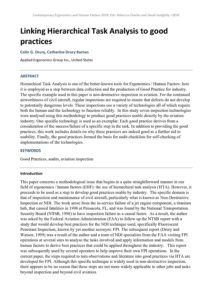
|
Author
Colin G. Drury, Catherine Drury Barnes |
Abstract
Hierarchical Task Analysis is one of the better-known tools for Ergonomics / Human Factors: here it is employed as a step between data collection and the production of Good Practice for industry. The specific example used in this paper is non-destructive inspection in aviation. For the continued airworthiness of civil aircraft, regular inspections are required to ensure that defects do not develop to potentially dangerous levels. These inspections use a variety of technologies all of which require both the human and the technology to function reliably. In this study seven inspection technologies were analysed using this methodology to produce good practices usable directly by the aviation industry. One specific technology is used as an exemplar. Each good practice derives from a consideration of the success/failure of a specific step in the task. In addition to providing the good practices, this work includes details on why these practices are indeed good as a further aid to usability. Finally, the good practices formed the basis for audit checklists for self-checking of implementations of the technologies. |
Publish Date: Sep 8, 2019 | Keywords: Anthropometry, Contemporary EHF 2019, Publications
| Document
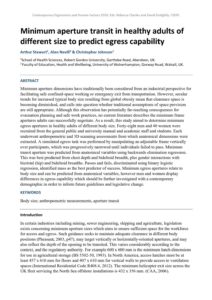
|
Author
Arthur Stewart, Alan Nevill & Christopher Johnson |
Abstract
Minimum aperture dimensions have traditionally been considered from an industrial perspective for facilitating safe confined-space working or emergency exit from transportation. However, secular trends for increased typical body size resulting from global obesity mean that clearance space is becoming diminished, and calls into question whether traditional assumptions of space provision are still appropriate. Although this observation has potentially far-reaching consequences for evacuation planning and safe work practices, no current literature describes the minimum frame apertures adults can successfully negotiate. As a result, this study aimed to determine minimum egress apertures in healthy adults of different body size. Forty-eight men and 40 women were recruited from the general public and university manual and academic staff and students. Each underwent anthropometric and 3D scanning assessments from which anatomical dimensions were extracted. A simulated egress task was performed by manipulating an adjustable frame vertically over participants, which was progressively narrowed until individuals failed to pass. Minimum transit aperture was predicted from anatomical variables using backwards elimination regression. This was best predicted from chest depth and bideltoid breadth, plus gender interactions with bicristal (hip) and bideltoid breadths. Passes and fails, discriminated using binary logistic regression, identified mass as the best predictor of success. Minimum egress apertures relate to body size and can be predicted from anatomical variables, however men and women display differences in egress capability which should be further investigated with a contemporary demographic in order to inform future guidelines and legislative change. |
Publish Date: May 23, 2025 | Keywords: Construction, Contemporary EHF 2025, Fatigue & sleep, Publications
| Document
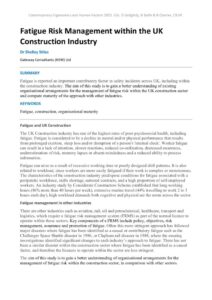
|
Author
Dr Shelley Stiles |
Abstract
Fatigue is reported an important contributory factor in safety incidents across UK, including within the construction industry. The aim of this study is to gain a better understanding of existing organisational arrangements for the management of fatigue risk within the UK construction sector and compare maturity of the approach with other industries. |
Publish Date: Oct 22, 2018 | Keywords: Contemporary EHF 2018, Healthcare, Publications, Safety
| Document
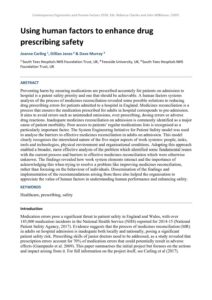
|
Author
Joanne Carling, Gillian Janes & Dave Murray |
Abstract
Preventing harm by ensuring medications are prescribed accurately for patients on admission to hospital is a patent safety priority and one that should be achievable. A human factors systems analysis of the process of medicines reconciliation revealed some possible solutions to reducing drug prescribing errors for patients admitted to a hospital in England. Medicines reconciliation is a process that ensures the medication prescribed for adults in hospital corresponds to pre-admission. It aims to avoid errors such as unintended omissions, over prescribing, dosing errors or adverse drug reactions. Inadequate medicines reconciliation on admission is commonly identified as a major cause of patient morbidity. Poor access to patients’ regular medications lists is recognised as a particularly important factor. The System Engineering Initiative for Patient Safety model was used to analyse the barriers to effective medicines reconciliation in adults on admission. This model clearly recognises the interrelated nature of the five major aspects of work systems: people, tasks, tools and technologies, physical environment and organisational conditions. Adopting this approach enabled a broader, more effective analysis of the problem which identified some fundamental issues with the current process and barriers to effective medicines reconciliation which were otherwise unknown. The findings revealed how work system elements interact and the importance of acknowledging this when trying to resolve a problem like improving medicines reconciliation, rather than focusing on the behaviour of individuals. Dissemination of the findings and implementation of the recommendations arising from these also helped the organisation to appreciate the value of human factors in understanding human performance and enhancing safety. |
Publish Date: Apr 9, 2020 | Keywords: Contemporary EHF 2020, Publications
| Document
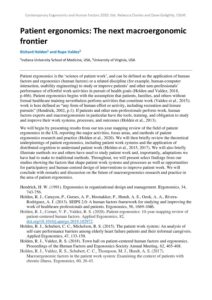
|
Author
Richard Holden and Rupa Valdez |
Abstract
Patient ergonomics is the ‘science of patient work’, and can be defined as the application of human factors and ergonomics (human factors) or a related discipline (for example, human-computer interaction, usability engineering) to study or improve patients’ and other non-professionals’ performance of effortful work activities in pursuit of health goals (Holden and Valdez, 2018, p.466). Patient ergonomics begins with the assumption that patients, families, and others without formal healthcare training nevertheless perform activities that constitute work (Valdez et al., 2015); work is here defined as “any form of human effort or activity, including recreation and leisure pursuits” (Hendrick, 2002, p.1). If patients and other non-professionals perform work, human factors experts and macroergonomists in particular have the tools, training, and obligation to study and improve their work systems, processes, and outcomes (Holden et al., 2013). |
Publish Date: May 31, 2024 | Keywords: Contemporary EHF 2024, Data, Health & Safety, Publications, Safety
| Document
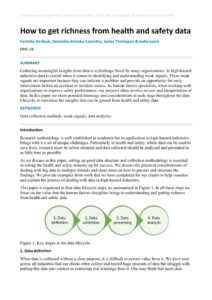
|
Author
Carlotta Vorbeck, Dominika Brzoska-Corenthy, James Thompson & Jodie Lewis |
Abstract
Gathering meaningful insights from data is a challenge faced by many organisations. In high-hazard industries data is crucial when it comes to identifying and understanding weak signals. These weak signals are important because they can indicate a problem and provide an opportunity for early intervention before an accident or incident occurs. As human factors specialists, when working with organisations to improve safety performance, our projects often involve review and interpretation of data. In this paper we share practical learnings and considerations at each stage throughout the data lifecycle, to maximise the insights that can be gained from health and safety data. |
Publish Date: Feb 27, 2019 | Keywords: Aviation, Contemporary EHF 2016, Leadership, Publications, Safety culture
| Document
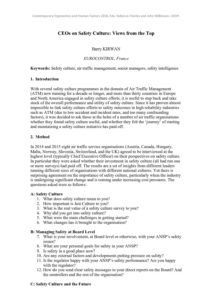
|
Author
Barry KIRWAN |
Abstract
|
Publish Date: Mar 25, 2019 | Keywords: Automation, Contemporary EHF 2016, Publications, Rail
| Document
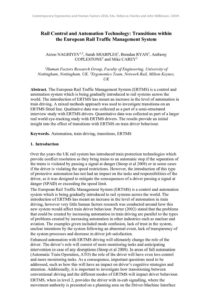
|
Author
Arzoo NAGHIYEV, Sarah SHARPLES, Brendan RYAN, Anthony COPLESTONE and Mike CAREY |
Abstract
The European Rail Traffic Management System (ERTMS) is a control and automation system which is being gradually introduced to rail systems across the world. The introduction of ERTMS has meant an increase in the level of automation in train driving. A mixed methods approach was used to investigate transitions on an ERTMS fitted line. Qualitative data was collected as a part of a semi-structured interview study with ERTMS drivers. Quantitative data was collected as part of a larger real world eye-tracking study with ERTMS drivers. The results provide an initial insight into the effect of transitions with ERTMS on train driver behaviour. |
Publish Date: Jun 8, 2023 | Keywords: Contemporary EHF 2023, Design, Healthcare, Publications
| Document
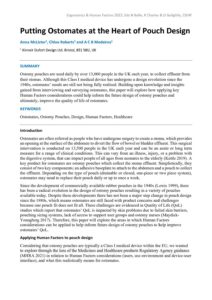
|
Author
Anna McLister, Chloe Roberts & A C B Medeiros |
Abstract
Ostomy pouches are used daily by over 13,000 people in the UK each year, to collect effluent from their stomas. Although this Class I medical device has undergone a design revolution since the 1940s, ostomates’ needs are still not being fully realised. Building upon knowledge and insights gained from interviewing and surveying ostomates, this paper will explore how applying key Human Factors considerations could help inform the future design of ostomy pouches and ultimately, improve the quality of life of ostomates. |
Publish Date: Dec 17, 2018 | Keywords: Contemporary EHF 2017, Publications, Usability, User centred design
| Document
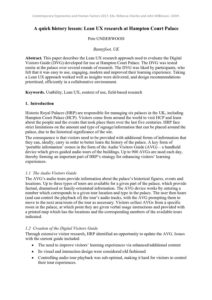
|
Author
Pete UNDERWOOD |
Abstract
This paper describes the Lean UX research approach used to evaluate the Digital Visitors Guide (DVG) developed for use at Hampton Court Palace. The DVG was tested onsite at the palace over several rounds of research. The DVG was liked by participants, who felt that it was easy to use, engaging, modern and improved their learning experience. Taking a Lean UX approach worked well as insights were delivered, and design recommendations prioritised, efficiently in a collaborative environment. |
Publish Date: Jun 23, 2022 | Keywords: Cognition, Contemporary EHF 2022, Healthcare, Publications
| Document
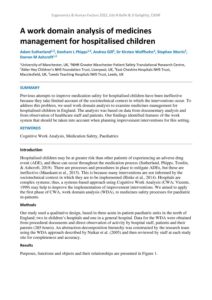
|
Author
Adam Sutherland, Denham L Phipps, Andrea Gill, Dr Kirsten Wolffsohn, Stephen Morris & Darren M Ashcroft |
Abstract
Previous attempts to improve medication safety for hospitalised children have been ineffective because they take limited account of the sociotechnical context in which the interventions occur. To address this problem, we used work domain analysis to examine medicines management for hospitalised children in England. The analysis was based on data from documentary analysis and from observation of healthcare staff and patients. Our findings identified features of the work system that should be taken into account when planning improvement interventions for this setting. |
Publish Date: May 23, 2025 | Keywords: Contemporary EHF 2025, Publications, Risk assessment, Tools & techniques
| Document
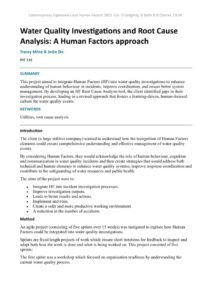
|
Author
Tracey Milne & Jodie Dix |
Abstract
This project aimed to integrate Human Factors (HF) into water quality investigations to enhance understanding of human behaviour in incidents, improve coordination, and ensure better system management. By developing an HF Root Cause Analysis tool, the client identified gaps in their investigation process, leading to a revised approach that fosters a learning-driven, human-focused culture for water quality events. |
Publish Date: May 27, 2025 | Keywords: Contemporary EHF 2025, Fatigue & sleep, Healthcare, Publications, Workload
| Document
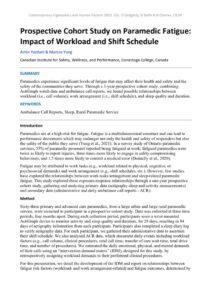
|
Author
Amin Yazdani & Marcus Yung |
Abstract
Paramedics experience significant levels of fatigue that may affect their health and safety and the safety of the communities they serve. Through a 1-year prospective cohort study, combining ActiGraph watch data and ambulance call reports, we found possible relationships between workload (i.e., call volume), work arrangement (i.e., shift schedule), and sleep quality and duration. |
Publish Date: Dec 18, 2018 | Keywords: Contemporary EHF 2017, Publications, Technology
| Document
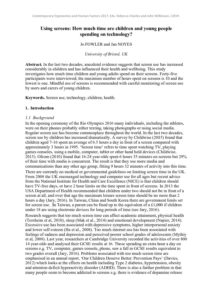
|
Author
Jo FOWLER and Jan NOYES |
Abstract
In the last two decades, anecdotal evidence suggests that screen use has increased considerably in children and has influenced their health and wellbeing. This study investigates how much time children and young adults spend on their screens. Forty-five participants were interviewed; the maximum number of hours spent on screens is 10 and the lowest is one. Mindful use of screens is recommended with careful monitoring of screen use by users and carers of young children. |
Publish Date: Oct 22, 2018 | Keywords: Automotive, Contemporary EHF 2018, Publications, Technology
| Document
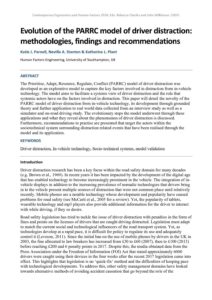
|
Author
Katie J. Parnell, Neville A. Stanton & Katherine L. Plant |
Abstract
The Prioritise, Adapt, Resource, Regulate, Conflict (PARRC) model of driver distraction was developed as an explorative model to capture the key factors involved in distraction from in-vehicle technology. The model aims to facilitate a systems view of driver distraction and the role that systemic actors have on the factors involved in distraction. This paper will detail the novelty of the PARRC model of driver distraction from in-vehicle technology, its development through grounded theory and further application to real world data collected from an interview study as well as a simulator and on-road driving study. The evolutionary steps the model underwent through these applications and what they reveal about the phenomenon of driver distraction is discussed. Furthermore, recommendations to practise are presented that target the actors within the sociotechnical system surrounding distraction related events that have been realised through the model and its application. |
Publish Date: Aug 9, 2021 | Keywords: Comfort, Comfort Congress 2021, Human performance, Publications, Task analysis
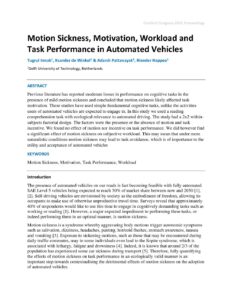 |
Author
Tugrul Irmak, Ksander de Winkel1 & Adarsh Pattanayak, Riender Happee |
Abstract
Previous literature has reported moderate losses in performance on cognitive tasks in the presence of mild motion sickness and concluded that motion sickness likely affected task motivation. These studies have used simple fundamental cognitive tasks, unlike the activities users of automated vehicles are expected to engage in. In this study we used a reading comprehension task with ecological relevance to automated driving. The study had a 2x2 within-subjects factorial design. The factors were the presence or the absence of motion and task incentive. We found no effect of motion nor incentive on task performance. We did however find a significant effect of motion sickness on subjective workload. This may mean that under more naturalistic conditions motion sickness may lead to task avoidance, which is of importance to the utility and acceptance of automated vehicles. |
Publish Date: Jun 23, 2022 | Keywords: Contemporary EHF 2022, Publications, Technology, User experience
| Document
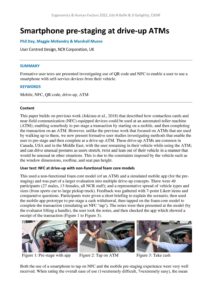
|
Author
Phil Day, Maggie McKendry & Marshall Munro |
Abstract
Formative user tests are presented investigating use of QR code and NFC to enable a user to use a smartphone with self-service devices from their vehicle. |
Publish Date: Jun 11, 2025 | Keywords: Artificial intelligence, Contemporary EHF 2025, Nuclear, Publications
| Document
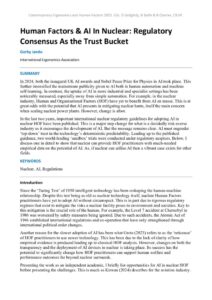
|
Author
Gorby Jandu |
Abstract
In 2024, both the inaugural UK AI awards and Nobel Peace Prize for Physics in AI took place. This further intensified the mainstream publicity given to AI both in human automation and machine self-learning. In contrast, the uptake of AI in more industrial and specialist settings has been noticeably measured, especially away from simple automation. For example, in the nuclear industry, Human and Organisational Factors (HOF) have yet to benefit from AI en masse. This is at great odds with the potential that AI presents in mitigating nuclear harm, itself the main concern when scaling nuclear power plants. However, change is afoot. In the last two years, important international nuclear regulatory guidelines for adopting AI in nuclear HOF have been published. This is a major step change for what is a decidedly risk-averse industry as it encourages the development of AI. But the message remains clear. AI must engender ‘top-down’ trust in the technology’s deterministic predictability. Leading up to the published guidance, two world-leading ‘sandbox’ trials were conducted under regulatory auspices. Below, I discuss one in detail to show that nuclear can provide HOF practitioners with much-needed empirical data on the potential of AI. As, if nuclear can utilise AI then a vibrant case exists for other fields. |
Publish Date: Apr 16, 2020 | Keywords: Cognition, Contemporary EHF 2020, Human factors integration, Publications, Systems
| Document
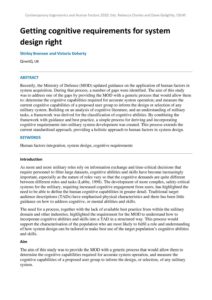
|
Author
Shirley Brennen and Victoria Doherty |
Abstract
Recently, the Ministry of Defence (MOD) updated guidance on the application of human factors in system acquisition. During that process, a number of gaps were identified. The aim of this study was to address one of the gaps by providing the MOD with a generic process that would allow them to: determine the cognitive capabilities required for accurate system operation; and measure the current cognitive capabilities of a proposed user group to inform the design or selection of any military system. Building on an analysis of cognitive literature, and an understanding of military tasks, a framework was derived for the classification of cognitive abilities. By combining the framework with guidance and best practice, a simple process for deriving and incorporating cognitive requirements into military system development was created. This process extends the current standardised approach, providing a holistic approach to human factors in system design. |
Publish Date: Jun 11, 2025 | Keywords: Contemporary EHF 2025, Healthcare, Incidents, Publications, Systems
| Document
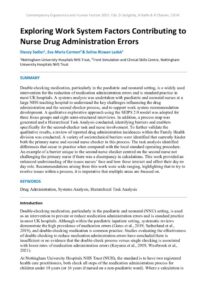
|
Author
Stacey Sadler, Eva-Maria Carman & Selina Rizwan Ladak |
Abstract
Double-checking medication, particularly in the paediatric and neonatal setting, is a widely used intervention for the reduction of medication administration errors and is standard practice in most UK hospitals. A systems analysis was undertaken with paediatric and neonatal nurses at a large NHS teaching hospital to understand the key challenges influencing the drug administration and the second checker process, and to support work system recommendation development. A qualitative explorative approach using the SEIPS 2.0 model was adopted for three focus groups and eight semi-structured interviews. In addition, a process map was generated and a Hierarchical Task Analysis conducted, identifying barriers and enablers specifically for the second-checker task and nurse involvement. To further validate the qualitative results, a review of reported drug administration incidences within the Family Health division was conducted. A variety of sociotechnical barriers were identified that currently hinder both the primary nurse and second nurse checker in this process. The task analysis identified differences that occur in practice when compared with the local standard operating procedure. An example of a barrier unique to the second nurse checker centred on the second nurse not challenging the primary nurse if there was a discrepancy in calculations. This work provided an enhanced understanding of the issues nurses’ face and how these interact and affect their day-to day role. Recommendations arising from this work were wide ranging, highlighting that to try to resolve issues within a process, it is imperative that multiple areas are focused on. |
Publish Date: Apr 8, 2021 | Keywords: Construction, Contemporary EHF 2021, Pandemic, Publications, Technology
| Document
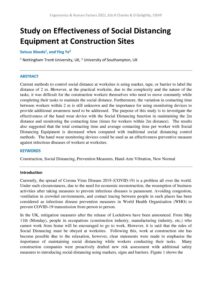
|
Author
Setsuo Maeda and Ying Ye |
Abstract
Current methods to control social distance at worksites is using marker, tape, or barrier to label the distance of 2 m. However, at the practical worksite, due to the complexity and the nature of the tasks, it was difficult for the construction workers themselves who need to move constantly while completing their tasks to maintain the social distance. Furthermore, the variation in contacting time between workers within 2 m is still unknown and the importance for using monitoring devices to provide additional awareness need to be addressed. The purpose of this study is to investigate the effectiveness of the hand wear device with the Social Distancing function in maintaining the 2m distance and monitoring the contacting time (times for workers within 2m distance). The results also suggested that the total contacting time and average contacting time per worker with Social Distancing Equipment is decreased when compared with traditional social distancing control methods. The hand wear monitoring devices could be used as an effectiveness preventive measure against infectious diseases of workers at worksites. |
Publish Date: Jun 12, 2023 | Keywords: Contemporary EHF 2023, Healthcare, Publications
| Document
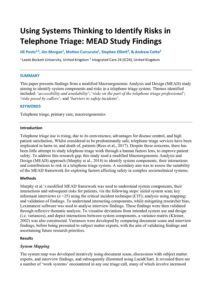
|
Author
Jill Poots, Jim Morgan, Matteo Curcuruto, Stephen Elliott, & Andrew Catto |
Abstract
This paper presents findings from a modified Macroergonomic Analysis and Design (MEAD) study aiming to identify system components and risks in a telephone triage system. Themes identified included: ‘accessibility and availability’; ‘risks on the part of the telephone triage professional’; ‘risks posed by callers’; and ‘barriers to safety incidents’. |
Publish Date: Jun 12, 2023 | Keywords: Contemporary EHF 2023, Publications, Rail, Technology
| Document
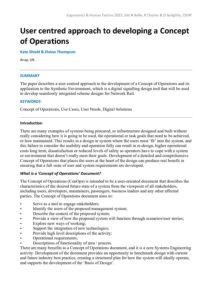
|
Author
Kate Shield & Elaine Thompson |
Abstract
The paper describes a user centred approach to the development of a Concept of Operations and its application to the Synthetic Environment, which is a digital signalling design tool that will be used to develop seamlessly integrated scheme designs for Network Rail. |
Publish Date: Apr 9, 2020 | Keywords: Contemporary EHF 2020, Human-machine interaction, Publications, Submarines
| Document
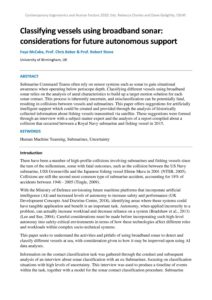
|
Author
Faye McCabe, Prof. Chris Baber & Prof. Robert Stone |
Abstract
Submarine Command Teams often rely on sensor systems such as sonar to gain situational awareness when operating below periscope depth. Classifying different vessels using broadband sonar relies on the analysis of aural characteristics to build up a target motion solution for each sonar contact. This process is inherently uncertain, and misclassification can be potentially fatal, resulting in collisions between vessels and submarines. This paper offers suggestions for artificially intelligent support which could be created and provided through the analysis of historically collected information about fishing vessels transmitted via satellite. These suggestions were formed through an interview with a subject matter expert and the analysis of a report compiled about a collision that occurred between a Royal Navy submarine and fishing vessel in 2015. |
Publish Date: Jun 11, 2025 | Keywords: Contemporary EHF 2025, Decision making, Nuclear, Publications, Tools & techniques
| Document
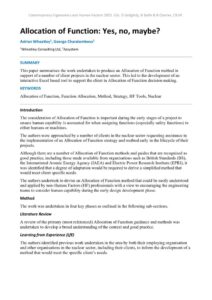
|
Author
Adrian Wheatley, George Charalambous |
Abstract
This paper summarises the work undertaken to produce an Allocation of Function method in support of a number of client projects in the nuclear sector. This led to the development of an interactive Excel based tool to support the client in Allocation of Function decision making. |
Publish Date: Aug 11, 2021 | Keywords: Automotive, Autonomous vehicles, Comfort, Comfort Congress 2021, Publications, Seating, User experience
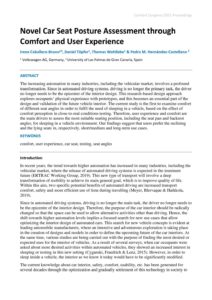 |
Author
Irene Caballero-Bruno, Daniel Töpfer, Thomas Wohllebe & Pedro M. Hernández-Castellano |
Abstract
The increasing automation in many industries, including the vehicular market, involves a profound transformation. Since in automated driving systems, driving is no longer the primary task, the driver no longer needs to be the epicenter of the interior design. This research-based design approach explores occupants’ physical experience with prototypes, and this becomes an essential part of the design and validation of the future vehicle interior. The current study is the first to examine comfort of different seat angles in order to fulfil the need of sleeping in a vehicle, based on the effect of comfort perception in close-to-real conditions testing. Therefore, user experience and comfort are the main drivers to assess the most suitable seating position, including the seat pan and backrest angles, for sleeping in a vehicle environment. Our findings suggest that users prefer the reclining and the lying seats in, respectively, short/medium and long-term use cases. |
Publish Date: Sep 8, 2019 | Keywords: Contemporary EHF 2019, Human performance, Manufacturing, Pharmaceutical, Publications
| Document
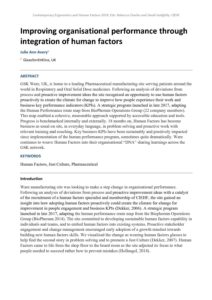
|
Author
Julie Ann Avery |
Abstract
GSK Ware, UK, is home to a leading Pharmaceutical manufacturing site serving patients around the world in Respiratory and Oral Solid Dose medicines. Following an analysis of deviations from process and proactive improvement ideas the site recognised an opportunity to use human factors proactively to create the climate for change to improve how people experience their work and business key performance indicators (KPIs). A strategic program launched in late 2017, adapting the Human Performance route map from BioPhorum Operations Group (22 company members). This map enabled a cohesive, measurable approach supported by accessible education and tools. Progress is benchmarked internally and externally. 18 months on, Human Factors has become business as usual on site, in everyday language, in problem solving and proactive work with relevant training and coaching. Key business KPIs have been sustainably and positively impacted since implementation of the human performance program, sometimes quite dramatically. Ware continues to weave Human Factors into their organisational “DNA” sharing learnings across the GSK network. |
Publish Date: Sep 7, 2019 | Keywords: Complex systems, Contemporary EHF 2019, Defence, Publications, Safety
| Document
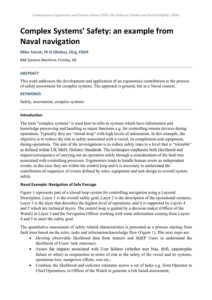
|
Author
Mike Tainsh |
Abstract
This work addresses the development and application of an ergonomics contribution to the process of safety assessment for complex systems. The approach is general, but in a Naval context. |
Publish Date: Jun 10, 2024 | Keywords: Artificial intelligence, Contemporary EHF 2024, Publications
| Document
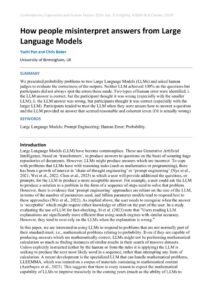
|
Author
Yuzhi Pan and Chris Baber |
Abstract
We presented probability problems to two Large Language Models (LLMs) and asked human judges to evaluate the correctness of the outputs. Neither LLM achieved 100% on the questions but participants did not always spot the errors these made. Two types of human error were identified: i. the LLM answer is correct, but the participant thought it was wrong (especially with the smaller LLM); ii. the LLM answer was wrong, but participants thought it was correct (especially with the larger LLM). Participants tended to trust the LLM when they were unsure how to answer a question and the LLM provided an answer that seemed reasonable and coherent (even if it is actually wrong) |
Publish Date: Jun 12, 2023 | Keywords: Contemporary EHF 2023, Defence, Publications, Technology
| Document
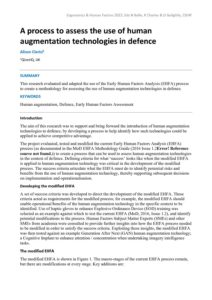
|
Author
Alison Clerici |
Abstract
This research evaluated and adapted the use of the Early Human Factors Analysis (EHFA) process to create a methodology for assessing the use of human augmentation technologies in defence. |
Publish Date: Jun 24, 2022 | Keywords: Contemporary EHF 2022, Maritime, Publications, Safety culture, Sociotechnical systems
| Document

|
Author
Paul Liston, Alison M Kay & Emma Delemere |
Abstract
The development of technologies for improved evacuations of large cruise ships necessitates a sociotechnical approach to requirements elicitation, technology development activities, and the evaluation of the solutions produced. The concept of Social Licence to Operate (SLO) offers the opportunity to address concerns around ethics, regulations and de-skilling in planning for implementation and operation. This paper outlines the approach taken in advancing this SLO. |
Publish Date: May 23, 2025 | Keywords: Automotive, Contemporary EHF 2025, Publications, Transport
| Document
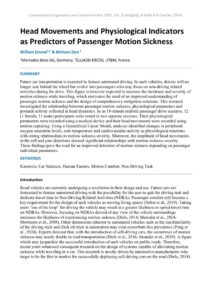
|
Author
William Emond & Mohsen Zare |
Abstract
Future car transportation is expected to feature automated driving. In such vehicles, drivers will no longer seat behind the wheel but evolve into passengers who may focus on non-driving related activities during the drive. This figure is however expected to increase the incidence and severity of motion sickness while traveling, which motivates the need of an improved understanding of passenger motion sickness and the design of comprehensive mitigation solutions. This research investigated the relationship between passenger motion sickness, physiological parameters and postural activity reflected in head dynamics. In an 18-minute realistic passenger drive scenario, 12 (1 female, 11 male) participants were tested in two separate sessions. Their physiological parameters were recorded using a medical device and their head movements were recorded using motion capturing. Using a Generalized Linear Model, analyses identified changes in peripheral oxygen saturation levels, core temperature and cardiovascular activity as physiological reactions with strong relationships to motion sickness severity. Moreover, the amplitude of head movements in the roll and yaw directions showed significant relationships with motion sickness severity. These findings pave the road for an improved detection of motion sickness depending on passenger individual parameters. |
Publish Date: Jun 12, 2023 | Keywords: Contemporary EHF 2023, Human-machine interaction, Publications, Tools & techniques
| Document
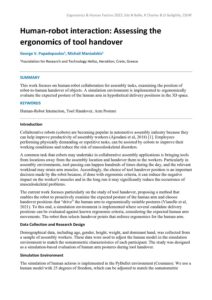
|
Author
George V. Papadopoulos & Michail Maniadakis |
Abstract
This work focuses on human-robot collaboration for assembly tasks, examining the position of robot-to-human handover of objects. A simulation environment is implemented to ergonomically evaluate the expected posture of the human arm in hypothetical delivery positions in the 3D space. |
Publish Date: Sep 8, 2019 | Keywords: Contemporary EHF 2019, Healthcare, Human factors integration, Publications
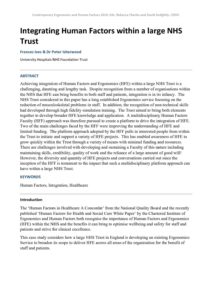
|
Author
Frances Ives & Dr Peter Isherwood |
Abstract
Achieving integration of Human Factors and Ergonomics (HFE) within a large NHS Trust is a challenging, daunting and lengthy task. Despite recognition from a number of organisations within the NHS that HFE can bring benefits to both staff and patients, integration is in its infancy. The NHS Trust considered in this paper has a long established Ergonomics service focusing on the reduction of musculoskeletal problems in staff. In addition, the recognition of non-technical skills had developed through high fidelity simulation training. The Trust aimed to bring both elements together to develop broader HFE knowledge and application. A multidisciplinary Human Factors Faculty (HFF) approach was therefore pursued to create a platform to drive the integration of HFE. Two of the main challenges faced by the HFF were improving the understanding of HFE and limited funding. The platform approach adopted by the HFF pulls in interested people from within the Trust to initiate and support a variety of HFE projects. This has enabled awareness of HFE to grow quickly within the Trust through a variety of means with minimal funding and resources. There are challenges involved with developing and sustaining a Faculty of this nature including maintaining skills, credibility, quality of work and the reliance of a large amount of good will! However, the diversity and quantity of HFE projects and conversations carried out since the inception of the HFF is testament to the impact that such a multidisciplinary platform approach can have within a large NHS Trust. |
Publish Date: Jun 24, 2022 | Keywords: Contemporary EHF 2022, Investigation, Publications, Risk assessment, Systems, Tools & techniques
| Document
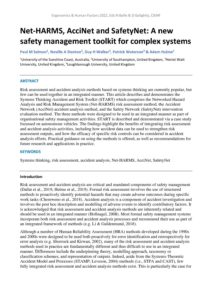
|
Author
Paul M Salmon, Neville A Stanton, Guy H Walker, Patrick Waterson & Adam Hulme |
Abstract
Risk assessment and accident analysis methods based on systems thinking are currently popular, but few can be used together in an integrated manner. This article describes and demonstrates the Systems Thinking Accident and Risk Toolkit (START) which comprises the Networked Hazard Analysis and Risk Management System (Net-HARMS) risk assessment method, the Accident Network (AcciNet) accident analysis method, and the Safety Network (SafetyNet) intervention evaluation method. The three methods were designed to be used in an integrated manner as part of organisational safety management activities. START is described and demonstrated via a case study focussed on autonomous vehicles. The findings highlight the benefits of integrating risk assessment and accident analysis activities, including how accident data can be used to strengthen risk assessment outputs, and how the efficacy of specific risk controls can be considered in accident analysis efforts. Practical guidance on using the methods is offered, as well as recommendations for future research and applications in practice. |
Publish Date: Apr 15, 2020 | Keywords: Complex systems, Contemporary EHF 2020, Defence, Publications, User centred design
| Document
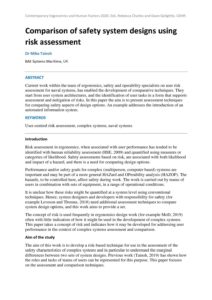
|
Author
Dr Mike Tainsh |
Abstract
Current work within the team of ergonomics, safety and operability specialists on user risk assessment for naval systems, has enabled the development of comparative techniques. They start from user system architectures, and the identification of user tasks in a form that supports assessment and mitigation of risks. In this paper the aim is to present assessment techniques for comparing safety aspects of design options. An example addresses the introduction of an automated information system. |
Publish Date: Mar 24, 2019 | Keywords: Cognition, Contemporary EHF 2016, Healthcare, Publications, Workload
| Document
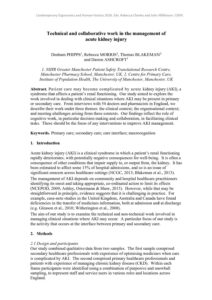
|
Author
Denham PHIPPS, Rebecca MORRIS, Thomas BLAKEMAN and Darren ASHCROFT |
Abstract
Patient care may become complicated by acute kidney injury (AKI), a syndrome that affects a patient’s renal functioning. Our study aimed to explore the work involved in dealing with clinical situations where AKI may be present in primary or secondary care. From interviews with 54 doctors and pharmacists in England, we describe their work under three themes: the clinical context; the organisational context; and meeting challenges arising from these contexts. Our findings reflect the role of cognitive work, in particular decision making and collaboration, in facilitating clinical tasks. These should be the focus of any interventions to improve AKI management. |
Publish Date: Jun 3, 2024 | Keywords: Contemporary EHF 2024, Healthcare, Publications, Simulation, Usability
| Document
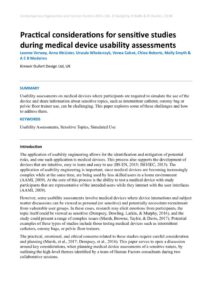
|
Author
Leanne Verwey, Anna McLister, Urszula Wlodarczyk, Venea Calcot, Chloe Roberts, Molly Smyth & A C B Medeiros |
Abstract
Usability assessments on medical devices where participants are required to simulate the use of the device and share information about sensitive topics, such as intermittent catheter, ostomy bag or pelvic floor trainer use, can be challenging. This paper explores some of these challenges and how to address them. |
Publish Date: Jun 12, 2023 | Keywords: Contemporary EHF 2023, Publications, Rail, Road safety
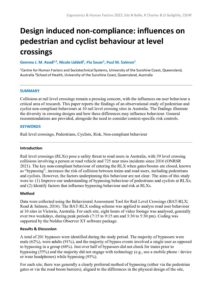
| Document
Insert here |
Author
Gemma J. M. Read, Nicole Liddell, Pia Sauer & Paul M. Salmon |
Abstract
Collisions at rail level crossings remain a pressing concern, with the influences on user behaviour a critical area of research. This paper reports the findings of an observational study of pedestrian and cyclist non-compliant behaviours at 10 rail level crossing sites in Australia. The findings illustrate the diversity in crossing designs and how these differences may influence behaviour. General recommendations are provided, alongside the need to consider context-specific risk controls. |
Publish Date: Jun 8, 2023 | Keywords: Aviation, Contemporary EHF 2023, Incidents, Investigation, Publications, Technology
| Document
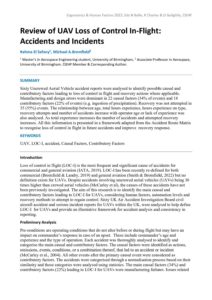
|
Author
Rahma El Safany, Michael A.Bromfield |
Abstract
Sixty Uncrewed Aerial Vehicle accident reports were analysed to identify possible causal and contributory factors leading to loss of control in flight and recovery actions where applicable. Manufacturing and design errors were dominant in 22 causal factors (34% of events) and 18 contributory factors (22% of events) (e.g. ingestion of precipitation). Recovery was not attempted in 35 (55%) events. The relationship between age, total hours experience, hours experience on type, recovery attempts and number of accidents increase with operator age or lack of experience was also analysed. As total experience increases the number of accidents and attempted recovery increases. All this information is presented in a framework adapted from the Accident Route Matrix to recognise loss of control in flight in future accidents and improve recovery response. |
Publish Date: Sep 7, 2019 | Keywords: Contemporary EHF 2019, Defence, Publications
| Document
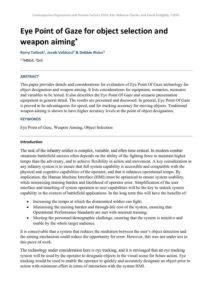
|
Author
Kerry Tatlock, Jacob Valducci & Debbie Risius |
Abstract
This paper provides details and considerations for evaluation of Eye Point Of Gaze technology for object designation and weapon aiming. It lists considerations for equipment, scenarios, measures and variables to be tested. It also describes the Eye Point Of Gaze and scenario presentation equipment in general detail. The results are presented and discussed. In general, Eye Point Of Gaze is proved to be advantageous for speed, and for tracking accuracy for moving objects. Traditional weapon aiming is shown to have higher accuracy levels at the point of object designation. |
Publish Date: Jun 4, 2024 | Keywords: Contemporary EHF 2024, Design, Publications, Systems, Tools & techniques
| Document
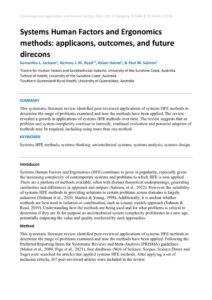
|
Author
Samantha L. Jackson, Gemma J. M. Read, Adam Hulme, & Paul M. Salmon |
Abstract
This systematic literature review identified peer-reviewed applications of systems HFE methods to determine the range of problems examined and how the methods have been applied. The review revealed a growth in applications of systems HFE methods over time. The review suggests that as problem and system complexity continue to intensify, continual evaluation and potential adaption of methods may be required, including using more than one method. |
Publish Date: Jun 22, 2022 | Keywords: Automation, Aviation, Contemporary EHF 2022, Publications
| Document
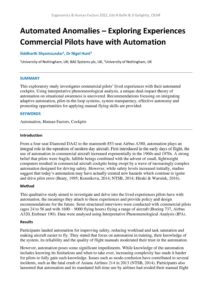
|
Author
Siddharth Shyamsundar & Dr Nigel Hunt |
Abstract
This exploratory study investigates commercial pilots’ lived experiences with their automated cockpits. Using interpretative phenomenological analysis, a unique dual-impact theory of automation on situational awareness is uncovered. Recommendations focusing on integrating adaptive automation, pilot-in-the loop systems, system transparency, effective autonomy and promoting opportunities for applying manual flying skills are provided. |
Publish Date: May 30, 2024 | Keywords: Contemporary EHF 2024, Psychology, Publications, Safety
| Document
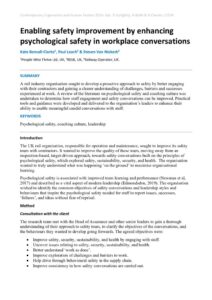
|
Author
Kate Bonsall-Clarke, Paul Leach & Steven Van Niekerk |
Abstract
A rail industry organisation sought to develop a proactive approach to safety by better engaging with their contractors and gaining a clearer understanding of challenges, barriers and successes experienced at work. A review of the literature on psychological safety and coaching culture was undertaken to determine how staff engagement and safety conversations can be improved. Practical tools and guidance were developed and delivered to the organisation’s leaders to enhance their ability to enable meaningful candid conversations with staff. |
Publish Date: Jun 11, 2025 | Keywords: Contemporary EHF 2025, Human factors integration, Manufacturing, Publications
| Document
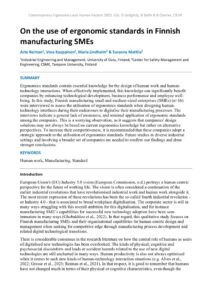
|
Author
Arto Reiman, Vesa Kauppinen, Maria Lindholm & Susanna Mattila |
Abstract
Ergonomics standards contain essential knowledge for the design of human work and human-technology interactions. When effectively implemented, this knowledge can significantly benefit companies by enhancing technological development, business performance and employee well-being. In this study, Finnish manufacturing small and medium-sized enterprises (SMEs) (n=16) were interviewed to assess the utilisation of ergonomics standards when designing human-technology interfaces during their endeavours to digitalise their manufacturing processes. The interviews indicate a general lack of awareness, and minimal application of ergonomic standards among the companies. This is a worrying observation, as it suggests that companies' design solutions may not always be based on current ergonomics knowledge but rather on alternative perspectives. To increase their competitiveness, it is recommended that these companies adopt a strategic approach to the utilisation of ergonomics standards. Future studies in diverse industrial settings and involving a broader set of companies are needed to confirm our findings and draw stronger conclusions. |
Publish Date: Dec 17, 2018 | Keywords: Contemporary EHF 2017, Healthcare, Publications, Usability
| Document
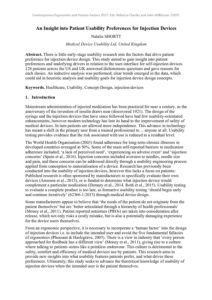
|
Author
Natalie SHORTT |
Abstract
There is little early-stage usability research into the factors that drive patient preference for injection device design. This study aimed to gain insight into patient preferences and underlying drivers in relation to the user-interface for self-injection devices. 128 patients across the US and UK answered dichotomous questions and gave reasons for each choice. An inductive analysis was performed; clear trends emerged in the data, which could aid in heuristic analysis and usability goals for injection device design concepts. |
Publish Date: Sep 7, 2019 | Keywords: Contemporary EHF 2019, Publications, Rail
| Document
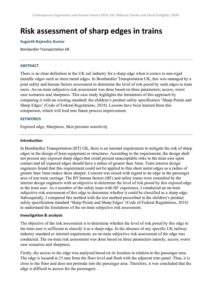
|
Author
Suganth Rajendra Kumar |
Abstract
There is no clear definition in the UK rail industry for a sharp edge when it comes to non-rigid metallic edges such as sheet metal edges. In Bombardier Transportation UK, this was managed by a joint safety and human factors assessment to determine the level of risk posed by such edges to train users. An on-train subjective risk assessment was done based on three parameters; access, worst case scenarios and sharpness. This case study highlights the limitations of this approach by comparing it with an existing standard; the children’s product safety specification ‘Sharp Points and Sharp Edges’ (Code of Federal Regulations, 2018). Lessons have been learned from this comparison, which will feed into future process improvement. |
Publish Date: Jun 12, 2023 | Keywords: Artificial intelligence, Autonomous systems, Contemporary EHF 2023, Design, Publications, Systems, Technology
Document 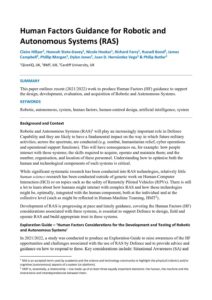 |
Author Claire Hillyer, Hannah State-Davey, Nicole Hooker, Richard Farry, Russell Bond, James Campbell, Phillip Morgan, Dylan Jones, Juan D. Hernández Vega & Philip Butler |
| Abstract This paper outlines recent (2021/2022) work to produce Human Factors (HF) guidance to support the design, development, evaluation, and acquisition of Robotic and Autonomous Systems. |
Publish Date: Jun 11, 2025 | Keywords: Contemporary EHF 2025, Fatigue & sleep, Publications, Rail
| Document
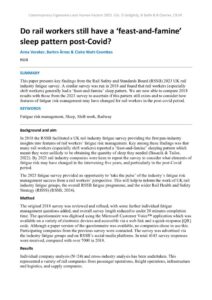
|
Author
Anna Vereker, Barbro Årnes & Claire Watt-Coombes |
Abstract
This paper presents key findings from the Rail Safety and Standards Board (RSSB) 2023 UK rail industry fatigue survey. A similar survey was run in 2018 and found that rail workers (especially shift workers) generally had a ‘feast-and-famine’ sleep pattern. We are now able to compare 2018 results with those from the 2023 survey to ascertain if this pattern still exists and to consider how features of fatigue risk management may have changed for rail workers in the post-covid period. |
Publish Date: Apr 8, 2021 | Keywords: Contemporary EHF 2021, Fatigue & sleep, Mental health & wellbeing, Musculoskeletal, Occupational health, Pandemic, Publications
| Document
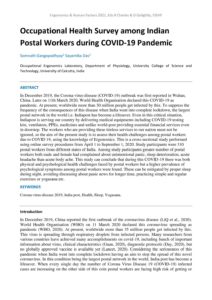
|
Author
Somnath Gangopadhyay and Sayantika Das |
Abstract
In December 2019, the Corona-virus-disease (COVID-19) outbreak was first reported in Wuhan, China. Later on 11th March 2020, World Health Organisation declared this COVID-19 as pandemic. At present, worldwide more than 30 million people get infected by this. To suppress the frequency of the consequences of this disease when India went into complete lockdown, the largest postal network in the world i.e. Indiapost has become a lifesaver. Even in this critical situation, Indiapost is serving our country by delivering medical equipments including COVID-19 testing kits, ventilators, PPEs, medicines and unlike world-post providing essential financial services even in doorstep. The workers who are providing these tireless services to our nation must not be ignored, so the aim of the present study is to assess their health challenges among postal workers due to COVID 19, using the knowledge of Ergonomics. This is a cross-sectional study performed using online survey procedures from April 1 to September 1, 2020. Study participants were 310 postal workers from different states of India. Among study participants greater number of postal workers both male and female had complained about unintentional panic, sleep deterioration, acute headache than acute body ache. This study can conclude that during this COVID-19 there was both physical and psychological health challenges faced by postal workers but a higher prevalence of psychological symptoms among postal workers were found. These can be mitigated by proper sleep during night, avoiding discussing about panic news for longer time, practicing simple and regular exercises or yogasana etc. |
Publish Date: Jun 12, 2023 | Keywords: Contemporary EHF 2023, Design, Healthcare, Patient Safety, Publications, Sociotechnical systems
| Document
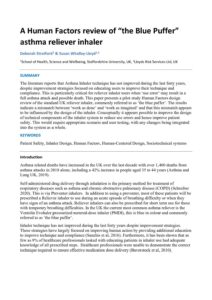
|
Author
Deborah Stratford & Susan Whalley-Lloyd |
Abstract
The literature reports that Asthma Inhaler technique has not improved during the last forty years, despite improvement strategies focused on educating users to improve their technique and compliance. This is particularly critical for reliever inhaler users when ‘use error’ may result in a full asthma attack and possible death. This paper presents a pilot study Human Factors design review of the standard UK reliever inhaler, commonly referred to as ‘the blue puffer’. The results indicate a mismatch between ‘work as done’ and ‘work as imagined’ and that this mismatch appears to be influenced by the design of the inhaler. Conceptually it appears possible to improve the design of technical components of the inhaler system to reduce use errors and hence improve patient safety. This would require appropriate scenario and user testing, with any changes being integrated into the system as a whole. |
Publish Date: Jun 11, 2025 | Keywords: Climate change, Contemporary EHF 2025, Healthcare, Publications, Technology
| Document
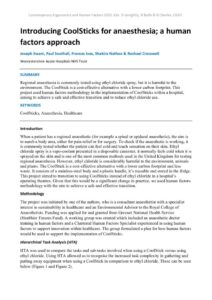
|
Author
Joseph Swani, Paul Southall, Frances Ives, Shakira Nathoo & Rachael Cresswell |
Abstract
Regional anaesthesia is commonly tested using ethyl chloride spray, but it is harmful to the environment. The CoolStick is a cost-effective alternative with a lower carbon footprint. This project used human factors methodology in the implementation of CoolSticks within a hospital, aiming to achieve a safe and effective transition and to reduce ethyl chloride use. |
Publish Date: Dec 17, 2018 | Keywords: Contemporary EHF 2017, Publications
| Document
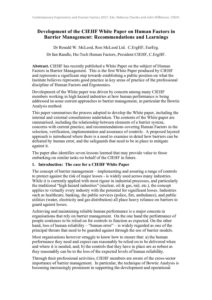
|
Author
Dr Ronald W. McLeod, Dr Ian Randle |
Abstract
CIEHF has recently published a White Paper on the subject of Human Factors in Barrier Management. This is the first White Paper produced by CIEHF and represents a significant step towards establishing a public position on what the Institute believes represents good practice in key areas of practice of the professional discipline of Human Factors and Ergonomics. Development of the White paper was driven by concern among many CIEHF members working in high hazard industries at how human performance is being addressed in some current approaches to barrier management, in particular the Bowtie Analysis method. This paper summarises the process adopted to develop the White paper, including the internal and external consultations undertaken. The contents of the White paper are summarised, including the relationship between elements of a barrier system, concerns with current practice, and recommendations covering Human Factors in the selection, verification, implementation and assurance of controls. A proposed layered approach is introduced where there is a need to examine in detail how barriers can be defeated by human error, and the safeguards that need to be in place to mitigate against it. The paper also identifies seven lessons learned that may provide value to those embarking on similar tasks on behalf of the CIEHF in future. |
Publish Date: Sep 7, 2019 | Keywords: Aviation, Contemporary EHF 2019, Design, Interface design, Publications
| Document
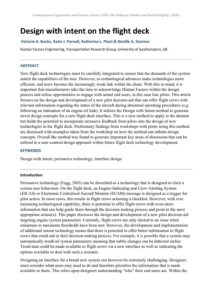
|
Author
Victoria A. Banks, Katie J. Parnell, Katherine L. Plant & Neville A. Stanton |
Abstract
New flight deck technologies must be carefully integrated to ensure that the demands of the system match the capabilities of the user. However, as technological advances make technologies more efficient, end users become the increasingly weak link within the chain. With this in mind, it is important that manufacturers take the time to acknowledge Human Factors within the design process and utilise opportunities to engage with actual end users, in this case line pilots. This article focuses on the design and development of a new pilot decision aid that can offer flight crews with relevant information regarding the status of the aircraft during abnormal operating procedures (e.g. following an indication of an engine oil leak). It utilises the Design with Intent method to generate novel design concepts for a new flight deck interface. This is a new method to apply to the domain but holds the potential to incorporate extensive feedback from pilots into the design of new technologies in the flight deck. Preliminary findings from workshops with pilots using this method are discussed with examples taken from the workshop on how the method can inform design concepts. Overall the method was found to generate important key areas of discussion that can be utilised in a user-centred design approach within future flight deck technology development. |
Publish Date: Jun 11, 2025 | Keywords: Contemporary EHF 2025, Publications, Rail, Tools & techniques
| Document
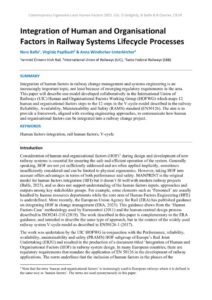
|
Author
Nora Balfe, Virginie Papillault & Anna Windischer-Unterkircher |
Abstract
Integration of human factors in railway change management and systems engineering is an increasingly important topic, not least because of emerging regulatory requirements in the area. This paper will describe one model developed collaboratively in the International Union of Railways (UIC) Human and Organisational Factors Working Group (HOFWG) which maps 12 human and organisational factors steps to the 12 steps in the V-cycle model described in the railway Reliability, Availability, Maintainability and Safety (RAMS) standard (EN50126). The aim is to provide a framework, aligned with existing engineering approaches, to communicate how human and organisational factors can be integrated into a railway change project. |
Publish Date: Jun 11, 2025 | Keywords: Behaviour, Contemporary EHF 2025, Human-machine interaction, Nuclear, Publications, Systems
| Document

|
Author
Wu Xiaoli, Li Yiqun & Li Qian |
Abstract
This study analyses the mechanism of operators' cross-screen interactive behaviour during the execution of typical monitoring tasks from the perspective of attention capture, in order to enhance the superiority of attention capture for critical task information on interfaces, ultimately improving operators' efficiency in manipulation. The connection between the operator's perceptual cognitive process and cross-screen interactive behaviour is established through the bottom-up and top-down attention capture mechanisms. A cross-screen interaction experimental paradigm is proposed, and experiments are conducted in specific scenarios to verify and refine the potential behavioural mechanisms. The experimental results will help to gain a deeper understanding of the underlying mechanisms of cross-screen behaviour and cognitive processes and reveal the mapping relationship between interface factors and cross-screen interactions. |
Publish Date: Jun 8, 2023 | Keywords: Contemporary EHF 2023, Design, Human factors integration, Human performance, Publications, Rail, Sociotechnical systems
| Document
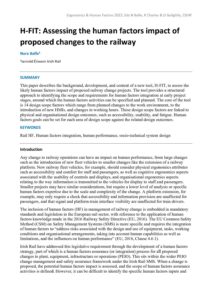
|
Author
Nora Balfe |
Abstract
This paper describes the background, development, and content of a new tool, H-FIT, to assess the likely human factors impact of proposed railway change projects. The tool provides a structured approach to identifying the scope and requirements for human factors integration at early project stages, around which the human factors activities can be specified and planned. The core of the tool is 14 design scope factors which range from planned changes to the work environment, to the introduction of new HMIs, and changes in working hours. These design scope factors are linked to physical and organisational design outcomes, such as accessibility, usability, and fatigue. Human factors goals can be set for each area of design scope against the related design outcomes. |
Publish Date: Aug 6, 2021 | Keywords: Comfort, Comfort Congress 2021, Publications
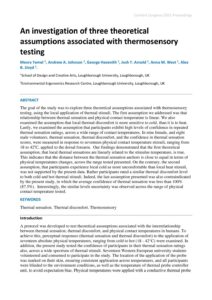 |
Author
Mevra Temel, Andrew A. Johnson, George Havenith, Josh T. Arnold, Anna M. West, Alex B. Lloyd |
Abstract
The goal of the study was to explore three theoretical assumptions associated with thermosensory testing, using the local application of thermal stimuli. The first assumption we addressed was that relationship between thermal sensation and physical contact temperature is linear. We also examined the assumption that local thermal discomfort is more sensitive to cold, than it is to heat. Lastly, we examined the assumption that participants exhibit high levels of confidence in repeated thermal sensation ratings, across a wide range of contact temperatures. In nine female, and eight male volunteers, thermal sensation, thermal discomfort, and the confidence in thermal sensation scores, were measured in response to seventeen physical contact temperature stimuli, ranging from 18 to 42oC, applied to the dorsal forearm. Our findings demonstrated that the first theoretical assumption, that local thermal sensations are linearly related to the stimulus temperature, is true. This indicates that the distance between the thermal sensation anchors is close to equal in terms of physical temperatures changes, across the range tested presented. On the contrary, the second assumption, that participants experience local cold as more uncomfortable than local heat stimuli, was not supported by the present data. Rather participants rated a similar thermal discomfort level to both cold and hot thermal stimuli. Indeed, the last assumption presented was also contraindicated by the present study, in which the average confidence of thermal sensation was less than 100% (87.5%). Interestingly, the similar levels uncertainty was observed across the range of physical contact temperature tested. |
Publish Date: Jun 24, 2022 | Keywords: Contemporary EHF 2022, Manufacturing, Publications, Technology, User experience
| Document
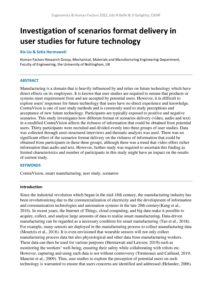
|
Author
Xia Liu & Setia Hermawati |
Abstract
Manufacturing is a domain that is heavily influenced by and relies on future technology which have direct effects on its employees. It is known that user studies are required to ensure that products or systems meet requirement from and are accepted by potential users. However, it is difficult to explore users' responses for future technology that users have no direct experience and knowledge. ContraVison is one of user study methods and is commonly used to study perceptions and acceptance of new future technology. Participants are typically exposed to positive and negative scenarios. This study investigates how different format of scenarios delivery (video, audio and text) in a modified ContraVision affects the richness of information that could be obtained from potential users. Thirty participants were recruited and divided evenly into three groups of user studies. Data was collected through semi-structured interviews and thematic analysis was used. There was no significant effect of the scenarios format delivery on the richness of information that could be obtained from participants in these three groups, although there was a trend that video offers richer information than audio and text. However, further study was required to ascertain this finding as limited characteristics and number of participants in this study might have an impact on the results of current study. |
Publish Date: Apr 16, 2020 | Keywords: Contemporary EHF 2020, Healthcare, Publications
| Document
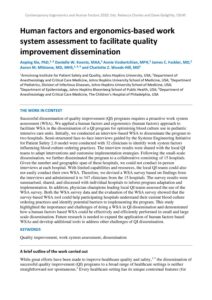
|
Author
Anping Xie, PhD, Danielle W. Koontz, MAA, Annie Voskertchian, MPH, James C. Fackler, MD, Aaron M. Milstone, MD, MHS, and Charlotte Z. Woods-Hill, MD |
Abstract
Successful dissemination of quality improvement (QI) programs requires a proactive work system assessment (WSA). We applied a human factors and ergonomics (human factors) approach to facilitate WSA in the dissemination of a QI program for optimising blood culture use in pediatric intensive care units. Initially, we conducted an interview-based WSA to disseminate the program to two hospitals. Semi-structured face-to-face interviews guided by the Systems Engineering Initiative for Patient Safety 2.0 model were conducted with 32 clinicians to identify work system factors influencing blood culture ordering practices. The interview results were shared with the local QI teams to adapt interventions and customise implementation strategies. Following the small-scale dissemination, we further disseminated the program to a collaborative consisting of 15 hospitals. Given the number and geographic span of these hospitals, we could not conduct in-person interviews at each hospital. With limited capabilities and resources, the local QI teams could also not easily conduct their own WSA. Therefore, we devised a WSA survey based on findings from the interviews and administered it to 347 clinicians from the 15 hospitals. The survey results were summarised, shared, and discussed with individual hospitals to inform program adaptation and implementation. In addition, physician champions leading local QI teams assessed the use of the WSA survey. Both the WSA survey data and the evaluation of the WSA survey showed that the survey-based WSA tool could help participating hospitals understand their current blood culture ordering practices and identify potential barriers to implementing the program. This study highlighted the importance and challenges of doing a WSA in QI dissemination and demonstrated how a human factors based WSA could be effectively and efficiently performed in small and large scale dissemination. Future research is needed to expand the application of human factors based WSAs and develop additional tools to address other challenges of QI dissemination. |
Publish Date: Mar 26, 2019 | Keywords: Contemporary EHF 2016, Human-machine interaction, Maritime, Publications, Situation awareness
| Document
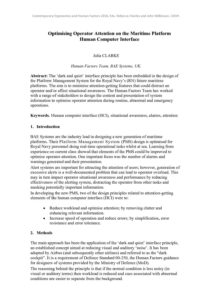
|
Author
Julia CLARKE |
Abstract
The ‘dark and quiet’ interface principle has been embedded in the design of the Platform Management System for the Royal Navy’s (RN) future maritime platforms. The aim is to minimise attention-getting features that could distract an operator and/or affect situational awareness. The Human Factors Team has worked with a range of stakeholders to design the content and presentation of system information to optimise operator attention during routine, abnormal and emergency operations. |
Publish Date: Sep 7, 2019 | Keywords: Autonomous vehicles, Contemporary EHF 2019, Publications, Situation awareness
| Document
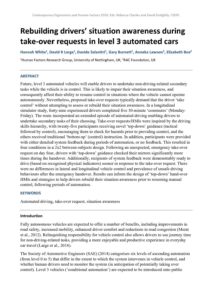
|
Author
Hannah White, David R Large, Davide Salanitri, Gary Burnett, Anneka Lawson, Elizabeth Box |
Abstract
Future, level 3 automated vehicles will enable drivers to undertake non-driving-related secondary tasks while the vehicle is in control. This is likely to impair their situation awareness, and consequently affect their ability to resume control in situations where the vehicle cannot operate autonomously. Nevertheless, proposed take-over requests typically demand that the driver ‘take control’ without attempting to assess or rebuild their situation awareness. In a longitudinal simulator study, forty-nine experienced drivers completed five 30-minute ‘commutes’ (Monday-Friday). The route incorporated an extended episode of automated driving enabling drivers to undertake secondary tasks of their choosing. Take-over requests/HMIs were inspired by the driving skills hierarchy, with twenty-five participants receiving novel ‘top-down’ guidance (tactical followed by control), encouraging them to check for hazards prior to providing control, and the others received traditional ‘bottom-up’ (control) instruction. In addition, participants were provided with either detailed system feedback during periods of automation, or no feedback. This resulted in four conditions in a 2x2 between-subjects design. Following an unexpected, emergency take-over request on day four, drivers with ‘top-down’ guidance checked their mirrors significantly more times during the handover. Additionally, recipients of system feedback were demonstrably ready to drive (based on recognised physical indicators) sooner in response to the take-over request. There were no differences in lateral and longitudinal vehicle control and prevalence of unsafe driving behaviours after the emergency handover. Results can inform the design of ‘top-down’ hand-over HMIs and strategies to help drivers rebuild their situation awareness prior to resuming manual control, following periods of automation. |
Publish Date: May 30, 2024 | Keywords: Contemporary EHF 2024, Healthcare, Human factors integration, Publications
| Document
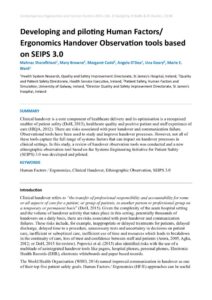
|
Author
Mahnaz Sharafkhani, Mary Browne, Margaret Codd, Angela O’Dea, Una Geary, Marie E. Ward |
Abstract
Clinical handover is a core component of healthcare delivery and its optimisation is a recognised enabler of patient safety (DoH, 2015), healthcare quality and positive patient and staff experience of care (HIQA, 2012). There are risks associated with poor handover and communication failure. Observational tools have been used to study and improve handover processes. However, not all of these tools capture the full range of systems factors that can impact on handover processes in clinical settings. In this study, a review of handover observation tools was conducted and a new ethnographic observation tool based on the Systems Engineering Initiative for Patient Safety (SEIPS) 3.0 was developed and piloted. |
Publish Date: Jun 12, 2023 | Keywords: Contemporary EHF 2023, Healthcare, Publications, SEIPS
| Document
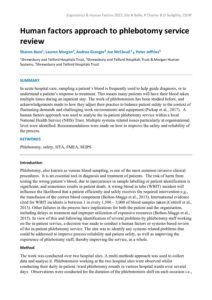
|
Author
Sharon Beza, Lauren Morgan, Andrea Granger, Joe McCloud 4 & Peter Jeffries |
Abstract
In acute hospital care, sampling a patient’s blood is frequently used to help guide diagnosis, or to understand a patient’s response to treatment. This means many patients will have their blood taken multiple times during an inpatient stay. The work of phlebotomists has been studied before, and acknowledgements made to how they adjust their practice to balance patient safety in the context of fluctuating demands and challenging work environments and equipment (Pickup et al., 2017). A human factors approach was used to analyse the in-patient phlebotomy service within a local National Health Service (NHS) Trust. Multiple systems related issues particularly at organisational level were identified. Recommendations were made on how to improve the safety and reliability of the process. |
Publish Date: May 30, 2024 | Keywords: Contemporary EHF 2024, Human factors integration, Publications, Rail
| Document
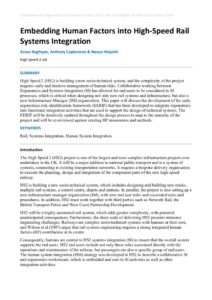
|
Author
Arzoo Naghiyev, Anthony Coplestone & Nassar Majothi |
Abstract
High Speed 2 (HS2) is building a new socio-technical system, and the complexity of the project requires early and iterative management of human risks. Collaborative working between Ergonomics and Systems Integration (SI) has allowed for end users to be considered in SI processes, which is critical when designing not only new rail systems and infrastructure, but also a new Infrastructure Manager (IM) organisation. This paper will discuss the development of the early ergonomics risk identification framework (EERIF) that has been developed to integrate ergonomics into functional integration activities that are used to support the design of technical systems. The EERIF will be iteratively updated throughout the design process to map to the maturity of the project and will be re-reviewed against existing HF taxonomies and methods. |
Publish Date: May 27, 2025 | Keywords: Contemporary EHF 2025, Design, Publications, User centred design
| Document
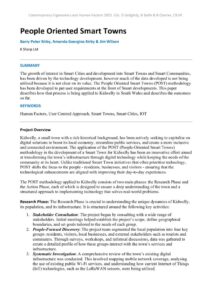
|
Author
Barry Peter Kirby, Amanda Georgina Kirby & Jim Wilson |
Abstract
The growth of interest in Smart Cities and development into Smart Towns and Smart Communities, has been driven by the technology development, however much of the data developed is not being utilised because it is not clear on its value. The People Oriented Smart Towns (POST) methodology has been developed to put user requirements at the front of Smart developments. This paper describes how that process is being applied to Kidwelly in South Wales and describes the outcomes so far. |
Publish Date: Jul 23, 2018 | Keywords: Behaviour, Contemporary EHF 2018, Leadership, Publications, Safety
| Document
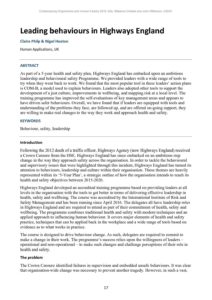
|
Author
Claire Philp & Nigel Heaton |
Abstract
As part of a 5-year health and safety plan, Highways England has embarked upon an ambitious leadership and behavioural safety Programme. We provided leaders with a wide range of tools to try when they went back to work. We found that the most popular tool in these leaders’ action plans is COM-B, a model used to explain behaviours. Leaders also adopted other tools to support the development of a just culture, improvements in wellbeing, and mapping risk at a local level. The training programme has improved the self-evaluations of key management areas and appears to have driven safer behaviours. Overall, we have found that if leaders are equipped with tools and understanding of the problems they face, are followed up, and are offered on-going support, they are willing to make real changes to the way they work and approach health and safety. |
Publish Date: Apr 17, 2020 | Keywords: Climate change, Contemporary EHF 2020, Manufacturing, Publications
| Document
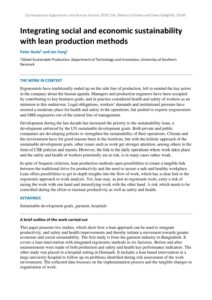
|
Author
Peter Hasle and Jan Vang |
Abstract
Ergonomists have traditionally ended up on the side line of production, left to remind the key actors in the company about the human agenda. Managers and production engineers have been occupied by contributing to key business goals, and in practice considered health and safety of workers as an intrusion to this endeavour. Legal obligations, workers’ demands and institutional pressure have secured a moderate place for health and safety in the operations, but pushed to experts (ergonomists and OHS engineers) out of the central line of management. Development during the last decade has increased the priority to the sustainability issue, a development enforced by the UN sustainable development goals. Both private and public companies are developing policies to strengthen the sustainability of their operations. Climate and the environment have for good reasons been in the forefront, but with the holistic approach of the sustainable development goals, other issues such as work get stronger attention, among others in the form of CSR policies and reports. However, the link to the daily operations where work takes place and the safety and health of workers potentially are at risk, is in many cases rather weak. In spite of frequent criticism, lean production methods open possibilities to create a tangible link between the traditional drive for productivity and the need to secure a safe and healthy workplace. Lean offers possibilities to get in-depth insights into the flow of work, which has a clear link to the ergonomic approach to work analysis. Yet, lean may, as just as ergonomic tools, carry a risk of easing the work with one hand and intensifying work with the other hand. A risk which needs to be controlled during the effort to increase productivity as well as safety and health. |
Publish Date: Apr 8, 2021 | Keywords: Behaviour, Climate change, Contemporary EHF 2021, Publications
| Document
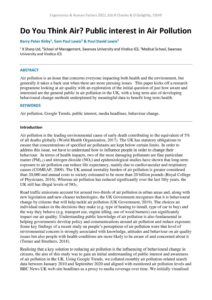
|
Author
Barry Peter Kirby, Sam Paul Lewis & Paul David Lewis |
Abstract
Air pollution is an issue that concerns everyone impacting both health and the environment, but generally it takes a back seat when there are more pressing issues. This paper kicks off a research programme looking at air quality with an exploration of the initial question of just how aware and interested are the general public in air pollution in the UK, with a long term aim of developing behavioural change methods underpinned by meaningful data to benefit long term health. |
Publish Date: Mar 25, 2019 | Keywords: Contemporary EHF 2016, Healthcare, Patient Safety, Publications
| Document
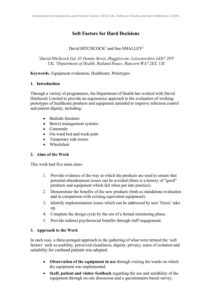
|
Author
David HITCHCOCK and Sue SMALLEY |
Abstract
|
Publish Date: Jun 8, 2023 | Keywords: Artificial intelligence, Contemporary EHF 2023, Publications, Systems
| Document
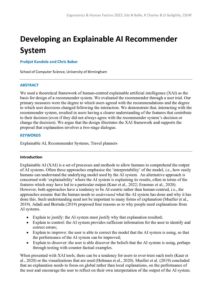
|
Author
Prabjot Kandola & Chris Baber |
Abstract
We used a theoretical framework of human-centred explainable artificial intelligence (XAI) as the basis for design of a recommender system. We evaluated the recommender through a user trial. Our primary measures were the degree to which users agreed with the recommendations and the degree to which user decisions changed following the interaction. We demonstrate that, interacting with the recommender system, resulted in users having a clearer understanding of the features that contribute to their decision (even if they did not always agree with the recommender system’s decision or change the decision). We argue that the design illustrates the XAI framework and supports the proposal that explanation involves a two-stage dialogue. |
Publish Date: Aug 9, 2021 | Keywords: Autonomous vehicles, Comfort, Comfort Congress 2021, Publications, Seating
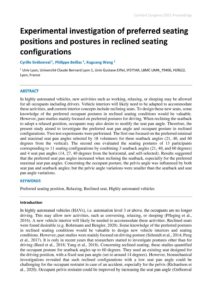 |
Author
Cyrille Grébonval, Philippe Beillas, Xuguang Wang |
Abstract
In highly automated vehicles, new activities such as working, relaxing, or sleeping may be allowed for all occupants including drivers. Vehicle interiors will likely need to be adapted to accommodate these activities, and current interior concepts include reclining seats. To design these new seats, some knowledge of the preferred occupant postures in reclined seating conditions would be valuable. However, past studies mainly focused on preferred postures for driving. When reclining the seatback to adopt a relaxed position, occupants may also desire to modify the seat pan angle. Therefore, the present study aimed to investigate the preferred seat pan angle and occupant posture in reclined configurations. Two test experiments were performed. The first one focused on the preferred minimal and maximal seat pan angles selected by 18 volunteers for three seatback angles (21, 40, and 60 degrees from the vertical). The second one evaluated the seating postures of 13 participants corresponding to 11 seating configurations by combining 3 seatback angles (21, 40, and 60 degrees) and 4 seat pan angles (14, 27, 40 degrees from the horizontal, and self-selected). Results suggested that the preferred seat pan angles increased when reclining the seatback, especially for the preferred maximal seat pan angles. Concerning the occupant posture, the pelvis angle was influenced by both seat pan and seatback angles; but the pelvic angle variations were smaller than the seatback and seat pan angle variations. |
Publish Date: Jun 24, 2022 | Keywords: Contemporary EHF 2022, Healthcare, Publications, Usability
| Document
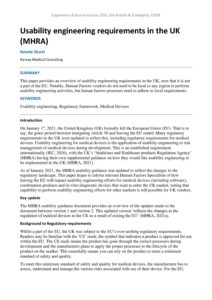
|
Author
Natalie Shortt |
Abstract
This paper provides an overview of usability engineering requirements in the UK, now that it is not a part of the EU. Notably, Human Factors vendors do not need to be local to any region to perform usability engineering activities, but human factors processes need to adhere to local requirements. |
Publish Date: Jun 5, 2024 | Keywords: Contemporary EHF 2024, Human performance, Incidents, Investigation, Publications, Rail, Safety
| Document
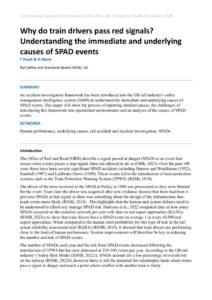
|
Author
T Hyat & A Monk |
Abstract
An accident investigation framework has been introduced into the GB rail industry's safety management intelligence system (SMIS) to understand the immediate and underlying causes of SPAD events. This paper will show the process of reporting detailed causes, the challenges of introducing this framework into operational environments and an analysis of the causes of SPAD events. |
Publish Date: Apr 9, 2021 | Keywords: Aviation, Contemporary EHF 2021, Fatigue & sleep, Publications
| Document
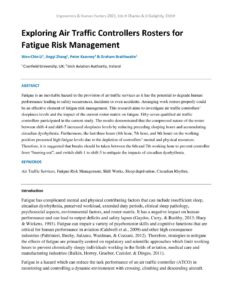
|
Author
Wen-Chin Li, Jingyi Zhang, Peter Kearney & Graham Braithwaite |
Abstract
Fatigue is an inevitable hazard in the provision of air traffic services as it has the potential to degrade human performance leading to safety occurrences, incidents or even accidents. Arranging work rosters properly could be an effective element of fatigue risk management. This research aims to investigate air traffic controllers’ sleepiness levels and the impact of the current roster matrix on fatigue. Fifty-seven qualified air traffic controllers participated in the current study. The results demonstrated that the compressed nature of the roster between shift-4 and shift-5 increased sleepiness levels by reducing preceding sleeping hours and accumulating circadian dysrhythmia. Furthermore, the last three hours (6th hour, 7th hour, and 8th hour) on the working position presented high fatigue levels due to the depletion of controllers’ mental and physical resources. Therefore, it is suggested that breaks should be taken between the 6th and 7th working hour to prevent controller from “burning out”, and switch shift-1 to shift-5 to mitigate the impacts of circadian dysrhythmia. |
Publish Date: Jun 5, 2024 | Keywords: Contemporary EHF 2024, Ergonomics, Human factors integration, Patient Safety, Publications
| Document
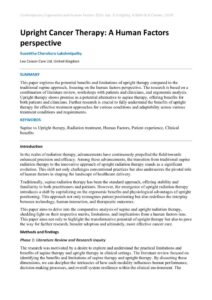
|
Author
Susmitha Cherukuru Lakshmipathy |
Abstract
This paper explores the potential benefits and limitations of upright therapy compared to the traditional supine approach, focusing on the human factors perspective. The research is based on a combination of literature review, workshops with patients and clinicians, and ergonomic analysis. Upright therapy shows promise as a potential alternative to supine therapy, offering benefits for both patients and clinicians. Further research is crucial to fully understand the benefits of upright therapy for effective treatment approaches for various conditions and adaptability across various treatment conditions and requirements. |
Publish Date: Feb 26, 2019 | Keywords: Contemporary EHF 2016, Healthcare, Publications, Simulation
| Document
I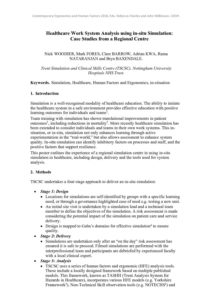 |
Author
Nick WOODIER, Mark FORES, Clare BARROW, Adrian KWA, Rama NATARANJAN and Bryn BAXENDALE |
Abstract
|
Publish Date: Jun 23, 2022 | Keywords: Contemporary EHF 2022, Healthcare, Publications, Systems
| Document
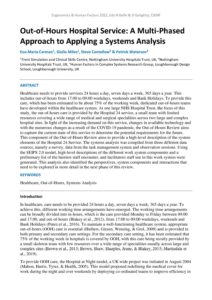
|
Author
Eva-Maria Carman, Giulia Miles, Steve Cantellow & Patrick Waterson |
Abstract
Healthcare needs to provide services 24 hours a day, seven days a week, 365 days a year. This includes out-of-hours from 17:00 to 09:00 weekdays, weekends and Bank Holidays. To provide this care, which has been estimated to be about 75% of the working week, dedicated out-of-hours teams have developed within the healthcare system. At one large NHS Hospital Trust, the focus of this study, the out-of-hours care is provided by the Hospital 24 service, a small team with limited resources covering a wide range of medical and surgical specialities across two large and complex hospital sites. In light of the increasing demand on this service, changes in available technology and with the numerous changes as a result of the COVID-19 pandemic, the Out-of-Hours Review aims to capture the current state of this service to determine the potential requirements for the future. This component of the Out-of-Hours Review aims to provide a high-level description of the system elements of the Hospital 24 Service. The systems analysis was compiled from three different data sources, namely a survey, data from the task management system and observation sessions. Using the SEIPS 2.0 model, high-level descriptions of the different work system components and a preliminary list of the barriers staff encounter, and facilitators staff use in this work system were generated. This analysis also identified the perspectives, system components and interactions that need to be explored in more detail in the next phase of this review. |
Publish Date: Apr 9, 2020 | Keywords: Construction, Contemporary EHF 2020, Investigation, Publications
| Document
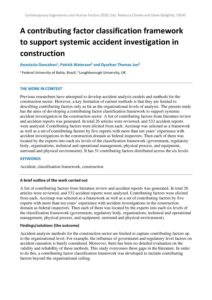
|
Author
Anastacio Goncalves, Patrick Waterson and Gyuchan Thomas Jun |
Abstract
Previous researchers have attempted to develop accident analysis models and methods for the construction sector. However, a key limitation of current methods is that they are limited to describing contributing factors only as far as the organisational levels of analysis. The present study has the aims of developing a contributing factor classification framework to support systemic accident investigation in the construction sector. A list of contributing factors from literature review and accident reports was generated. In total 26 articles were reviewed, and 532 accident reports were analysed. Contributing factors were elicited from each. Accimap was selected as a framework as well as a set of contributing factors by five experts with more than ten years’ experience with accident investigations in the construction domain as federal inspectors. Then each of them was located by the experts into each six levels of the classification framework (government, regulatory body, organisations, technical and operational management, physical process, and equipment, surround and physical environment). It has 51 contributing factors distributed across the six levels. |
Publish Date: Oct 22, 2018 | Keywords: Contemporary EHF 2018, Emergency services, Healthcare, Publications, Tools & techniques
| Document
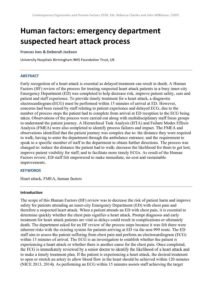
|
Author
Frances Ives & Deborah Jackson |
Abstract
Early recognition of a heart attack is essential as delayed treatment can result in death. A Human Factors (HF) review of the process for treating suspected heart attack patients in a busy inner-city Emergency Department (ED) was completed to help decrease risk, improve patient safety, care and patient and staff experience. To provide timely treatment for a heart attack, a diagnostic electrocardiogram (ECG) must be performed within 15 minutes of arrival at ED. However, concerns had been raised by staff relating to patient experience and delayed ECG, due to the number of process steps the patient had to complete from arrival at ED reception to the ECG being taken. Observations of the process were carried out along with multidisciplinary staff focus groups to understand the patient journey. A Hierarchical Task Analysis (HTA) and Failure Modes Effects Analysis (FMEA) were also completed to identify process failures and impact. The FMEA and observations identified that the patient journey was complex due to: the distance they were required to walk; having to enter the department through the ambulance entrance; and the requirement to speak to a specific member of staff in the department to obtain further directions. The process was changed to: reduce the distance the patient had to walk; decrease the likelihood for them to get lost; improve patient visibility for staff; and to facilitate more timely ECGs. As result of the Human Factors review, ED staff felt empowered to make immediate, no-cost and sustainable improvements. |
Publish Date: Jun 22, 2022 | Keywords: Climate change, Contemporary EHF 2022, Publications
| Document
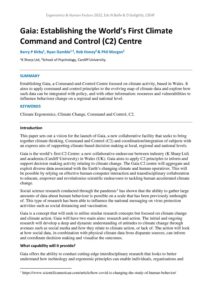
|
Author
Barry P Kirby, Ryan Gamble, Rob Honey & Phil Morgan |
Abstract
Establishing Gaia, a Command-and-Control Centre focused on climate activity, based in Wales. It aims to apply command and control principles to the evolving map of climate data and explore how such data can be integrated with policy, and with other information: resources and vulnerabilities to influence behaviour change on a regional and national level. |
Publish Date: Oct 23, 2018 | Keywords: Contemporary EHF 2018, Publications, Systems, Tools & techniques
| Document
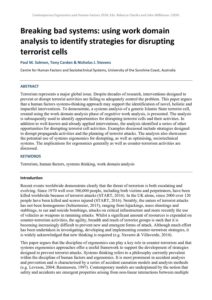
|
Author
Paul M. Salmon, Tony Carden & Nicholas J. Stevens |
Abstract
Terrorism represents a major global issue. Despite decades of research, interventions designed to prevent or disrupt terrorist activities are failing to adequately control the problem. This paper argues that a human factors systems-thinking approach may support the identification of novel, holistic and impactful interventions. To demonstrate, a systems analysis of a generic Islamic State terrorist cell, created using the work domain analysis phase of cognitive work analysis, is presented. The analysis is subsequently used to identify opportunities for disrupting terrorist cells and their activities. In addition to well-known and already applied interventions, the analysis identified a series of other opportunities for disrupting terrorist cell activities. Examples discussed include strategies designed to disrupt propaganda activities and the planning of terrorist attacks. The analysis also showcases the potential use of systems ergonomics for disrupting, as well as optimising, sociotechnical systems. The implications for ergonomics generally as well as counter-terrorism activities are discussed. |
Publish Date: Jun 24, 2022 | Keywords: Agriculture & forestry, Contemporary EHF 2022, Non-technical skills, Publications
| Document
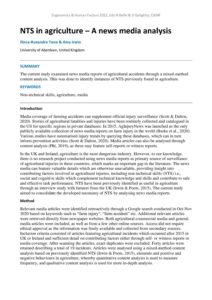
|
Author
Ilinca-Ruxandra Tone & Amy Irwin |
Abstract
The current study examined news media reports of agricultural accidents through a mixed-method content analysis. This was done to identify instances of NTS previously found in agriculture. |
Publish Date: May 23, 2025 | Keywords: Automotive, Comfort, Contemporary EHF 2025, Publications
| Document
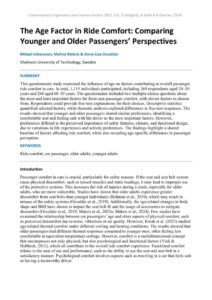
|
Author
Mikael Johansson, Melina Makris & Anna-Lisa Osvalder |
Abstract
This questionnaire study examined the influence of age on factors contributing to overall passenger ride comfort in cars. In total, 1,115 individuals participated, including 269 respondents aged 20–30 years and 260 aged 60–83 years. The questionnaire included two multiple-choice questions about the most and least important factors for front-seat passenger comfort, with eleven factors to choose from. Respondents could provide free-text explanations for their choices. Descriptive statistics quantified selected factors, while thematic analysis explored differences in free-text responses. The results showed that younger and older passengers shared similar preferences, identifying a comfortable seat and feeling safe with the driver as the most important factors. However, preferences differed in the perceived importance of safety features, climate, and functional design, due to variations in life experiences and activity preferences. The findings highlight a shared baseline of factors affecting ride comfort, while also revealing age-specific differences in passenger perception. |
Publish Date: Oct 23, 2018 | Keywords: Contemporary EHF 2018, Human performance, Publications
| Document
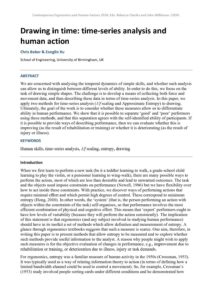
|
Author
Chris Baber & Zonglin Xu |
Abstract
We are concerned with analysing the temporal dynamics of simple skills, and whether such analysis can allow us to distinguish between different levels of ability. In order to do this, we focus on the task of drawing simple shapes. The challenge is to develop a means of collecting both force and movement data, and then describing these data in terms of time-series analysis. In this paper, we apply two methods for time-series analysis (1/f scaling and Approximate Entropy) to drawing. Ultimately, the goal of the work is to consider whether these measures allow us to differentiate ability in human performance. We show that it is possible to separate ‘good’ and ‘poor’ performers using these methods, and that this separation agrees with the self-identified ability of participants. If it is possible to provide ways of describing performance, then we can evaluate whether this is improving (as the result of rehabilitation or training) or whether it is deteriorating (as the result of injury or illness). |
Publish Date: Sep 30, 2018 | Keywords: Contemporary EHF 2018, Healthcare, Publications, Sociotechnical systems, Technology
| Document
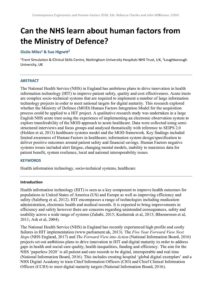
|
Author
Giulia Miles & Sue Hignett |
Abstract
The National Health Service (NHS) in England has ambitious plans to drive innovation in health information technology (HIT) to improve patient safety, quality and cost effectiveness. Acute trusts are complex socio-technical systems that are required to implement a number of large information technology projects in order to meet national targets for digital maturity. This research explored whether the Ministry of Defence (MOD) Human Factors Integration Model for the acquisition process could be applied to a HIT project. A qualitative research study was undertaken in a large English NHS acute trust using the experience of implementing an electronic observation system to explore transferability of the MOD approach to acute healthcare. Data were collected using semi-structured interviews and focus groups and analysed thematically with reference to SEIPS 2.0 (Holden et al, 2013) healthcare systems model and the MOD framework. Key findings included limited awareness of Human Factors in healthcare; information system design/specification to deliver positive outcomes around patient safety and financial savings. Human Factors negative systems issues included alert fatigue, changing mental models, inability to maximise data for patient benefit, system resilience, local and national interoperability issues. |
Publish Date: May 27, 2025 | Keywords: Behaviour, Contemporary EHF 2025, Natural Disaster, Publications
| Document
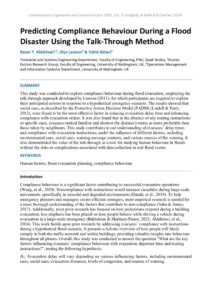
|
Author
Razan Y. Aldahlawi, Glyn Lawson & Vahid Akbari |
Abstract
This study was conducted to explore compliance behaviour during flood evacuation, employing the talk-through approach developed by Lawson (2011), for which participants are required to explain their anticipated actions in response to a hypothetical emergency scenario. The results showed that social cues, as described by the Protective Action Decision Model (PADM) (Lindell & Perry, 2012), were found to be the most effective factor in reducing evacuation delay time and enhancing compliance with evacuation orders. It was also found that in the absence of any routing instructions or specific cues, evacuees ranked familiar and shortest (by distance) routes as more preferable than those taken by neighbours. This study contributes to our understanding of evacuees’ delay times and compliance with evacuation instructions, under the influence of different factors, including environmental cues, social cues, warning message contents, and various sources of the warning. It also demonstrated the value of the talk-through as a tool for studying human behaviour in floods without the risks or complications associated with data collection in real flood events. |
Publish Date: Feb 27, 2019 | Keywords: Contemporary EHF 2016, Publications, Rail, Simulation, Workload
| Document
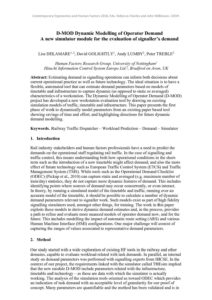
|
Author
Lise DELAMARE, David GOLIGHTLY, Andy LUMBY, Peter TREBLE |
Abstract
Estimating demand in signalling operations can inform both decisions about current operational practice as well as future technology. The ideal situation is to have a flexible, automated tool that can estimate demand parameters based on models of timetable and infrastructure to capture dynamic (as opposed to static or averaged) characteristics of a workstation. The Dynamic Modelling of Operator Demand (D-MOD) project has developed a new workstation evaluation tool by drawing on existing simulation models of traffic, timetable and infrastructure. This paper presents the first phase of work to dynamically model parameters from an existing paper based tool showing savings of time and effort, and highlighting directions for future dynamic demand modelling. |
Publish Date: Jun 23, 2022 | Keywords: Accessibility, Comfort, Contemporary EHF 2022, Healthcare, Patient Safety, Publications
| Document
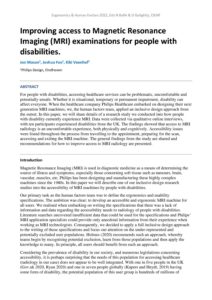
|
Author
Jon Mason, Joshua Fox & Kiki Veenhof |
Abstract
For people with disabilities, accessing healthcare services can be problematic, uncomfortable and potentially unsafe. Whether it is situational, temporary or permanent impairment, disability can affect everyone. When the healthcare company Philips Healthcare embarked on designing their next generation MRI machines, we, the human factors team, applied an inclusive design approach from the outset. In this paper, we will share details of a research study we conducted into how people with disability currently experience MRI. Data were collected via qualitative online interviews, with ten participants experienced disabilities from the UK. The findings showed that access to MRI radiology is an uncomfortable experience, both physically and cognitively. Accessibility issues were found throughout the process from travelling to the appointment, preparing for the scan, accessing and exiting the MRI machine. The general findings from the study are shared and recommendations for how to improve access to MRI radiology are presented. |
Publish Date: May 31, 2024 | Keywords: Contemporary EHF 2024, Nuclear, Publications, Safety
| Document
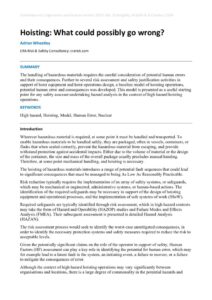
|
Author
Adrian Wheatley |
Abstract
The handling of hazardous materials requires the careful consideration of potential human errors and their consequences. Further to several risk assessment and safety justification activities in support of hoist equipment and hoist operations design, a baseline model of hoisting operations, potential human error and consequences was developed. This model is presented as a useful starting point for any safety assessor undertaking hazard analysis in the context of high hazard hoisting operations. |
Publish Date: Jun 4, 2024 | Keywords: Aviation, Contemporary EHF 2024, Incidents, Publications, Safety, Situation awareness, Systems, Workload
| Document
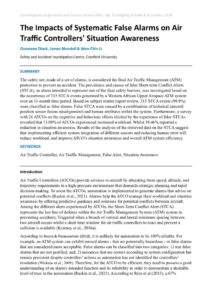
|
Author
Ousmane Diack, James Blundell & Wen-Chin Li |
Abstract
The safety net, made of a set of alarms, is considered the final Air Traffic Management (ATM) protection to prevent an accident. The prevalence and causes of false Short-term Conflict Alerts (STCA), an alarm intended to represent one of the final safety barriers, was investigated based on the occurrence of 315 STCA events generated by a Western African Upper Airspace ATM system over an 11-month time period. Based on subject matter expert review, 313 STCA events (99.9%) were classified as false alarms. False STCA were caused by a combination of technical (aircraft position sensor fusion misalignment) and human attributes within the system. Furthermore, a survey with 26 ATCOs on the cognitive and behaviour effects elicited by the experience of false STCAs revealed that 73.08% of ATCOs experienced increased workload. Whilst 38.46% reported a reduction in situation awareness. Results of the analysis of the retrieved data on the STCA suggest that implementing efficient system integration of different sensors and reducing human error will reduce workload, and improve ATCO’s situation awareness and overall ATM system efficiency. |
Publish Date: Apr 15, 2020 | Keywords: Contemporary EHF 2020, Interface design, Publications, Situation awareness, Workload
| Document
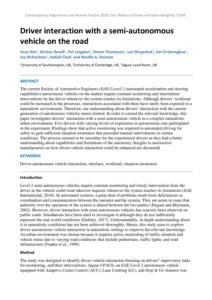
|
Author
Jisun Kim, Kirsten Revell, Pat Langdon, Simon Thompson, Lee Skrypchuk, Jim O-Donoghue, Joy Richardson, Jediah Clark and Neville A. Stanton |
Abstract
The current Society of Automotive Engineers (SAE) Level 2 (automated acceleration and steering capabilities) autonomous vehicles on the market require constant monitoring and intermittent interventions by the driver whenever the system reaches its limitations. Although drivers’ workload could be increased in the processes, interactions associated with them have rarely been explored in a naturalistic environment. Therefore, our understanding about drivers’ interaction with the current generation of autonomous vehicles seems limited. In order to extend the relevant knowledge, this paper investigates drivers’ interaction with a semi-autonomous vehicle in a complex naturalistic urban environment. Five drivers with varying levels of experience in autonomous cars participated in the experiment. Findings show that active monitoring was required in automated driving for safety to gain sufficient situation awareness that preceded manual interventions in certain conditions. The process seemed to be smoother for the experienced drivers as they had a better understanding about capabilities and limitations of the autonomy. Insights to automotive manufacturers on how driver-vehicle interaction could be enhanced are discussed. |
Publish Date: Sep 7, 2019 | Keywords: Contemporary EHF 2019, Non-technical skills, Publications, Safety
| Document
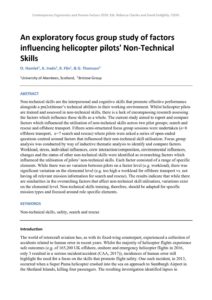
|
Author
O. Hamlet, A. Irwin, R. Flin, & G. Thomson |
Abstract
Non-technical skills are the interpersonal and cognitive skills that promote effective performance alongside a pra2ctitioner’s technical abilities in their working environment. Whilst helicopter pilots are trained and assessed in non-technical skills, there is a lack of encompassing research assessing the factors which influence these skills as a whole. The current study aimed to report and compare factors which influenced the utilisation of non-technical skills across two pilot groups; search and rescue and offshore transport. Fifteen semi-structured focus group sessions were undertaken (n=8 offshore transport, n=7 search and rescue) where pilots were asked a series of open-ended questions centred around factors that influenced their non-technical skill utilisation. Focus group analysis was conducted by way of inductive thematic analysis to identify and compare factors. Workload, stress, individual influences, crew interaction/composition, environmental influences, changes and the status of other non-technical skills were identified as overarching factors which influenced the utilisation of pilots’ non-technical skills. Each factor consisted of a range of specific elements. While there was no variation between pilots on a factor level (e.g. workload), there was significant variation on the elemental level (e.g. too high a workload for offshore transport vs. not having all relevant mission information for search and rescue). The results indicate that while there are similarities in the overarching factors that affect non-technical skill utilisation, variations exist on the elemental level. Non-technical skills training, therefore, should be adapted for specific mission types and focused around role specific elements. |
Publish Date: Mar 17, 2019 | Keywords: Contemporary EHF 2016, Maritime, Publications
| Document
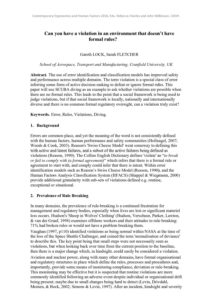
|
Author
Gareth LOCK, Sarah FLETCHER |
Abstract
The use of error identification and classification models has improved safety and performance across multiple domains. The term violation is a special class of error inferring some form of active decision making to defeat or ignore formal rules. This paper will use SCUBA diving as an example to ask whether violations are possible when there are no formal rules. This leads to the point that a social framework is being used to judge violations, but if that social framework is locally, nationally and internationally diverse and there is no common formal regulatory oversight, can a violation truly exist? |
Publish Date: Apr 16, 2020 | Keywords: Contemporary EHF 2020, Publications, Safety
| Document
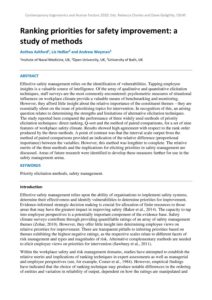
|
Author
Anthea Ashford, Liz Hellier and Andrew Weyman |
Abstract
Effective safety management relies on the identification of vulnerabilities. Tapping employee insights is a valuable source of intelligence. Of the array of qualitative and quantitative elicitation techniques, staff surveys are the most commonly encountered: psychometric measures of situational influences on workplace climate provide a valuable means of benchmarking and monitoring. However, they afford little insight about the relative importance of the constituent themes – they are essentially silent on the issue of prioritising topics for intervention. In recognition of this, an arising question relates to determining the strengths and limitations of alternative elicitation techniques. The study reported here compared the performance of three widely used methods of priority elicitation techniques: direct ranking, Q-sort and the method of paired comparisons, for a set of nine features of workplace safety climate. Results showed high agreement with respect to the rank order produced by the three methods. A point of contrast was that the interval scale output from the method of paired comparisons provided an indication of the relative difference (proportional importance) between the variables. However, this method was lengthier to complete. The relative merits of the three methods and the implications for eliciting priorities in safety management are discussed. Areas of future research were identified to develop these measures further for use in the safety management arena. |
Publish Date: Sep 8, 2019 | Keywords: Aviation, Contemporary EHF 2019, Design, Publications, User experience
| Document
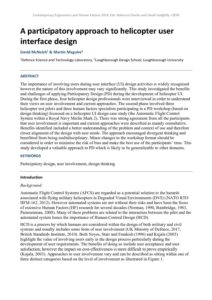
|
Author
David McNeish & Martin Maguire |
Abstract
The importance of involving users during user interface (UI) design activities is widely recognised however the nature of this involvement may vary significantly. This study investigated the benefits and challenges of applying Participatory Design (PD) during the development of helicopter UI. During the first phase, four helicopter design professionals were interviewed in order to understand their views on user involvement and current approaches. The second phase involved three helicopter test pilots and three human factors specialists participating in a PD workshop (based on design thinking) focussed on a helicopter UI design case study (the Automatic Flight Control System within a Royal Navy Merlin Mark 2). There was strong agreement from all the participants that user involvement is important and current approaches were described as mainly consultative. Benefits identified included a better understanding of the problem and context of use and therefore closer alignment of the design with user needs. The approach encouraged divergent thinking and benefitted from being multidisciplinary. Minor changes to the workshop format should be considered in order to minimise the risk of bias and make the best use of the participants’ time. This study developed a valuable approach to PD which is likely to be generalizable to other domains. |
Publish Date: May 22, 2025 | Keywords: Aviation, Contemporary EHF 2025, Publications, Risk assessment, Safety
| Document
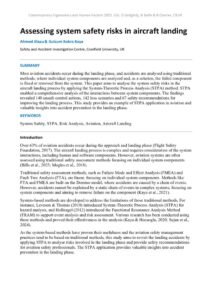
|
Author
Ahmed Jilaau & Gulsum Kubra Kaya |
Abstract
Most aviation accidents occur during the landing phase, and accidents are analysed using traditional methods, where individual system components are analysed and, as a solution, the failed component is fixed or removed from the system. This paper aims to analyse the system safety risks in the aircraft landing process by applying the System-Theoretic Process Analysis (STPA) method. STPA enabled a comprehensive analysis of the interactions between system components. The findings revealed 140 unsafe control actions, 142 loss scenarios and 67 safety recommendations for improving the landing process. This study provides an example of STPA application in aviation and valuable insights into accident prevention in the landing phase. |
Publish Date: Mar 17, 2019 | Keywords: Anthropometry, Contemporary EHF 2016, Healthcare, Publications
| Document
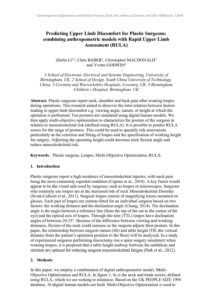
|
Author
Zhelin LI, Chris BABER, Christopher MACDONALD and Yvette GODWIN |
Abstract
Plastic surgeons report neck, shoulder and back pain after wearing loupes during operations. This research aimed to discover the inter-relation between factors leading to upper-limb discomfort e.g. viewing angle, stature, or height at which the operation is performed. Ten postures are simulated using digital human models. We then apply multi-objective optimization to characterize the posture of the surgeon in relation to musculoskeletal risk (defined using RULA). It is possible to predict RULA scores for the range of postures. This could be used to quantify risk assessment, particularly in the selection and fitting of loupes and the specification of working height for surgery. Adjusting the operating height could decrease neck flexion angle and reduce musculoskeletal risk. |
Publish Date: Oct 30, 2018 | Keywords: Contemporary EHF 2017, Perception, Publications, Task analysis
| Document
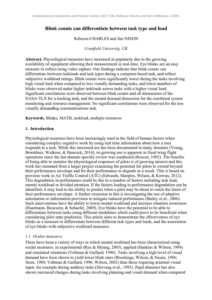
|
Author
Rebecca CHARLES and Jim NIXON |
Abstract
Physiological measures have increased in popularity due to the growing availability of equipment allowing their measurement in real-time. Eye blinks are an easy measure to collect using video capture. Our findings indicate that blink counts can differentiate between taskloads and task types during a computer-based task, and reflect subjective workload ratings. Blink counts were significantly lower during the tasks involving high visual load when compared to less visually demanding tasks, and lower numbers of blinks were observed under higher taskloads across tasks with a higher visual load. Significant correlations were observed between blink counts and all dimensions of the NASA-TLX for a tracking task, and the mental demand dimension for the combined system monitoring and resource management. No significant correlations were observed for the less visually demanding communications task. |
Publish Date: May 27, 2025 | Keywords: Contemporary EHF 2025, Publications, Technology
| Document
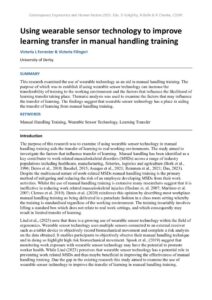
|
Author
Victoria L Forrester & Victoria Filingeri |
Abstract
This research examined the use of wearable technology as an aid in manual handling training. The purpose of which was to establish if using wearable sensor technology can increase the transferability of training to the working environment and the factors that influence the likelihood of learning transfer taking place. Thematic analysis was used to examine the factors that may influence the transfer of learning. The findings suggest that wearable sensor technology has a place in aiding the transfer of learning from manual handling training. |
Publish Date: Dec 18, 2018 | Keywords: Anthropometry, Contemporary EHF 2017, Human-machine interaction, Publications
| Document
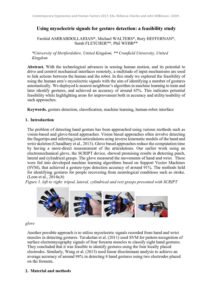
|
Author
Farshid AMIRABDOLLAHIAN, Michael WALTERS, Rory HEFFERNAN, Sarah FLETCHER, Phil WEBB |
Abstract
With the technological advances in sensing human motion, and its potential to drive and control mechanical interfaces remotely, a multitude of input mechanisms are used to link actions between the human and the robot. In this study we explored the feasibility of using the human arm’s myoelectric signals with the aim of identifying a number of gestures automatically. We deployed k-nearest neighbour’s algorithm in machine learning to train and later identify gestures, and achieved an accuracy of around 65%. This indicates potential feasibility while highlighting areas for improvement both in accuracy and utility/usability of such approaches. |
Publish Date: Apr 9, 2020 | Keywords: Contemporary EHF 2020, Publications
| Document
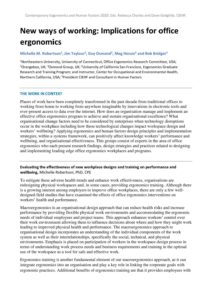
|
Author
Michelle M. Robertson, Jim Taylour, Guy Osmond, Meg Honan and Bob Bridger |
Abstract
Places of work have been completely transformed in the past decade from traditional offices to working from home to working from anywhere imaginable by innovations in electronic tools and ever-present access to data over the internet. How does an organisation manage and implement an effective office ergonomics program to achieve and sustain organisational excellence? What organisational change factors need to be considered by enterprises when technology disruptions occur in the workplace including how these technological changes impact workspace design and workers’ wellbeing? Applying ergonomics and human factors design principles and implementation strategies, within a systems framework, can positively affect knowledge workers’ performance and wellbeing, and organisational effectiveness. This groups consist of experts in the area of office ergonomics who each present research findings, design strategies and practices related to designing and implementing leading edge office ergonomics workplaces and programs. |
Publish Date: Sep 7, 2019 | Keywords: Aviation, Contemporary EHF 2019, Human-machine interaction, Perception, Publications, Situation awareness
| Document
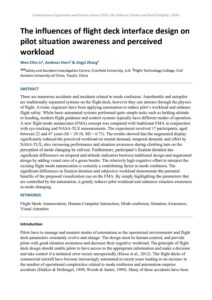
|
Author
Wen-Chin Li, Andreas Horn & Jingyi Zhang |
Abstract
There are numerous accidents and incidents related to mode confusion. Autothrottle and autopilot are traditionally separated systems on the flight deck, however they can interact through the physics of flight. Avionic engineers have been applying automation to reduce pilot’s workload and enhance flight safety. While basic automated systems performed quite simple tasks such as holding altitude or heading, modern flight guidance and control systems typically have different modes of operation. A new flight mode annunciator (FMA) concept was compared with traditional FMA in conjunction with eye-tracking and NASA-TLX measurements. The experiment involved 17 participants, aged between 22 and 47 years (M = 29.18, SD = 6.73). The results showed that the augmented display significantly reduced the perceived workload on mental demand, temporal demand, and effort by NASA-TLX; also increasing performance and situation awareness during climbing turn on the perception of mode changing by call-out. Furthermore, participant’s fixation duration has significant differences on airspeed and altitude indicators between traditional design and augmented design by adding visual cues of a green border. The relatively high cognitive effort to interpret the existing flight mode annunciation is certainly a contributing factor in mode confusion. The significant differences in fixation duration and subjective workload demonstrate the potential benefits of the proposed visualization cue on the FMA. By simply highlighting the parameters that are controlled by the automation, it greatly reduces pilot workload and enhances situation awareness in mode changing. |
Publish Date: Oct 23, 2018 | Keywords: Accimaps, Contemporary EHF 2018, Publications, Road safety, Systems
| Document
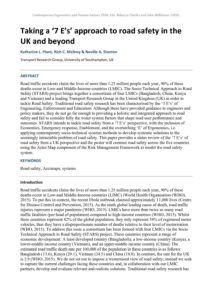
|
Author
Katherine L. Plant, Rich C. McIlroy & Neville A. Stanton |
Abstract
Road traffic accidents claim the lives of more than 1.25 million people each year, 90% of these deaths occur in Low-and Middle-Income countries (LMIC). The Socio Technical Approach to Road Safety (STARS) project brings together a consortium of four LMICs (Bangladesh, China, Kenya and Vietnam) and a leading Transport Research Group in the United Kingdom (UK) in order to tackle Road Safety. Traditional road safety research has been characterised by the ‘3 E’s’ of Engineering, Enforcement and Education. Although these have provided guidance to engineers and policy makers, they do not go far enough to providing a holistic and integrated approach to road safety and fail to consider fully the wider system factors that shape road user performance and outcomes. STARS intends to tackle road safety from a ‘7 E’s’ perspective, with the inclusion of Economics, Emergency response, Enablement, and the overarching ‘E’ of Ergonomics, i.e. applying contemporary socio-technical systems methods to develop systemic solutions to the seemingly intractable problem of road safety. This paper provides a status review of the ‘7 E’s’ of road safety from a UK perspective and the poster will contrast road safety across the five countries using the Actor Map component of the Risk Management Framework to model the road safety system. |
Publish Date: Jun 8, 2023 | Keywords: Contemporary EHF 2023, Investigation, Patient Safety, Publications, SEIPS, Systems
| Document
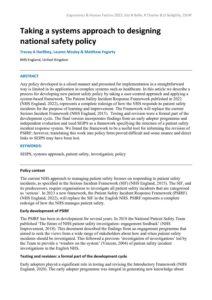
|
Author
Tracey A Herlihey, Lauren Mosley & Matthew Fogarty |
Abstract
Any policy developed in a siloed manner and presented for implementation in a straightforward way is limited in its application in complex systems such as healthcare. In this article we describe a process for developing new patient safety policy by taking a user-centred approach and applying a system-based framework. The Patient Safety Incident Response Framework published in 2022 (NHS England, 2022), represents a complete redesign of how the NHS responds to patient safety incidents for the purpose of learning and improvement. The Framework will replace the current Serious Incident Framework (NHS England, 2015). Testing and revision were a formal part of the development cycle. The final version incorporates findings from an early adopter programme and independent evaluation and used SEIPS as a framework specifying the structure of a patient safety incident response system. We found the framework to be a useful tool for informing the revision of PSIRF; however, translating this work into policy form proved difficult and some nuance and direct links to SEIPS may have been lost. |
Publish Date: Oct 23, 2018 | Keywords: Cognition, Contemporary EHF 2018, Design, Interface design, Publications
| Document
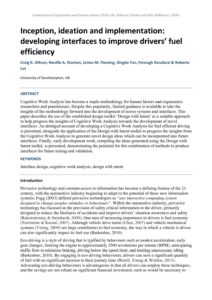
|
Author
Craig K. Allison, Neville A. Stanton, James M. Fleming, Xingda Yan, Forough Goudarzi & Roberto Lot |
Abstract
Cognitive Work Analysis has become a staple methodology for human factors and ergonomics researchers and practitioners. Despite this popularity, limited guidance is available to take the insights of the methodology forward into the development of newer systems and interfaces. This paper describes the use of the established design toolkit ‘Design with Intent’ as a suitable approach to help progress the insights of Cognitive Work Analysis towards the development of novel interfaces. An abridged account of developing a Cognitive Work Analysis for fuel efficient driving is presented, alongside the application of the Design with Intent toolkit to progress the insights from the Cognitive Work Analysis to generate novel design ideas which can be incorporated into future interfaces. Finally, early development work, compiling the ideas generated using the Design with Intent toolkit, is presented, demonstrating the potential for this combination of methods to produce interfaces for future testing and validation. |
Publish Date: Apr 16, 2020 | Keywords: Contemporary EHF 2020, Publications, Road safety, Simulation, Sociotechnical systems
| Document
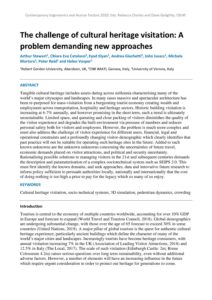
|
Author
Arthur Stewart, Chiara Eva Catalano, Eyad Elyan, Andrea Giachetti, John Isaacs, Michela Mortara, Peter Reid and Helen Vosper |
Abstract
Tangible cultural heritage includes assets dating across millennia characterising many of the world’s major cityscapes and landscapes. In many cases massive and spectacular architecture has been re-purposed for mass-visitation from a burgeoning tourist economy creating wealth and employment across transportation, hospitality and heritage sectors. Historic building visitation is increasing at 6-7% annually, and however promising in the short term, such a trend is ultimately unsustainable. Limited space, and queueing and close packing of visitors diminishes the quality of the visitor experience and degrades the built environment via pressure of numbers and reduces personal safety both for visitors and employees. However, the problem is much more complex and must also address the challenge of visitor experience for different users, financial, legal and operational constraints and a profoundly changing visitor-demographic which clearly identifies that past practice will not be suitable for operating such heritage sites in the future. Added to such known unknowns are the unknown unknowns concerning the uncertainties of future travel, economic demands placed on visitor attractions, and political and security uncertainty. Rationalising possible solutions to managing visitors in the 21st and subsequent centuries demands the description and parameterisation of a complex-sociotechnical system such as SEIPS 2.0. This must first identify the known domains, and seek approaches, data and innovative future research to inform policy sufficient to persuade authorities locally, nationally and internationally that the cost of doing nothing is too high a price to pay for the legacy which so many of us enjoy. |
Publish Date: Dec 17, 2018 | Keywords: Cognition, Contemporary EHF 2017, Cybersecurity, Decision making, Defence, Publications, Situation awareness
| Document
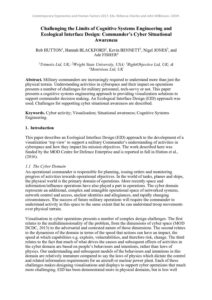
|
Author
Rob HUTTON, Hannah BLACKFORD, Kevin BENNETT, Nigel JONES, and Ade FISHER |
Abstract
Military commanders are increasingly required to understand more than just the physical terrain. Understanding activities in cyberspace and their impact on operations presents a number of challenges for military personnel, tech-savvy or not. This paper presents a cognitive systems engineering approach to providing visualization solutions to support commander decision making. An Ecological Interface Design (EID) approach was used. Challenges for supporting cyber situational awareness are described. |
Publish Date: Jun 11, 2025 | Keywords: Contemporary EHF 2025, Manufacturing, Musculoskeletal, Publications, Technology
| Document
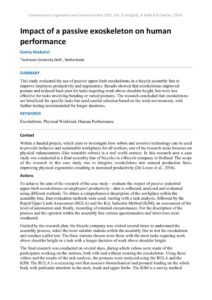
|
Author
Gonny Hoekstra |
Abstract
This study evaluated the use of passive upper-limb exoskeletons in a bicycle assembly line to improve employee productivity and ergonomics. Results showed that exoskeletons improved posture and reduced back pain for tasks requiring work above shoulder height, but were less effective for tasks involving bending or varied postures. The research concluded that exoskeletons are beneficial for specific tasks but need careful selection based on the work environment, with further testing recommended for longer durations. |
Publish Date: Jun 22, 2022 | Keywords: Behaviour, Climate change, Contemporary EHF 2022, Equality, diversity & inclusion (EDI), Publications
| Document
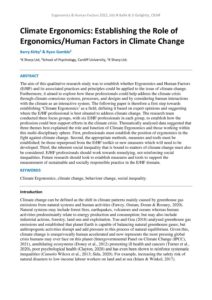
|
Author
Barry Kirby & Ryan Gamble |
Abstract
The aim of this qualitative research study was to establish whether Ergonomics and Human Factors (E/HF) and its associated practices and principles could be applied to the issue of climate change. Furthermore, it aimed to explore how these professionals could help address the climate crisis through climate-conscious systems, processes, and designs and by considering human interactions with the climate as an interactive system. The following paper is therefore a first step towards establishing ‘Climate Ergonomics’ as a field, defining it based on expert opinions and suggesting where the E/HF professional is best situated to address climate change. The research team conducted three focus groups, with six E/HF professionals in each group, to establish how the profession could best support efforts in the climate crisis. Thematically analysed data suggested that three themes best explained the role and function of Climate Ergonomics and those working within this multi-disciplinary sphere. First, professionals must establish the position of ergonomics in the fight against climate change. Second, the appropriate methods, measures and tools must be established; be those repurposed from the E/HF toolkit or new measures which will need to be developed. Third, the inherent social inequality that is bound to matters of climate change must also be considered. E/HF professionals should work towards remedying, not reinforcing social inequalities. Future research should look to establish measures and tools to support the measurement of sustainable and socially responsible practice in the E/HF domain. |
Publish Date: Jun 24, 2022 | Keywords: Contemporary EHF 2022, Incidents, Investigation, Publications, Tools & techniques, Usability
| Document
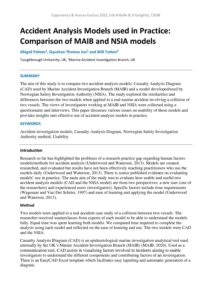
|
Author
Abigail Palmer, Gyuchan Thomas Jun & Will Tutton |
Abstract
The aim of this study is to compare two accident analysis models: Casualty Analysis Diagram (CAD) used by Marine Accident Investigation Branch (MAIB) and a model developed/used by Norwegian Safety Investigation Authority (NSIA). The study explored the similarities and differences between the two models when applied to a real marine accident involving a collision of two vessels. The views of investigators working at MAIB and NSIA were collected using a questionnaire and interviews. This paper discusses various issues on usability of these models and provides insights into effective use of accident analysis models in practice. |
Publish Date: Feb 27, 2019 | Keywords: Contemporary EHF 2016, Fatigue & sleep, Publications, Technology
| Document
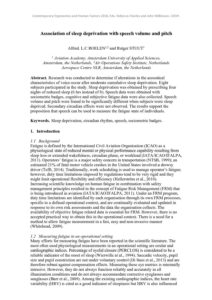
|
Author
Alfred. L.C ROELEN and Rutger STUUT |
Abstract
Research was conducted to determine if alterations in the acoustical characteristics of voice occur after moderate cumulative sleep deprivation. Eight subjects participated in the study. Sleep deprivation was obtained by prescribing four nights of reduced sleep (6 hrs instead of 8). Speech data were obtained with sociometric badges, cognitive and subjective fatigue data were also collected. Speech volume and pitch were found to be significantly different when subjects were sleep deprived. Secondary circadian effects were not observed. The results support the proposition that speech can be used to measure the fatigue state of individuals. |
Publish Date: Jun 8, 2023 | Keywords: Contemporary EHF 2023, Design, Mental health & wellbeing, Publications
| Document
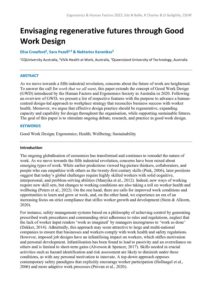
|
Author
Elise Crawford, Sara Pazell & Nektarios Karanikas |
Abstract
As we move towards a fifth industrial revolution, concerns about the future of work are heightened. To answer the call for work that we all want, this paper extends the concept of Good Work Design (GWD) introduced by the Human Factors and Ergonomics Society in Australia in 2020. Following an overview of GWD, we present a list of respective features with the purpose to advance a humancentred design-led approach to workplace strategy that reconciles business success with worker health. Moreover, we argue that effective design practice should be regenerative, expanding capacity and capability for design throughout the organisation, while supporting sustainable futures. The goal of this paper is to stimulate ongoing debate, research, and practice in good work design. |
Publish Date: May 30, 2024 | Keywords: Contemporary EHF 2024, Human factors integration, Nuclear, Publications, Safety
| Document
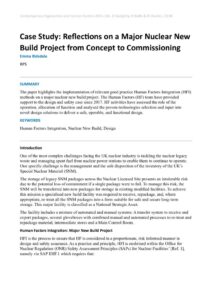
|
Author
Emma Ridsdale |
Abstract
The paper highlights the implementation of relevant good practice Human Factors Integration (HFI) methods on a major nuclear new build project. The Human Factors (HF) team have provided support to the design and safety case since 2017. HF activities have assessed the role of the operation, allocation of function and analysed the proven technologies selection and input into novel design solutions to deliver a safe, operable, and functional design. |
Publish Date: Jun 8, 2023 | Keywords: Contemporary EHF 2023, Publications, Systems, Task analysis, Workload
| Document
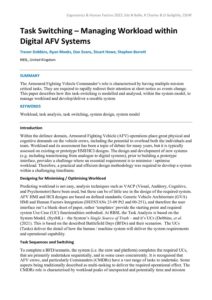
|
Author
Trevor Dobbins, Ryan Meeks, Dan Evans, Stuart Howe & Stephen Barrett |
Abstract
The Armoured Fighting Vehicle Commander’s role is characterised by having multiple mission critical tasks. They are required to rapidly redirect their attention at short notice as events change. This paper describes how this task-switching is modelled and analysed, within the system model, to manage workload and develop/deliver a useable system |
Publish Date: Mar 24, 2019 | Keywords: Contemporary EHF 2016, Healthcare, Incidents, Publications, SEIPS, Simulation
| Document
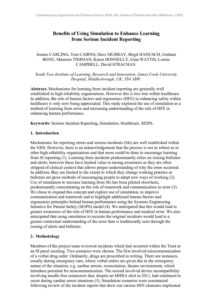
|
Author
Joanne CARLING, Tom CAIRNS, Dave MURRAY, Birgit HANUSCH, Graham BONE, Maureen TIERNAN, Karen DONNELLY, Gina WATTIS, Louise CAMPBELL, David STRACHAN |
Abstract
Mechanisms for learning from incident reporting are generally well established in high reliability organisations. However this is less true within healthcare. In addition, the role of human factors and ergonomics (HFE) in enhancing safety within healthcare is only now being appreciated. This study explored the use of simulation as a method of learning from error and increasing understanding of the role of HFE in enhancing human performance. |
Publish Date: Feb 27, 2019 | Keywords: Aviation, Contemporary EHF 2016, Manufacturing, Publications, Task analysis, Virtual reality
| Document
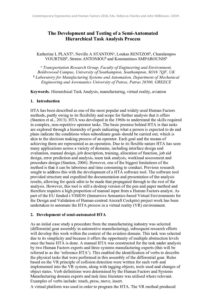
|
Author
Katherine L PLANT, Neville A STANTON, Loukas RENTZOS, Charalampos VOURTSIS, Stratos ANTONIOU and Konstantinos SMPAROUNIS |
Abstract
|
Publish Date: May 27, 2025 | Keywords: Artificial intelligence, Automotive, Contemporary EHF 2025, Publications, User experience
| Document
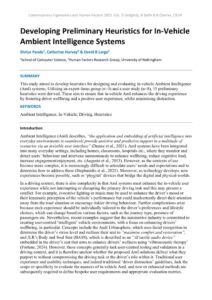
|
Author
Shriya Pande, Catherine Harvey & David R. Large |
Abstract
This study aimed to develop heuristics for designing and evaluating in-vehicle Ambient Intelligence (AmI) systems. Utilising an expert focus group (n=3) and a user study (n=8), 15 preliminary heuristics were derived. These aim to ensure that in-vehicle AmI enhances the driving experience by fostering driver wellbeing and a positive user experience, whilst minimising distraction. |
Publish Date: Dec 17, 2018 | Keywords: Contemporary EHF 2017, Mental health & wellbeing, Psychology, Publications
| Document
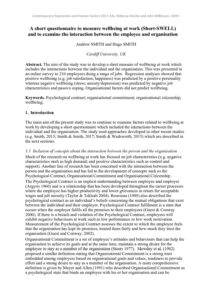
|
Author
Andrew SMITH and Hugo SMITH |
Abstract
The aim of the study was to develop a short measure of wellbeing at work which includes the interactions between the individual and the organisation. This was presented in an online survey to 210 employees doing a range of jobs. Regression analyses showed that positive wellbeing (e.g. job satisfaction; happiness) was predicted by a positive personality whereas negative wellbeing (stress; anxiety/depression) was predicted by negative job characteristics and passive coping. Organisational factors did not predict wellbeing. |
Publish Date: Mar 25, 2019 | Keywords: Communication, Contemporary EHF 2016, Publications, Rail, Systems
| Document
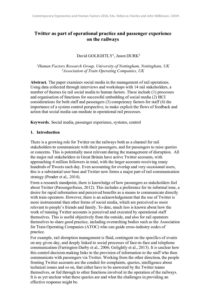
|
Author
David GOLIGHTLY, Jason DURK |
Abstract
The paper examines social media in the management of rail operations. Using data collected through interviews and workshops with 14 rail stakeholders, a number of themes tie rail social media to human factors. These include (1) processes and organisation of functions for successful embedding of social media (2) HCI considerations for both staff and passengers (3) competency factors for staff (4) the importance of a system control perspective, to make explicit the flows of feedback and action that social media can mediate in operational rail processes. |
Publish Date: Dec 17, 2018 | Keywords: Contemporary EHF 2017, Education, training & skills, Healthcare, Patient Safety, Pharmaceutical, Publications
| Document
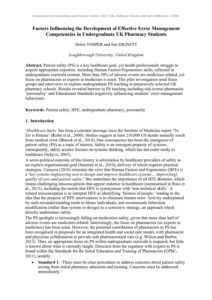
|
Author
Helen VOSPER and Sue HIGNETT |
Abstract
Patient safety (PS) is a key healthcare goal, yet health professionals struggle to acquire appropriate expertise, including Human Factors/Ergonomics skills, reflected in undergraduate curricula content. More than 50% of adverse events are medicines-related, yet focus on pharmacists as experts in medicines is scant. This pilot investigation used focus groups and interviews to explore undergraduate PS teaching in purposively-selected UK pharmacy schools. Results revealed barriers to PS teaching including risk-averse pharmacist ‘personality’ and Educational Standards negatively influencing students’ error-management behaviours. |
Publish Date: Jun 8, 2023 | Keywords: Construction, Contemporary EHF 2023, Energy, Publications, Safety culture
| Document
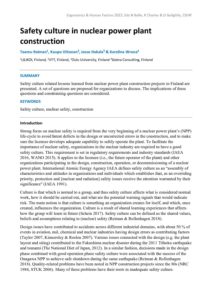
|
Author
Teemu Reiman, Kaupo Viitanen, Jesse Hakala & Karolina Wrona |
Abstract
Safety culture related lessons learned from nuclear power plant construction projects in Finland are presented. A set of questions are proposed for organizations to discuss. The implications of these questions and constraining questions are considered. |
Publish Date: Aug 12, 2021 | Keywords: Automotive, Comfort Congress 2021, Perception, Publications
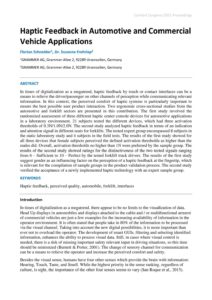 |
Author
Florian Schneider, Dr. Susanne Frohriep |
Abstract
In times of digitalization as a megatrend, haptic feedback by touch or contact interfaces can be a means to relieve the driver/passenger on other channels of perception while communicating relevant information. In this context, the perceived comfort of haptic systems is particularly important to ensure the best possible user product interaction. Two ergonomic cross-sectional studies from the automotive and forklift sectors are presented in this contribution. The first study involved the randomized assessment of three different haptic center console devices for automotive applications in a laboratory environment. 21 subjects tested the different devices, which had three activation thresholds of 0.3N/1.0N/2.0N. The second study analyzed haptic feedback in terms of an indication and attention signal in different seats for forklifts. The tested expert group encompassed 8 subjects in the static laboratory study and 4 subjects in the field tests. The results of the first study showed for all three devices that female subjects perceived the defined activation thresholds as higher than the males did. Overall, activation thresholds no higher than 1N were preferred by the sample group. The results of the second study showed ratings for the distinctiveness of the two tested signals ranging from 6 – Sufficient to 10 – Perfect by the tested forklift truck drivers. The results of the first study suggest gender as an influencing factor on the perception of a haptic feedback at the fingertip, which is relevant for the compilation of sample groups in the product validation process. The second study verified the acceptance of a newly implemented haptic technology with an expert sample group. |
Publish Date: Mar 25, 2019 | Keywords: Contemporary EHF 2016, Publications, Simulation
| Document
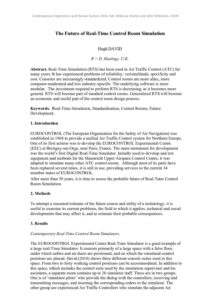
|
Author
Hugh DAVID |
Abstract
Real-Time Simulation (RTS) has been used in Air Traffic Control (ATC) for many years. It has experienced problems of reliability, verisimilitude, specificity and cost. Consoles are increasingly standardized. Control rooms are more alike, more computer-moderated and less industry-specific. The underlying software is more modular. The investment required to perform RTS is decreasing, as it becomes more general. RTS will become part of standard control rooms. Generalized RTS will become an economic and useful part of the control room design process. |
Publish Date: May 31, 2024 | Keywords: Contemporary EHF 2024, Interface design, Publications, Systems
| Document
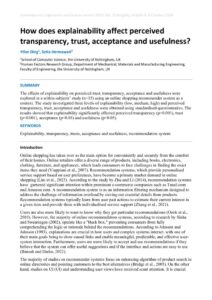
|
Author
Yifan Ding, Setia Hermawati |
Abstract
The effects of explainability on perceived trust, transparency, acceptance and usefulness were explored in a within subjects’ study (n=15) using an online shopping recommender system as a context. The study investigated three levels of explainability (low, medium, high) and perceived transparency, trust, acceptance and usefulness were obtained using standardised questionnaires. |
Publish Date: Jun 24, 2022 | Keywords: Contemporary EHF 2022, Interface design, Publications, Technology, Usability, User experience
| Document
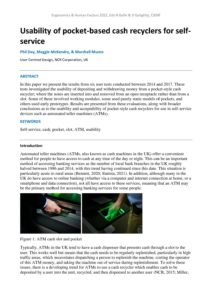
|
Author
Phil Day, Maggie McKendry & Marshall Munro |
Abstract
In this paper we present the results from six user tests conducted between 2014 and 2017. These tests investigated the usability of depositing and withdrawing money from a pocket-style cash recycler; where the notes are inserted into and removed from an open receptacle rather than from a slot. Some of these involved working modules, some used purely static models of pockets, and others used early prototypes. Results are presented from these evaluations, along with broader conclusions as to the usability and acceptability of pocket-style cash recyclers for use in self-service devices such as automated teller machines (ATMs). |
Publish Date: Mar 25, 2019 | Keywords: Contemporary EHF 2016, Musculoskeletal, Publications, User experience
| Document
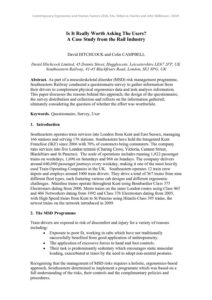
|
Author
David HITCHCOCK and Colin CAMPBELL |
Abstract
As part of a musculoskeletal disorder (MSD) risk management programme, Southeastern Railway conducted a questionnaire survey to gather information from their drivers to complement physical ergonomics data and task analysis information. This paper discusses the reasons behind this approach, the design of the questionnaire, the survey distribution and collection and reflects on the information gathered; ultimately considering the question of whether the effort was worthwhile. |
Publish Date: May 23, 2025 | Keywords: Artificial intelligence, Aviation, Contemporary EHF 2025, Incidents, Publications
| Document
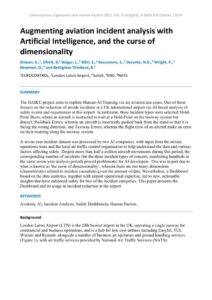
|
Author
Kirwan, B., Elliott, R. Bolger, L., Biliri, E., Koussouris, S., Durante, N.G., Wright, P., Newman, D., and Bettignies-Thiebaux, B. |
Abstract
The HAIKU project aims to explore Human-AI Teaming via six aviation use cases. One of these focuses on the reduction of airside incidents at a UK international airport via AI-based analysis of safety events and occurrences at this airport. In particular, three incident types were selected: Hold-Point Busts, where an aircraft is instructed to wait at a Hold-Point on the taxiway system but doesn't; Pushback Errors, wherein an aircraft is incorrectly pushed back from the stand so that it is facing the wrong direction; and Taxiway Errors, wherein the flight crew of an aircraft make an error on their routeing along the taxiway system. A seven-year incident dataset was processed by two AI companies, with input from the airside operations team and the local air traffic control organisation to help understand the data and various factors affecting safety. Despite more than half a million aircraft movements during this period, the corresponding number of incidents (for the three incident types of concern, numbering hundreds in the same seven-year analysis period) proved problematic for AI developers. This was in part due to what is known as 'the curse of dimensionality’, wherein there are too many dimensions (characteristics related to incident causation) given the amount of data. Nevertheless, a Dashboard based on the data analytics, together with airport operational expertise, led to new, actionable insights that have enhanced safety for two of the incident categories. This paper presents the Dashboard and its usage in incident reduction at the airport. |
Publish Date: Mar 24, 2019 | Keywords: Aviation, Contemporary EHF 2016, Publications, Systems
| Document
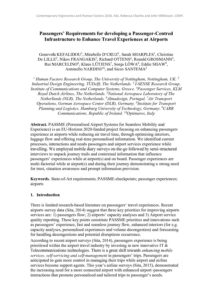
|
Author
Genovefa KEFALIDOU1, Mirabelle D’CRUZ1, Sarah SHARPLES, Christine De LILLE, Nikos FRANGAKIS, Richard OTTENS, Ronald GROSMANN, Rui MARCELINO, Klaus LÜTJENS, Sonja LÖWA, Eddie SHAW, Antonello NARDINI, and Sicco SANTEMA |
Abstract
PASSME (Personalised Airport Systems for Seamless Mobility and Experience) is an EU-Horizon 2020-funded project focusing on enhancing passengers experience at airports while reducing air travel time, through optimising interiors, luggage flow and offering real-time personalised information. We identified current processes, interactions and needs passengers and airport services experience while travelling. We employed mobile diary surveys on-the-go followed by semi-structured interviews to unpack journey trails and contextual information that influence passengers’ experiences while at airport(s) and on board. Passenger experiences are multi-factorial while at airport(s) and during their journey demonstrating a strong need for trust, situation awareness and prompt information provision. |
Publish Date: Jun 8, 2023 | Keywords: Artificial intelligence, Autonomous systems, Contemporary EHF 2023, Publications, Safety, Usability
| Document
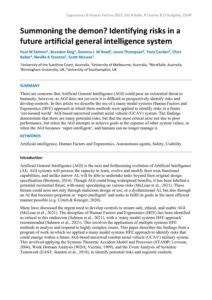
|
Author
Paul M Salmon, Brandon King, Gemma J. M Read, Jason Thompson, Tony Carden, Chris Baber, Neville A Stanton & Scott McLean |
Abstract
There are concerns that Artificial General Intelligence (AGI) could pose an existential threat to humanity; however, as AGI does not yet exist it is difficult to prospectively identify risks and develop controls. In this article we describe the use of a many model systems Human Factors and Ergonomics (HFE) approach in which three methods were applied to identify risks in a future ‘envisioned world’ AGI-based uncrewed combat aerial vehicle (UCAV) system. The findings demonstrate that there are many potential risks, but that the most critical arise not due to poor performance, but when the AGI attempts to achieve goals at the expense of other system values, or when the AGI becomes ‘super-intelligent’, and humans can no longer manage it. |
Publish Date: Jun 12, 2023 | Keywords: Artificial intelligence, Autonomous systems, Contemporary EHF 2023, Publications
| Document
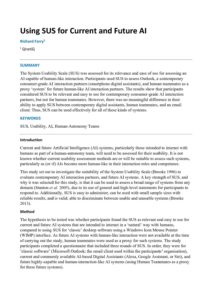
|
Author
Richard Farry |
Abstract
The System Usability Scale (SUS) was assessed for its relevance and ease of use for assessing an AI capable of human-like interaction. Participants used SUS to assess Outlook, a contemporary consumer-grade AI interaction partners (smartphone digital assistants), and human teammates as a proxy ‘system’ for future human-like AI interaction partners. The results show that participants considered SUS to be relevant and easy to use for contemporary consumer-grade AI interaction partners, but not for human teammates. However, there was no meaningful difference in their ability to apply SUS between contemporary digital assistants, human teammates, and an email client. Thus, SUS can be used effectively for all of these kinds of systems. |
Publish Date: Apr 8, 2021 | Keywords: Contemporary EHF 2021, Education, training & skills, Healthcare, Pandemic, Publications
| Document
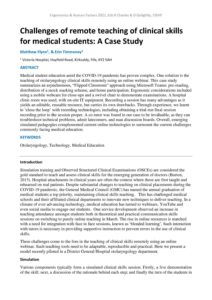
|
Author
Matthew Flynn & Erin Timmoney |
Abstract
Medical student education amid the COVID-19 pandemic has proven complex. One solution is the teaching of otolaryngology clinical skills remotely using an online webinar. This case study summarizes an asynchronous, “Flipped Classroom” approach using Microsoft Teams: pre-reading, distribution of a mock marking scheme, and home participation. Ergonomic considerations included using a mobile webcam for close-ups and a swivel chair to demonstrate examinations. A hospital clinic room was used, with on-site IT equipment. Recording a session has many advantages as it yields an editable, reusable resource, but carries its own drawbacks. Through experience, we learnt to ‘close the loop’ with recording technologies, including obtaining a trial-run final session recording prior to the session proper. A co-tutor was found in our case to be invaluable, as they can troubleshoot technical problems, admit latecomers, and man discussion boards. Overall, emerging simulated pedagogies complemented current online technologies to surmount the current challenges commonly facing medical education. |
Publish Date: Jun 12, 2023 | Keywords: Anthropometry, Comfort, Contemporary EHF 2023, Education, training & skills, Publications, Safety, Seating
| Document
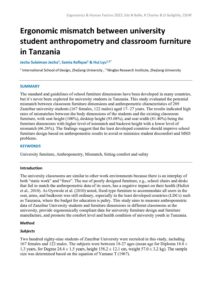
|
Author
Jecha Suleiman Jecha, Samia Rafique & Hui Lyu |
Abstract
The standard and guidelines of school furniture dimensions have been developed in many countries, but it’s never been explored for university students in Tanzania. This study evaluated the potential mismatch between classroom furniture dimensions and anthropometric characteristics of 289 Zanzibar university students (167 females, 122 males) aged 17- 27 years. The results indicated high rates of mismatches between the body dimensions of the students and the existing classroom furniture, with seat height (100%), desktop height (93.08%), and seat width (81.40%) being the furniture dimensions with higher level of mismatch and backrest height with a lower level of mismatch (66.26%). The findings suggest that the least developed countries should improve school furniture design based on anthropometric results to avoid or minimize student discomfort and MSD problems. |
Publish Date: Apr 9, 2021 | Keywords: Automotive, Contemporary EHF 2021, Perception, Publications, Workload
| Document
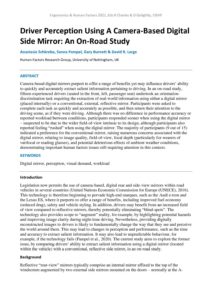
|
Author
Anastasia Schkreba, Sanna Pampel, Gary Burnett & David R. Large |
Abstract
Camera-based digital mirrors purport to offer a range of benefits yet may influence drivers’ ability to quickly and accurately extract salient information pertaining to driving. In an on-road study, fifteen experienced drivers (seated in the front, left, passenger seat) undertook an orientation-discrimination task requiring the extraction of real-world information using either a digital mirror (placed internally) or a conventional, external, reflective mirror. Participants were asked to complete each task as quickly and accurately as possible, and then return their attention to the driving scene, as if they were driving. Although there was no difference in performance accuracy or reported workload between conditions, participants responded sooner when using the digital mirror – suspected to be due to the wider field-of-view intrinsic to its design, although participants also reported feeling “rushed” when using the digital mirror. The majority of participants (9 out of 15) indicated a preference for the conventional mirror, raising numerous concerns associated with the digital mirror, relating to image quality, field-of-view, focal depth (particularly for wearers of varifocal or reading glasses), and potential deleterious effects of ambient weather conditions, demonstrating important human factors issues still requiring attention in this context. |
Publish Date: Apr 16, 2020 | Keywords: Anthropometry, Complex systems, Contemporary EHF 2020, Psychology, Publications, Resilience
| Document
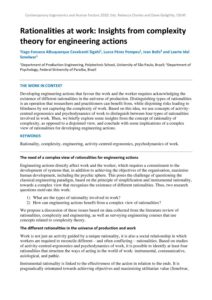
|
Author
Tiago Fonseca Albuquerque Cavalcanti Sigahi, Lucca Pérez Pompeu, Ivan Bolis and Laerte Idal Sznelwar |
Abstract
Developing engineering actions that favour the work and the worker requires acknowledging the existence of different rationalities in the universe of production. Distinguishing types of rationalities is an operation that researchers and practitioners can benefit from, while disjoining risks leading to blindness by not capturing the complexity of work. Based on this idea, we use concepts of activity-centred ergonomics and psychodynamics of work to distinguish between four types of rationalities involved in work. Then, we briefly explore some insights from the concept of rationality of complexity, as opposed to a disjointed view, and conclude with some implications of a complex view of rationalities for developing engineering actions. |
Publish Date: Aug 16, 2021 | Keywords: Comfort, Comfort Congress 2021, Pandemic, Publications
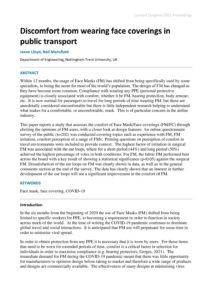 |
Author
Jaxon Lloyd, Neil Mansfield |
Abstract
Within 12 months, the usage of Face Masks (FM) has shifted from being specifically used by some specialists, to being the norm for most of the world’s population. The design of FM has changed as they have become more common. Compliance with wearing any PPE (personal protective equipment) is closely associated with comfort, whether it be FM, hearing protection, body armour, etc. It is now normal for passengers to travel for long periods of time wearing FM, but these are anecdotally considered uncomfortable but there is little independent research helping to understand what makes for a comfortable, or uncomfortable, mask. This is of particular concern in the airline industry. This paper reports a study that assesses the comfort of Face Mask/Face coverings (FM/FC) through eliciting the opinions of FM users, with a closer look at design features. An online questionnaire survey of the public (n=202) was conducted covering topics such as experience with FM, FM irritation, comfort perception of a range of FMs. Priming questions on perception of comfort in travel environments were included to provide context.. The highest factor of irritation in surgical FM was associated with the ear loops, where for a short period (44%) and long period (50%) achieved the highest percentage of votes in both conditions. For FM, the fabric FM performed best across the board with a key result of showing a statistical significance (p |
Publish Date: Jun 4, 2024 | Keywords: Contemporary EHF 2024, Human performance, Publications, Rail, Safety, Tools & techniques, Transport
| Document
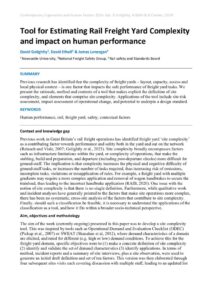
|
Author
David Golightly , David Ethell & James Lonergan |
Abstract
Previous research has identified that the complexity of freight yards – layout, capacity, access and local physical context – is one factor that impacts the safe performance of freight yard tasks. We present the rationale, method and contents of a tool that makes explicit the definition of site complexity, and elements that comprise site complexity. Applications of the tool include site risk assessment, impact assessment of operational change, and potential to underpin a design standard. |
Publish Date: Jun 8, 2023 | Keywords: Contemporary EHF 2023, Pandemic, Publications
| Document
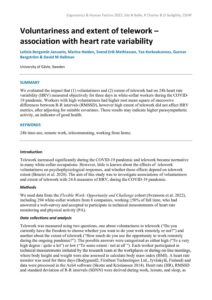
|
Author
Leticia Bergamin Januario, Marina Heiden, Svend Erik Mathiassen, Tea Korkeakunnas, Gunnar Bergström & David M Hallman |
Abstract
We evaluated the impact that (1) voluntariness and (2) extent of telework had on 24h heart rate variability (HRV) measured objectively for three days in white-collar workers during the COVID- 19 pandemic. Workers with high voluntariness had higher root mean square of successive differences between R-R intervals (RMSSD), however high extent of telework did not affect HRV metrics, after adjusting for suitable covariates. These results may indicate higher parasympathetic activity, an indicator of good health. |
Publish Date: Aug 10, 2021 | Keywords: Comfort, Comfort Congress 2021, Publications, Seating
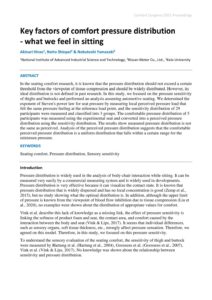 |
Author
Akinari Hirao, Naito Shinpei & Nobutoshi Yamazaki |
Abstract
In the seating comfort research, it is known that the pressure distribution should not exceed a certain threshold from the viewpoint of tissue compression and should be widely distributed. However, its ideal distribution is not defined in past research. In this study, we focused on the pressure sensitivity of thighs and buttocks and performed an analysis assuming automotive seating. We determined the exponent of Steven's power law for seat pressure by measuring local perceived pressure load that felt the same pressure feeling at the reference load point, and the sensitivity distribution of 29 participants were measured and classified into 3 groups. The comfortable pressure distribution of 5 participants was measured using the experimental seat and converted into a perceived pressure distribution using the sensitivity distribution. The results show measured pressure distribution is not the same as perceived. Analysis of the perceived pressure distribution suggests that the comfortable perceived pressure distribution is a uniform distribution that falls within a certain range for the minimum pressure. |
Publish Date: Oct 30, 2018 | Keywords: Contemporary EHF 2017, Publications, Rail
| Document
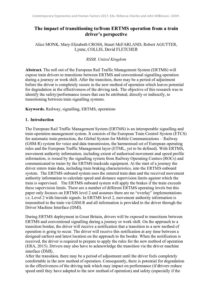
|
Author
Alice MONK, Mary-Elizabeth CROSS, Stuart McFARLAND, Robert AGUTTER, Lynne, COLLIS, David FLETCHER |
Abstract
The roll out of the European Rail Traffic Management System (ERTMS) will expose train drivers to transitions between ERTMS and conventional signalling operation during a journey or work shift. After the transition, there may be a period of adjustment before the driver is completely secure in the new method of operation which leaves potential for degradation in the effectiveness of the driving task. The objective of this research was to identify the safety/performance issues that can be attributed, directly or indirectly, to transitioning between train signalling systems. |
Publish Date: Mar 25, 2019 | Keywords: Contemporary EHF 2016, Publications, Simulation, Systems
| Document
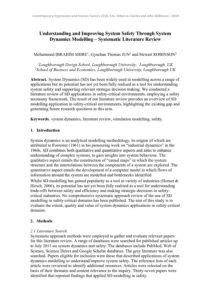
|
Author
Mohammed IBRAHIM SHIRE, Gyuchan Thomas JUN and Stewart ROBINSON |
Abstract
System Dynamics (SD) has been widely used in modelling across a range of applications but its potential has not yet been fully realised as a tool for understanding system safety and supporting relevant strategic decision making. We conducted a literature review of SD applications in safety-critical environments, employing a safety taxonomy framework. The result of our literature review provides an overview of SD modelling application in safety-critical environments, highlighting the existing gap and generating future research questions in this area. |
Publish Date: Jun 24, 2022 | Keywords: Contemporary EHF 2022, Mental health & wellbeing, Office ergonomics, Publications, Safety culture
| Document
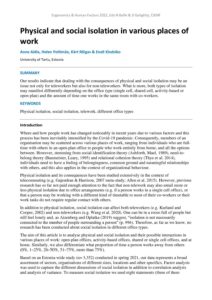
|
Author
Anne Aidla, Helen Poltimäe, Kärt Rõigas & Eneli Kindsiko |
Abstract
Our results indicate that dealing with the consequences of physical and social isolation may be an issue not only for teleworkers but also for non-teleworkers. What is more, both types of isolation may manifest differently depending on the office type (single cell, shared cell, activity-based or open-plan) and the amount of time one works in the same room with co-workers. |
Publish Date: Apr 17, 2020 | Keywords: Aviation, Contemporary EHF 2020, Investigation, Publications, Safety
| Document
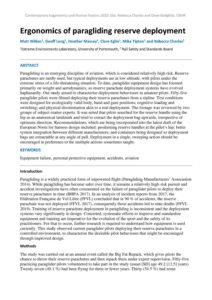
|
Author
Matt Wilkes, Geoff Long, Heather Massey, Clare Eglin, Mike Tipton and Rebecca Charles |
Abstract
Paragliding is an emerging discipline of aviation, which is considered relatively high risk. Reserve parachutes are rarely used, but typical deployments are at low altitude, with pilots under the extreme stress of a life-threatening situation. To date, paraglider equipment design has focused primarily on weight and aerodynamics, so reserve parachute deployment systems have evolved haphazardly. Our study aimed to characterise deployment behaviours in amateur pilots. Fifty-five paraglider pilots were filmed deploying their reserve parachutes from a zipline. Test conditions were designed for ecologically valid body, hand and gaze positions; cognitive loading and switching; and physical disorientation akin to a real deployment. The footage was reviewed by two groups of subject matter experts. It was noted that pilots searched for the reserve handle using the hip as an anatomical landmark and tried to extract the deployment bag upwards, irrespective of optimum direction. Recommendations, which are being incorporated into the latest draft of the European Norm for harness design included: positioning reserve handles at the pilot’s hip; better system integration between different manufacturers; and containers being designed so deployment bags are extractable at any angle of pull. Deployment in a single, sweeping action should be encouraged in preference to the multiple actions sometimes taught. |
Publish Date: Sep 8, 2019 | Keywords: Agriculture & forestry, Contemporary EHF 2019, Publications, Rail, Risk assessment, Safety
| Document
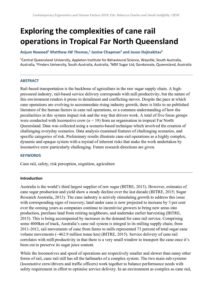
|
Author
Anjum Naweed, Matthew JW Thomas, Janine Chapman and Jason Hajinakitas |
Abstract
Rail-based transportation is the backbone of agriculture in the raw sugar supply chain. A high-pressured industry, rail-based service delivery corresponds with mill productivity, but the nature of this environment renders it prone to derailment and conflicting moves. Despite the pace at which cane operations are evolving to accommodate rising industry growth, there is little to no published literature of the human factors in cane rail operations, or a common understanding of how the peculiarities in this system impact risk and the way that drivers work. A total of five focus groups were conducted with locomotive crew (n = 19) from an organisation in tropical Far North Queensland. Data was collected using a scenario-based technique which involved the creation of challenging everyday scenarios. Data analysis examined features of challenging scenarios, and specific categories of risk. Preliminary results illustrate cane-rail operations as a highly complex, dynamic and opaque system with a myriad of inherent risks that make the work undertaken by locomotive crew particularly challenging. Future research directions are given. |
Publish Date: Apr 9, 2021 | Keywords: Contemporary EHF 2021, Publications, Rail, Tools & techniques, Transport
| Document
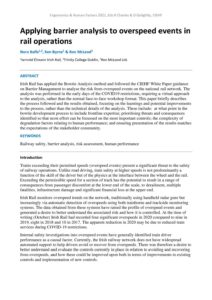
|
Author
Nora Balfe, Ken Byrne & Ron McLeod |
Abstract
Irish Rail has applied the Bowtie Analysis method and followed the CIEHF White Paper guidance on Barrier Management to analyse the risk from overspeed events on the national rail network. The analysis was performed in the early days of the COVID19 restrictions, requiring a virtual approach to the analysis, rather than the normal face-to-face workshop format. This paper briefly describes the process followed and the results obtained, focusing on the learnings and potential improvements to the process, rather than the technical details of the analysis. These include: at what point in the bowtie development process to include frontline expertise; prioritising threats and consequences identified so that most effort can be focussed on the most important controls; the complexity of degradation factors relating to human performance; and ensuring presentation of the results matches the expectations of the stakeholder community. |
Publish Date: Jun 3, 2024 | Keywords: Aviation, Contemporary EHF 2024, Human factors integration, Human performance, Publications
| Document
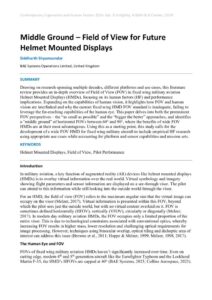
|
Author
Siddharth Shyamsundar |
Abstract
Drawing on research spanning multiple decades, different platforms and use cases, this literature review provides an in-depth overview of Field of View (FOV) in fixed wing military aviation Helmet Mounted Displays (HMDs), focusing on its human factors (HF) and performance implications. Expanding on the capabilities of human vision, it highlights how FOV and human vision are interlinked and why the current fixed wing HMD FOV standard is inadequate, failing to leverage the far-reaching capabilities of the human eye. This paper delves into both the preeminent FOV perspectives – the “as small as possible” and the “bigger the better” approaches, and identifies a “middle ground” of horizontal FOVs between 60° and 90°, where the benefits of wide FOV HMDs are at their most advantageous. Using this as a starting point, this study calls for the development of a wide FOV HMD for fixed wing military aircraft to include empirical HF research using appropriate use cases while accounting for platform and sensor capabilities and mission sets. |
Publish Date: Mar 26, 2019 | Keywords: Autonomous systems, Cognition, Contemporary EHF 2016, Decision making, Defence, Publications, Simulation
| Document
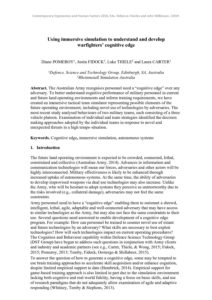
|
Author
Diane POMEROY, Justin FIDOCK, Luke THIELE and Laura CARTER |
Abstract
The Australian Army recognises personnel need a “cognitive edge” over any adversary. To better understand cognitive performance of military personnel in current and future land operating environments and inform training requirements, we have created an immersive tactical team simulator representing possible elements of the future operating environment, including novel use of technologies by adversaries. The most recent study analysed behaviours of two military teams, each consisting of a three vehicle platoon. Examination of individual and team strategies identified the decision making approaches adopted by the individual teams in response to novel and unexpected threats in a high tempo situation. |
Publish Date: Jun 8, 2023 | Keywords: Contemporary EHF 2023, Publications, Rail, User centred design
| Document
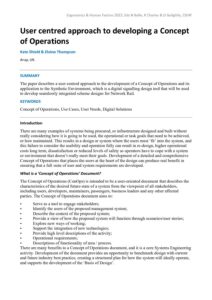
|
Author
Kate Shield & Elaine Thompson |
Abstract
The paper describes a user centred approach to the development of a Concept of Operations and its application to the Synthetic Environment, which is a digital signalling design tool that will be used to develop seamlessly integrated scheme designs for Network Rail. |
Publish Date: Jun 12, 2023 | Keywords: Contemporary EHF 2023, Investigation, Perception, Publications, Safety
| Document
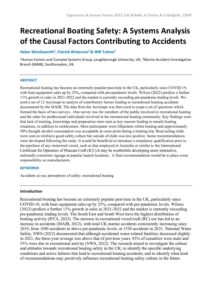
|
Author
Helen Wordsworth, Patrick Waterson & Will Tutton |
Abstract
Recreational boating has become an extremely popular past-time in the UK, particularly since COVID-19, with boat equipment sales up by 25%, compared with pre-pandemic levels. Wilson (2022) predicts a further 11% growth in sales in 2021-2022 and the market is currently exceeding pre-pandemic trading levels. We used a set of 12 Accimaps to analyse of contributory factors leading to recreational boating accidents documented by the MAIB. The data from the Accimaps was then used to scope a set of questions which formed the basis of two surveys. One survey was for members of the public involved in recreational boating and the other for professional individuals involved in the recreational boating community. Key findings were that lack of training, knowledge and preparation were seen as key reasons leading to unsafe boating situations, in addition to recklessness. Most participants wore lifejackets whilst boating and approximately 50% thought alcohol consumption was acceptable at some point during a boating trip. Boat/sailing clubs were seen to reinforce good safety culture but outside of clubs was less positive. Some recommendations were developed following the study. It would be beneficial to introduce a mandatory qualification prior to the purchase of any motorised vessel, such as that employed in Australia or similar to the International Certificate for Operators of Pleasure Craft (ICC).It may be worthwhile developing more interactive, nationally consistent signage at popular launch locations. A final recommendation would be to place some responsibility on manufacturers. |
Publish Date: Apr 9, 2020 | Keywords: Communication, Contemporary EHF 2020, Healthcare, Publications
| Document
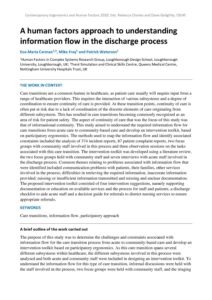
|
Author
Eva-Maria Carman, Mike Fray and Patrick Waterson |
Abstract
Care transitions are a common feature in healthcare, as patient care usually will require input from a range of healthcare providers. This requires the interaction of various subsystems and a degree of coordination to ensure continuity of care is provided. At these transition points, continuity of care is often put at risk due to a lack of coordination of the discrete elements of care originating from different subsystems. This has resulted in care transitions becoming commonly recognised as an area of risk for patient safety. The aspect of continuity of care that was the focus of this study was that of informational continuity. This study aimed to understand the required information flow for care transitions from acute care to community-based care and develop an intervention toolkit, based on participatory ergonomics. The methods used to map the information flow and identify associated constraints included the analysis of 374 incident reports, 87 patient complaint reports, two focus groups with community staff involved in this process and three observation sessions on the tasks associated with this care transition. The intervention toolkit was developed using a literature review, the two focus groups held with community staff and seven interviews with acute staff involved in the discharge process. Common themes relating to problems associated with information flow that were identified included communication problems with patients, their families, other services involved in the process; difficulties in retrieving the required information, inaccurate information provided; missing or insufficient information transmitted and missing and unclear documentation. The proposed intervention toolkit consisted of four intervention suggestions, namely supporting documentation or education on available services and the process for staff and patients, a discharge checklist to aide acute staff and a decision guide for referrals to district nursing services to ensure appropriate referrals. |
Publish Date: Apr 9, 2020 | Keywords: Climate change, Contemporary EHF 2020, Publications, Sociotechnical systems, Systems
| Document
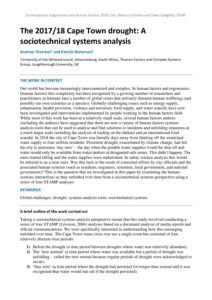
|
Author
Andrew Thatcher and Patrick Waterson |
Abstract
Our world has become increasingly interconnected and complex. In human factors and ergonomics (human factors) this complexity has been recognised by a growing number of researchers and practitioners as humans face a number of global crises that seriously threaten human wellbeing (and possibly our own existence as a species). Globally-challenging issues such as energy supply, urbanisation, health provision, violence and terrorism, food supply, and water scarcity have now been investigated and interventions implemented by people working in the human factors field. While most of this work has been at a relatively small scale, several human factors authors (including the authors) have suggested that there are now a variety of human factors systems analysis tools that can be used to analyse and find solutions to incidents and unfolding situations at a much larger scale including the analysis of trading on the darknet and an international food scandal. In 2018 the city of Cape Town was literally days away from shutting off the municipal water supply to four million residents. Persistent drought, exacerbated by climate change, had led the city to announce ‘day zero’ – the day when the potable water supplies would be shut off and water would only be available from water tankers at designated safe zones. This didn’t happen. The rains started falling and the water supplies were replenished. In safety science analysis this would be referred to as a near miss. Was this luck or the result of concerted efforts by city officials and the associated human systems (such as residents, engineers, scientists, local government, and national government)? This is the question that we investigated in this paper by examining the human-systems interactions as they unfolded over time from a sociotechnical systems perspective using a series of four STAMP analyses. |
Publish Date: Apr 16, 2020 | Keywords: Contemporary EHF 2020, Publications, Sport & leisure, Workload
| Document
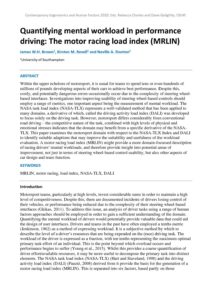
|
Author
James W.H. Brown, Kirsten M. Revell and Neville A. Stanton |
Abstract
Within the upper echelons of motorsport, it is usual for teams to spend tens or even hundreds of millions of pounds developing aspects of their cars to achieve best performance. Despite this, costly, and potentially dangerous errors occasionally occur due to the complexity of steering wheel-based interfaces. Investigations into improving usability of steering wheel-based controls should employ a range of metrics, one important aspect being the measurement of mental workload. The NASA task load index (NASA-TLX) represents a well-validated method that has been applied to many domains, a derivative of which, called the driving activity load index (DALI) was developed to focus solely on the driving task. However, motorsport differs considerably from conventional road driving – the competitive nature of the task, combined with high levels of physical and emotional stresses indicates that the domain may benefit from a specific derivative of the NASA-TLX. This paper examines the motorsport domain with respect to the NASA-TLX Index and DALI to identify suitable adaptions that may improve the suitability and usefulness of the workload evaluation. A motor racing load index (MRLIN) might provide a more domain-focussed description of racing drivers’ mental workloads, and therefore provide insight into potential areas of improvement, not just in terms of steering wheel-based control usability, but also other aspects of car design and team function. |
Publish Date: Jun 12, 2023 | Keywords: Contemporary EHF 2023, Design, Healthcare, Publications, Technology, Usability
| Document
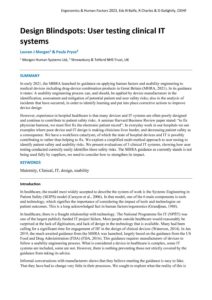
|
Author
Lauren J Morgan & Paula Pryce |
Abstract
In early 2021, the MHRA launched its guidance on applying human factors and usability engineering to medical devices including drug-device combination products in Great Britain (MHRA, 2021). In its guidance it states: A usability engineering process can, and should, be applied by device manufacturers in the identification, assessment and mitigation of potential patient and user safety risks; also in the analysis of incidents that have occurred, in order to identify learning and put into place corrective actions to improve device design However, experience in hospital healthcare is that many devices and IT systems are often poorly designed and continue to contribute to patient safety risks. A seminar Harvard Business Review paper stated: “to fix physician burnout, we must first fix the electronic patient record”. In everyday work in our hospitals we see examples where poor device and IT design is making clinicians lives harder, and decreasing patient safety as a consequence. We have a workforce cataclysm, of which the state of hospital devices and IT is possibly contributing to rather than helping to fix. We explore a simplified multi-method approach to user testing to identify patient safety and usability risks. We present evaluations of 3 clinical IT systems, showing how user testing conducted correctly easily identifies these safety risks. The MHRA guidance as currently stands is not being used fully by suppliers, we need to consider how to strengthen its impact. |
Publish Date: Mar 25, 2019 | Keywords: Contemporary EHF 2016, Leadership, Publications, Safety
| Document

|
Author
Jonathan BERMAN, Shona WATSON and Michael ARGENT |
Abstract
|
Publish Date: Oct 30, 2018 | Keywords: Contemporary EHF 2017, Design, Energy, Publications
| Document
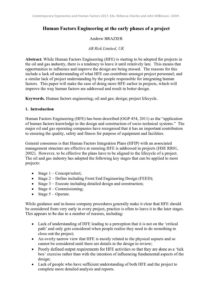
|
Author
Andrew BRAZIER |
Abstract
While Human Factors Engineering (HFE) is starting to be adopted for projects in the oil and gas industry, there is a tendency to leave it until relatively late. This means that opportunities to influence and improve the design are being missed. The reasons for this include a lack of understanding of what HFE can contribute amongst project personnel; and a similar lack of project understanding by the people responsible for integrating human factors. This paper will make the case of doing more HFE earlier in projects, which will improve the way human factors are addressed and result in better design. |
Publish Date: Apr 17, 2020 | Keywords: Cognition, Contemporary EHF 2020, Education, training & skills, Mental health & wellbeing, Publications, Systems
| Document
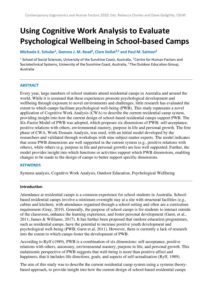
|
Author
Michaela E. Schuler, Gemma J. M. Read, Clare Dallat and Paul M. Salmon |
Abstract
Every year, large numbers of school students attend residential camps in Australia and around the world. While it is assumed that these experiences promote psychological development and wellbeing through exposure to novel environments and challenges, little research has evaluated the extent to which camps facilitate psychological well-being (PWB). This study represents a novel application of Cognitive Work Analysis (CWA) to describe the current residential camp system, providing insight into how the current design of school-based residential camps support PWB. The Six-Factor Model of PWB was adopted, which proposes six dimensions of PWB: self-acceptance, positive relations with others, environmental mastery, purpose in life and personal growth. The first phase of CWA, Work Domain Analysis, was used, with an initial model developed by the researchers and validated through workshops with nine subject matter experts. The model indicates that some PWB dimensions are well supported in the current system (e.g., positive relations with others), while others (e.g. purpose in life and personal growth) are less well supported. Further, the model provides insight into which functions or activities support which PWB dimensions, enabling changes to be made to the design of camps to better support specific dimensions. |
Publish Date: Dec 17, 2018 | Keywords: Contemporary EHF 2017, Publications, Virtual reality
| Document
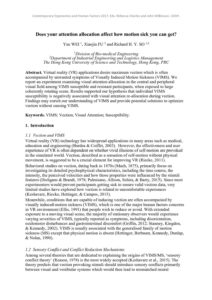
|
Author
Yue WEI, Xiaojin FU and Richard H. Y. SO |
Abstract
Virtual reality (VR) applications desire maximum vection which is often accompanied by unwanted symptoms of Visually Induced Motion Sickness (VIMS). We report an experiment examining visual attention allocation in the central and peripheral visual field among VIMS susceptible and resistant participants, when exposed to large coherently rotating scene. Results supported our hypothesis that individual VIMS susceptibility is negatively associated with visual attention re-allocation during vection. Findings may enrich our understanding of VIMS and provide potential solutions to optimize vection without causing VIMS. |
Publish Date: Aug 10, 2021 | Keywords: Aviation, Comfort, Comfort Congress 2021, Publications, Seating
 |
Author
Xinhe Yao, Yufei He, Norbert Hessenberger, Yu Song & Peter Vink |
Abstract
During a flight, passengers spend most of their time sitting in their seats. Studying the comfort and discomfort while passengers are sitting is helpful to improve the overall comfort during a flight. Pressure mats are commonly used in studies to collect pressure distribution in order to research sitting comfort. Different from most past studies, in which pressure mats are placed on the top of the cushions, the focus of this paper is to show the potential of placing pressure mat below the seat cushion. Three identical cushions differing in stiffness were prepared. The pressure distribution of 12 sitting postures was collected from 33 subjects both at the top as well as at the bottom of the foam in a randomized order. After sitting on each cushion, the participant was asked to leave the seat and complete a sitting comfort and discomfort questionnaire. The results show that the softest cushion got the highest rank in short-term comfort and lowest rank in short-term discomfort. The recorded pressure distributions both on the top and at the bottom of the foam can influence comfort and discomfort. This indicates the potential to use pressure distributions under the foam to evaluate the perceived comfort and discomfort in sitting, which might reduce the intrusive feeling of the participants in comfort studies. |
Publish Date: May 27, 2025 | Keywords: Contemporary EHF 2025, Musculoskeletal, Publications, Virtual reality
| Document
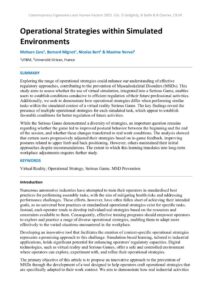
|
Author
Mohsen Zare, Bernard Mignot, Nicolas Bert & Maxime Norval |
Abstract
Exploring the range of operational strategies could enhance our understanding of effective regulatory approaches, contributing to the prevention of Musculoskeletal Disorders (MSDs). This study aims to assess whether the use of virtual simulation, integrated into a Serious Game, enables users to establish conditions conducive to efficient regulation of their future professional activities. Additionally, we seek to demonstrate how operational strategies differ when performing similar tasks within the simulated context of a virtual reality Serious Game. The key findings reveal the presence of multiple operational strategies for each simulated task, which appear to establish favorable conditions for better regulation of future activities. While the Serious Game demonstrated a diversity of strategies, an important question remains regarding whether the game led to improved postural behavior between the beginning and the end of the session, and whether these changes transferred to real work conditions. The analysis showed that certain users progressively adjusted their strategies based on in-game feedback, improving postures related to upper limb and back positioning. However, others maintained their initial approaches despite recommendations. The extent to which this learning translates into long-term workplace adjustments requires further study. |
Publish Date: Feb 26, 2019 | Keywords: Contemporary EHF 2016, Healthcare, Publications, Sociotechnical systems, Systems
| Document
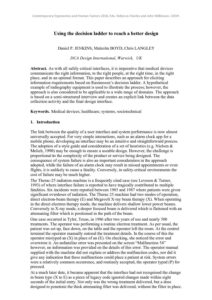
|
Author
Daniel P. JENKINS, Malcolm BOYD, Chris LANGLEY |
Abstract
As with all safely critical interfaces, it is imperative that medical devices communicate the right information, to the right people, at the right time, in the right place, and in an optimal format. This paper describes an approach for eliciting information requirements based on Rasmussen’s decision ladder. A hypothetical example of radiography equipment is used to illustrate the process; however, the approach is also considered to be applicable to a wide range of domains. The approach is based on a semi-structured interview and creates an explicit link between the data collection activity and the final design interface. |
Publish Date: May 23, 2025 | Keywords: Contemporary EHF 2025, Education, training & skills, Equality, diversity & inclusion (EDI), Publications
| Document
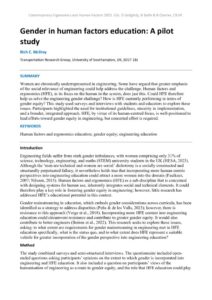
|
Author
Rich C. McIlroy |
Abstract
Women are chronically underrepresented in engineering. Some have argued that greater emphasis of the social relevance of engineering could help address the challenge. Human factors and ergonomics (HFE), in its focus on the human in the system, does just this. Could HFE therefore help us solve the engineering gender challenge? How is HFE currently performing in terms of gender equity? This study used surveys and interviews with students and educators to explore these issues. Participants highlighted the need for institutional guidelines, sincerity in implementation, and a broader, integrated approach. HFE, by virtue of its human-centred focus, is well-positioned to lead efforts toward gender equity in engineering, but concerted effort is required. |
Publish Date: Jun 12, 2023 | Keywords: Aviation, Contemporary EHF 2023, Interface design, Publications, Situation awareness, Technology
| Document
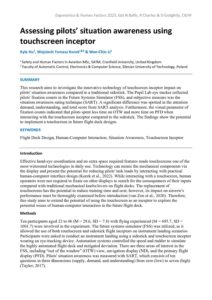
|
Author
Kyle Hu, Wojciech Tomasz Korek & Wen-Chin Li |
Abstract
This research aims to investigate the innovative technology of touchscreen inceptor impact on pilots' situation awareness compared to a traditional sidestick. The Pupil Lab eye tracker collected pilots' fixation counts in the Future Systems Simulator (FSS), and subjective measure was the situation awareness rating technique (SART). A significant difference was spotted in the attention demand, understanding, and total score from SART analysis. Furthermore, the visual parameter of fixation counts indicated that pilots spent less time on OTW and more time on PFD when interacting with the touchscreen inceptor compared to the sidestick. The findings show the potential to implement a touchscreen in future flight deck designs. |
Publish Date: Jun 3, 2024 | Keywords: Aviation, Contemporary EHF 2024, Perception, Publications, Risk assessment, Safety
| Document
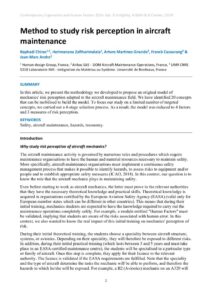
|
Author
Raphaël Chirac, Herimanana Zafiharimalala, Arturo Martinez-Gracida, Franck Cazaurang & Jean-Marc Andre |
Abstract
In this article, we present the methodology we developed to propose an original model of mechanics' risk perception adapted to the aircraft maintenance field. We have identified 20 concepts that can be mobilised to build the model. To focus our study on a limited number of targeted concepts, we carried out a 4-stage selection process. As a result, the model was reduced to 4 factors and 3 measures of risk perception. |
Publish Date: Feb 27, 2019 | Keywords: Contemporary EHF 2016, Healthcare, Publications
| Document
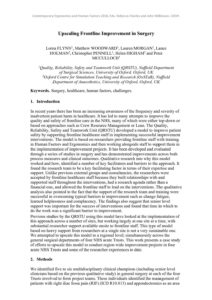
|
Author
Lorna FLYNN, Matthew WOODWARD, Lauren MORGAN, Lance HOLMAN, Christopher PENNELL, Helen HIGHAM and Peter MCCULLOCH |
Abstract
|
Publish Date: Jun 24, 2022 | Keywords: Contemporary EHF 2022, Interface design, Publications, Technology, User experience
| Document
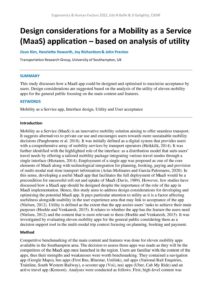
|
Author
Jisun Kim, Henrietta Howarth, Joy Richardson & John Preston |
Abstract
This study discusses how a MaaS app could be designed and optimised to maximise acceptance by users. Design considerations are suggested based on the analysis of the utility of eleven mobility apps for the general public focusing on the main content and features. |
Publish Date: Apr 9, 2021 | Keywords: Contemporary EHF 2021, Defence, Publications, Submarines, Workload
| Document
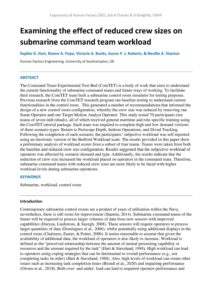
|
Author
Sophie G. Hart, Kiome A. Pope, Victoria A. Banks, Aaron P. J. Roberts & Neville A. Stanton |
Abstract
The Command Team Experimental Test-Bed (ComTET) is a body of work that aims to understand the current functionality of submarine command teams and future ways of working. To facilitate their research, the ComTET team built a submarine control room simulator for testing purposes. Previous research from the ComTET research program ran baseline testing to understand current functionalities in the control room. This generated a number of recommendations that informed the design of a new control room configuration, whereby the crew size was reduced by removing one Sonar Operator and one Target Motion Analyst Operator. This study tested 70 participants (ten teams of seven individuals), all of which received general maritime and role-specific training using the ComTET tutorial package. Each team was required to complete high and low demand versions of three scenario types: Return to Periscope Depth, Inshore Operations, and Dived Tracking. Following the completion of each scenario, the participants’ subjective workload was self-reported using an electronic version of the Bedford Workload scale. The results provided in this paper show a preliminary analysis of workload scores from a subset of four teams. Teams were taken from both the baseline and reduced crew size configuration. Results suggested that the subjective workload of operators was affected by scenario demand and type. Additionally, the results indicate that the reduction of crew size increased the workload placed on operators in the command team. Therefore, submarine command teams with reduced crew sizes are more likely to be faced with higher workload levels during submarine operations. |
Publish Date: Feb 27, 2019 | Keywords: Contemporary EHF 2016, Defence, Publications
| Document
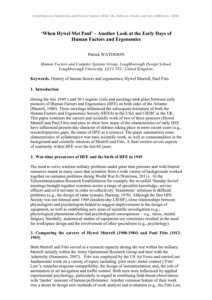
|
Author
Patrick WATERSON |
Abstract
|
Publish Date: Jun 8, 2023 | Keywords: Augmented reality, Aviation, Cognition, Contemporary EHF 2023, Publications, Situation awareness, Technology
| Document
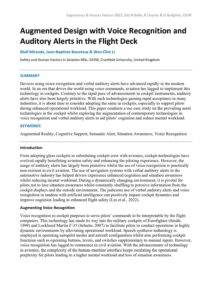
|
Author
Niall Miranda, Jean-Baptiste Bonotaux & Wen-Chin Li |
Abstract
Devices using voice recognition and verbal auditory alerts have advanced rapidly in the modern world. In an era that drives the world using voice commands, aviation has lagged to implement this technology in cockpits. Contrary to the rapid pace of advancements in cockpit instruments, auditory alerts have also been largely primitive. With such technologies gaining rapid acceptance in many industries, it is about time to consider adopting the same in cockpits, especially to support pilots during enhanced operational workload. This paper conducts a use case study on the prevailing aural technologies in the cockpit whilst exploring the augmentation of contemporary technologies in voice recognition and verbal auditory alerts to aid pilots’ cognition and reduce mental workload. |
Publish Date: May 23, 2025 | Keywords: Aviation, Contemporary EHF 2025, Design, Human performance, Publications
| Document
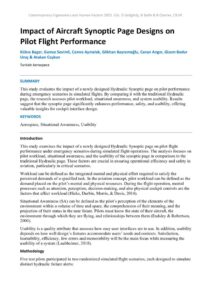
|
Author
Kübra Bager, Gamze Sevimli, Cemre Aymelek, Gökhan Bayramoğlu, Canan Angın, Gizem Bodur Uruç & Atakan Coşkun |
Abstract
This study evaluates the impact of a newly designed Hydraulic Synoptic page on pilot performance during emergency scenarios in simulated flights. By comparing it with the traditional Hydraulic page, the research assesses pilot workload, situational awareness, and system usability. Results suggest that the synoptic page significantly enhances performance, safety, and usability, offering valuable insights for cockpit interface design. |
Publish Date: May 23, 2025 | Keywords: Contemporary EHF 2025, Design, Publications, Risk assessment
| Document
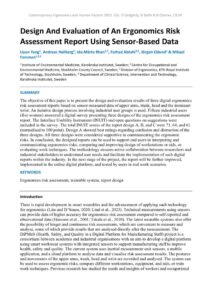
|
Author
Liyun Yang, Andreas Hallberg, Ida-Märta Rhen, Farhad Abtahi, Jörgen Eklund & Mikael Forsman |
Abstract
The objective of this paper is to present the design and evaluation results of three digital ergonomics risk assessment reports based on sensor-measured data of upper arms, trunk, head and the dominant wrist. An iterative design process involving industrial user groups is used. Fifteen industrial users (five women) answered a digital survey presenting three designs of the ergonomics risk assessment report. The Interface Usability Instrument (INUIT) and open questions on suggestions were included in the survey. The total INUIT scores of the report design A, B, and C were 71, 64, and 61 (normalised to 100 point). Design A showed best ratings regarding confusion and distraction of the three designs. All three designs were considered supportive in communicating the ergonomic risks. In conclusion, the designed reports can be used to support end users in interpreting and communicating ergonomics risks, comparing and improving design of workstations or aids, or evaluating work techniques. The methodology ensures active collaboration between researchers and industrial stakeholders to understand user needs and facilitate the implementation of such digital reports within the industry. In the next stage of the project, the report will be further improved, implemented in the online digital platform, and tested by users in real work scenarios. |
Publish Date: Feb 27, 2019 | Keywords: Aviation, Behaviour, Contemporary EHF 2016, Defence, Investigation, Publications
| Document
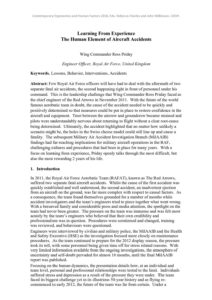
|
Author
Wing Commander Ross Priday |
Abstract
Few Royal Air Force officers will have had to deal with the aftermath of two separate fatal air accidents, the second happening right in front of personnel under his command. This is the leadership challenge that Wing Commander Ross Priday faced as the chief engineer of the Red Arrows in November 2011. With the future of the world famous aerobatic team in doubt, the cause of the accident needed to be quickly and positively determined so that measures could be put in place to restore confidence in the aircraft and equipment. Trust between the aircrew and groundcrew became strained and pilots were understandably nervous about returning to flight without a clear root-cause being determined. Ultimately, the accident highlighted that no matter how unlikely a scenario might be, the holes in the Swiss cheese model could still line up and cause a fatality. The subsequent Military Air Accident Investigation Branch (MilAAIB) findings had far-reaching implications for military aircraft operations in the RAF, challenging cultures and procedures that had been in place for many years. With a focus on learning from experience, Priday openly talks through the most difficult, but also the most rewarding 2 years of his life. |
Publish Date: Dec 18, 2018 | Keywords: Contemporary EHF 2017, Defence, Publications, Systems
| Document
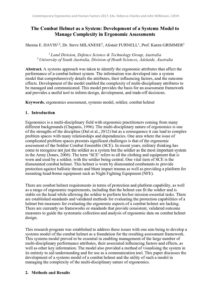
|
Author
Sheena E. DAVIS, Dr. Steve MILANESE, Alistair FURNELL, Prof. Karen GRIMMER |
Abstract
A systems approach was taken to identify the ergonomic attributes that affect the performance of a combat helmet system. The information was developed into a system model that comprehensively details the attributes, their influencing factors, and the outcome effects. Development of the model enabled the complexity of multi-disciplinary attributes to be managed and communicated. This model provides the basis for an assessment framework and provides a useful tool to inform design, development, and trade-off decisions. |
Publish Date: Feb 27, 2019 | Keywords: Autonomous systems, Contemporary EHF 2016, Design, Publications
| Document
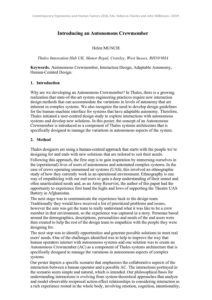
|
Author
Helen MUNCIE |
Abstract
|
Publish Date: Sep 8, 2019 | Keywords: Contemporary EHF 2019, Publications, Road safety, Technology, Transport
| Document
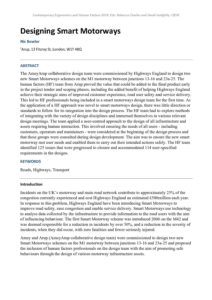
|
Author
Nic Bowler |
Abstract
The AmeyArup collaborative design team were commissioned by Highways England to design two new Smart Motorways schemes on the M1 motorway between junctions 13-16 and 23a-25. The human factors (HF) team from Arup proved the value that could be added to the final product early in the project tender and scoping phases, including the added benefit of helping Highways England achieve their strategic aims of improved customer experience, road user safety and service delivery. This led to HF professionals being included in a smart motorways design team for the first time. As the application of a HF approach was novel to smart motorways design, there was little direction or standards to follow for its integration into the design process. The HF team had to explore methods of integrating with the variety of design disciplines and immersed themselves in various relevant design meetings. The team applied a user-centred approach to the design of all infrastructure and assets requiring human interaction. This involved ensuring the needs of all users - including customers, operators and maintainers - were considered at the beginning of the design process and that these groups were consulted during design development. The aim was to ensure the new smart motorway met user needs and enabled them to carry out their intended actions safely. The HF team identified 125 issues that were progressed to closure and accommodated 114 user-specified requirements in the designs. |
Publish Date: Jun 23, 2022 | Keywords: Artificial intelligence, Aviation, Contemporary EHF 2022, Publications
| Document
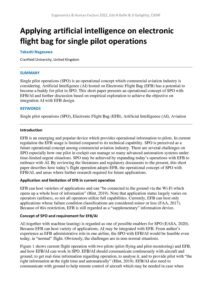
|
Author
Takashi Nagasawa |
Abstract
Single pilot operations (SPO) is an operational concept which commercial aviation industry is considering. Artificial Intelligence (AI) hosted on Electronic Flight Bag (EFB) has a potential to become a buddy for pilot in SPO. This short paper presents an operational concept of SPO with EFB/AI and further discussion based on empirical exploration to achieve the objective on integration AI with EFB design. |
Publish Date: Oct 23, 2018 | Keywords: Contemporary EHF 2018, Defence, Publications, Systems
| Document
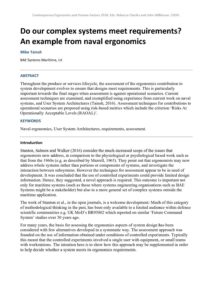
|
Author
Mike Tainsh |
Abstract
Throughout the produce or services lifecycle, the assessment of the ergonomics contribution to system development evolves to ensure that designs meet requirements. This is particularly important towards the final stages when assessment is against operational scenarios. Current assessment techniques are examined, and exemplified using experience from current work on naval systems, and User System Architectures (Tainsh, 2016). Assessment techniques for contributions to operational scenarios are proposed using risk-based metrics which include the criterion ‘Risks At Operationally Acceptable Levels (RAOAL)’. |
Publish Date: Jun 3, 2024 | Keywords: Contemporary EHF 2024, Defence, Human factors integration, Publications, Safety
| Document
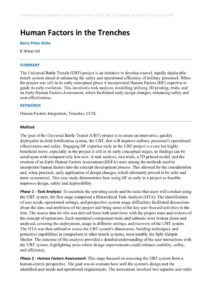
|
Author
Barry Peter Kirby |
Abstract
The Universal Battle Trench (UBT) project is an initiative to develop a novel, rapidly deployable trench system aimed at enhancing the safety and operational efficiency of military personnel. When the project was still in its early conceptual phase it incorporated Human Factors (HF) expertise to guide its early evolution. This involved a task analysis, modelling utilising 3D printing, trials, and an Early Human Factors Assessment, which facilitated early design changes, enhancing safety and cost-effectiveness. |
Publish Date: Aug 9, 2021 | Keywords: Comfort, Fatigue & sleep, Publications
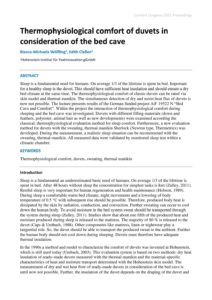 |
Author
Bianca-Michaela Wölfling, Edith Claßen |
Abstract
Sleep is a fundamental need for humans. On average 1/3 of the lifetime is spent in bed. Important for a healthy sleep is the duvet. This should have sufficient heat insulation and should ensure a dry bed climate at the same time. The thermophysiological comfort of classic duvets can be rated via skin model and thermal manikin. The simultaneous detection of dry and moist heat flux of duvets is now not possible. The lecture presents results of the German funded project AiF 19522 N “Bed Cave and Comfort”. Within the project the interaction of thermophysiological comfort during sleeping and the bed cave was investigated. Duvets with different filling materials (down and feathers, polyester, animal hair as well as new developments) were examined according the classical, thermophysiological evaluation method for sleep comfort. Furthermore, a new evaluation method for duvets with the sweating, thermal manikin Sherlock (Newton type, Thermetrics) was developed. During the measurement, a realistic sleep situation can be reconstructed with the sweating, thermal manikin. All measured data were validated by monitored sleep test within a climatic chamber. |
Publish Date: Jun 11, 2025 | Keywords: Contemporary EHF 2025, Healthcare, Human performance, Publications, Teamwork
| Document
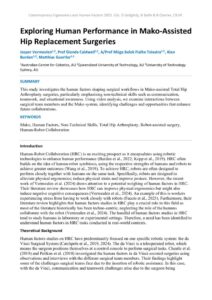
|
Author
Jasper Vermeulen, Glenda Caldwell, Müge Belek Fialho Teixeira, Alan Burden, Matthias Guertler |
Abstract
This study investigates the human factors shaping surgical workflows in Mako-assisted Total Hip Arthroplasty surgeries, particularly emphasising non-technical skills such as communication, teamwork, and situational awareness. Using video analysis, we examine interactions between surgical team members and the Mako system, identifying challenges and opportunities that enhance future collaborations. |
Publish Date: Jun 11, 2025 | Keywords: Aviation, Contemporary EHF 2025, Incidents, Publications
| Document
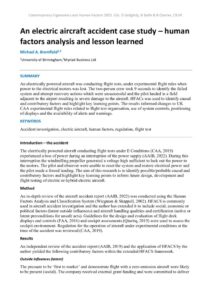
|
Author
Michael A. Bromfield |
Abstract
An electrically powered aircraft was conducting flight tests, under experimental flight rules when power to the electrical motors was lost. The two-person crew took 9 seconds to identify the failed system and attempt recovery actions which were unsuccessful and the pilot landed in a field adjacent to the airport resulting in severe damage to the aircraft. HFACs was used to identify causal and contributory factors and highlight key learning points. The results informed changes to UK CAA experimental flight rules related to flight test organisation, use of system controls, positioning of displays and the availability of alerts and warnings. |
Publish Date: Jun 23, 2022 | Keywords: Cognition, Contemporary EHF 2022, Decision making, Emergency services, Healthcare, Patient Safety, Publications
| Document
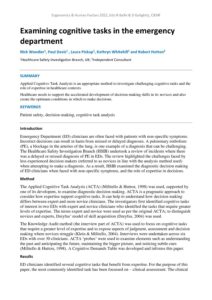
|
Author
Nick Woodier, Paul Davis, Laura Pickup, Kathryn Whitehill & Robert Hutton |
Abstract
Applied Cognitive Task Analysis is an appropriate method to investigate challenging cognitive tasks and the role of expertise in healthcare contexts. Healthcare needs to support the accelerated development of decision-making skills in its novices and also create the optimum conditions in which to make decisions. |
Publish Date: Sep 30, 2018 | Keywords: Contemporary EHF 2018, Healthcare, Publications, User centred design
| Document
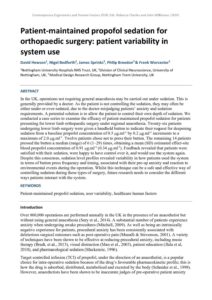
|
Author
David Hewson, Nigel Bedforth, James Sprinks, Philip Breedon & Frank Worcester |
Abstract
In the UK, operations not requiring general anaesthesia may be carried out under sedation. This is generally provided by a doctor. As the patient is not controlling the sedation, they may often be either under or over-sedated, due to the doctor misjudging patients’ anxiety and sedation requirements. A potential solution is to allow the patient to control their own depth of sedation. We conducted a case series to examine the efficacy of patient-maintained propofol sedation for patients presenting for lower limb orthopaedic surgery under regional anaesthesia. Twenty-six patients undergoing lower limb surgery were given a handheld button to indicate their request for deepening sedation from a baseline propofol concentration of 0.5 g.ml-1 by 0.2 g.ml-1 increments to a maximum of 2.0 g.ml-1. Twelve patients chose not to press their button. The remaining 14 patients pressed the button a median (range) of 6 (1–29) times, obtaining a mean (SD) estimated effect-site blood propofol concentration of 0.91 g.ml-1 (0.34 g.ml-1). Feedback revealed that patients were satisfied with their sedation, were happy to have control over it, and would use the system again. Despite this consensus, sedation level profiles revealed variability in how patients used the system in terms of button press frequency and timing, associated with their pre-op anxiety and reaction to environmental events during the operation. Whilst this technique can be a safe and effective way of controlling sedation during these types of surgery, future research needs to consider the different ways patients interact with the system. |
Publish Date: Jun 12, 2023 | Keywords: Automotive, Autonomous vehicles, Contemporary EHF 2023, Human-machine interaction, Publications
| Document
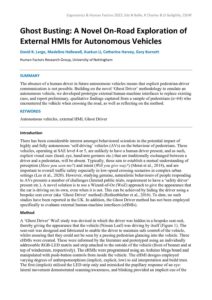
|
Author
David R. Large, Madeline Hallewell, Xuekun Li, Catherine Harvey & Gary Burnett |
Abstract
The absence of a human driver in future autonomous vehicles means that explicit pedestrian-driver communication is not possible. Building on the novel ‘Ghost Driver’ methodology to emulate an autonomous vehicle, we developed prototype external human-machine interfaces to replace existing cues, and report preliminary, qualitative findings captured from a sample of pedestrians (n=64) who encountered the vehicle when crossing the road, as well as reflecting on the method. |
Publish Date: Aug 19, 2021 | Keywords: Aviation, Comfort Congress 2021, Design, Pandemic, Publications
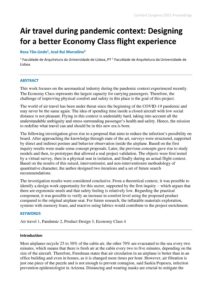 |
Author
Rosa Tão-Lindo & José Rui Marcelino |
Abstract
This work focuses on the aeronautical industry during the pandemic context experienced recently. The Economy Class represents the largest capacity for carrying passengers. Therefore, the challenge of improving physical comfort and safety in this place is the goal of this project. The world of air travel has been under threat since the beginning of the COVID-19 pandemic and may never be the same again. The idea of spending time inside a closed aircraft with low social distance is not pleasant. Flying in this context is undeniably hard, taking into account all the understandable ambiguity and stress surrounding passenger’s health and safety. Hence, the mission to redefine what travel can and should be in this new era is born. The following investigation gives rise to a proposal that aims to reduce the infection’s possibility on board. After approaching the knowledge through state of the art, surveys were structured, supported by direct and indirect posture and behavior observation inside the airplane. Based on the first inquiry results were made some concept proposals. Later, the previous concepts gave rise to study models and then, to prototypes that allowed a real project validation. The objects were first tested by a virtual survey, then in a physical seat in isolation, and finally during an actual flight context. Based on the results of this mixed, interventionist, and non-interventionist methodology of quantitative character, the author designed two iterations and a set of future search recommendations. The investigation results were considered conclusive. From a theoretical context, it was possible to identify a design work opportunity for this sector, supported by the first inquiry – which argues that there are ergonomic needs and that safety feeling is relatively low. Regarding the practical component, it was possible to verify an increase in comfort level using the proposed product compared to the original airplane seat. For future research, the inflatable materials exploration, systems with memory foam, and reactive using fabrics would contribute to the project enrichment. |
Publish Date: Feb 27, 2019 | Keywords: Contemporary EHF 2016, Publications, Situation awareness, Sociotechnical systems, Teamwork
| Document
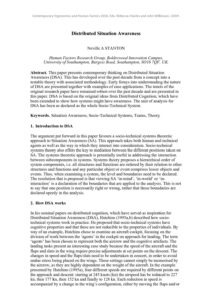
|
Author
Neville A STANTON |
Abstract
This paper presents contemporary thinking on Distributed Situation Awareness (DSA). This has developed over the past decade from a concept into a testable theory with associated methodology. Early forays into understanding the nature of DSA are presented together with examples of case applications. The tenets of the original research paper have remained robust over the past decade and are presented in this paper. DSA is based on the original ideas from Distributed Cognition, which have been extended to show how systems might have awareness. The unit of analysis for DSA has been as declared as the whole Socio-Technical System. |
Publish Date: Jun 24, 2022 | Keywords: Aviation, Contemporary EHF 2022, Publications, Safety culture
| Document
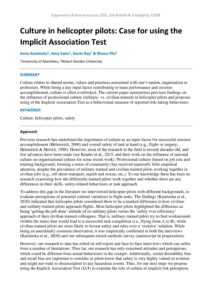
|
Author
Anna Kaminska, Amy Irwin, Devin Ray & Rhona Flin |
Abstract
Culture relates to shared norms, values and practices associated with one’s nation, organisation or profession. While being a key input factor contributing to team performance and mission accomplishment, culture is often overlooked. The current paper summarises previous findings on the influence of professional culture (military- vs. civilian-trained) in helicopter pilots and proposes using of the Implicit Association Test as a behavioural measure of reported risk-taking behaviours. |
Publish Date: Apr 17, 2020 | Keywords: Contemporary EHF 2020, Energy, Publications, Safety, Workload
| Document
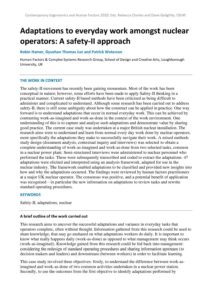
|
Author
Robin Hamer, Gyuchan Thomas Jun and Patrick Waterson |
Abstract
The safety-II movement has recently been gaining momentum. Most of the work has been conceptual in nature; however, some efforts have been made to apply Safety-II thinking in a practical manner. Current safety-II based methods have been criticised as being difficult to administer and complicated to understand. Although some research has been carried out to address safety-II, there is still some ambiguity about how the construct can be applied in practice. One way forward is to understand adaptations that occur in normal everyday work. This can be achieved by contrasting work-as-imagined and work-as-done in the context of the work environment. One understanding of this is to capture and analyse such adaptations and demonstrate value by sharing good practice. The current case study was undertaken at a major British nuclear installation. The research aims were to understand and learn from normal every day work done by nuclear operators, more specifically the adaptations they make to successfully navigate their work. A mixed methods study design (document analysis, contextual inquiry and interviews) was selected to obtain a complete understanding of work-as-imagined and work-as-done from two selected tasks, common in a nuclear power plant. Semi-structured interviews were administered to nuclear personnel who performed the tasks. These were subsequently transcribed and coded to extract the adaptations. 47 adaptations were elicited and interpreted using an analysis framework, adapted for use in the nuclear industry. The framework enabled adaptations to be classified and provided new insights into how and why the adaptations occurred. The findings were reviewed by human factors practitioners at a major UK nuclear operator. The consensus was positive, and a potential benefit of application was recognised – in particular the new information on adaptations to review tasks and rewrite standard operating procedures. |
Publish Date: Jun 11, 2025 | Keywords: Contemporary EHF 2025, Nuclear, Publications, Safety, Tools & techniques
| Document
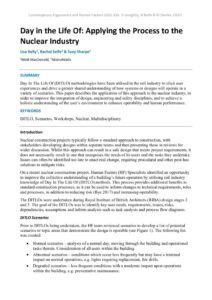
|
Author
Lisa Kelly, Rachel Selfe & Suzy Sharpe |
Abstract
Day In The Life Of (DITLO) methodologies have been utilised in the rail industry to elicit user experiences and drive a greater shared understanding of how systems or designs will operate in a variety of scenarios. This paper describes the application of this approach to the nuclear industry, in order to improve the integration of design, engineering and safety disciplines, and to achieve a holistic understanding of the user’s environment to enhance operability and human performance. |
Publish Date: Apr 9, 2021 | Keywords: Contemporary EHF 2021, Defence, Publications, Sociotechnical systems, Submarines
| Document
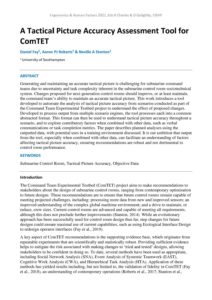
|
Author
Daniel Fay, Aaron PJ Roberts & Neville A Stanton |
Abstract
Generating and maintaining an accurate tactical picture is challenging for submarine command teams due to uncertainty and task complexity inherent in the submarine control room sociotechnical system. Changes proposed for next-generation control rooms should improve, or at least maintain, the command team’s ability to maintain an accurate tactical picture. This work introduces a tool developed to automate the analysis of tactical picture accuracy from scenarios conducted as part of the Command Team Experimental Testbed project to understand the effect of proposed changes. Developed to process output from multiple scenario engines, the tool processes each into a common abstracted format. This format can then be used to understand tactical picture accuracy throughout a scenario, and to explore contributory factors when combined with other data, such as verbal communications or task completion metrics. The paper describes planned analyses using the outputted data, with potential uses in a training environment discussed. It is our ambition that output from the tool, especially when combined with other data, can facilitate an understanding of factors affecting tactical picture accuracy, ensuring recommendations are robust and not detrimental to control room performance. |
Publish Date: Jun 12, 2023 | Keywords: Anthropometry, Contemporary EHF 2023, Defence, Publications
| Document
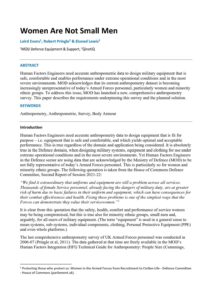
|
Author
Laird Evans, Robert Pringle & Eluned Lewis |
Abstract
Human Factors Engineers need accurate anthropometric data to design military equipment that is safe, comfortable and enables performance under extreme operational conditions and in the most severe environments. MOD acknowledges that its current anthropometry dataset is becoming increasingly unrepresentative of today’s Armed Forces personnel, particularly women and minority ethnic groups. To address this issue, MOD has launched a new, comprehensive anthropometry survey. This paper describes the requirements underpinning this survey and the planned solution. |
Publish Date: Apr 17, 2020 | Keywords: Anthropometry, Contemporary EHF 2020, Healthcare, Publications
| Document
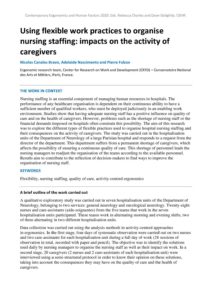
|
Author
Nicolas Canales Bravo, Adelaide Nascimento and Pierre Falzon |
Abstract
Nursing staffing is an essential component of managing human resources in hospitals. The performance of any healthcare organisation is dependent on their continuous ability to have a sufficient number of qualified workers, who must be deployed judiciously in an enabling work environment. Studies show that having adequate nursing staff has a positive influence on quality of care and on the health of caregivers. However, problems such as the shortage of nursing staff or the financial demands imposed on hospitals often constrain this possibility. The aim of this research was to explore the different types of flexible practices used to organise hospital nursing staffing and their consequences on the activity of caregivers. The study was carried out in the hospitalisation units of the Department of Neurology of a large Parisian hospital and responds to a request from the director of the department. This department suffers from a permanent shortage of caregivers, which affects the possibility of ensuring a continuous quality of care. This shortage of personnel leads the nursing managers to readjust the organisation of the teams according to the available personnel. Results aim to contribute to the reflection of decision-makers to find ways to improve the organisation of nursing staff. |
Publish Date: Apr 9, 2021 | Keywords: Autonomous systems, Autonomous vehicles, Aviation, Contemporary EHF 2021, Publications
| Document
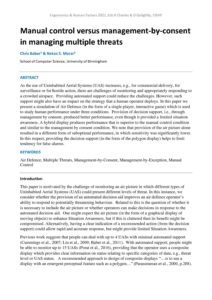
|
Author
Chris Baber & Natan S. Morar |
Abstract
As the use of Uninhabited Aerial Systems (UAS) increases, e.g., for commercial delivery, for surveillance or for hostile action, there are challenges of monitoring and appropriately responding to a crowded airspace. Providing automated support could reduce the challenges. However, such support might also have an impact on the strategy that a human operator deploys. In this paper we present a simulation of Air Defence (in the form of a single-player, interactive game) which is used to study human performance under three conditions. Provision of decision support, i.e., through management by consent, produced better performance, even though it provided a limited situation awareness. A hybrid display produces performance that is superior to the manual control condition and similar to the management by consent condition. We note that provision of the air picture alone resulted in a different form of suboptimal performance, in which sensitivity was significantly lower. In this respect, providing the decision support (in the form of the polygon display) helps to limit tendency for false alarms. |
Publish Date: Sep 8, 2019 | Keywords: Communication, Contemporary EHF 2019, Publications, Technology
| Document
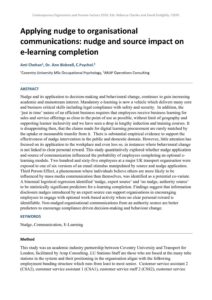
|
Author
Ami Chohan, Dr. Ann Bicknell, C.Psychol. |
Abstract
Nudge and its application to decision-making and behavioural change, continues to gain increasing academic and mainstream interest. Mandatory e-learning is now a vehicle which delivers many core and business critical skills including legal compliance with safety and security. In addition, the ‘just in time’ nature of an efficient business requires that employees receive business learning for sales and service offerings as close to the point of use as possible, without limit of geography and supporting learner inclusivity and we have seen a drop in lengthy induction and training courses. It is disappointing then, that the claims made for digital learning procurement are rarely matched by the uptake or measurable transfer from it. There is substantial empirical evidence to support the effectiveness of nudge intervention in the public and domestic domain. However, little attention has focused on its application to the workplace and even less so, in instances where behavioural change is not linked to clear personal reward. This study quantitatively explored whether nudge application and source of communication influenced the probability of employees completing an optional e-learning module. Two hundred and sixty-five employees at a major UK transport organisation were exposed to one of six versions of an email stimulus manipulated by source and nudge application. Third Person Effect, a phenomenon where individuals believe others are more likely to be influenced by mass media communication than themselves, was identified as a potential co-variate. A binomial logistical regression identified ‘nudge, expert source’ and ‘no nudge, authority source’ to be statistically significant predictors for e-learning completion. Findings suggest that information disclosure nudges introduced by an expert source can support organisations in encouraging employees to engage with optional work-based activity where no clear personal reward is identifiable. Non-nudged organisational communications from an authority source are better predictors to encourage compliance driven decision-making and behaviour change. |
Publish Date: Jun 5, 2024 | Keywords: Contemporary EHF 2024, Publications, Rail, Risk assessment, Task analysis
| Document
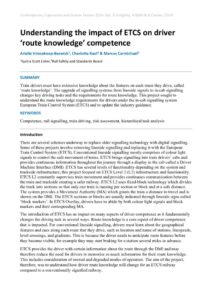
|
Author
Arielle Vriesekoop-Beswick, Charlotte Kaul & Marcus Carmichael |
Abstract
Train drivers must have extensive knowledge about the features on each route they drive, called ‘route knowledge’. The upgrade of signalling systems from lineside signals to in-cab signalling changes key driving tasks and the requirements for route knowledge. This project sought to understand the route knowledge requirements for drivers under the in-cab signalling system European Train Control System (ETCS) and to update the industry guidance. |
Publish Date: Apr 9, 2020 | Keywords: Automotive, Autonomous vehicles, Contemporary EHF 2020, Publications, Resilience
| Document
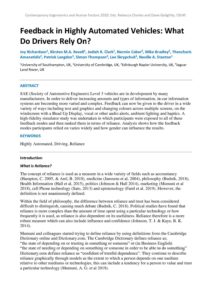
|
Author
Joy Richardson, Kirsten M.A. Revell, Jediah R. Clark, Nermin Caber, Mike Bradley, Theocharis Amanatidis, Patrick Langdon, Simon Thompson, Lee Skrypchuk, Neville A. Stanton |
Abstract
SAE (Society of Automotive Engineers) Level 3 vehicles are in development by many manufacturers. In order to deliver increasing amounts and types of information, in-car information systems are becoming more varied and complex. Feedback can now be given to the driver in a wide variety of ways including text and graphics and changing colours across multiple screens, on the windscreen with a Head Up Display, vocal or other audio alerts, ambient lighting and haptics. A high-fidelity simulator study was undertaken in which participants were exposed to all of these feedback modes and then ranked them in terms of reliance. Analysis shows how the feedback modes participants relied on varies widely and how gender can influence the results. |
Publish Date: Jun 24, 2022 | Keywords: Agriculture & forestry, Contemporary EHF 2022, Non-technical skills, Publications, Safety
| Document
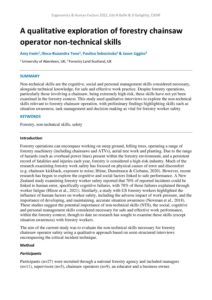
|
Author
Amy Irwin1, Ilinca-Ruxandra Tone, Paulina Sobocinska & Jason Liggins |
Abstract
Non-technical skills are the cognitive, social and personal management skills considered necessary, alongside technical knowledge, for safe and effective work practice. Despite forestry operations, particularly those involving a chainsaw, being extremely high-risk, these skills have not yet been examined in the forestry context. This study used qualitative interviews to explore the non-technical skills relevant to forestry chainsaw operation, with preliminary findings highlighting skills such as situation awareness, task management and decision-making as vital for forestry worker safety. |
Publish Date: Aug 12, 2021 | Keywords: Aviation, Comfort, Comfort Congress 2021, Perception, Publications, User experience
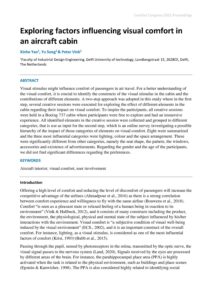 |
Author
Xinhe Yao, Yu Song & Peter Vink |
Abstract
Visual stimulus might influence comfort of passengers in air travel. For a better understanding of the visual comfort, it is crucial to identify the constructs of the visual stimulus in the cabin and the contributions of different elements. A two-step approach was adopted in this study where in the first step, several creative sessions were executed for exploring the effect of different elements in the cabin regarding their impact on visual comfort. To inspire the participants, all creative sessions were held in a Boeing 737 cabin where participants were free to explore and had an immersive experience. All identified elements in the creative session were collected and grouped to different categories, that is use as input for the second step, which is an online survey investigating a possible hierarchy of the impact of those categories of elements on visual comfort. Eight were summarized and the three most influential categories were lighting, colour and the space arrangement. These were significantly different from other categories, namely the seat shape, the pattern, the windows, accessories and existence of advertisements. Regarding the gender and the age of the participants, we did not find significant differences regarding the preferences. |
Publish Date: Jun 8, 2023 | Keywords: Aviation, Contemporary EHF 2023, Education, training & skills, Publications, Resilience, Safety
| Document
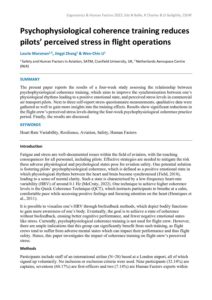
|
Author
Laurie Marsman, Jingyi Zhang & Wen-Chin Li |
Abstract
The present paper reports the results of a four-week study assessing the relationship between psychophysiological coherence training, which aims to improve the synchronisation between one’s physiological rhythms leading to a positive emotional state, and perceived stress levels in commercial air transport pilots. Next to three self-report stress questionnaire measurements, qualitative data were gathered as well to gain more insights into the training effects. Results show significant reductions in the flight crew’s perceived stress levels during the four-week psychophysiological coherence practice period. Finally, the results are discussed. |
Publish Date: Dec 17, 2018 | Keywords: Accimaps, Contemporary EHF 2017, Maritime, Publications, Safety
| Document
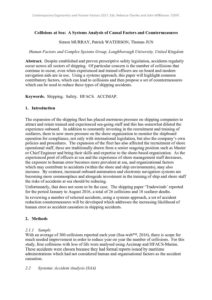
|
Author
Simon MURRAY, Patrick WATERSON, Thomas JUN |
Abstract
Despite established and proven prescriptive safety legislation, accidents regularly occur across all sectors of shipping. Of particular concern is the number of collisions that continue to occur, even when experienced and trained officers are on board and modern navigation aids are in use. Using a systems approach, this paper will highlight common contributory factors, which can lead to collisions and then propose a set of countermeasures which can be used to reduce these types of shipping accidents. |
Publish Date: Apr 16, 2020 | Keywords: Automotive, Autonomous vehicles, Contemporary EHF 2020, Fatigue & sleep, Publications
| Document
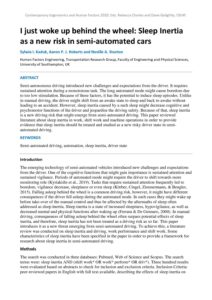
|
Author
Sylwia I. Kaduk, Aaron P. J. Roberts and Neville A. Stanton |
Abstract
Semi-autonomous driving introduced new challenges and expectations from the driver. It requires sustained attention during a monotonous task. The long automated mode might cause boredom due to too low stimulation. Because of these factors, it has the potential to induce sleep episodes. Unlike in manual driving, the driver might shift from an awake state to sleep and back to awake without leading to an accident. However, sleep inertia caused by a such sleep might decrease cognitive and psychomotor functions of the driver and jeopardise the driving safety. Because of that, sleep inertia is a new driving risk that might emerge from semi-automated driving. This paper reviewed literature about sleep inertia in work, shift work and machine operations in order to provide evidence that sleep inertia should be treated and studied as a new risky driver state in semi-automated driving. |
Publish Date: Jun 11, 2025 | Keywords: Contemporary EHF 2025, Design, Medical Devices, Patient Safety, Publications
| Document
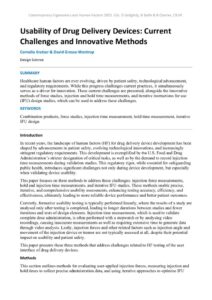
|
Author
Cornelia Kratzer & David Grosse-Wentrup |
Abstract
Healthcare human factors are ever evolving, driven by patient safety, technological advancement, and regulatory requirements. While this progress challenges current practices, it simultaneously serves as a driver for innovation. These current challenges are presented, alongside the innovative methods of force studies, injection and hold time measurements, and iterative instructions for use (IFU) design studies, which can be used to address these challenges. |
Publish Date: May 30, 2024 | Keywords: Contemporary EHF 2024, Publications, Rail, Transport
| Document
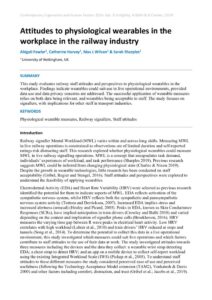
|
Author
Abigail Fowler, Catherine Harvey, Max L Wilson & Sarah Sharples |
Abstract
This study evaluates railway staff attitudes and perspectives to physiological wearables in the workplace. Findings indicate wearables could suit use in live operational environments, provided data use and data privacy concerns are addressed. The successful application of wearable measures relies on both data being relevant, and wearables being acceptable to staff. The study focuses on signallers, with implications for other staff in transport industries. |
Publish Date: Mar 24, 2019 | Keywords: Contemporary EHF 2016, Design, Healthcare, Publications
| Document
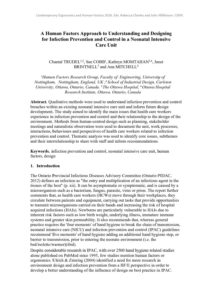
|
Author
Chantal TRUDEL, Sue COBB, Kathryn MOMTAHAN, Janet BRINTNELL and Ann MITCHELL |
Abstract
Qualitative methods were used to understand infection prevention and control breaches within an existing neonatal intensive care unit and inform future design development. The study aimed to identify the main issues that health care workers experience in infection prevention and control and their relationship to the design of the environment. Methods from human-centred design such as planning, stakeholder meetings and naturalistic observation were used to document the unit, work processes, interactions, behaviours and perspectives of health care workers related to infection prevention and control. Thematic analysis was used to identify core issues, subthemes and their interrelationship to share with staff and inform recommendations. |
Publish Date: Oct 23, 2018 | Keywords: Contemporary EHF 2018, Publications, Sport & leisure
| Document
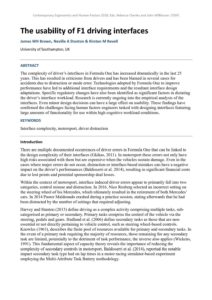
|
Author
James WH Brown, Neville A Stanton & Kirsten M Revell |
Abstract
The complexity of driver’s interfaces in Formula One has increased dramatically in the last 25 years. This has resulted in criticisms from drivers and has been blamed in several cases for accidents due to distraction or mode error. Technologies adopted by Formula One to improve performance have led to additional interface requirements and the resultant interface design adaptations. Specific regulatory changes have also been identified as significant factors in dictating the driver’s interface workload. Research is currently ongoing into the empirical analysis of the interfaces. Even minor design decisions can have a large effect on usability. These findings have confirmed the challenges facing human factors engineers tasked with designing interfaces featuring large amounts of functionality for use within high cognitive workload conditions. |
Publish Date: Apr 17, 2020 | Keywords: Contemporary EHF 2020, Human-machine interaction, Manufacturing, Psychology, Publications
| Document
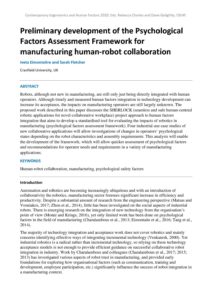
|
Author
Iveta Eimontaitre and Sarah Fletcher |
Abstract
Robots, although not new in manufacturing, are still only just being directly integrated with human operators. Although timely and measured human factors integration in technology development can increase its acceptance, the impacts on manufacturing operators are still largely unknown. The proposed work described in this paper discusses the SHERLOCK (seamless and safe human-centred robotic applications for novel collaborative workplace) project approach to human factors integration that aims to develop a standardised tool for evaluating the impacts of robotics in manufacturing (psychological factors assessment framework). Four industrial use case studies of new collaborative applications will allow investigations of changes in operators’ psychological states depending on the robot characteristics and assembly requirements. This analysis will enable the development of the framework, which will allow quicker assessment of psychological factors and recommendations for operator needs and requirements in a variety of manufacturing applications. |
Publish Date: Mar 25, 2019 | Keywords: Aviation, Contemporary EHF 2016, Human performance, Publications
| Document
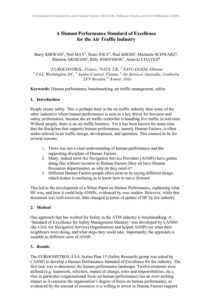
|
Author
Barry KIRWAN, Neil MAY, Remi JOLY, Paul KROIS, Michaela SCHWARZ, Damien ARMENIS, Billy JOSEFSSON, Anne-ki CHAVEZ |
Abstract
|
Publish Date: Jun 8, 2023 | Keywords: Automotive, Contemporary EHF 2023, Publications
| Document
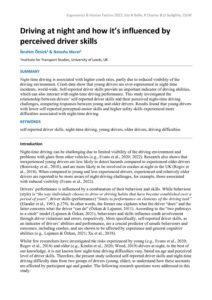
|
Author
İbrahim Öztürk & Natasha Merat |
Abstract
Night-time driving is associated with higher crash rates, partly due to reduced visibility of the driving environment. Crash data show that young drivers are over-represented in night-time incidents, world-wide. Self-reported driver skills provide an important indicator of driving abilities, which can also interact with night-time driving performance. This study investigated the relationship between drivers’ self-reported driver skills and their perceived night-time driving challenges, comparing responses between young and older drivers. Results found that young drivers with lower self-reported perceptual-motor skills and higher safety skills experienced more difficulties associated with night-time driving. |
Publish Date: May 23, 2025 | Keywords: Autonomous vehicles, Contemporary EHF 2025, Publications, Situation awareness
| Document
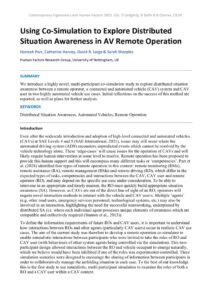
|
Author
Hannah Parr, Catherine Harvey, David R. Large & Sarah Sharples |
Abstract
We introduce a highly novel, multi-participant co-simulation study to explore distributed situation awareness between a remote operator, a connected and automated vehicle (CAV) system and CAV user in two highly automated vehicle use cases. Initial reflections on the success of this method are reported, as well as plans for further analysis. |
Publish Date: Sep 8, 2019 | Keywords: Contemporary EHF 2019, Publications, Rail
| Document
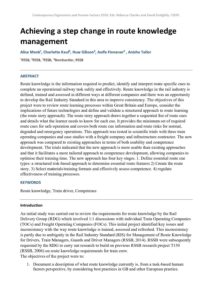
|
Author
Alice Monk, Charlotte Kaul, Huw Gibson, Aoife Finneran, Anisha Tailor |
Abstract
Route knowledge is the information required to predict, identify and interpret route specific cues to complete an operational railway task safely and effectively. Route knowledge in the rail industry is defined, trained and assessed in different ways at different companies and there was an opportunity to develop the Rail Industry Standard in this area to improve consistency. The objectives of this project were to review route learning processes within Great Britain and Europe, consider the implications of future technologies and define and validate a structured approach to route learning (the route story approach). The route story approach draws together a sequential list of route cues and details what the learner needs to know for each cue. It provides the minimum set of required route cues for safe operation and covers both route cue information and route risks for normal, degraded and emergency operations. This approach was tested in scientific trials with three train operating companies and case studies with a freight company and infrastructure contractor. The new approach was compared to existing approaches in terms of both usability and competence development. The trials indicated that the new approach is more usable than existing approaches and that it facilitates a more tailored approach to competence development, allowing companies to optimise their training time. The new approach has four key stages. 1. Define essential route cue types: a structured risk-based approach to determine essential route features 2) Create the route story. 3) Select materials/training formats and effectively assess competence. 4) regulate effectiveness of training processes. |
Publish Date: Apr 15, 2020 | Keywords: Contemporary EHF 2020, Healthcare, Publications, Simulation
| Document
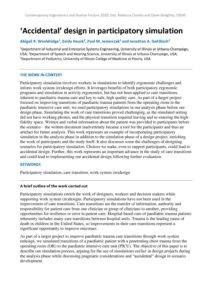
|
Author
Abigail R. Wooldridge, Emily Heuck, Paul M. Jeziorczak and Jonathan A. Gehlbach |
Abstract
Participatory simulation involves workers in simulations to identify ergonomic challenges and inform work system (re)design efforts. It leverages benefits of both participatory ergonomic programs and simulation in activity ergonomics, but has not been applied to care transitions, inherent to paediatric trauma care and key to safe, high quality care. As part of a larger project focused on improving transitions of paediatric trauma patients from the operating room to the paediatric intensive care unit, we used participatory simulations in our analysis phase before our design phase. Simulating the work of care transitions proved challenging, as the simulated setting did not have working phones, and the physical transition required leaving and re-entering the high-fidelity space. Written and verbal information about the patient was provided to participants before the scenario – the written document inadvertently became a tool for the participants and thus an artefact for future analysis. This work represents an example of incorporating participatory simulation in the analysis phase in addition to the simulation phase of a design project, enriching the work of participants and the study itself. It also discusses some the challenges of designing scenarios for participatory simulation. Choices we make, even to support participants, could lead to accidental design. Further, this work represents an important advance in the study of care transitions and could lead to implementing our accidental design following further evaluation. |
Publish Date: May 31, 2024 | Keywords: Aviation, Contemporary EHF 2024, Human factors integration, Incidents, Publications
| Document
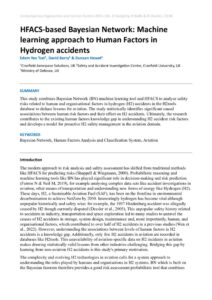
|
Author
Edem Yao Tsei, David Barry & Duncan Hewat |
Abstract
This study combines Bayesian Network (BN) machine learning tool and HFACS to analyse safety risks related to human and organisational factors in hydrogen (H2) accidents in the H2tools database to deduce lessons for aviation. The study statistically identifies significant causal associations between human risk factors and their effect on H2 accidents. Ultimately, the research contributes to the existing human factors knowledge gap in understanding H2 accident risk factors and develops a model for proactive H2 safety management in the aviation domain. |
Publish Date: Apr 16, 2020 | Keywords: Contemporary EHF 2020, Healthcare, Publications, Technology
| Document
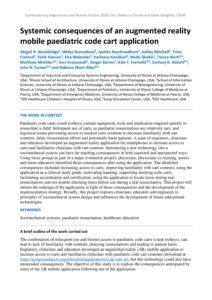
|
Author
Abigail R. Wooldridge, Widya Ramadhani, Jyotika Roychowdhury, Ashley Mitchell, Trina Croland, Keith Hanson, Elsa Melendez, Harleena Kendhari, Nadia Shaikh, Teresa Riech, Matthew Mischler, Sara Krzyzaniak, Ginger Barton, Kyle T. Formella, Zachary R. Abbott, John N. Farmer and Rebecca Ebert-Allen |
Abstract
Paediatric code carts (crash trolleys) contain equipment, tools and medication required quickly to resuscitate a child. Infrequent use of carts, as paediatric resuscitations are relatively rare, and logistical issues preventing access to stocked carts combine to decrease familiarity with cart contents, delay resuscitation efforts and potentially harm patients. A team of engineers, clinicians and educators developed an augmented reality application for smartphones to increase access to carts and familiarise clinicians with cart contents. Introducing a new technology into a sociotechnical system can have far reaching consequences in both expected and unexpected ways. Using focus groups as part of a larger evaluation project, physicians, physicians-in-training, nurses and nurse educators identified those consequences after using the application. The identified consequences included increasing access to carts, improving familiarity with cart contents, using the application as a clinical study guide, motivating learning, supporting stocking code carts, facilitating accreditation and certification, using the application to locate items during real resuscitations and not double-checking items before use during a real resuscitation. This project will inform the redesign of the application in light of those consequences and the development of the implementation strategy. Broadly, this project exposes clinicians, educators and engineers to principles of sociotechnical system design and influences the development of future educational technologies. |
Publish Date: Sep 8, 2019 | Keywords: Contemporary EHF 2019, Publications, Technology
| Document
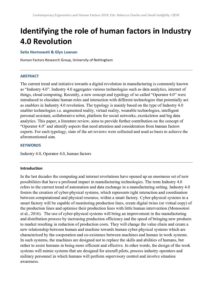
|
Author
Setia Hermawati & Glyn Lawson |
Abstract
The current trend and initiative towards a digital revolution in manufacturing is commonly known as “Industry 4.0”. Industry 4.0 aggregates various technologies such as data analytics, internet of things, cloud computing. Recently, a new concept and typology of so called “Operator 4.0” were introduced to elucidate human roles and interaction with different technologies that potentially act as enablers in Industry 4.0 revolution. The typology is mainly based on the type of Industry 4.0 enabler technologies i.e. augmented reality, virtual reality, wearable technologies, intelligent personal assistant, collaborative robot, platform for social networks, exoskeleton and big data analytics. This paper, a literature review, aims to provide further contribution on the concept of “Operator 4.0” and identify aspects that need attention and consideration from human factors experts. For each typology, state of the art reviews were collected and used as basis to achieve the aforementioned aim. |
Publish Date: Aug 19, 2021 | Keywords: Accessibility, Aviation, Comfort, Comfort Congress 2021, Publications
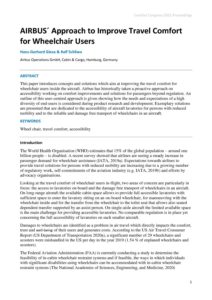 |
Author
Hans-Gerhard Giesa & Ralf Schliwa |
Abstract
This paper introduces concepts and solutions which aim at improving the travel comfort for wheelchair users inside the aircraft. Airbus has historically taken a proactive approach on accessibility working on comfort improvements and solutions for passengers beyond regulation. An outline of this user-centred approach is given showing how the needs and expectations of a high diversity of end-users is considered during product research and development. Exemplary solutions are presented that are dedicated to the accessibility of aircraft lavatories for persons with reduced mobility and to the reliable and damage free transport of wheelchairs in an aircraft. |
Publish Date: May 23, 2025 | Keywords: Aviation, Contemporary EHF 2025, Publications, Safety, Situation awareness
| Document
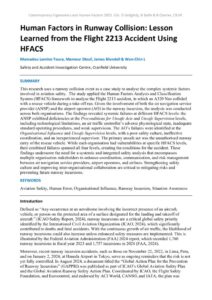
|
Author
Mamadou Lamine Toure, Mamour Diouf, James Blundell & Wen-Chin L |
Abstract
This research uses a runway collision event as a case study to analyse the complex systemic factors involved in aviation safety. The study applied the Human Factors Analysis and Classification System (HFACS) framework to analyse the Flight 2213 accident, in which an A320 Neo collided with a rescue vehicle during a take-off run. Given the involvement of both the air navigation service provider (ANSP) and the airport operator (AO) in the runway incursion, the analysis was conducted across both organisations. The findings revealed systemic failures at different HFACS levels: the ANSP exhibited deficiencies at the Preconditions for Unsafe Acts and Unsafe Supervision levels, including technological limitations, an air traffic controller’s adverse physiological state, inadequate standard operating procedures, and weak supervision. The AO’s failures were identified at the Organisational Influence and Unsafe Supervision levels, with a poor safety culture, ineffective coordination, and an inexperienced supervisor. The primary unsafe act was the unauthorised runway entry of the rescue vehicle. While each organisation had vulnerabilities at specific HFACS levels, their combined failures spanned all four levels, creating the conditions for the accident. These findings underscore the need for a systemic and integrated safety analysis that encompasses multiple organisation stakeholders to enhance coordination, communication, and risk management between air navigation service providers, airport operators, and airlines. Strengthening safety culture and improving inter-organisational collaboration are critical to mitigating risks and preventing future runway incursions. |
Publish Date: May 30, 2024 | Keywords: Contemporary EHF 2024, Human factors integration, Publications, Risk assessment
| Document
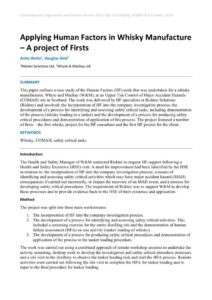
|
Author
Anita Weltz, Douglas Dick |
Abstract
This paper outlines a case study of the Human Factors (HF) work that was undertaken for a whisky manufacturer, Whyte and Mackay (W&M), at an Upper Tier Control of Major Accident Hazards (COMAH) site in Scotland. The work was delivered by HF specialists at Risktec Solutions (Risktec) and involved: the incorporation of HF into the company investigation process; the development of a process for identifying and assessing safety critical tasks, including demonstration of the process (whisky loading to a tanker) and the development of a process for producing safety critical procedures and demonstration of application of this process. The project featured a number of firsts – the first whisky project for the HF consultant and the first HF project for the client. |
Publish Date: Apr 8, 2021 | Keywords: Construction, Contemporary EHF 2021, Publications, Safety culture
| Document
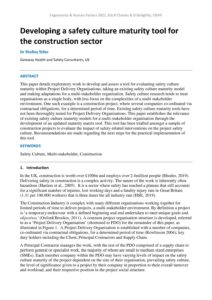
|
Author
Shelley Stiles |
Abstract
This paper details exploratory work to develop and assess a tool for evaluating safety culture maturity within Project Delivery Organisations, taking an existing safety culture maturity model and making adaptations for a multi-stakeholder organisation. Safety culture research tends to treat organisations as a single body, with less focus on the complexities of a multi stakeholder environment. One such example is a construction project, where several companies co-ordinated via contractual obligations, for a determined period of time. Existing safety culture maturity tools have not been thoroughly tested for Project Delivery Organisations. This paper establishes the relevance of existing safety culture maturity models for a multi-stakeholder organisation through the development of an updated maturity matrix tool. This tool has been trialled amongst a sample of construction projects to evaluate the impact of safety-related interventions on the project safety culture. Recommendations are made regarding the next steps for the practical implementation of this tool. |
Publish Date: Sep 7, 2019 | Keywords: Automotive, Comfort, Contemporary EHF 2019, Publications
| Document
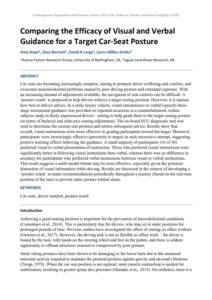
|
Author
Amy Hope, Gary Burnett, David R Large, Laura Millen-Dutka |
Abstract
Car seats are becoming increasingly complex, aiming to promote driver wellbeing and comfort, and overcome musculoskeletal problems caused by poor driving posture and extended exposure. With an increasing amount of adjustments available, the navigation of seat controls can be difficult. A ‘posture coach’ is proposed to help drivers achieve a target seating position. However, it is unclear how best to deliver advice. In a static luxury vehicle, visual (animations) or verbal (speech) three-stage incremental guidance was provided on repeated occasions in a counterbalanced, within-subjects study to thirty experienced drivers - aiming to help guide them to the target seating posture (in terms of backrest and slide-axis seating adjustment). The on-board ECU diagnostic tool was used to determine the current seat position and inform subsequent advice. Results show that, overall, visual instructions were more effective in guiding participants toward the target. Moreover, participants were increasingly effective (proximity to target) in each successive attempt, suggesting positive learning effects following the guidance. A small majority of participants (16 of 30) preferred visual to verbal presentation of instruction. Those who preferred visual instructions were significantly better at following visual instructions than verbal, whereas there was no difference in accuracy for participants who preferred verbal instructions between visual or verbal instructions. This result suggests a multi-modal format may be most effective, especially given the potential distraction of visual information while driving. Results are discussed in the context of developing a ‘posture coach’ to make recommendations periodically throughout a journey (based on the real-time position of the seat) to prevent static posture-related strain. |
Publish Date: Sep 8, 2019 | Keywords: Behaviour, Contemporary EHF 2019, Publications
| Document
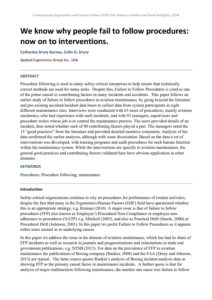
|
Author
Catherine Drury Barnes, Colin G. Drury |
Abstract
Procedure following is used in many safety-critical enterprises to help ensure that technically correct methods are used for many tasks. Despite this, Failure to Follow Procedures is cited as one of the prime causal or contributing factors in many incidents and accidents. This paper follows an earlier study of failure to follow procedures in aviation maintenance, by going beyond the literature and pre-existing accident/incident data bases to collect data from system participants in eight different maintenance sites. Interviews were conducted with 63 users of procedures, mainly aviation mechanics, who had experience with such incidents, and with 92 managers, supervisors and procedure writes whose job is to control the maintenance process. The users provided details of an incident, then noted whether each of 90 contributing factors played a part. The managers rated the 15 “good practices” from the literature and provided detailed narrative comments. Analysis of the data confirmed the earlier analyses, although with some dissociation. Based on the data a set of interventions was developed, with training programs and audit procedures for each human function within the maintenance system. While the interventions are specific to aviation maintenance, the general good practices and contributing factors validated here have obvious application in other domains. |
Publish Date: Mar 24, 2019 | Keywords: Contemporary EHF 2016, Equality, diversity & inclusion (EDI), Publications, Technology
| Document
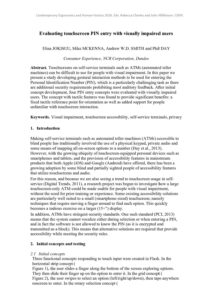
|
Author
Elina JOKISUU, Mike MCKENNA, Andrew W.D. SMITH and Phil DAY |
Abstract
Touchscreens on self-service terminals such as ATMs (automated teller machines) can be difficult to use for people with visual impairment. In this paper we present a study developing gestural interaction methods to be used for entering the Personal Identification Number (PIN), which is a particularly challenging task as there are additional security requirements prohibiting most auditory feedback. After initial concept development, four PIN entry concepts were evaluated with visually impaired users. The concept with tactile features was found to provide significant benefits: a fixed tactile reference point for orientation as well as added support for people unfamiliar with touchscreen interaction. |
Publish Date: Jun 11, 2025 | Keywords: Contemporary EHF 2025, Publications, Technology, Usability
| Document
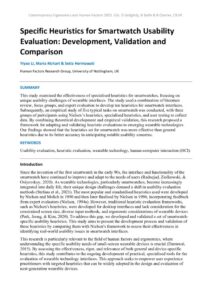
|
Author
Yiyao Li, Maria Richart & Setia Hermawati |
Abstract
This study examined the effectiveness of specialised heuristics for smartwatches, focusing on unique usability challenges of wearable interfaces. The study used a combination of literature review, focus groups, and expert evaluation to develop ten heuristics for smartwatch interfaces. Subsequently, an empirical study of five typical tasks on smartwatch was conducted, with three groups of participants using Nielsen’s heuristics, specialised heuristics, and user testing to collect data. By combining theoretical development and empirical validation, this research proposed a framework for adapting and validating heuristic evaluations to emerging wearable technologies. Our findings showed that the heuristics set for smartwatch was more effective than general heuristics due to its better accuracy in anticipating notable usability concerns. |
Publish Date: Mar 17, 2019 | Keywords: Construction, Contemporary EHF 2016, Health & Safety, Publications, Resilience
| Document
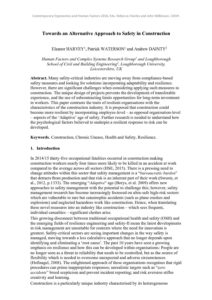
|
Author
Eleanor HARVEY, Patrick WATERSON and Andrew DAINTY |
Abstract
Many safety-critical industries are moving away from compliance-based safety measures and looking for solutions incorporating adaptability and resilience. However, there are significant challenges when considering applying such measures to construction. The unique design of projects prevents the development of transferable experience, and the use of subcontracting limits opportunities for long-term investment in workers. This paper contrasts the traits of resilient organisations with the characteristics of the construction industry. It is proposed that construction could become more resilient by incorporating employee-level – as opposed organisation-level – aspects of the ‘Adaptive’ age of safety. Further research is needed to understand how the psychological factors believed to underpin a resilient response to risk can be developed. |
Publish Date: Mar 24, 2019 | Keywords: Accessibility, Anthropometry, Contemporary EHF 2016, Publications
| Document
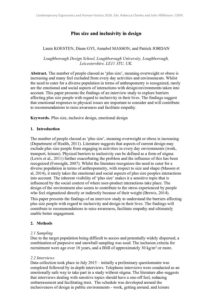
|
Author
Laura KOESTEN, Diane GYI, Annabel MASSON, and Patrick JORDAN |
Abstract
The number of people classed as ‘plus size’, meaning overweight or obese is increasing and many feel excluded from every day activities and environments. Whilst the need to cater for a diverse population in terms of anthropometry is recognized, rarely are the emotional and social aspects of interactions with design/environments taken into account. This paper presents the findings of an interview study to explore barriers affecting plus size people with regard to inclusivity in their lives. The findings suggest that emotional responses to physical issues are important to consider and will contribute to recommendations to raise awareness and facilitate empathy. |
Publish Date: Mar 25, 2019 | Keywords: Communication, Contemporary EHF 2016, Publications, Rail
| Document
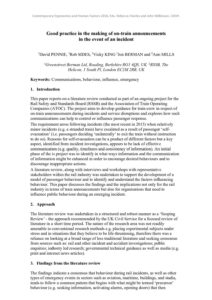
|
Author
David PENNIE, Rob SIDES, Vicky KING, Jon BERMAN and Ann MILLS |
Abstract
|
Publish Date: Jun 23, 2022 | Keywords: Contemporary EHF 2022, Decision making, Defence, Publications, Teamwork
| Document
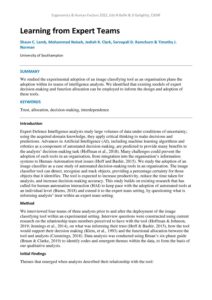
|
Author
Shaun C. Lamb, Mohammad Naiseh, Jediah R. Clark, Sarvapali D. Ramchurn & Timothy J. Norman |
Abstract
We studied the experimental adoption of an image classifying tool as an organisation plans the adoption within its teams of intelligence analysts. We identified that existing models of expert decision-making and function allocation can be employed to inform the design and adoption of these tools. |
Publish Date: Jun 3, 2024 | Keywords: Communication, Contemporary EHF 2024, Occupational health, Publications, Safety
| Document
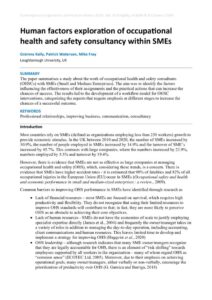
|
Author
Grainne Kelly, Patrick Waterson, Mike Fray |
Abstract
The paper summarises a study about the work of occupational health and safety consultants (OHSCs) with SMEs (Small and Medium Enterprises). The aim was to identify the factors influencing the effectiveness of their assignments and the practical actions that can increase the chances of success. The results led to the development of a workflow model for OHSC interventions, categorizing the aspects that require emphasis at different stages to increase the chances of a successful outcome. |
Publish Date: May 23, 2025 | Keywords: Aviation, Contemporary EHF 2025, Publications, Situation awareness, Teamwork
| Document
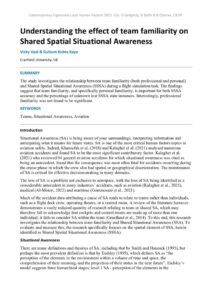
|
Author
Vicky Veal & Gulsum Kubra Kaya |
Abstract
The study investigates the relationship between team familiarity (both professional and personal) and Shared Spatial Situational Awareness (SSSA) during a flight simulation task. The findings suggest that team familiarity, and specifically personal familiarity, is important for both SSSA accuracy and the percentage of unknown lost SSSA state instances. Interestingly, professional familiarity was not found to be significant. |
Publish Date: Jun 23, 2022 | Keywords: Automation, Automotive, Contemporary EHF 2022, Publications, Road safety
| Document
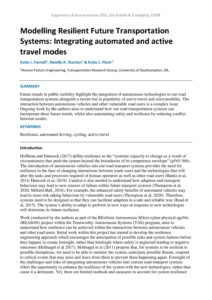
|
Author
Katie J. Parnell, Neville A. Stanton & Katie L. Plant |
Abstract
Future trends in public mobility highlight the integration of autonomous technologies to our road transportation systems alongside a recent rise in popularity of active travel and micromobility. The interaction between autonomous vehicles and other vulnerable road users is a complex issue. Ongoing work by the authors aims to understand how our road transportation systems can incorporate these future trends, whilst also maintaining safety and resilience by reducing conflict between modes. |
Publish Date: Jun 3, 2024 | Keywords: Contemporary EHF 2024, Decision making, Design, Maritime, Publications, Technology
| Document
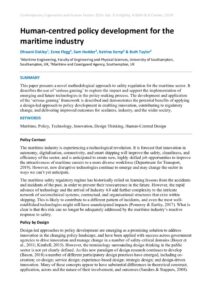
|
Author
Dhwani Oakley, Esme Flegg, Sam Hodder, Katrina Kemp & Ruth Taylor |
Abstract
This paper presents a novel methodological approach to safety regulation for the maritime sector. It describes the use of ‘serious gaming’ to explore the impact and support the implementation of emerging and future technologies in the policy-making process. The development and application of the ‘serious gaming’ framework is described and demonstrates the potential benefits of applying a design-led approach to policy development in enabling innovation, contributing to regulatory change, and delivering improved outcomes for seafarers, industry, and the wider society. |
Publish Date: Oct 23, 2018 | Keywords: Contemporary EHF 2018, Publications, Technology, User centred design
| Document
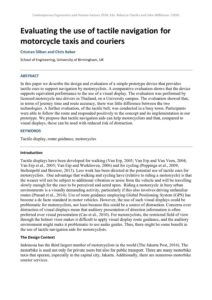
|
Author
Crisman Silban and Chris Baber |
Abstract
In this paper we describe the design and evaluation of a simple prototype device that provides tactile cues to support navigation by motorcyclists. A comparative evaluation shows that the device supports equivalent performance to the use of a visual display. The evaluation was performed by licensed motorcycle taxi drivers in Thailand, on a University campus. The evaluation showed that, in terms of journey time and route accuracy, there was little difference between the two technologies. A further evaluation, of the tactile belt, was conducted in a busy town. Participants were able to follow the route and responded positively to the concept and its implementation in our prototype. We propose that tactile navigation aids can help motorcyclists and that, compared to visual displays, these can be used with reduced risk of distraction. |
Publish Date: Jun 11, 2025 | Keywords: Autonomous vehicles, Comfort, Contemporary EHF 2025, Publications, Transport
| Document
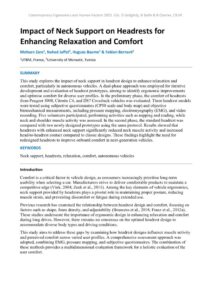
|
Author
Mohsen Zare, Nahed Jaffel, Hugues Baume & Fabien Bernard |
Abstract
This study explores the impact of neck support in headrest design to enhance relaxation and comfort, particularly in autonomous vehicles. A dual-phase approach was employed for iterative development and evaluation of headrest prototypes, aiming to identify ergonomic improvements and optimise comfort for diverse user profiles. In the preliminary phase, the comfort of headrests from Peugeot 3008, Citroën C4, and DS7 Crossback vehicles was evaluated. Three headrest models were tested using subjective questionnaires (CP50 scale and body map) and objective biomechanical measurements, including pressure mapping, electromyography (EMG), and video recording. Five volunteers participated, performing activities such as napping and reading, while neck and shoulder muscle activity was assessed. In the second phase, the standard headrest was compared with two newly designed prototypes using the same protocol. Results showed that headrests with enhanced neck support significantly reduced neck muscle activity and increased head-to-headrest contact compared to classic designs. These findings highlight the need for redesigned headrests to improve onboard comfort in next-generation vehicles. |
Publish Date: Sep 7, 2019 | Keywords: Contemporary EHF 2019, Publications, Resilience, Tools & techniques
| Document
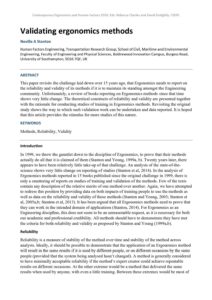
|
Author
Neville A Stanton |
Abstract
This paper revisits the challenge laid down over 15 years ago, that Ergonomics needs to report on the reliability and validity of its methods if it is to maintain its standing amongst the Engineering community. Unfortunately, a review of books reporting on Ergonomics methods since that time shows very little change. The theoretical constructs of reliability and validity are presented together with the rationale for conducting studies of training in Ergonomics methods. Revisiting the original study shows the way in which such validation work can be undertaken and data reported. It is hoped that this article provides the stimulus for more studies of this nature. |
Publish Date: Jun 23, 2022 | Keywords: Contemporary EHF 2022, Healthcare, Publications, Risk assessment, Tools & techniques
| Document
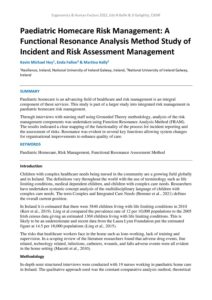
|
Author
Kevin Michael Hoy, Enda Fallon & Martina Kelly |
Abstract
Paediatric homecare is an advancing field of healthcare and risk management is an integral component of these services. This study is part of a larger study into integrated risk management in paediatric homecare risk management. Through interviews with nursing staff using Grounded Theory methodology, analysis of the risk management components was undertaken using Function Resonance Analysis Method (FRAM). The results indicated a clear mapping of the functionality of the process for incident reporting and the assessment of risks. Resonance was evident in several key functions allowing system changes for organisational improvements to enhance quality of care. KEYWORDS |
Publish Date: Apr 9, 2020 | Keywords: Automation, Cognition, Communication, Contemporary EHF 2020, Interface design, Publications
| Document
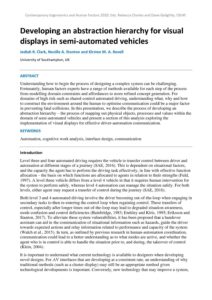
|
Author
Jediah R. Clark, Neville A. Stanton and Kirsten M. A. Revell |
Abstract
Understanding how to begin the process of designing a complex system can be challenging. Fortunately, human factors experts have a range of methods available for each step of the process from modelling domain constraints and affordances to more refined concept generation. For domains of high risk such as shared-control automated driving, understanding what, why and how to construct the environment around the human to optimise communication could be a major factor in preventing fatal collisions. In this presentation, we describe the process of developing an abstraction hierarchy – the process of mapping out physical objects, processes and values within the domain of semi-automated vehicles and present a section of this analysis exploring the implementation of visual displays for effective driver-automation communication. |
Publish Date: May 30, 2024 | Keywords: Contemporary EHF 2024, Data, Publications
| Document
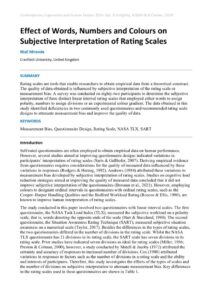
|
Author
Niall Miranda |
Abstract
Rating scales are tools that enable researchers to obtain empirical data from a theoretical construct. The quality of data obtained is influenced by subjective interpretation of the rating scale or measurement bias. A survey was conducted on eighty-two participants to determine the subjective interpretation of three distinct linear interval rating scales that employed either words to assign polarity, numbers to assign divisions or an experimental colour gradient. The data obtained in this study identified deficiencies in two commonly used questionnaires and recommended rating scale designs to attenuate measurement bias and improve the quality of data. |
Publish Date: Jun 3, 2024 | Keywords: Aviation, Contemporary EHF 2024, Publications, Systems, Workload
| Document
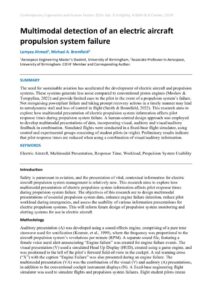
|
Author
Lamyea Ahmed, Michael A. Bromfield |
Abstract
The need for sustainable aviation has accelerated the development of electric aircraft and propulsion systems. These systems generate less noise compared to conventional piston engines (Moshov & Toropylina, 2022) and provide limited cues to the pilot in the event of a propulsion system’s failure. Not recognising powerplant failure and taking prompt recovery actions in a timely manner may lead to aerodynamic stall and loss of control in flight (Smith & Bromfield, 2022). This research aims to explore how multimodal presentation of electric propulsion system information affects pilot response times during propulsion system failure. A human-centred design approach was employed to develop multimodal presentations of data, incorporating visual, auditory and visual/auditory feedback in combination. Simulated flights were conducted in a fixed-base flight simulator, using control and experimental groups consisting of student pilots (n=eight). Preliminary results indicate that pilot response times are reduced when using a combination of visual/auditory information. |
Publish Date: Jun 23, 2022 | Keywords: Contemporary EHF 2022, Healthcare, Patient Safety, Publications
| Document
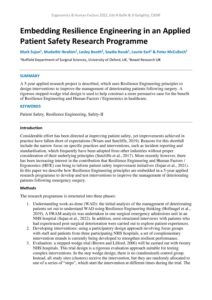
|
Author
Mark Sujan, Mudathir Ibrahim, Lesley Booth, Saydia Razak, Laurie Earl & Peter McCulloch |
Abstract
A 5-year applied research project is described, which uses Resilience Engineering principles to design interventions to improve the management of deteriorating patients following surgery. A rigorous stepped-wedge trial design is used to help construct a more persuasive case for the benefit of Resilience Engineering and Human Factors / Ergonomics in healthcare. |
Publish Date: Jun 3, 2024 | Keywords: Contemporary EHF 2024, Human factors integration, Nuclear, Publications, Safety
| Document
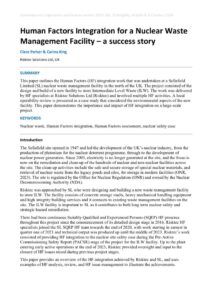
|
Author
Clare Parker & Carina King |
Abstract
This paper outlines the Human Factors (HF) integration work that was undertaken at a Sellafield Limited (SL) nuclear waste management facility in the north of the UK. The project consisted of the design and build of a new facility to store Intermediate Level Waste (ILW). The work was delivered by HF specialists at Risktec Solutions Ltd (Risktec) and involved multiple HF activities. A local operability review is presented as a case study that considered the environmental aspects of the new facility. This paper demonstrates the importance and impact of HF integration on a large-scale project. |
Publish Date: Apr 9, 2020 | Keywords: Contemporary EHF 2020, Decision making, Publications, Teamwork, Technology
| Document
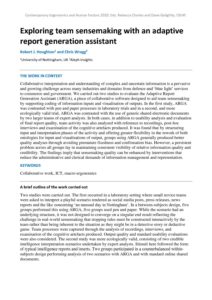
|
Author
Robert J. Houghton and Chris Wragg |
Abstract
Collaborative interpretation and understanding of complex and uncertain information is a pervasive and growing challenge across many industries and domains from defence and ‘blue light’ services to commerce and government. We carried out two studies to evaluate the Adaptive Report Generation Assistant (ARGA), a piece of collaborative software designed to aid team sensemaking by supporting coding of information inputs and visualisation of outputs. In the first study, ARGA was contrasted with pen and paper processes in laboratory trials and in a second, and more ecologically valid trial, ARGA was contrasted with the use of generic shared electronic documents by two larger teams of expert analysts. In both cases, in addition to usability analysis and evaluation of final report quality, team activity was also analysed with reference to recordings, post-hoc interviews and examination of the cognitive artefacts produced. It was found that by structuring input and interpretation phases of the activity and offering greater flexibility in the rework of both ontologies for input and visualisations of output, groups using ARGA generally produced better quality analyses through avoiding premature fixedness and confirmation bias. However, a persistent problem across all groups lay in maintaining consistent visibility of relative information quality and credibility. The findings imply that sensemaking quality can be enhanced by interventions that reduce the administrative and clerical demands of information management and representation. |
Publish Date: Feb 27, 2019 | Keywords: Contemporary EHF 2016, Healthcare, Patient Safety, Publications
| Document
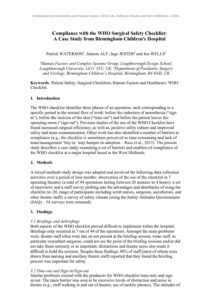
|
Author
Patrick WATERSON, Saleem ALI, Ingo JESTER and Jon WELLS |
Abstract
|
Publish Date: Mar 24, 2019 | Keywords: Contemporary EHF 2016, Healthcare, Publications, Resilience
| Document
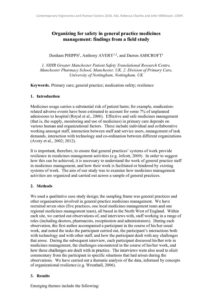
|
Author
Denham PHIPPS, Anthony AVERY, and Darren ASHCROFT |
Abstract
|
Publish Date: Oct 22, 2018 | Keywords: Automation, Contemporary EHF 2018, Publications, Technology
| Document
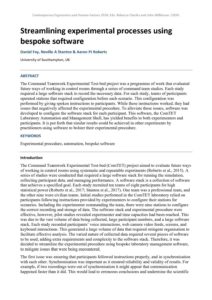
|
Author
Daniel Fay, Neville A Stanton & Aaron PJ Roberts |
Abstract
The Command Teamwork Experimental Test-bed project was a programme of work that evaluated future ways of working in control rooms through a series of command team studies. Each study required a large software stack to record the necessary data. For each study, teams of participants operated stations that required configuration before each scenario. This configuration was performed by giving spoken instructions to participants. While these instructions worked, they had issues that negatively affected the experimental procedure. To alleviate these issues, software was developed to configure the software stack for each participant. This software, the ComTET Laboratory Automation and Management Shell, has yielded benefits to both experimenters and participants. It is put forth that similar results could be achieved in other experiments by practitioners using software to bolster their experimental procedure. |
Publish Date: May 23, 2025 | Keywords: Artificial intelligence, Aviation, Contemporary EHF 2025, Design, Publications
| Document
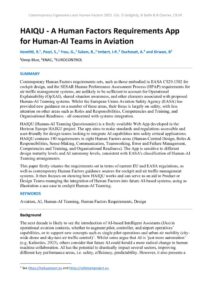
|
Author
Venditti, R., Pozzi, S., Frau, G., Salam, R., Imbert, J-P., Duchevet, A and Kirwan, B |
Abstract
Contemporary Human Factors requirements sets, such as those embodied in EASA CS29.1302 for cockpit design, and the SESAR Human Performance Assessment Process (HPAP) requirements for air traffic management systems, are unlikely to be sufficient to account for Operational Explainability (OpXAI), shared situation awareness, and other elements associated with proposed Human-AI Teaming systems. Whilst the European Union Aviation Safety Agency (EASA) has provided new guidance on a number of these areas, their focus is largely on safety, with less attention on other areas such as Roles and Responsibilities, Competencies and Training, and Organisational Readiness - all concerned with systems integration. HAIQU (Human-AI Teaming Questionnaire) is a freely available Web App developed in the Horizon Europe HAIKU project. The app aims to make standards and regulations accessible and user-friendly for design teams looking to integrate AI capabilities into safety critical applications. HAIQU contains 180 requirements in eight Human Factors areas (Human-Centred Design, Roles & Responsibilities, Sense-Making, Communication, Teamworking, Error and Failure Management, Competencies and Training, and Organisational Readiness). The App is sensitive to different design maturity levels and AI autonomy levels, consistent with EASA's classification of Human-AI Teaming arrangements. This paper firstly situates the requirements set in terms of current EU and EASA regulations, as well as contemporary Human Factors guidance sources for cockpit and air traffic management systems. It then focuses on showing how HAIQU works and can serve as an aid to Product or Design Teams managing the integration of Human Factors into future AI-based systems, using as illustration a use case in cockpit Human-AI Teaming. |
Publish Date: Apr 9, 2021 | Keywords: Aviation, Contemporary EHF 2021, Interface design, Publications, Transport
| Document
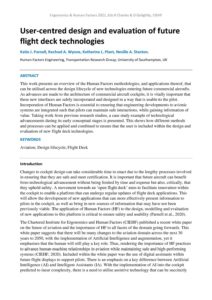
|
Author
Katie J. Parnell, Rachael A. Wynne, Katherine L. Plant, Neville A. Stanton |
Abstract
This work presents an overview of the Human Factors methodologies, and applications thereof, that can be utilised across the design lifecycle of new technologies entering future commercial aircrafts. As advances are made to the architecture of commercial aircraft cockpits, it is vitally important that these new interfaces are safely incorporated and designed in a way that is usable to the pilot. Incorporation of Human Factors is essential to ensuring that engineering developments to avionic systems are integrated such that pilots can maintain safe interactions, while gaining information of value. Taking work from previous research studies, a case study example of technological advancements during its early conceptual stages is presented. This shows how different methods and processes can be applied and combined to ensure that the user is included within the design and evaluation of new flight deck technologies. |
Publish Date: Dec 17, 2018 | Keywords: Aviation, Contemporary EHF 2017, Defence, Publications, Safety culture
| Document
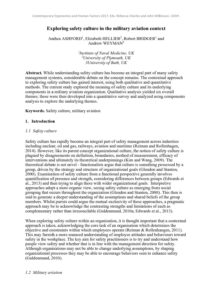
|
Author
Anthea ASHFORD, Elizabeth HELLIER, Robert BRIDGER and Andrew WEYMAN |
Abstract
While understanding safety culture has become an integral part of many safety management systems, considerable debate on the concept remains. The contextual approach to exploring safety culture has gained interest, using both qualitative and quantitative methods. The current study explored the meaning of safety culture and its underlying components in a military aviation organization. Qualitative analysis yielded six overall themes; these were then developed into a quantitative survey and analyzed using components analysis to explore the underlying themes. |
Publish Date: Jun 3, 2024 | Keywords: Contemporary EHF 2024, Health & Safety, Human factors integration, Publications, Systems
| Document
Insert here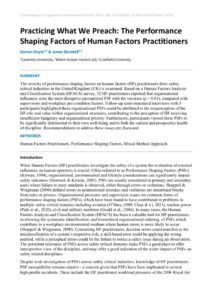 |
Author
Darren Doyle, & James Blundell |
Abstract
The severity of performance shaping factors on human factors (HF) practitioners from safety critical industries in the United Kingdom (UK) is examined. Based on a Human Factors Analysis and Classification System (HFACS) survey, 32 HF practitioners reported that organisational influences were the most disruptive encountered PSF with the vocation (p < 0.01), compared with supervisory and workplace pre-condition factors. Follow-up semi-structured interviews with 5 participants highlighted these organisational PSFs could be attributed to the misperception of the HF role and value within organisational structures, contributing to the perception of HF receiving insufficient budgetary and organisational priority. Furthermore, participants viewed these PSFs to be significantly detrimental to their own well-being and to both the current and prospective health of discipline. Recommendations to address these issues are discussed. |
Publish Date: Apr 17, 2020 | Keywords: Contemporary EHF 2020, Fatigue & sleep, Healthcare, Musculoskeletal, Publications
| Document
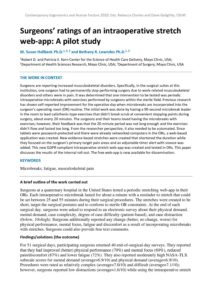
|
Author
M. Susan Hallbeck Ph.D and Bethany R. Lowndes Ph.D |
Abstract
Surgeons are reporting increased musculoskeletal disorders. Specifically, in the surgical suites at this institution, one surgeon had to permanently stop performing surgery due to work-related musculoskeletal disorders and others were in pain. It was determined that one intervention to be tested was periodic intraoperative microbreaks with exercises performed by surgeons within the sterile field. Previous research has shown self-reported improvement for the operative day when microbreaks are incorporated into the surgeon’s operating room (OR) routine. The initial work was done by having a 90-second microbreak leader in the room to lead calisthenic-type exercises that didn’t break scrub at convenient stopping points during surgery, about every 20 minutes. The surgeons and their teams loved having the microbreaks with exercises; however, their feedback was that the 20-minute period was not long enough and the exercises didn’t flow and lasted too long. From the researcher perspective, it also needed to be automated. Since tablets were password-protected and there were already networked computers in the ORs, a web-based application was created. New evidence-based stretches were created that shortened the duration while they focused on the surgeon’s primary target pain areas and an adjustable timer alert with snooze was added. This new GDPR compliant intraoperative stretch web-app was created and tested in ORs. This paper discusses the results of the internal roll-out. The free web-app is now available for dissemination. |
Publish Date: Apr 16, 2020 | Keywords: Contemporary EHF 2020, Defence, Publications, Submarines, Teamwork, Tools & techniques
| Document
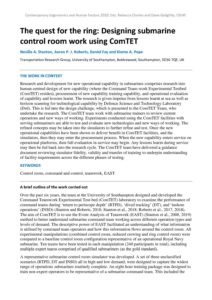
|
Author
Neville A. Stanton, Aaron P. J. Roberts, Daniel Fay and Kiome A. Pope |
Abstract
Research and development for new operational capability in submarines comprises research into human centred design of new capability (where the Command Team-work Experimental Testbed (ComTET) resides), procurement of new capability training capability, and operational evaluation of capability and lessons learnt. The research is given impetus from lessons learnt at sea as well as horizon scanning for technological capability by Defence Science and Technology Laboratory (Dstl). This is fed into the design challenge, which is presented to the ComTET Team, who undertake the research. The ComTET team work with submarine trainers to review current operations and new ways of working. Experiments conducted using the ComTET facilities with serving submariners are able to test and evaluate new technologies and new ways of working. The refined concepts may be taken into the simulators to further refine and test. Once the new operational capabilities have been shown to deliver benefit in ComTET facilities, and the simulators, then they may enter the procurement process. When the new capability enters service on operational platforms, then full evaluation in-service may begin. Any lessons learnt during service may then be fed back into the research cycle. The ComTET team have delivered a guidance document reviewing simulator fidelity, validity and transfer of training to underpin understanding of facility requirements across the different phases of testing. |
Publish Date: Oct 23, 2018 | Keywords: Contemporary EHF 2018, Interface design, Publications, Technology, User centred design
| Document
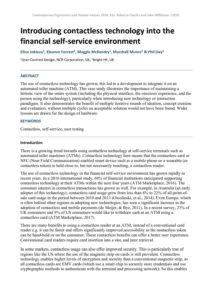
|
Author
Elina Jokisuu, Eleanor Forrest, Maggie McKendry, Marshall Munro & Phil Day |
Abstract
The use of contactless technology has grown; this led to a development to integrate it on an automated teller machine (ATM). This case study illustrates the importance of maintaining a holistic view of the entire system (including the physical interface, the onscreen experience, and the person using the technology), particularly when introducing new technology or interaction paradigms. It also demonstrates the benefit of multiple iterative rounds of ideation, concept creation and evaluation; without multiple cycles an acceptable solution would not have been found. Wider lessons are drawn for the design of hardware. |
Publish Date: Apr 15, 2020 | Keywords: Contemporary EHF 2020, Leadership, Manufacturing, Publications
| Document
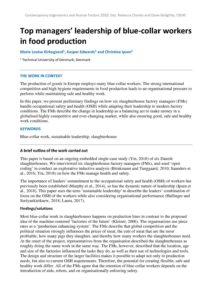
|
Author
Marie Louise Kirkegaard, Kasper Edwards and Christine Ipsen |
Abstract
The production of goods in Europe employs many blue-collar workers. The strong international competition and high hygiene requirements in food production leads to an organisational pressure to perform while maintaining safe and healthy work. In this paper, we present preliminary findings on how six slaughterhouse factory managers (FMs) handle occupational safety and health (OSH) while adapting their leadership to modern factory conditions. The FMs describe the change in leadership as a balancing act to make money in a globalised highly competitive and ever-changing market, while also ensuring good, safe and healthy work conditions. |
Publish Date: Aug 12, 2021 | Keywords: Comfort, Comfort Congress 2021, Design, Publications, Rail, Seating
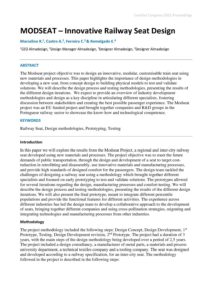 |
Author
Marcelino R., Castro A., Ferreira C. & Remelgado E. |
Abstract
The Modseat project objective was to design an innovative, modular, customisable train seat using new materials and processes. This paper highlights the importance of design methodologies in developing a new seat, from concept design to building physical models to test and validate solutions. We will describe the design process and testing methodologies, presenting the results of the different design iterations. We expect to provide an overview of industry development methodologies and design as a key discipline in articulating different specialists, fostering discussion between stakeholders and creating the best possible passenger experience. The Modseat project was an EU funded project and brought together companies and R&D groups in the Portuguese railway sector to showcase the know-how and technological competence. |
Publish Date: Jun 8, 2023 | Keywords: Aviation, Contemporary EHF 2023, Design, Human-machine interaction, Interface design, Publications, Workload
| Document
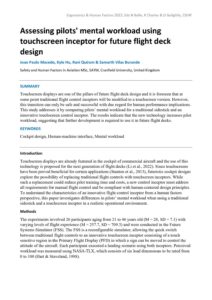
|
Author
Joao Paulo Macedo, Kyle Hu, Rani Quiram & Samarth Vilas Burande |
Abstract
Touchscreen displays are one of the pillars of future flight deck design and it is foreseen that at some point traditional flight control inceptors will be modified to a touchscreen version. However, this transition can only be safe and successful with due regard for human performance implications. This study addresses it by comparing pilots’ mental workload for a traditional sidestick and an innovative touchscreen control inceptor. The results indicate that the new technology increases pilot workload, suggesting that further development is required to use it in future flight decks. |
Publish Date: Jun 3, 2024 | Keywords: Aviation, Contemporary EHF 2024, Defence, Human factors integration, Incidents, Investigation, Publications, Safety
| Document
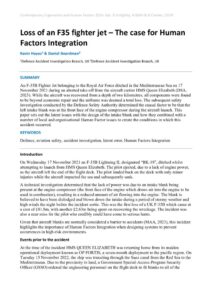
|
Author
Kevin Hayes & Daniel Boardman |
Abstract
An F-35B Fighter Jet belonging to the Royal Air Force ditched in the Mediterranean Sea on 17 November 2021 during an aborted take-off from the aircraft carrier HMS Queen Elizabeth (DSA, 2023). While the aircraft was recovered from a depth of two kilometres, all components were found to be beyond economic repair and the airframe was deemed a total loss. The subsequent safety investigation conducted by the Defence Safety Authority determined the causal factor to be that the left intake blank was at the front face of the engine compressor during the aircraft launch. This paper sets out the latent issues with the design of the intake blank and how they combined with a number of local and organisational Human Factor issues to create the conditions in which this accident occurred. |
Publish Date: Jun 11, 2025 | Keywords: Contemporary EHF 2025, Healthcare, Human factors integration, Incidents, Publications, Tools & techniques
| Document
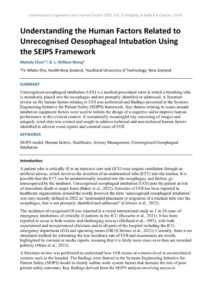
|
Author
Melody CheN, B. L. William Wong |
Abstract
Unrecognised oesophageal intubation (UOI) is a medical procedural error in which a breathing tube is mistakenly placed into the oesophagus and not promptly identified or addressed. A literature review on the human factors relating to UOI was performed and findings presented in the Systems Engineering Initiative for Patient Safety (SEIPS) framework. Key themes relating to issues around intubation equipment factors were used to inform the design of a cognitive aid to improve human performance in this clinical context. A semantically meaningful tray consisting of images and uniquely sized slots was created and sought to address technical and non-technical human factors identified in adverse event reports and coronial cases of UOI. |
Publish Date: Dec 18, 2018 | Keywords: Contemporary EHF 2017, Human performance, Publications, Rail
| Document
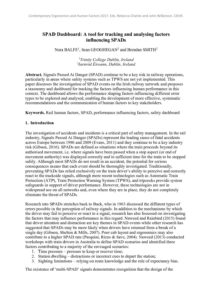
|
Author
Nora BALFE, Sean GEOGHEGAN and Brendan SMITH |
Abstract
Signals Passed At Danger (SPAD) continue to be a key risk in railway operations, particularly in areas where safety systems such as TPWS are not yet implemented. This paper discusses the investigation of SPAD events on the Irish railway network and proposes a taxonomy and dashboard for tracking the factors influencing human performance in this context. The dashboard allows the performance shaping factors influencing different error types to be explored and analysed, enabling the development of more effective, systematic recommendations and the communication of human factors to key stakeholders. |
Publish Date: Jun 11, 2025 | Keywords: Automotive, Contemporary EHF 2025, Publications, Systems, Technology
| Document
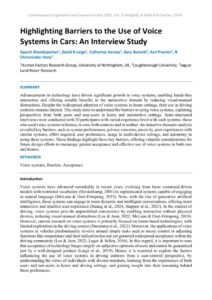
|
Author
Sparsh Khandeparker, David R Large, Catherine Harvey, Gary Burnett, Karl Proctor, & Chrisminder Hare |
Abstract
Advancements in technology have driven significant growth in voice systems, enabling hands-free interaction and offering notable benefits in the automotive domain by reducing visual-manual distractions. Despite the widespread adoption of voice systems in home settings, their use in driving contexts remains limited. This study aims to understand the barriers to using voice systems, exploring perspectives from both users and non-users in home and automotive settings. Semi-structured interviews were conducted with 20 participants with varied experience level with such systems- those who used voice systems in homes, in cars, both contexts and in neither. An inductive thematic analysis revealed key barriers, such as system performance, privacy concerns, passivity, past experiences with similar systems, effort required, user preferences, usage in multi-device settings, and autonomy in using these systems. These findings highlight these key barriers, offering valuable considerations for future design efforts to encourage greater acceptance and effective use of voice systems in both cars and homes. |
Publish Date: May 27, 2025 | Keywords: Communication, Contemporary EHF 2025, Publications, Safety, User centred design
| Document
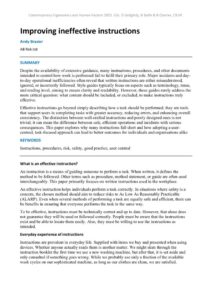
|
Author
Andy Brazier |
Abstract
Despite the availability of extensive guidance, many instructions, procedures, and other documents intended to control how work is performed fail to fulfil their primary role. Major incidents and day-to-day operational inefficiencies often reveal that written instructions are either misunderstood, ignored, or incorrectly followed. Style guides typically focus on aspects such as terminology, tense, and reading level, aiming to ensure clarity and readability. However, these guides rarely address the more critical question: what content should be included, or excluded, to make instructions truly effective. Effective instructions go beyond simply describing how a task should be performed; they are tools that support users in completing tasks with greater accuracy, reducing errors, and enhancing overall consistency. The distinction between well-crafted instructions and poorly designed ones is not trivial; it can mean the difference between safe, efficient operations and incidents with serious consequences. This paper explores why many instructions fall short and how adopting a user-centred, task-focused approach can lead to better outcomes for individuals and organisations alike |
Publish Date: Feb 27, 2019 | Keywords: Contemporary EHF 2016, Equality, diversity & inclusion (EDI), Publications, Systems
| Document
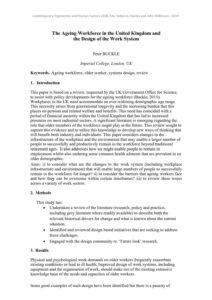
|
Author
Peter BUCKLE |
Abstract
|
Publish Date: Jun 8, 2023 | Keywords: Aviation, Contemporary EHF 2023, Human performance, Publications, Workload
| Document
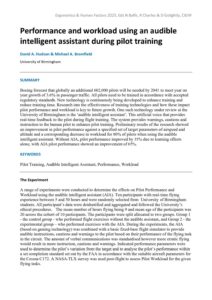
|
Author
David A. Hudson & Michael A. Bromfield |
Abstract
Boeing forecast that globally an additional 602,000 pilots will be needed by 2041 to meet year on year growth of 3.6% in passenger traffic. All pilots need to be trained in accordance with accepted regulatory standards. New technology is continuously being developed to enhance training and reduce training time. Research into the effectiveness of training technologies and how these impact pilot performance and workload is key to future growth. One such technology under review at the University of Birmingham is the ‘audible intelligent assistant’. This artificial voice that provides real-time feedback to the pilot during flight training. The system provides warnings, cautions and instruction to the human pilot to enhance pilot training. Preliminary results of the research showed an improvement in pilot performance against a specified set of target parameters of airspeed and altitude and a corresponding decrease in workload for 80% of pilots when using the audible intelligent assistant. Without AIA, pilot performance improved by 35% due to learning effects alone, with AIA pilot performance showed an improvement of 65%. |
Publish Date: Jun 3, 2024 | Keywords: Contemporary EHF 2024, Fatigue & sleep, Human performance, Publications, Systems
| Document
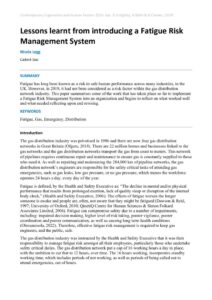
|
Author
Nicola Legg |
Abstract
Fatigue has long been known as a risk to safe human performance across many industries, in the UK. However, in 2019, it had not been considered as a risk factor within the gas distribution network industry. This paper summarises some of the work that has taken place so far to implement a Fatigue Risk Management System into an organisation and begins to reflect on what worked well and what needed reflecting upon and revising. |
Publish Date: Dec 17, 2018 | Keywords: Contemporary EHF 2017, Cybersecurity, Publications, Sociotechnical systems, Teamwork
| Document
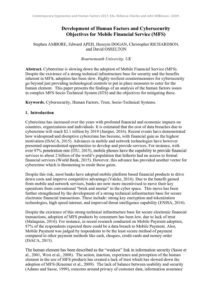
|
Author
Stephen AMBORE, Edward APEH, Huseyin DOGAN, Christopher RICHARDSON, and David OSSELTON |
Abstract
Cybercrime is slowing down the adoption of Mobile Financial Service (MFS). Despite the existence of a strong technical infrastructure base for security and the benefits inherent in MFS, adoption has been slow. Highly resilient countermeasures for cybersecurity go beyond just providing technological controls to put in place measures to cater for the human element. This paper presents the findings of an analysis of the human factors issues in complex MFS Socio-Technical System (STS) and the objectives for mitigating these. |
Publish Date: Sep 8, 2019 | Keywords: Artificial intelligence, Contemporary EHF 2019, Human-machine interaction, Publications, Tools & techniques
| Document
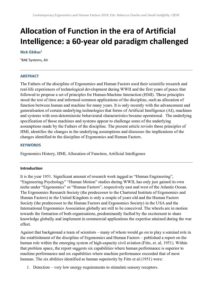
|
Author
Nick Gkikas |
Abstract
The Fathers of the discipline of Ergonomics and Human Factors used their scientific research and real-life experiences of technological development during WWII and the first years of peace that followed to propose a set of principles for Human-Machine Interaction (HMI). These principles stood the test of time and informed common applications of the discipline, such as allocation of function between human and machine for many years. It is only recently with the advancement and generalisation of certain underlying technologies that forms of Artificial Intelligence (AI), machines and systems with non-deterministic behavioural characteristics became operational. The underlying specification of those machines and systems appear to challenge some of the underlying assumptions made by the Fathers of the discipline. The present article revisits those principles of HMI, identifies the changes in the underlying assumptions and discusses the implications of the changes identified to the discipline of Ergonomics and Human Factors. |
Publish Date: May 30, 2024 | Keywords: Contemporary EHF 2024, Healthcare, Publications, Systems
| Document
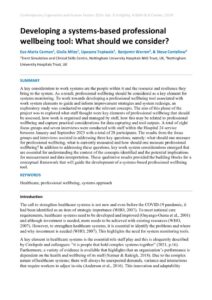
|
Author
Eva-Maria Carman, Giulia Miles, Upasana Topiwala, Benjamin Warren , & Steve Cantellow |
Abstract
A key consideration to work systems are the people within it and the resource and resilience they bring to the system. As a result, professional wellbeing should be considered as a key element for systems monitoring. To work towards developing a professional wellbeing tool associated with work system elements to guide and inform improvement strategies and system redesign, an exploratory study was conducted to capture the relevant concepts. The aim of this phase of the project was to explored what staff thought were key elements of professional wellbeing that should be assessed, how work is organised and managed by staff, how this may be related to professional wellbeing and capture practical considerations for data capturing and tool outputs. A total of eight focus groups and seven interviews were conducted with staff within the Hospital 24 service between January and September 2023 with a total of 28 participants. The results from the focus groups and interviews assisted in addressing three key questions, namely: what should one measure for professional wellbeing, what is currently measured and how should one measure professional wellbeing? In addition to addressing these questions, key work system considerations emerged that are essential for understanding the context of the concepts identified and the potential implications for measurement and data interpretation. These qualitative results provided the building blocks for a conceptual framework that will guide the development of a systems-based professional wellbeing tool. |
Publish Date: Apr 15, 2020 | Keywords: Contemporary EHF 2020, Design, Healthcare, Publications, Systems
| Document
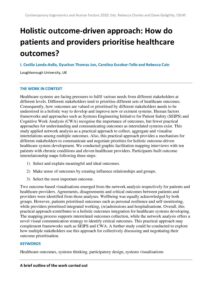
|
Author
I. Cecilia Landa-Avila, Gyuchan Thomas Jun, Carolina Escobar-Tello and Rebecca Cain |
Abstract
Healthcare systems are facing pressures to fulfil various needs from different stakeholders at different levels. Different stakeholders tend to prioritise different sets of healthcare outcomes. Consequently, how outcomes are valued or prioritised by different stakeholders needs to be understood in a holistic way to develop and improve new or existent systems. Human factors frameworks and approaches such as Systems Engineering Initiative for Patient Safety (SEIPS) and Cognitive Work Analysis (CWA) recognise the importance of outcomes, but fewer practical approaches for understanding and communicating outcomes as interrelated systems exist. This study applied network analysis as a practical approach to collect, aggregate and visualise interrelations among multiple outcomes. Also, this practical approach provides a mechanism for different stakeholders to communicate and negotiate priorities for holistic outcome-driven healthcare system development. We conducted graphic facilitation mapping interviews with ten patients with chronic conditions and eleven healthcare providers. Participants built outcome interrelationship maps following three steps: 1) Select and explain meaningful and ideal outcomes. 2) Make sense of outcomes by creating influence relationships and groups. 3) Select the most important outcome. Two outcome-based visualisations emerged from the network analysis respectively for patients and healthcare providers. Agreements, disagreements and critical outcomes between patients and providers were identified from those analyses. Wellbeing was equally acknowledged by both groups. However, patients prioritised outcomes such as personal resilience and self-monitoring, while providers prioritised integrated working, (re)admissions and hospitalisations. Overall, this practical approach contributes to a holistic outcomes integration for healthcare systems developing. The mapping process supports interrelated outcomes collection, while the network analysis offers a novel visual communication strategy to identify critical outcomes. This practical approach may complement frameworks such as SEIPS and CWA. A further study could be conducted to explore how multiple stakeholders use this approach for collectively discussing and negotiating their outcome prioritisation. |
Publish Date: Apr 15, 2020 | Keywords: Climate change, Contemporary EHF 2020, Human performance, Publications, Rail, Simulation
| Document
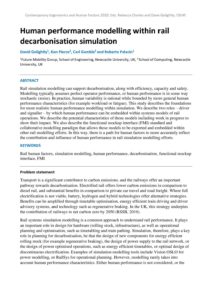
|
Author
David Golightly, Ken Pierce, Carl Gamble and Roberto Palacin |
Abstract
Rail simulation modelling can support decarbonisation, along with efficiency, capacity and safety. Modelling typically assumes perfect operator performance, or human performance is in some way stochastic (noise). In practice, human variability is rational while bounded by more general human performance characteristics (for example workload or fatigue). This study describes the foundations for more realistic human performance modelling within simulation. We describe two roles – driver and signaller – by which human performance can be embedded within systems models of rail operations. We describe the potential characteristics of those models including work in progress to show their impact. We also describe the functional mockup interface (FMI) standard and collaborative modelling paradigm that allows these models to be exported and embedded within other rail modelling efforts. In this way, there is a path for human factors to more accurately reflect the contribution and influence of human performance in rail simulation modelling efforts. |
Publish Date: Mar 26, 2019 | Keywords: Contemporary EHF 2016, Manufacturing, Publications
| Document
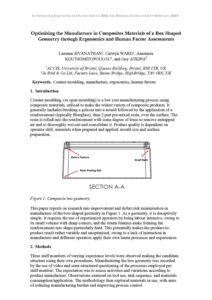
|
Author
Laxman SIVANATHAN, Carwyn WARD, Anastasia KOUTSOMITOPOULOU, and Guy ATKINS |
Abstract
|
Publish Date: Apr 9, 2020 | Keywords: Contemporary EHF 2020, Healthcare, Leadership, Publications, SEIPS, Systems
| Document
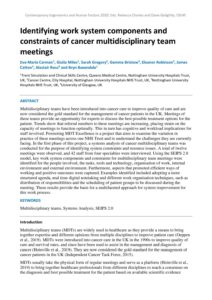
|
Author
Eva-Maria Carman, Giulia Miles, Sarah Gregory, Gemma Bristow, Eleanor Robinson, James Catton, Alastair Ross and Bryn Baxendale |
Abstract
Multidisciplinary teams have been introduced into cancer care to improve quality of care and are now considered the gold standard for the management of cancer patients in the UK. Meetings of these teams provide an opportunity for experts to discuss the best possible treatment options for the patient. Trends show that referral numbers to these meetings are increasing, placing strain on the capacity of meetings to function optimally. This in turn has cognitive and workload implications for staff involved. Promoting MDT Excellence is a project that aims to examine the variation in practice of these meetings across one NHS Trust and to understand the challenges they are currently facing. In the first phase of this project, a systems analysis of cancer multidisciplinary teams was conducted for the purpose of identifying system constraints and resource issues. A total of twelve meetings were observed, and 42 staff from four specialties were interviewed. Using the SEIPS 2.0 model, key work system components and constraints for multidisciplinary team meetings were identified for the people involved, the tasks, tools and technology, organisation of work, internal environment and external environment. Furthermore, aspects that promoted efficient ways of working and positive outcomes were captured. Examples identified included adopting a more structured agenda, real time digital notetaking and different work organisation techniques, such as distribution of responsibilities and the scheduling of patient groups to be discussed during the meeting. These results provide the basis for a multifaceted approach for system improvement for this work process. |
Publish Date: Aug 10, 2021 | Keywords: Aviation, Comfort, Comfort Congress 2021, Publications, Seating
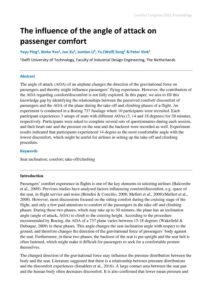 |
Author
Yayu Ping, Xinhe Yao, Jun Xu, Juntian Li, Yu (Wolf) Song & Peter Vink |
Abstract
The angle of attack (AOA) of an airplane changes the direction of the gravitational force on passengers and thereby might influence passengers’ flying experience. However, the contribution of the AOA regarding comfort/discomfort is not fully explored. In this paper, we aim to fill this knowledge gap by identifying the relationships between the perceived comfort/ discomfort of passengers and the AOA of the plane during the take-off and climbing phases of a flight. An experiment is conducted in a Boeing 737 fuselage where 10 participants were recruited. Each participant experiences 3 setups of seats with different AOAs (3, 14 and 18 degrees) for 20 minutes, respectively. Participants were asked to complete several sets of questionnaires during each session, and their heart rate and the pressure on the seat and the backrest were recorded as well. Experiment results indicated that participants experienced 14-degree as the most comfortable angle with the lowest discomfort, which might be useful for airlines in setting up the take-off and climbing procedure. |
Publish Date: May 30, 2024 | Keywords: Contemporary EHF 2024, Healthcare, Investigation, Publications, Safety
| Document
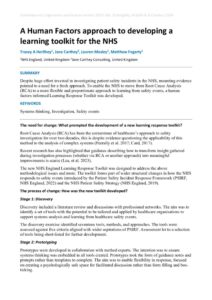
|
Author
Tracey A Herlihey, Jane Carthey, Lauren Mosley, Matthew Fogarty |
Abstract
Despite huge effort invested in investigating patient safety incidents in the NHS, mounting evidence pointed to a need for a fresh approach. To enable the NHS to move from Root Cause Analysis (RCA) to a more flexible and proportionate approach to learning from safety events, a human factors informed Learning Response Toolkit was developed. |
Publish Date: Aug 12, 2021 | Keywords: Comfort, Comfort Congress 2021, Education, training & skills, Publications
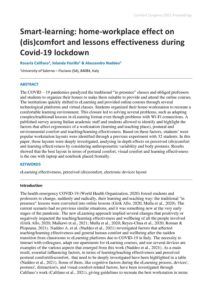 |
Author
Rosaria Califano, Iolanda Fiorillo & Alessandro Naddeo |
Abstract
The COVID – 19 pandemics paralyzed the traditional “in presence” classes and obliged professors and students to organize their homes to make them suitable to provide and attend the online courses. The institutions quickly shifted to eLearning and provided online courses through several technological platforms and virtual classes. Students organized their home-workstation to recreate a comfortable learning environment. This closure led to solving several problems, such as adapting complex/traditional lessons in eLearning format even though problems with Wi-Fi connections. A published survey among Italian academic staff and students allowed to identify and highlight the factors that affect ergonomics of a workstation (learning and teaching place), postural and environmental comfort and teaching/learning effectiveness. Based on these factors, students’ most popular workstation layouts were identified through a previous experiment with 32 students. In this paper, those layouts were deeply investigated, analysing in-depth effects on perceived (dis)comfort and learning effectiveness by considering anthropometric variability and body postures. Results showed that the best layout in terms of postural comfort, visual comfort and learning effectiveness is the one with laptop and notebook placed frontally. |
Publish Date: Jun 4, 2024 | Keywords: Contemporary EHF 2024, Human factors integration, Nuclear, Publications, Risk assessment
| Document
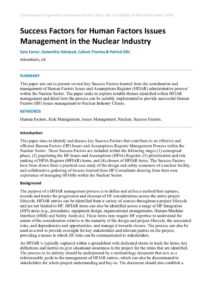
|
Author
Sam Farrar, Samantha Halstead, Callum Thomas & Patrick Ellis |
Abstract
This paper sets out to present several key Success Factors learned from the coordination and management of Human Factors Issues and Assumptions Register (HFIAR) administrative process’ within the Nuclear Sector. The paper seeks to explore notable themes identified within HFIAR management and detail how the process can be suitably implemented to provide successful Human Factors (HF) Issues management to Nuclear Industry Clients. |
Publish Date: Apr 9, 2021 | Keywords: Automotive, Contemporary EHF 2021, Publications, Safety, Transport
| Document
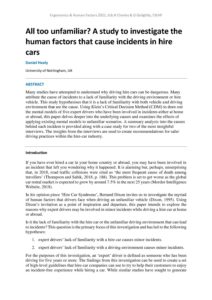
|
Author
Daniel Healy |
Abstract
Many studies have attempted to understand why driving hire cars can be dangerous. Many attribute the cause of incidents to a lack of familiarity with the driving environment or hire vehicle. This study hypothesises that it is a lack of familiarity with both vehicle and driving environment that are the cause. Using Klein’s Critical Decision Method (CDM) to draw out the mental models of five expert drivers who have been involved in incidents either at home or abroad, this paper delves deeper into the underlying causes and examines the effects of applying existing mental models to unfamiliar scenarios. A summary analysis into the causes behind each incident is provided along with a case study for two of the most insightful interviews. The insights from the interviews are used to create recommendations for safer driving practices within the hire-car industry. |
Publish Date: Mar 17, 2019 | Keywords: Contemporary EHF 2016, Publications, Rail, Safety culture
| Document
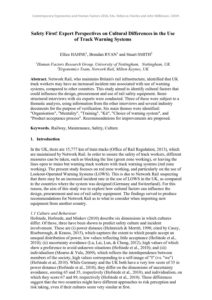
|
Author
Ellice HAHNE, Brendan RYAN and Stuart SMITH |
Abstract
Network Rail, who maintains Britain's rail infrastructure, identified that UK track workers may have an increased incident rate associated with use of warning systems, compared to other countries. This study aimed to identify cultural factors that could influence the design, procurement and use of rail safety equipment. Semi-structured interviews with six experts were conducted. Three of these were subject to a thematic analysis, using information from the other interviews and several industry documents for the purpose of verification. Six main themes were identified: "Organisation", "Mentality", "Training", "Kit", "Choice of warning system", and "Product acceptance process". Recommendations for improvements are proposed. |
Publish Date: Sep 8, 2019 | Keywords: Behaviour, Contemporary EHF 2019, Publications, Rail
| Document
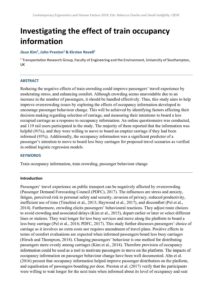
|
Author
Jisun Kim, John Preston & Kirsten Revell |
Abstract
Reducing the negative effects of train crowding could improve passengers’ travel experience by moderating stress, and enhancing comfort. Although crowding seems unavoidable due to an increase in the number of passengers, it should be handled effectively. Thus, this study aims to help improve overcrowding issues by exploring the effects of occupancy information developed to encourage passenger behaviour change. This will be achieved by identifying factors affecting their decision making regarding selection of carriage, and measuring their intentions to board a less occupied carriage as a response to occupancy information. An online questionnaire was conducted, and 119 rail users participated in the study. The majority of them reported that the information was helpful (91%), and they were willing to move to board an emptier carriage if they had been informed (93%). Additionally, the occupancy information was a significant predictor of a passenger’s intention to move to board less busy carriages for proposed travel scenarios as verified in ordinal logistic regression models. |
Publish Date: May 30, 2024 | Keywords: Automation, Contemporary EHF 2024, Publications
| Document
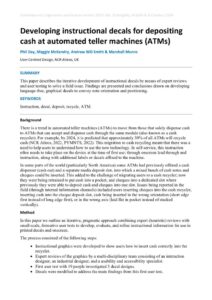
|
Author
Phil Day, Maggie McKendry, Andrew WD Smith & Marshall Munro |
Abstract
This paper describes the iterative development of instructional decals by means of expert reviews and user testing to solve a field issue. Findings are presented and conclusions drawn on developing language-free, graphical decals to convey note orientation and positioning. |
Publish Date: Jun 8, 2023 | Keywords: Contemporary EHF 2023, Publications, Technology
| Document
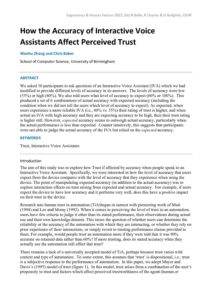
|
Author
Wenhu Zhang & Chris Baber |
Abstract
We asked 30 participants to ask questions of an Interactive Voice Assistant (IVA) which we had modified to provide different levels of accuracy in its answers. The levels of accuracy were low (55%) or high (80%). We also told users what level of accuracy to expect (60% or 100%). This produced a set of 6 combinations of actual accuracy with expected accuracy (including the condition when we did not tell the users which level of accuracy to expect). As expected, when users experience a more reliable IVA (i.e., 80% vs. 55%) their rating of trust is higher, and when actual an IVA with high accuracy and they are expecting accuracy to be high, then their trust rating is higher still. However, expected accuracy seems to outweigh actual accuracy, particularly when the actual performance is less than expected. Counter intuitively, this suggests that participants were not able to judge the actual accuracy of the IVA but relied on the expected accuracy. |
Publish Date: Jun 3, 2024 | Keywords: Automation, Automotive, Contemporary EHF 2024, Publications, Simulation
| Document
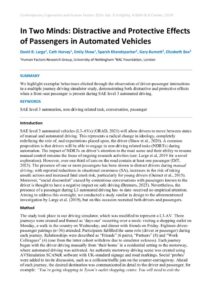
|
Author
David R. Large, Cath Harvey, Emily Shaw, Sparsh Khandeparker, Gary Burnett, Elizabeth Box |
Abstract
We highlight exemplar behaviours elicited through the observation of driver-passenger interactions in a multiple journey driving simulator study, demonstrating both distractive and protective effects when a front-seat passenger is present during SAE level 3 automated driving. |
Publish Date: May 23, 2025 | Keywords: Behaviour, Contemporary EHF 2025, Human performance, Publications, Road safety
| Document
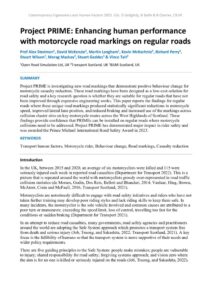
|
Author
Alex Stedmon, David McKenzie, Martin Langham, Kevin McKechnie, Richard Perry, Stuart Wlison, Morag Mackay, Stuart Geddes & Vince Tait |
Abstract
Project PRIME is investigating new road markings that demonstrate positive behaviour change for motorcycle casualty reduction. These road markings have been designed as a low-cost solution for road safety and a key research question is whether they are suitable for regular roads that have not been improved through expensive engineering works. This paper reports the findings for regular roads where these unique road markings produced statistically significant reductions in motorcycle speed, improved lateral lane position, and reduced braking and increased use of the markings across collision cluster sites on key motorcycle routes across the West Highlands of Scotland. These findings provide confidence that PRIMEs can be installed on regular roads where motorcycle collisions need to be addressed. Project PRIME has demonstrated major impact in rider safety and was awarded the Prince Michael International Road Safety Award in 2023. |
Publish Date: Jun 5, 2024 | Keywords: Contemporary EHF 2024, Healthcare, Publications, Safety
| Document
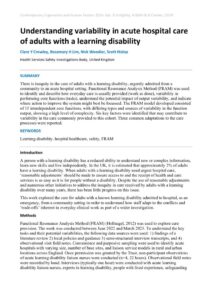
|
Author
Clare Y Crowley, Rosemary H Lim, Nick Woodier, Scott Hislop |
Abstract
There is inequity in the care of adults with a learning disability, urgently admitted from a community to an acute hospital setting. Functional Resonance Analysis Method (FRAM) was used to identify and describe how everyday care is usually provided (work as done), variability in performing core functions (tasks), understand the potential impact of output variability, and indicate where action to improve the system might best be focussed. The FRAM model developed consisted of 15 interdependent core functions, with differing types and sources of variability in the function output, showing a high level of complexity. Six key factors were identified that may contribute to variability in the care commonly provided to this cohort. Three common adaptations to the care processes were reported. |
Publish Date: May 23, 2025 | Keywords: Aviation, Contemporary EHF 2025, Publications, Safety, Workload
| Document
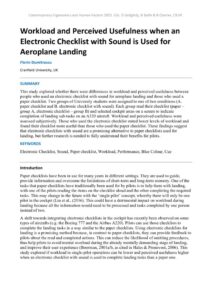
|
Author
Florin Dumitrascu |
Abstract
This study explored whether there were differences in workload and perceived usefulness between people who used an electronic checklist with sound for aeroplane landing and those who used a paper checklist. Two groups of University students were assigned to one of two conditions (A. paper checklist and B. electronic checklist with sound). Each group read their checklist (paper – group A, electronic checklist – group B) and selected cockpit areas on a screen to indicate completion of landing sub-tasks on an A320 aircraft. Workload and perceived usefulness were assessed subjectively. Those who used the electronic checklist stated lower levels of workload and found their checklist more useful than those who used the paper checklist. These findings suggest that electronic checklists with sound are a promising alternative to paper checklists used for landing, but further research is needed to fully understand their benefits for pilots. |
Publish Date: Apr 15, 2020 | Keywords: Artificial intelligence, Contemporary EHF 2020, Design, Publications, Sociotechnical systems
| Document
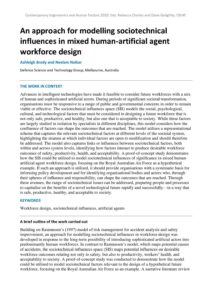
|
Author
Ashleigh Brady and Neelam Naikar |
Abstract
Advances in intelligent technologies have made it feasible to consider future workforces with a mix of human and sophisticated artificial actors. During periods of significant societal transformation, organisations must be responsive to a range of public and governmental concerns in order to remain viable or effective. The sociotechnical influences space (SIS) models the social, psychological, cultural, and technological factors that must be considered in designing a future workforce that is not only safe, productive, and healthy, but also one that is acceptable to society. While these factors are largely studied in isolation by specialists in different disciplines, this model considers how the confluence of factors can shape the outcomes that are reached. The model utilises a representational scheme that captures the relevant sociotechnical factors at different levels of the societal system, highlighting the stratum at which individual factors are open to modification and should therefore be addressed. The model also captures links or influences between sociotechnical factors, both within and across system levels, identifying how factors interact to produce desirable workforce outcomes of safety, productivity, health, and acceptability. A proof-of-concept study demonstrates how the SIS could be utilised to model sociotechnical influences of significance in mixed human-artificial agent workforce design, focusing on the Royal Australian Air Force as a hypothetical example. If such an approach is utilised, it should provide organisations with a systematic basis for informing policy development and for identifying organisational bodies and actors who, through their spheres of influence and responsibility, can shape the outcomes that are reached. Through these avenues, the range of sociotechnical issues can be addressed, preparing people and processes to capitalise on the benefits of a novel technological future rapidly and successfully—in a way that is safe, productive, healthy, and acceptable to society. |
Publish Date: Jun 11, 2025 | Keywords: Contemporary EHF 2025, Healthcare, Investigation, Publications, Safety
| Document
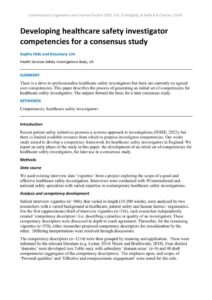
|
Author
Sophie Hide and Rosemary Lim |
Abstract
There is a drive to professionalise healthcare safety investigators but there are currently no agreed core competencies. This paper describes the process of generating an initial set of competencies for healthcare safety investigators. The outputs formed the basis for a later consensus study. |
Publish Date: Jun 3, 2024 | Keywords: Contemporary EHF 2024, Human factors integration, Publications, Risk assessment, Task analysis
| Document
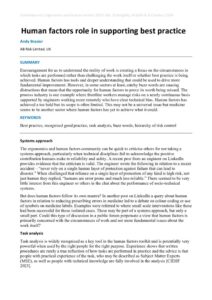
|
Author
Andy Brazier |
Abstract
Encouragement for us to understand the reality of work is creating a focus on the circumstances in which tasks are performed rather than challenging the work itself or whether best practice is being achieved. Human factors has tools and deeper understanding that could be used to drive more fundamental improvement. However, in some sectors at least, catchy buzz words are causing distractions that mean that the opportunity for human factors to prove its worth being missed. The process industry is one example where frontline workers manage risks on a nearly continuous basis supported by engineers working more remotely who have clear technical bias. Human factors has achieved a toe hold but its scope is often limited. This may not be a universal issue but medicine seems to be another sector where human factors has yet to achieve what it could. |
Publish Date: Jun 24, 2022 | Keywords: Anthropometry, Contemporary EHF 2022, Musculoskeletal, Publications
| Document
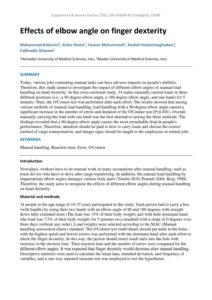
|
Author
Mohammad Babamiri, Elahe Oveisi, Younes Mohammadi, Rashid Heidarimoghadam & Fakhradin Ghasem |
Abstract
Today, various jobs containing manual tasks can have adverse impacts on people's abilities. Therefore, this study aimed to investigate the impact of different elbow angles of manual load handling on hand dexterity. In this cross-sectional study, 34 males manually carried loads in three different positions (i.e., a 90-degree elbow angle, a 180-degree elbow angle, and one hand) for 5 minutes. Then, the O'Connor test was performed after each effort. The results showed that among various methods of manual load handling, load handling with a 90-degree elbow angle caused a significant increase in the number of errors and duration of the O'Connor test (P≤0.001). Overall, manually carrying the load with one hand was the best alternative among the three methods. The findings revealed that a 90-degree elbow angle causes the most remarkable drop in people's performance. Therefore, attention should be paid to how to carry loads and choose the correct method of cargo transportation, and danger signs should be taught to the employees in related jobs. |
Publish Date: Jun 11, 2025 | Keywords: Contemporary EHF 2025, Human performance, Nuclear, Publications, Safety
| Document
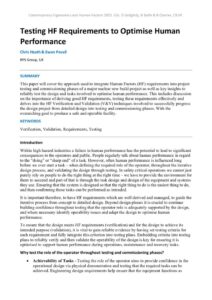
|
Author
Chris Heath & Ewan Povall |
Abstract
This paper will cover the approach used to integrate Human Factors (HF) requirements into project testing and commissioning phases of a major nuclear new build project as well as key insights to reliably test the design and tasks involved to optimise human performance. This includes discussion on the importance of deriving good HF requirements, testing these requirements effectively and delves into the HF Verification and Validation (V&V) techniques involved to successfully progress the design project from detailed design into testing and commissioning phases. With the overarching goal to produce a safe and operable facility. |
Publish Date: Dec 18, 2018 | Keywords: Contemporary EHF 2017, Data, Decision making, Healthcare, Publications
| Document
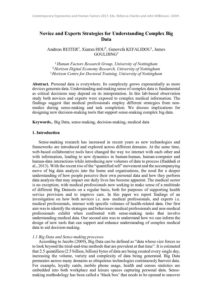
|
Author
Andreas REITER, Xianxu HOU, Genovefa KEFALIDOU, James GOULDING |
Abstract
Personal data is everywhere. Its complexity grows exponentially as more devices generate data. Understanding and making sense of complex data is fundamental as critical decisions may depend on its interpretation. In this lab-based observation study both novices and experts were exposed to complex medical information. The findings suggest that medical professionals employ different strategies from non-medics during sense-making and task completion. We discuss implications for designing new decision-making tools that support sense-making complex big data. |
Publish Date: Jun 8, 2023 | Keywords: Contemporary EHF 2023, Incidents, Publications, Rail
| Document
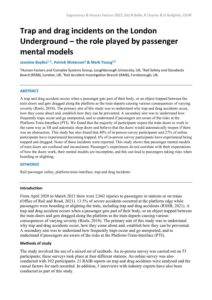
|
Author
Jasmine Bayliss, Patrick Waterson & Mark Young |
Abstract
A trap and drag accident occurs when a passenger gets part of their body, or an object trapped between the train doors and gets dragged along the platform as the train departs causing various consequences of varying severity (Roels, 2018). The primary aim of this study was to understand why trap and drag accidents occur, how they come about and, establish how they can be prevented. A secondary aim was to understand how frequently traps occur and go unreported, and to understand if passengers are aware of the risks at the Platform-Train-Interface (PTI). We found that the majority of participants expect the train doors to work in the same way as lift and automatic shop doors and believe that the doors would automatically reopen if there was an obstruction. This study has also found that 40% of in-person survey participants and 27% of online participants have experienced becoming trapped. 6% of in-person survey participants have experienced being trapped and dragged. None of these incidents were reported. This study shows that passenger mental models of train doors are confused and inconsistent. Passenger’s experiences do not correlate with their expectations of how the doors work, their mental models are incomplete, and this can lead to passengers taking risks when boarding or alighting. |
Publish Date: Dec 18, 2018 | Keywords: Automotive, Cognition, Contemporary EHF 2017, Publications, Technology
| Document
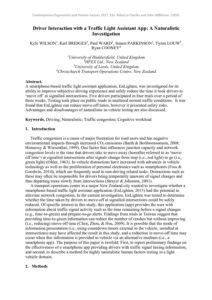
|
Author
Kyle WILSON, Karl BRIDGES, Paul WARD, Simon PARKINSON, Tyron LOUW, Ryan COONEY |
Abstract
A smartphone-based traffic light assistant application, EnLighten, was investigated for its ability to improve subjective driving experience and safely reduce the time it took drivers to ‘move off’ at signalled intersections. Five drivers participated in four trials over a period of three weeks. Testing took place on public roads in unaltered normal traffic conditions. It was found that EnLighten can reduce move-off times, however it presented safety risks. Advantages and disadvantages of naturalistic in-vehicle testing are also discussed. |
Publish Date: Sep 13, 2023 | Keywords: Aviation, Contemporary EHF 2023, Health & Safety, Incidents, Publications
| Document
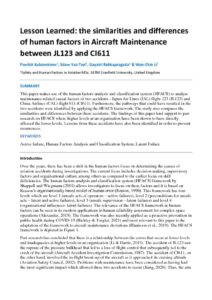
|
Author
Punthit Kulsomboon, Edem Yao Tsei, Gayatri Rebbapragada & Wen-Chin Li |
Abstract
This paper makes use of the human factors analysis and classification system (HFACS) to analyse maintenance-related causal factors of two accidents - Japan Air Lines (JAL) flight 123 (JL123) and China Airlines (CAL) flight 611 (CI611). Furthermore, the pathways that could have resulted in the two accidents were identified by applying the HFACS framework. The study also compares the similarities and differences between these accidents. The findings of this paper lend support to past research on HFACS where higher levels at an organisation have been shown to have directly affected the lower levels. Lessons from these accidents have also been identified in order to prevent recurrences. |
Publish Date: May 31, 2024 | Keywords: Cognition, Contemporary EHF 2024, Healthcare, Publications, Safety
| Document
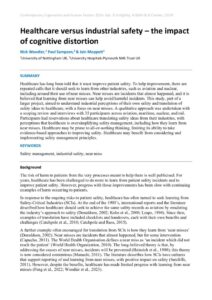
|
Author
Nick Woodier, Paul Sampson, & Iain Moppett |
Abstract
Healthcare has long been told that it must improve patient safety. To help improvement, there are repeated calls that it should seek to learn from other industries, such as aviation and nuclear, including around their use of near misses. Near misses are incidents that almost happened, and it is believed that learning from near misses can help avoid harmful incidents. This study, part of a larger project, aimed to understand industrial perceptions of their own safety and translation of safety ideas to healthcare, with a focus on near misses. A qualitative approach was undertaken with a scoping review and interviews with 35 participants across aviation, maritime, nuclear, and rail. Participants had reservations about healthcare translating safety ideas from their industries, with perceptions that healthcare is oversimplifying safety management, including how they learn from near misses. Healthcare may be prone to all-or-nothing thinking, limiting its ability to take evidence-based approaches to improving safety. Healthcare may benefit from considering and implementing safety management principles. |
Publish Date: Oct 22, 2018 | Keywords: Contemporary EHF 2018, Education, training & skills, Fatigue & sleep, Publications, Rail
| Document
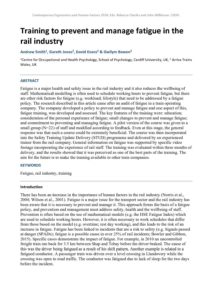
|
Author
Andrew Smith, Gareth Jones, David Evans & Gwilym Bowen |
Abstract
Fatigue is a major health and safety issue in the rail industry and it also reduces the wellbeing of staff. Mathematical modelling is often used to schedule working hours to prevent fatigue, but there are other risk factors for fatigue (e.g. workload; lifestyle) that need to be addressed by a fatigue policy. The research described in this article came after an audit of fatigue in a train operating company. The company developed a policy to prevent and manage fatigue and one aspect of this, fatigue training, was developed and assessed. The key features of the training were: education; consideration of the personal experience of fatigue; small changes to prevent and manage fatigue; and commitment to preventing and managing fatigue. A pilot version of the course was given to a small group (N=22) of staff and modified according to feedback. Even at this stage, the general response was that such a course could be extremely beneficial. The course was then incorporated into the Safety Training Update Delivery (STUD) programme and delivered by an experienced trainer from the rail company. General information on fatigue was supported by specific video footage incorporating the experience of rail staff. The training was evaluated within three months of delivery, and the results showed that it was perceived as one of the best parts of the training. The aim for the future is to make the training available to other train companies. |
Publish Date: Sep 30, 2018 | Keywords: Contemporary EHF 2018, Healthcare, Mental health & wellbeing, Patient Safety, Publications, Systems
| Document
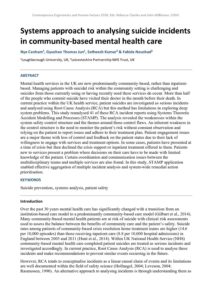
|
Author
Nye Canham, Gyuchan Thomas Jun, Satheesh Kumar & Fabida Noushad |
Abstract
Mental health services in the UK are now predominantly community-based, rather than inpatient-based. Managing patients with suicidal risk within the community setting is challenging and suicides from those currently using or having recently used these services do occur. More than half of the people who commit suicide have visited their doctor in the month before their death. In current practice within the UK health service, patient suicides are investigated as serious incidents and analysed using Root Cause Analysis (RCA) but this method has limitations in exploring deep system problems. This study reanalysed 41 of these RCA incident reports using Systems Theoretic Accident Modelling and Processes (STAMP). The analysis revealed the weaknesses within the system safety control structure and the themes around those control flaws. An inherent weakness in the control structure is the need to monitor the patient’s risk without constant observation and relying on the patient to report issues and adhere to their treatment plan. Patient engagement issues are a major theme with loss of control and feedback on the patient status due to their lack of willingness to engage with services and treatment options. In some cases, patients have presented at a time of crisis but then declined the crisis support or inpatient treatment offered to them. Patients new to services present a problem where decisions on their care have to be made with limited knowledge of the patient. Certain coordination and communication issues between the multidisciplinary teams and multiple services are also found. In this study, STAMP application enabled effective aggregation of multiple incident analysis and system-wide remedial action prioritisation. |
Publish Date: May 27, 2025 | Keywords: Contemporary EHF 2025, Publications
| Document
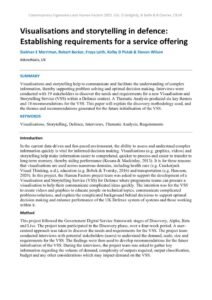
|
Author
Siobhan E Merriman, Robert Becker, Freya Leith, Kolby D Pistak & Steven Wilson |
Abstract
Visualisations and storytelling help to communicate and facilitate the understanding of complex information, thereby supporting problem solving and optimal decision making. Interviews were conducted with 19 stakeholders to discover the needs and requirements for a new Visualisation and Storytelling Service (VSS) within a Defence context. A Thematic Analysis produced six key themes and 18 recommendations for the VSS. This paper will explain the discovery methodology used, and the themes and recommendations generated for the future initialisation of the VSS. |
Publish Date: Jun 24, 2022 | Keywords: Contemporary EHF 2022, Maritime, Publications, Safety, Safety culture
| Document
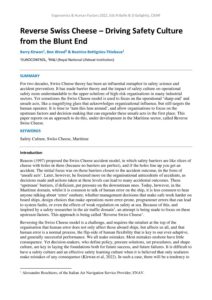
|
Author
Barry Kirwan, Ben Wood & Beatrice Bettignies-Thiebaux |
Abstract
For two decades, Swiss Cheese theory has been an influential metaphor in safety science and accident prevention. It has made barrier theory and the impact of safety culture on operational safety more understandable to the upper echelons of high-risk organisations in many industrial sectors. Yet sometimes the Swiss Cheese model is used to focus on the operational ‘sharp end’ and unsafe acts, like a magnifying glass that acknowledges organizational influence, but still targets the human operator. It is time to ‘turn this lens around’, and allow organisations to focus on the upstream factors and decision-making that can engender these unsafe acts in the first place. This paper reports on an approach to do this, under development in the Maritime sector, called Reverse Swiss Cheese. |
Publish Date: Jun 12, 2023 | Keywords: Contemporary EHF 2023, Healthcare, Publications, Systems
| Document
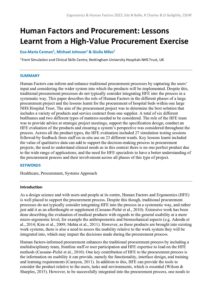
|
Author
Eva-Maria Carman, Michael Johnson & Giulia Miles |
Abstract
Human Factors can inform and enhance traditional procurement processes by capturing the users’ input and considering the wider system into which the products will be implemented. Despite this, traditional procurement processes do not typically consider integrating HFE into the process in a systematic way. This paper describes the role of Human Factors in the different phases of a large procurement project and the lessons learnt for the procurement of hospital beds within one large NHS Hospital Trust. The aim of the procurement project was to determine the best solution that includes a variety of products and service contract from one supplier. A total of six different bedframes and two different types of mattress needed to be considered. The role of the HFE team was to provide advice at strategic project meetings, support the specification design, conduct an HFE evaluation of the products and ensuring a system’s perspective was considered throughout the process. Across all the product types, the HFE evaluation included 27 simulation testing sessions followed by feedback from staff on in-situ use on 23 different wards. Key lessons learnt included the value of qualitative data can add to support the decision-making process in procurement projects, the need to understand clinical needs as in this context there is no one perfect product due to the wide range of applications, and the need for HFE specialists to have a better understanding of the procurement process and their involvement across all phases of this type of project. |
Publish Date: Oct 22, 2018 | Keywords: Contemporary EHF 2018, Investigation, Publications, Rail
| Document
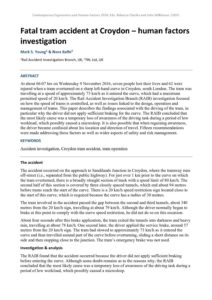
|
Author
Mark S. Young & Nora Balfe |
Abstract
At about 06:07 hrs on Wednesday 9 November 2016, seven people lost their lives and 62 were injured when a tram overturned on a sharp left-hand curve in Croydon, south London. The tram was travelling at a speed of approximately 73 km/h as it entered the curve, which had a maximum permitted speed of 20 km/h. The Rail Accident Investigation Branch (RAIB) investigation focused on how the speed of trams is controlled, as well as issues linked to the design, operation and management of trams. This paper describes the findings associated with the driving of the tram, in particular why the driver did not apply sufficient braking for the curve. The RAIB concluded that the most likely cause was a temporary loss of awareness of the driving task during a period of low workload, which possibly caused a microsleep. It is also possible that when regaining awareness, the driver became confused about his location and direction of travel. Fifteen recommendations were made addressing these factors as well as wider aspects of safety and risk management. |
Publish Date: Feb 26, 2019 | Keywords: Contemporary EHF 2016, Healthcare, Publications, Systems
| Document
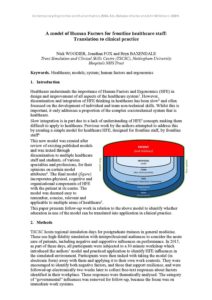
|
Author
Nick WOODIER, Jonathan FOX and Bryn BAXENDALE |
Abstract
|
Publish Date: May 27, 2025 | Keywords: Augmented reality, Contemporary EHF 2025, Decision making, Natural Disaster, Publications, Workload
| Document
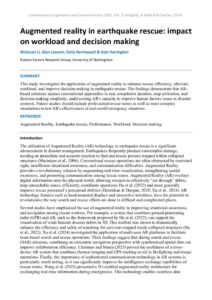
|
Author
Weixuan Li, Glyn Lawson, Setia Hermawati & Kyle Harrington |
Abstract
This study investigates the application of augmented reality to enhance rescue efficiency, alleviate workload, and improve decision-making in earthquake rescue. The findings demonstrate that AR-based solutions surpass conventional approaches in task completion duration, map utilisation, and decision-making simplicity, underscoring AR's capacity to improve human factors issues in disaster contexts. Future studies should include professional rescue teams as well as more complex simulations to test AR's effectiveness in real-world emergency situations. |
Publish Date: Sep 8, 2019 | Keywords: Complex systems, Contemporary EHF 2019, Publications, Safety culture
| Document
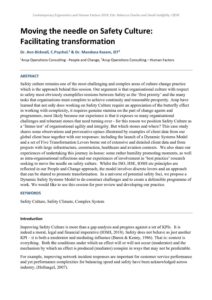
|
Author
Dr. Ann Bicknell, C.Psychol. & Dr. Mandana Kazem, IET |
Abstract
Safety culture remains one of the most challenging and complex areas of culture change practice which is the approach behind this session. Our argument is that organisational culture with respect to safety most obviously exemplifies tensions between Safety as the ‘first priority’ and the many tasks that organisations must complete to achieve continuity and reasonable prosperity. Arup have learned that not only does working on Safety Culture require an appreciation of the butterfly effect in working with complexity, it requires genuine stamina on the part of change agents and programmes, most likely because our experience is that it exposes so many organisational challenges and reluctant stones that need turning over - for this reason we position Safety Culture as a ‘litmus test’ of organisational agility and integrity. But which stones and where? This case study shares some observations and provocative opines illustrated by examples of client data from our global client base together with our responses: including the launch of a Dynamic Systems Model and a set of Five Transformation Levers borne out of extensive and detailed client data and from projects with large infrastructure, construction, healthcare and aviation contexts. We also share our experiences of undertaking this journey in-house: some rather humility promoting moments, as well as intra-organisational reflections and our experiences of involvement in ‘best practice’ research seeking to move the needle on safety culture. Whilst the ISO, HSE, IOSH etc principles are reflected in our People and Change approach, the model involves discrete levers and an approach that can be shared to promote transformation. In a universe of potential safety foci, we propose a Dynamic Safety Systems Model to de-construct challenges and to create a defensible programme of work. We would like to use this session for peer review and developing our practice. |
Publish Date: Oct 30, 2018 | Keywords: Contemporary EHF 2017, Publications, Systems, Tools & techniques
| Document
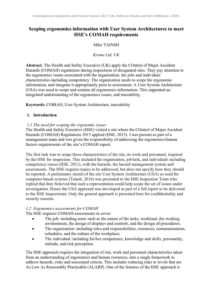
|
Author
Mike TAINSH |
Abstract
The Health and Safety Executive (UK) apply the COntrol of Major Accident Hazards (COMAH) regulations during inspections of designated sites. They pay attention to the ergonomics issues associated with the organisation, the jobs and individual characteristics including competency. The organisation needs to scope the ergonomic information, and integrate it appropriately prior to assessment. A User System Architecture (USA) was used to scope and contain all ergonomics information. This supported an integrated understanding of the ergonomics issues, and traceability. |
Publish Date: May 23, 2025 | Keywords: Aviation, Contemporary EHF 2025, Human performance, Publications
| Document
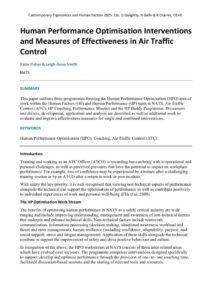
|
Author
Katie Fisher & Leigh-Anne Smith |
Abstract
This paper outlines three programmes forming the Human Performance Optimisation (HPO) area of work within the Human Factors (HF) and Human Performance (HP) team at NATS, Air Traffic Control (ATC): HP Coaching, Performance Mindset and the HP Buddy Programme. Pre-cursors and drivers, development, application and analysis are described as well as additional work to evaluate and improve effectiveness measures for single and combined interventions. |
Publish Date: Sep 30, 2018 | Keywords: Contemporary EHF 2018, Healthcare, Incidents, Publications
| Document
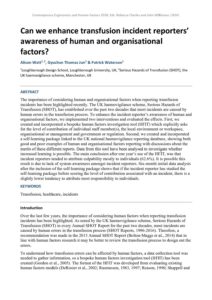
|
Author
Alison Watt, Gyuchan Thomas Jun & Patrick Waterson |
Abstract
The importance of considering human and organisational factors when reporting transfusion incidents has been highlighted recently. The UK haemovigilance scheme, Serious Hazards of Transfusion (SHOT), has established over the past two decades that most incidents are caused by human errors in the transfusion process. To enhance the incident reporter’s awareness of human and organisational factors, we implemented two interventions and evaluated the effects. First, we created and incorporated a bespoke human factors investigation tool (HFIT) which explicitly asks for the level of contribution of individual staff member(s), the local environment or workspace, organisational or management and government or regulation. Second, we created and incorporated a self-learning package linked to the UK national haemovigilance reporting database, showing both good and poor examples of human and organisational factors reporting with discussions about the merits of these different reports. Data from this tool have been analysed to investigate whether increased learning is possible. The main conclusion after one year’s use of the HFIT, was that incident reporters tended to attribute culpability mostly to individuals (62.6%). It is possible this result is due to lack of system awareness amongst incident reporters. Six-month initial data analysis after the inclusion of the self-learning package shows that if the incident reporter has studied the self-learning package before scoring the level of contribution associated with an incident, there is a slightly lower tendency to attribute most responsibility to individuals. |
Publish Date: Sep 8, 2019 | Keywords: Contemporary EHF 2019, Publications, Rail
| Document
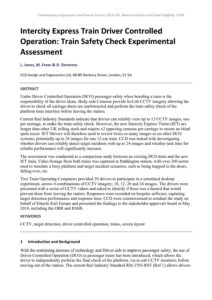
|
Author
L. Jones, M. Freer & D. Simmons |
Abstract
Under Driver Controlled Operation (DCO) passenger safety when boarding a train is the responsibility of the driver alone. Body-side Cameras provide In-Cab CCTV imagery allowing the driver to check all carriage doors are unobstructed and perform the train safety check of the platform train interface before leaving the station. Current Rail Industry Standards indicate that drivers can reliably view up to 12 CCTV images, one per carriage, to make the train safety check. However, the new Intercity Express Trains (IET) are longer than other UK rolling stock and require x2 opposing cameras per carriage to ensure no blind spots occur. IET Drivers will therefore need to review twice as many images as on other DCO systems; potentially up to 24 images for one 12-car train. CCD was tasked with investigating whether drivers can reliably detect target incidents with up to 24 images and whether task time for reliable performance will significantly increase. The assessment was conducted as a comparison study between an existing DCO train and the new IET train. Video footage from both trains was captured at Paddington station, with over 200 actors used to simulate a busy platform and target incident scenarios, such as being trapped in the doors, falling over, etc. Two Train Operating Companies provided 39 drivers to participate in a simulated desktop experiment, across 4 combinations of CCTV imagery; 10, 12, 20 and 24 images. The drivers were presented with a series of CCTV videos and asked to identify if there was a hazard that would prevent them from leaving the station. Responses were recorded on bespoke software, capturing target detection performance and response time. CCD were commissioned to conduct the study on behalf of Hitachi Rail Europe and presented the findings to the stakeholder approvals board in May 2018, including the ORR and RSSB. |
Publish Date: Apr 9, 2020 | Keywords: Contemporary EHF 2020, Data, Publications, Technology, Workload
| Document
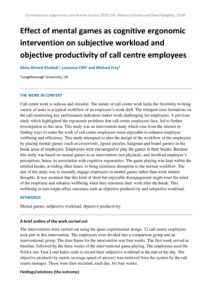
|
Author
Silvia Ahmed Khattak, Laurence Clift and Michael Fray |
Abstract
Call centre work is tedious and stressful. The nature of call centre work lacks the flexibility to bring variety of tasks in a typical workflow of an employee’s work shift. The stringent time limitations on the call monitoring key performance indicators makes work challenging for employees. A previous study which highlighted the ergonomic problems that call centre employees face, led to further investigation in this area. This study was an intervention study which rose from the interest in finding ways to make the work of call centre employees more enjoyable to enhance employee wellbeing and efficiency. This study attempted to alter the design of the workflow of the employees by placing mental games (such as crosswords, jigsaw puzzles, hangman and board games) in the break areas of employees. Employees were encouraged to play the games in their breaks. Because this study was based on mental games as an intervention (not physical), and involved employee’s perceptions, hence its association with cognitive ergonomics. The game playing was kept within the entitled breaks, avoiding other times, to bring minimum disruption to the normal workflow. The aim of the study was to mentally engage employees in mental games rather than work related thoughts. It was assumed that this kind of short but enjoyable disengagement might reset the mind of the employee and enhance wellbeing when they reassume their work after the break. This wellbeing in turn might affect outcomes such as objective productivity and subjective workload. |
Publish Date: Mar 25, 2019 | Keywords: Contemporary EHF 2016, Publications, Risk assessment
| Document
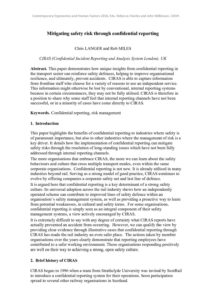
|
Author
Chris LANGER and Rob MILES |
Abstract
This paper demonstrates how unique insights from confidential reporting in the transport sector can reinforce safety defences, helping to improve organisational resilience, and ultimately, prevent accidents. CIRAS is able to capture information from frontline staff who choose for a variety of reasons to use an independent service. This information might otherwise be lost by conventional, internal reporting systems because in certain circumstances, they may not be fully utilised. CIRAS is therefore in a position to share why some staff feel that internal reporting channels have not been successful, or in a minority of cases have come directly to CIRAS. |
Publish Date: Aug 19, 2021 | Keywords: Aviation, Comfort, Comfort Congress 2021, Design, Publications, Seating
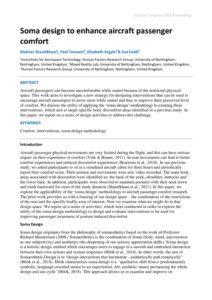 |
Author
Mahnaz Sharafkhani, Paul Tennen2, Elizabeth Argyle & Sue Cobb |
Abstract
Aircraft passengers can become uncomfortable while seated because of the restricted physical space. This work aims to investigate a new strategy for designing interventions that can be used to encourage aircraft passengers to move more while seated and thus to improve their perceived level of comfort. We discuss the utility of applying the ‘soma design’ methodology to creating these interventions, which aim to target specific body discomfort areas identified in a previous study. In this paper, we report on a series of design activities to address this challenge. |
Publish Date: Jun 23, 2022 | Keywords: Contemporary EHF 2022, Healthcare, Mental health & wellbeing, Publications
| Document
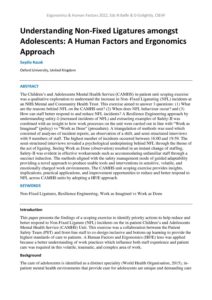
|
Author
Saydia Razak |
Abstract
The Children’s and Adolescents Mental Health Service (CAMHS) in-patient unit scoping exercise was a qualitative exploration to understand the increase in Non–Fixed Ligaturing (NFL) incidents at an NHS Mental and Community Health Trust. This exercise aimed to answer 3 questions: (1) What are the reasons behind NFL on the CAMHS unit? (2) When does NFL behaviour occur? and (3) How can staff better respond to and reduce NFL incidents? A Resilience Engineering approach by understanding safety-I (increased incidents of NFL) and extracting examples of Safety-II was combined with an insight to how work processes on the unit were carried out in line with “Work as Imagined” (policy) vs “Work as Done” (procedure). A triangulation of methods was used which consisted of analyses of incident reports, an observation of a shift, and semi-structured interviews with 9 members of staff. The highest number of incidents occurred between 16:00 and 19:59. The semi-structured interviews revealed a psychological underpinning behind NFL through the theme of the act of ligating. Seeing Work as Done (observation) resulted in an instant change of staffing. Safety-II was evident in effective workarounds such as accommodating unfamiliar staff through a succinct induction. The methods aligned with the safety management mode of guided adaptability providing a novel approach to produce usable tools and interventions in sensitive, volatile, and emotionally charged work environments. The CAMHS unit scoping exercise provides insights, implications, practical applications, and improvement opportunities to reduce and better respond to NFL across CAMHS units by adopting a HF/E approach. |
Publish Date: Jun 12, 2023 | Keywords: Behaviour, Contemporary EHF 2023, Publications, Road safety
| Document
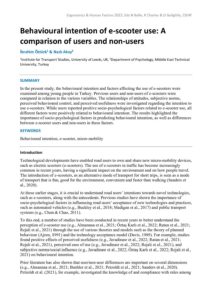
|
Author
İbrahim Öztürk & Nazlı Akay |
Abstract
In the present study, the behavioural intention and factors affecting the use of e-scooters were examined among young people in Turkey. Previous users and non-users of e-scooters were compared in relation to the various variables. The relationships of attitudes, subjective norms, perceived behavioural control, and perceived usefulness were investigated regarding the intention to use e-scooters. While users reported positive socio-psychological factors related to e-scooter use, all different factors were positively related to behavioural intention. The results highlighted the importance of socio-psychological factors in predicting behavioural intention, as well as differences between e-scooter users and non-users in these factors. |
Publish Date: Jun 12, 2023 | Keywords: Behaviour, Climate change, Contemporary EHF 2023, Publications
| Document
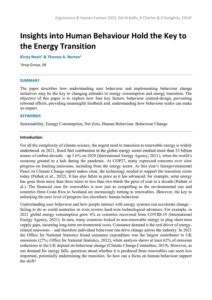
|
Author
Kirsty Novis & Thomas A. Norton |
Abstract
The paper describes how understanding user behaviour and implementing behaviour change initiatives may be the key to changing attitudes to energy consumption and energy transition. The objective of this paper is to explore how four key factors; behaviour centred-design, preventing rebound effects, providing meaningful feedback and, understanding how behaviour scales can make an impact. |
Publish Date: Oct 23, 2018 | Keywords: Contemporary EHF 2018, Publications, Technology, Tools & techniques, User centred design
| Document
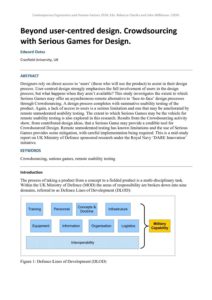
|
Author
Edward Oates |
Abstract
Designers rely on direct access to ‘users’ (those who will use the product) to assist in their design process. User-centred design strongly emphasises the full involvement of users in the design process; but what happens when they aren’t available? This study investigates the extent to which Serious Games may offer an asynchronous remote alternative to ‘face-to-face’ design processes through Crowdsourcing. A design process completes with summative usability testing of the product. Again, a lack of access to users is a serious limitation and one that may be ameliorated by remote unmoderated usability testing. The extent to which Serious Games may be the vehicle for remote usability testing is also explored in this research. Results from the Crowdsourcing activity show, from contributed design ideas, that a Serious Game may provide a credible tool for Crowdsourced Design. Remote unmoderated testing has known limitations and the use of Serious Games provides some mitigation, with careful implementation being required. This is a mid-study report on UK Ministry of Defence sponsored research under the Royal Navy ‘DARE Innovation’ initiative. |
Publish Date: Apr 9, 2021 | Keywords: Accessibility, Contemporary EHF 2021, Design, Publications
| Document
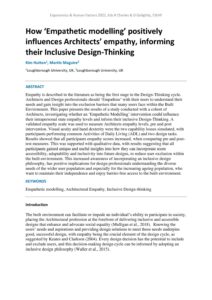
|
Author
Kim Hutton and Martin Maguire |
Abstract
Empathy is described in the literature as being the first stage in the Design-Thinking cycle. Architects and Design professionals should ‘Empathise’ with their users to understand their needs and gain insight into the exclusion barriers that many users face within the Built Environment. This paper presents the results of a study conducted with a cohort of Architects, investigating whether an ‘Empathetic Modelling’ intervention could influence their intrapersonal state empathy levels and inform their inclusive Design-Thinking. A validated empathy scale was used to measure Architects empathy levels, pre and post intervention. Visual acuity and hand dexterity were the two capability losses simulated, with participants performing common Activities of Daily Living (ADL) and two design tasks. Results showed that all participants empathy scores increased, when comparing pre and post-test measures. This was supported with qualitative data, with results suggesting that all participants gained unique and useful insights into how they can incorporate more accessibility, adaptability and inclusivity into future designs, to reduce user exclusion within the built environment. This increased awareness of incorporating an inclusive design philosophy, has positive implications for design professionals understanding the diverse needs of the wider user population and especially for the increasing ageing population, who want to maintain their independence and enjoy barrier-free access to the built environment. |
Publish Date: May 30, 2024 | Keywords: Contemporary EHF 2024, Investigation, Maritime, Publications
| Document
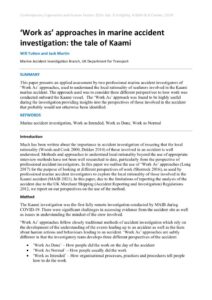
|
Author
Will Tutton and Jack Martin |
Abstract
This paper presents an applied assessment by two professional marine accident investigators of ‘Work As’ approaches, used to understand the local rationality of seafarers involved in the Kaami marine accident. The approach used was to consider three different perspectives to how work was conducted onboard the Kaami vessel. The ‘Work As’ approach was found to be highly useful during the investigation providing insights into the perspectives of those involved in the accident that probably would not otherwise been identified. |
Publish Date: Jun 12, 2023 | Keywords: Contemporary EHF 2023, Maritime, Publications, Technology
| Document
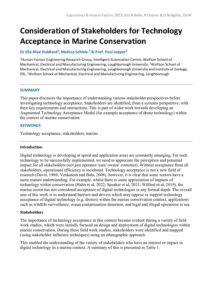
|
Author
Dr Ella-Mae Hubbard, Melissa Schiele & Prof. Paul Lepper |
Abstract
This paper discusses the importance of understanding various stakeholder perspectives before investigating technology acceptance. Stakeholders are identified, from a systems perspective, with their key requirements and interactions. This is part of wider work towards developing an Augmented Technology Acceptance Model (for example acceptance of drone technology) within the context of marine conservation. |
Publish Date: Jun 4, 2024 | Keywords: Artificial intelligence, Aviation, Contemporary EHF 2024, Human factors integration, Publications, Safety, Systems, Technology
| Document
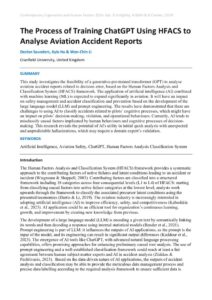
|
Author
Declan Saunders, Kyle Hu & Wen-Chin Li |
Abstract
This study investigates the feasibility of a generative-pre-trained transformer (GPT) to analyse aviation accident reports related to decision error, based on the Human Factors Analysis and Classification System (HFACS) framework. The application of artificial intelligence (AI) combined with machine learning (ML) is expected to expand significantly in aviation. It will have an impact on safety management and accident classification and prevention based on the development of the large language model (LLM) and prompt engineering. The results have demonstrated that there are challenges to using AI to classify accidents related to pilots’ cognitive processes, which might have an impact on pilots’ decision-making, violation, and operational behaviours. Currently, AI tends to misclassify causal factors implicated by human behaviours and cognitive processes of decision�making. This research reveals the potential of AI's utility in initial quick analysis with unexpected and unpredictable hallucinations, which may require a domain expert’s validation. |
Publish Date: Jun 11, 2025 | Keywords: Contemporary EHF 2025, Decision making, Healthcare, Publications
| Document
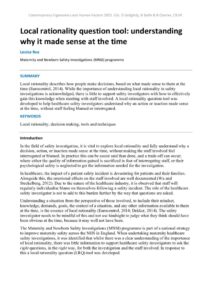
|
Author
Louise Roe |
Abstract
Local rationality describes how people make decisions, based on what made sense to them at the time (Eurocontrol, 2014). While the importance of understanding local rationality in safety investigations is acknowledged, there is little to support safety investigators with how to effectively gain this knowledge when meeting with staff involved. A local rationality question tool was developed to help healthcare safety investigators understand why an action or inaction made sense at the time, without staff feeling blamed or interrogated. |
Publish Date: Jun 23, 2022 | Keywords: Contemporary EHF 2022, Healthcare, Incidents, Investigation, Patient Safety, Publications
| Document
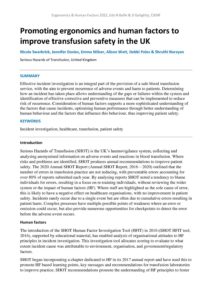
|
Author
Nicola Swarbrick, Jennifer Davies, Emma Milser, Alison Watt, Debbi Poles & Shruthi Narayan |
Abstract
Effective incident investigation is an integral part of the provision of a safe blood transfusion service, with the aim to prevent recurrence of adverse events and harm to patients. Determining how an incident has taken place allows understanding of the gaps or failures within the system and identification of effective corrective and preventive measures that can be implemented to reduce risk of recurrence. Consideration of human factors supports a more sophisticated understanding of the factors that cause incidents, optimising human performance through better understanding of human behaviour and the factors that influence this behaviour, thus improving patient safety. |
Publish Date: May 27, 2025 | Keywords: Contemporary EHF 2025, Defence, Publications, Systems
| Document
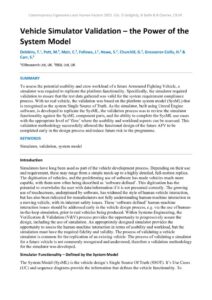
|
Author
Dobbins, T, Pett, M, Meir, C, Follows, J, Howe, S, Churchill, G, Grosvenor-Collis, H & Carr, S |
Abstract
To assess the potential usability and crew workload of a future Armoured Fighting Vehicle, a simulator was required to replicate the platform functionality. Specifically, the simulator required validation to ensure that the test data gathered was valid for the system requirement compliance process. With no real vehicle, the validation was based on the platform system model (SysML) that is recognised as the system Single Source of Truth. As the simulator, built using Unreal Engine software, is developed to replicate the SysML, the validation process was to review the simulator functionality against the SysML component parts, and the ability to complete the SysML use cases with the appropriate level of ‘flow’ where the usability and workload aspects can be assessed. This validation methodology successfully allowed the functional design of the future AFV to be completed early in the design process and reduce future risk to the programme. |
Publish Date: May 23, 2025 | Keywords: Artificial intelligence, Contemporary EHF 2025, Design, Publications, User centred design
| Document
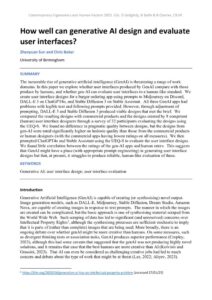
|
Author
Zhenyuan Sun and Chris Baber |
Abstract
The inexorable rise of generative artificial intelligence (GenAI) is threatening a range of work domains. In this paper we explore whether user interfaces produced by GenAI compare with those produce by humans, and whether gen-AI can evaluate user interfaces to a human-like standard. We create user interface designs for a burger ordering app using prompts to Midjourney on Discord, DALL-E 3 on ChatGPT4o, and Stable Diffusion 3 on Stable Assistant. All three GenAI apps had problems with legible text and following prompts provided. However, through adjustment of prompting, DALL-E 3 and Stable Diffusion 3 produced viable designs that met the brief. We compared the resulting designs with commercial products and the designs created by 8 competent (human) user interface designers through a survey of 32 participants evaluating the designs using the UEQ-S. We found no difference in pragmatic quality between designs, but the designs from gen-AI were rated significantly higher on hedonic quality than those from the commercial products or human designers (with the commercial apps having lowest ratings on all measures). We then prompted ChatGPT4o and Stable Assistant using the UEQ-S to evaluate the user interface designs. We found little correlation between the ratings of the gen-AI apps and human raters. This suggests that GenAI might have a place (with appropriate prompt engineering) in generating user interface designs but that, at present, it struggles to produce reliable, human-like evaluation of these. |
Publish Date: Apr 9, 2021 | Keywords: Complex systems, Contemporary EHF 2021, Healthcare, Publications, Resilience
| Document
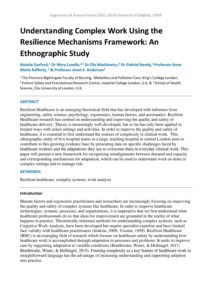
|
Author
Natalie Sanford, Dr Mary Lavelle, Dr Ola Markiewicz, Dr Gabriel Reedy, Professor Anne Marie Rafferty, & Professor Janet E. Anderson |
Abstract
Resilient Healthcare is an emerging theoretical field that has developed with influence from engineering, safety science, psychology, ergonomics, human factors, and aeronautics. Resilient Healthcare research has centred on understanding and improving the quality and safety of healthcare delivery. Theory is increasingly well-developed, but so far has only been applied in limited ways with select settings and activities. In order to improve the quality and safety of healthcare, it is essential to first understand the sources of complexity in clinical work. This ethnographic study of five hospital teams in a large, teaching hospital in central London aims to contribute to this growing evidence base by presenting data on specific challenges faced by healthcare workers and the adaptations they use to overcome them in everyday clinical work. This paper will present a new framework for recognising misalignments between demand and capacity and corresponding mechanisms for adaptation, which can be used to understand work-as-done in complex settings and to manage risk. |
Publish Date: Jun 23, 2022 | Keywords: Contemporary EHF 2022, Healthcare, Publications, Technology
| Document
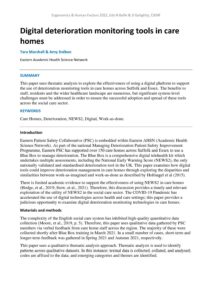
|
Author
Tara Marshall & Amy Dolben |
Abstract
This paper uses thematic analysis to explore the effectiveness of using a digital platform to support the use of deterioration monitoring tools in care homes across Suffolk and Essex. The benefits to staff, residents and the wider healthcare landscape are numerous, but significant system-level challenges must be addressed in order to ensure the successful adoption and spread of these tools across the social care sector. |
Publish Date: Dec 18, 2018 | Keywords: Contemporary EHF 2017, Healthcare, Incidents, Publications, Safety
| Document
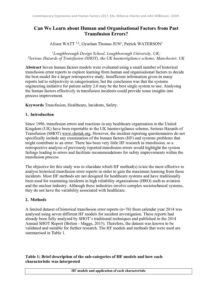
|
Author
Alison WATT, Gyuchan Thomas JUN, Patrick WATERSON |
Abstract
Seven human factors models were evaluated using a small number of historical transfusion error reports to explore learning from human and organisational factors to decide the best model for a larger retrospective study. Insufficient information given in many reports led to subjectivity in categorisation, but the conclusion was that the systems engineering initiative for patient safety 2.0 may be the best single system to use. Analysing the human factors effectively in transfusion incidents could provide some insights into process improvement. |
Publish Date: Jun 11, 2025 | Keywords: Contemporary EHF 2025, Healthcare, Patient Safety, Publications, Safety
| Document
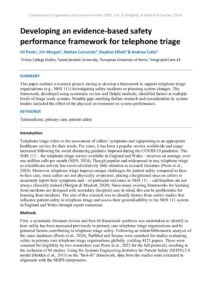
|
Author
Jill Poots, Jim Morgan, Matteo Curcuruto, Stephen Elliott & Andrew Catto |
Abstract
This paper outlines a research project aiming to develop a framework to support telephone triage organisations (e.g., NHS 111) investigating safety incidents or planning system changes. The framework, developed using systematic review and Delphi methods, identified factors at multiple levels of triage work systems. Notable gaps meriting further research and consideration by system leaders included the effect of the physical environment on system performance. |
Publish Date: Apr 15, 2020 | Keywords: Accimaps, Contemporary EHF 2020, Publications, Sociotechnical systems
| Document
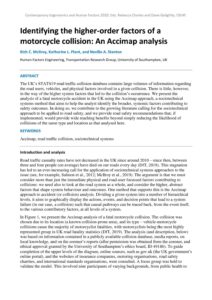
|
Author
Rich C. McIlroy, Katherine L. Plant and Neville A. Stanton |
Abstract
The UK’s STATS19 road traffic collision database contains large volumes of information regarding the road users, vehicles, and physical factors involved in a given collision. There is little, however, in the way of the higher system factors that led to the collision’s occurrence. We present the analysis of a fatal motorcycle accident in the UK using the Accimap approach, a sociotechnical systems method that aims to help the analyst identify the broader, systemic factors contributing to safety outcomes. In doing so, we contribute to the growing literature calling for the sociotechnical approach to be applied to road safety, and we provide road safety recommendations that, if implemented, would provide wide reaching benefits beyond simply reducing the likelihood of collisions of the same type and location as that analysed here. |
Publish Date: Oct 23, 2018 | Keywords: Communication, Contemporary EHF 2018, Defence, Publications, Submarines
| Document
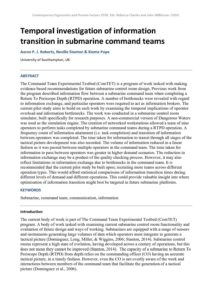
|
Author
Aaron P. J. Roberts, Neville Stanton & Kiome Pope |
Abstract
The Command Team Experimental Testbed (ComTET) is a program of work tasked with making evidence based recommendations for future submarine control room design. Previous work from the program described information flow between a submarine command team when completing a Return To Periscope Depth (RTPD) operation. A number of bottlenecks were revealed with regard to information exchange, and particular operators were required to act as information brokers. The current pilot study aims to build on such work by examining the temporal implications of operator overload and information bottlenecks. The work was conducted in a submarine control room simulator, built specifically for research purposes. A non-commercial version of Dangerous Waters was used as the simulation engine. The creation of networked workstations allowed a team of nine operators to perform tasks completed by submarine command teams during a RTPD operation. A frequency count of information attainment (i.e. task completion) and transition of information between operators was completed. The time taken for information to transit through all stages of the tactical picture development was also recorded. The volume of information reduced in a linear fashion as it was passed between multiple operators in the command team. The time taken for information to pass between operators was greater in higher demand scenarios. The reduction in information exchange may be a product of the quality checking process. However, it may also reflect limitations in information exchange due to bottlenecks in the command team. It is recommended that the current pilot study be built upon; recruiting more teams across different operation types. This would afford statistical comparisons of information transition times during different levels of demand and different operations. This could provide valuable insight into where optimisation of information transition might best be targeted in future submarine platforms. |
Publish Date: Apr 9, 2021 | Keywords: Automotive, Contemporary EHF 2021, Fatigue & sleep, Publications, Risk assessment, Road safety, Safety
| Document
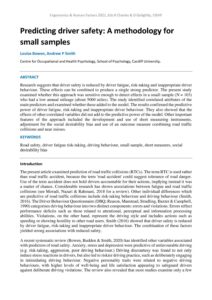
|
Author
Louise Bowen and Andrew P Smith |
Abstract
Research suggests that driver safety is reduced by driver fatigue, risk-taking and inappropriate driver behaviour. These effects can be combined to produce a single strong predictor. The present study examined whether this approach was sensitive enough to detect effects in a small sample (N = 103) who had a low annual mileage (about 5000 miles). The study identified correlated attributes of the main predictors and examined whether these added to the model. The results confirmed the predictive power of driver fatigue, risk-taking and inappropriate driver behaviour. They also showed that the effects of other correlated variables did not add to the predictive power of the model. Other important features of the approach included the development and use of short measuring instruments, adjustment for the social desirability bias and use of an outcome measure combining road traffic collisions and near misses. |
Publish Date: Jun 24, 2022 | Keywords: Contemporary EHF 2022, Publications, Rail, Safety, Transport
| Document
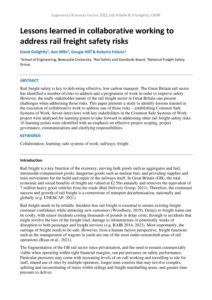
|
Author
David Golightly, Ann Mills, Dougie Hill & Roberto Palacin |
Abstract
Rail freight safety is key to delivering effective, low carbon transport. The Great Britain rail sector has identified a number of risks to address and a programme of work in order to improve safety. However, the multi-stakeholder nature of the rail freight sector in Great Britain can present challenges when addressing those risks. This paper presents a study to identify lessons learned in the execution of collaborative work to address one of those risks – establishing Common Safe Systems of Work. Seven interviews with key stakeholders in the Common Safe Systems of Work project were analysed for learning points to take forward in addressing other rail freight safety risks. 16 learning points were identified with an emphasis on effective project scoping, project governance, communications and clarifying responsibilities. |
Publish Date: Jun 8, 2023 | Keywords: Contemporary EHF 2023, Publications, Task analysis, Tools & techniques
| Document
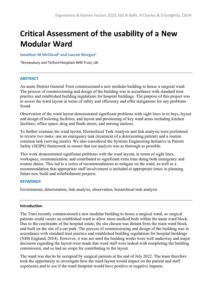
|
Author
Jonathan M McCloud & Lauren Morgan |
Abstract
An acute District General Trust commissioned a new modular building to house a surgical ward. The process of commissioning and design of the building was in accordance with standard trust practice and established building regulations for hospital buildings. The purpose of this project was to assess the ward layout in terms of safety and efficiency and offer mitigations for any problems found. Observation of the ward layout demonstrated significant problems with sight lines in to bays, layout and design of toileting facilities, and layout and positioning of key ward areas including kitchen facilities, office space, drug and fluids stores, and nursing stations. To further examine the ward layout, Hierarchical Task Analysis and link analysis were performed to review two tasks: one an emergency task (treatment of a deteriorating patient) and a routine common task (serving meals). We also considered the Systems Engineering Initiative in Patient Safety (SEIPS) framework to ensure that our analysis was as thorough as possible. This work demonstrated significant problems with the ward layout, in terms of sight lines, workspace, communication, and contributed to significant extra time doing both emergency and routine duties. This led to a series of recommendations to mitigate on the ward, as well as a recommendation that appropriate staff involvement is included at appropriate times in planning future new build and refurbishment projects. |
Publish Date: Jun 5, 2024 | Keywords: Cognition, Contemporary EHF 2024, Defence, Publications
| Document
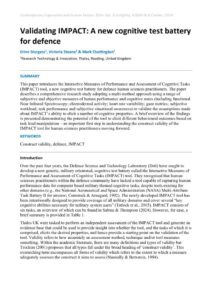
|
Author
Erinn Sturgess, Victoria Steane & Mark Chattington |
Abstract
This paper introduces the Interactive Measures of Performance and Assessment of Cognitive Tasks (IMPACT) tool, a new cognitive test battery for defence human sciences practitioners. The paper describes a comprehensive research study adopting a multi-method approach using a range of subjective and objective measures of human performance and cognitive states (including functional Near Infrared Spectroscopy; electrodermal activity; heart rate variability; gaze metrics; subjective workload; task performance and subjective situational awareness) to validate the assumptions made about IMPACT’s ability to elicit a number of cognitive properties. A brief overview of the findings is presented demonstrating the potential of the tool to elicit different behavioural outcomes based on task load manipulation – an important first step in understanding the construct validity of the IMPACT tool for human sciences practitioners moving forward. |
Publish Date: Feb 27, 2019 | Keywords: Contemporary EHF 2016, Healthcare, Patient Safety, Publications, Technology
| Document
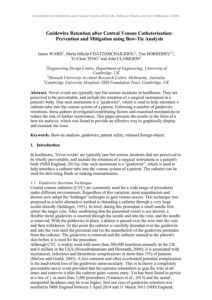
|
Author
James WARD, Maria Mikela CHATZIMICHAILIDOU, Tim HORBERRY, Yi-Chun TENG and John CLARKSON |
Abstract
Never events are typically rare but serious incidents in healthcare. They are perceived to be preventable, and include the retention of a surgical instrument in a patient's body. One such instrument is a "guidewire", which is used to help introduce a catheter tube into the venous system of a patient. Following a number of guidewire retentions, these authors investigated contributing factors and examined mechanisms to reduce the risk of further occurrences. This paper presents the results in the form of a bow-tie analysis, which was found to provide an effective way to graphically display and examine the issue. |
Publish Date: May 23, 2025 | Keywords: Contemporary EHF 2025, Publications, Risk assessment, Sociotechnical systems, Technology, Transport
| Document
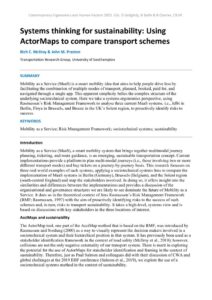
|
Author
Rich C. McIlroy & John M. Preston |
Abstract
Mobility as a Service (MaaS) is a smart mobility idea that aims to help people drive less by facilitating the combination of multiple modes of transport, planned, booked, paid for, and navigated through a single app. This apparent simplicity belies the complex structure of the underlying sociotechnical system. Here we take a systems ergonomics perspective, using Rasmussen’s Risk Management Framework to analyse three current MaaS systems, i.e., Jelbi in Berlin, Floya in Brussels, and Breeze in the UK’s Solent region, to proactively identify risks to success. |
Publish Date: Jun 12, 2023 | Keywords: Autonomous vehicles, Contemporary EHF 2023, Publications
| Document
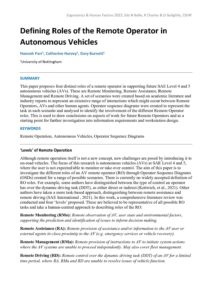
|
Author
Hannah Parr, Catherine Harvey & Gary Burnett |
Abstract
This paper proposes four distinct roles of a remote operator in supporting future SAE Level 4 and 5 autonomous vehicles (AVs). These are Remote Monitoring, Remote Assistance, Remote Management and Remote Driving. A set of scenarios were created based on academic literature and industry reports to represent an extensive range of interactions which might occur between Remote Operators, AVs and other human agents. Operator sequence diagrams were created to represent the task in each scenario and analysed to identify the involvement of the different Remote Operator roles. This is used to draw conclusions on aspects of work for future Remote Operators and as a starting point for further investigation into information requirements and workstation design. |
Publish Date: Jun 23, 2022 | Keywords: Contemporary EHF 2022, Healthcare, Incidents, Publications
| Document
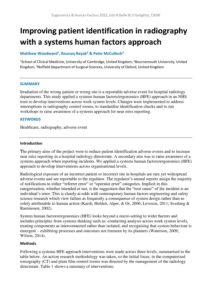
|
Author
Matthew Woodward, Rounaq Nayak & Peter McCulloch |
Abstract
Irradiation of the wrong patient or wrong site is a reportable adverse event for hospital radiology departments. This study applied a systems human factors/ergonomics (HFE) approach in an NHS trust to develop interventions across work system levels. Changes were implemented to address interruptions in radiography control rooms, to standardise identification checks and to run workshops to raise awareness of a systems approach for near miss reporting. |
Publish Date: Apr 9, 2020 | Keywords: Contemporary EHF 2020, Leadership, Mental health & wellbeing, Publications, Workload
| Document
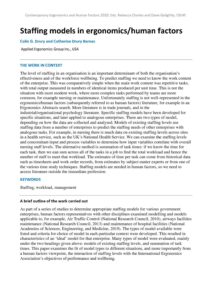
|
Author
Colin G. Drury and Catherine Drury Barnes |
Abstract
The level of staffing in an organisation is an important determinant of both the organisation’s effectiveness and of the workforce wellbeing. To predict staffing we need to know the work content of the enterprise. This was comparatively simple when the main work content was repetitive tasks, with total output measured in numbers of identical items produced per unit time. This is not the situation with most modern work, where more complex tasks performed by teams are more common, for example nursing or maintenance. Unfortunately staffing is not well-represented in the ergonomics/human factors (subsequently referred to as human factors) literature, for example in an Ergonomics Abstracts search. More literature is in trade journals, and in the industrial/organisational psychology literature. Specific staffing models have been developed for specific situations, and later applied to analogous enterprises. There are two types of model, depending on how the data are collected and analysed. Models of existing staffing levels use staffing data from a number of enterprises to predict the staffing needs of other enterprises with analogous tasks. For example, in nursing there is much data on existing staffing levels across sites in a health service, such as the UK’s National Health Service. We can examine the staffing levels and concomitant input and process variables to determine how input variables correlate with overall nursing staff levels. The alternative method is summation of task times: if we know the time for each task, then we can sum across all of the tasks in a job to find the total workload and hence the number of staff to meet that workload. The estimates of time per task can come from historical data such as timesheets and work order records, from estimates by subject matter experts or from one of the various time study techniques. Staffing models are needed in human factors, so we need to access literature outside the immediate profession. |
Publish Date: Apr 9, 2021 | Keywords: Climate change, Contemporary EHF 2021, Publications
| Document
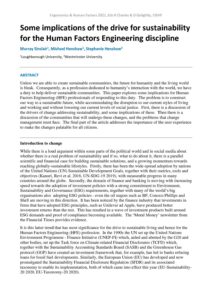
|
Author
Murray Sinclair, Michael Henshaw and Stephanie Henshaw |
Abstract
Unless we are able to create sustainable communities, the future for humanity and the living world is bleak. Consequently, as a profession dedicated to humanity’s interaction with the world, we have a duty to help deliver sustainable communities. This paper explores some implications for Human Factors Engineering (HFE) professionals of responding to this duty. The problem is to construct our way to a sustainable future, while accommodating the disruption to our current styles of living and working and without lowering our current levels of social justice. First, there is a discussion of the drivers of change addressing sustainability, and some implications of these. Then there is a discussion of the communities that will undergo these changes, and the problems that change management must face. The final part of the article addresses the importance of the user experience to make the changes palatable for all citizens. |
Publish Date: Jun 24, 2022 | Keywords: Climate change, Contemporary EHF 2022, Publications, Rail
| Document
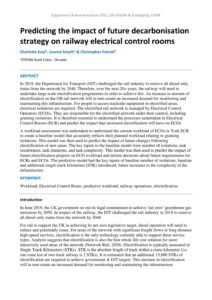
|
Author
Charlotte Kaul, Joanne Smyth & Christopher Patrick |
Abstract
In 2018, the Department for Transport (DfT) challenged the rail industry to remove all diesel-only trains from the network by 2040. Therefore, over the next 20+ years, the railway will need to undertake large scale electrification programmes in order to achieve this. An increase in amount of electrification on the GB rail network will in turn create an increased demand for monitoring and maintaining this infrastructure. For people to access trackside equipment in electrified areas, electrical isolations are required. The electrified rail network is managed by Electrical Control Operators (ECOs). They are responsible for the electrified network under their control, including granting isolations. It is therefore essential to understand the processes undertaken in Electrical Control Rooms (ECR) and predict the impact that increased electrification will have on ECOs. A workload assessment was undertaken to understand the current workload of ECOs in York ECR to create a baseline model that accurately reflects their planned workload relating to granting isolations. This model was then used to predict the impact of future changes following electrification of new areas. The key inputs to the baseline model were number of isolations, task occurrences, task durations, and task complexity. This model was then used to predict the impact of future electrification projects on ECO workload and inform decisions about future requirements for ECRs and ECOs. The predictive model had the key inputs of baseline number of isolations, baseline and additional single-track kilometres (STK) introduced, future increases to the complexity of the infrastructure. |
Publish Date: Sep 8, 2019 | Keywords: Autonomous vehicles, Contemporary EHF 2019, Publications, Safety, Situation awareness
| Document
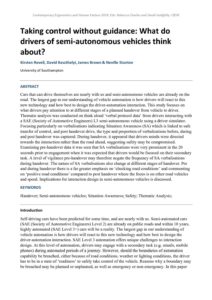
|
Author
Kirsten Revell, David Keszthelyi, James Brown & Neville Stanton |
Abstract
Cars that can drive themselves are nearly with us and semi-autonomous vehicles are already on the road. The largest gap in our understanding of vehicle automation is how drivers will react to this new technology and how best to design the driver-automation interaction. This study focuses on what drivers pay attention to at different stages of a planned handover from vehicle to driver. Thematic analysis was conducted on think aloud ‘verbal protocol data’ from drivers interacting with a SAE (Society of Automotive Engineers) L3 semi-autonomous vehicle using a driver simulator. Focusing particularly on verbalisations indicating Situation Awareness (SA) which is linked to safe transfer of control, and post handover drive, the type and proportion of verbalisations before, during and post handover was captured. During handover, it appeared that drivers minds were directed towards the interaction rather than the road ahead, suggesting safety may be compromised. Examining pre-handover data it was seen that SA verbalisations were very prominent in the 20 seconds prior to engagement when it was expected that drivers would be focused on their secondary task. A level of vigilance pre-handover may therefore negate the frequency of SA verbalisations during handover. The nature of SA verbalisations also change at different stages of handover. Pre and during handover there is a far greater emphasis on ‘checking road conditions’ and commenting on ‘positive road conditions’ compared to post handover where the focus is on other road vehicles and speed. Implications for interaction design in semi-autonomous vehicles is discussed. |
Publish Date: Apr 9, 2020 | Keywords: Autonomous vehicles, Cognition, Contemporary EHF 2020, Publications, Road safety, Task analysis, Tools & techniques
| Document
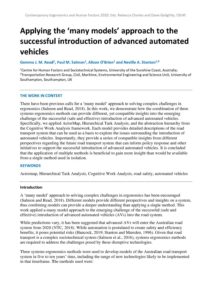
|
Author
Gemma J. M. Read, Paul M. Salmon, Alison O’Brien and Neville A. Stanton |
Abstract
There have been previous calls for a ‘many model’ approach to solving complex challenges in ergonomics (Salmon and Read, 2018). In this work, we demonstrate how the combination of three systems ergonomics methods can provide different, yet compatible insights into the emerging challenge of the successful (safe and effective) introduction of advanced automated vehicles. Specifically, we applied ActorMap, Hierarchical Task Analysis, and the abstraction hierarchy from the Cognitive Work Analysis framework. Each model provides detailed descriptions of the road transport system that can be used as a basis to explore the issues surrounding the introduction of automated vehicles. Importantly, they provide a series of compatible insights from different perspectives regarding the future road transport system that can inform policy response and other initiatives to support the successful introduction of advanced automated vehicles. It is concluded that the application of multiple methods is beneficial to gain more insight than would be available from a single method used in isolation. |
Publish Date: Oct 23, 2018 | Keywords: Autonomous vehicles, Contemporary EHF 2018, Publications, Situation awareness
| Document
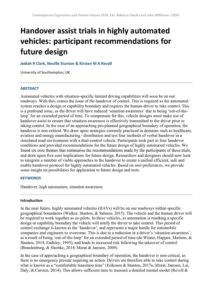
|
Author
Jediah R Clark, Neville Stanton & Kirsten M A Revell |
Abstract
Automated vehicles with situation-specific limited driving capabilities will soon be on our roadways. With this, comes the issue of the handover of control. This is required as the automated system reaches a design or capability boundary and requires the human-driver to take control. This is a profound issue, as the driver will have reduced ‘situation awareness’ due to being ‘out-of-the-loop’ for an extended period of time. To compensate for this, vehicle designs must make use of handover assist to ensure that situation awareness is effectively transmitted to the driver prior to taking control. In the case of an approaching pre-planned geographical boundary of operation, the handover is non-critical. We draw upon strategies currently practiced in domains such as healthcare, aviation and energy manufacturing / distribution and test four methods of verbal handover in a simulated road environment with a dual-control vehicle. Participants took part in four handover conditions and provided recommendations for the future design of highly automated vehicles. We found six core themes that summarise the recommendations made by the participants of these trials, and draw upon five core implications for future design. Researchers and designers should now look to integrate a number of viable approaches to the handover to create a unified efficient, safe and usable handover protocol for highly automated vehicles. Based on user preferences, we provide some insight on possibilities for application to future design and tests. |
Publish Date: Dec 18, 2018 | Keywords: Contemporary EHF 2017, Design, Healthcare, Publications, Situation awareness, Teamwork
| Document
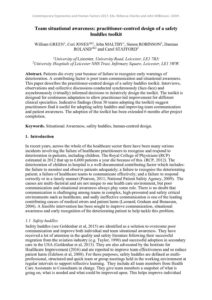
|
Author
William GREEN, Ceri JONES, John MALTBY, Simon ROBINSON, Damian ROLAND and Carol STAFFORD |
Abstract
Patients die every year because of failure to recognize early warnings of deterioration. A contributing factor is poor team communication and situational awareness. This paper describes the practitioner-centred design of a safety huddles toolkit. Interviews, observations and collective discussions conducted synchronously (face-face) and asynchronously (virtually) informed decisions to iteratively design the toolkit. The toolkit is designed for continuous adaptation to allow practitioner-led improvement for different clinical specialties. Indicative findings (from 50 teams adopting the toolkit) suggest practitioners find it useful for adopting safety huddles and improving team communication and patient awareness. The adoption of the toolkit has been extended 6 months after project completion. |
Publish Date: Mar 17, 2019 | Keywords: Contemporary EHF 2016, Mental health & wellbeing, Publications
| Document
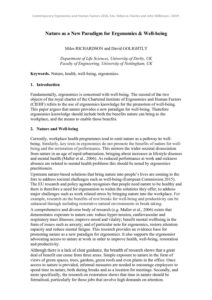
|
Author
Miles RICHARDSON and David GOLIGHTLY |
Abstract
|
Publish Date: Jun 24, 2022 | Keywords: Construction, Contemporary EHF 2022, Publications, Safety culture
| Document
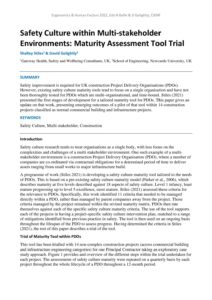
|
Author
Shelley Stiles & David Golightly |
Abstract
Safety improvement is required for UK construction Project Delivery Organisations (PDOs). However, existing safety culture maturity tools tend to focus on a single organisation and have not been thoroughly tested for PDOs which are multi-organisational, and time-bound. Stiles (2021) presented the first stages of development for a tailored maturity tool for PDOs. This paper gives an update on that work, presenting emerging outcomes of a pilot of that tool within 14 construction projects classified as normal commercial building and infrastructure projects. |
Publish Date: Mar 24, 2019 | Keywords: Contemporary EHF 2016, Health & Safety, Healthcare, Publications
| Document
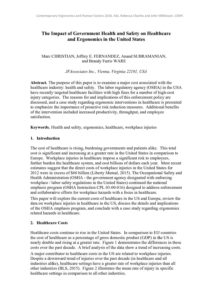
|
Author
Marc CHRISTIAN, Jeffrey E. FERNANDEZ, Anand SUBRAMANIAN, and Brandy Farris WARE |
Abstract
The purpose of this paper is to examine a major cost associated with the healthcare industry: health and safety. The labor regulatory agency (OSHA) in the USA have recently targeted healthcare facilities with high fines for a number of high-cost injury categories. The reasons for and implications of this enforcement policy are discussed, and a case study regarding ergonomic interventions in healthcare is presented to emphasize the importance of proactive risk reduction measures. Additional benefits of the intervention included increased productivity, throughput, and employee satisfaction. |
Publish Date: Apr 15, 2020 | Keywords: Aviation, Contemporary EHF 2020, Decision making, Design, Publications, Transport
| Document
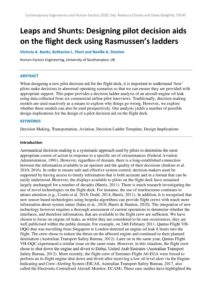
|
Author
Victoria A. Banks, Katherine L. Plant and Neville A. Stanton |
Abstract
When designing a new pilot decision aid for the flight deck, it is important to understand ‘how’ pilots make decisions in abnormal operating scenarios so that we can ensure they are provided with appropriate support. This paper provides a decision ladder analysis of an aircraft engine oil leak using data collected from six commercial airline pilot interviews. Traditionally, decision-making models are used reactively as a means to explore why things go wrong. However, we explore whether these models can also be used prospectively. Our analysis yields a number of possible design implications for the design of a pilot decision aid on the flight deck. |
Publish Date: Jun 12, 2023 | Keywords: Contemporary EHF 2023, Equality, diversity & inclusion (EDI), Healthcare, Publications, Safety
| Document
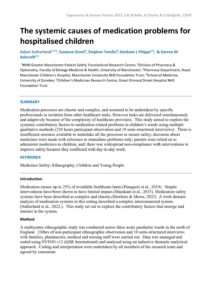
|
Author
Adam Sutherland, Suzanne Grant, Stephen Tomlin, Denham L Phipps, & Darren M Ashcroft |
Abstract
Medication processes are chaotic and complex, and assumed to be undertaken by specific professionals in isolation from other healthcare tasks. However tasks are delivered simultaneously and adaptively because of the complexity of healthcare provision. This study aimed to explore the systemic contributory factors to medication related problems in children’s wards using multiple qualitative methods (230 hours participant observation and 19 semi-structured interviews). There is insufficient resource available to undertake all the processes to ensure safety; decisions about medicines were made with reference to immediate problems only; parents were relied on to administer medicines to children, and; there was widespread non-compliance with interventions to improve safety because they conflicted with day-to-day work. |
Publish Date: Mar 17, 2019 | Keywords: Contemporary EHF 2016, Decision making, Publications
| Document
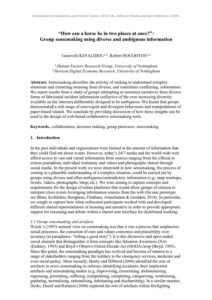
|
Author
Genovefa KEFALIDOU, Robert HOUGHTON |
Abstract
Sensemaking describes the activity of seeking to understand complex situations and extracting meaning from diverse, and sometimes conflicting, information. We report results from a study of groups attempting to construct narratives from diverse forms of fabricated incident information (reflective of the ever increasing diversity available on the internet) deliberately designed to be ambiguous. We found that groups demonstrated a rich range of convergent and divergent behaviours and manipulations of paper-based stimuli. We conclude by providing discussion of how these insights can be used in the design of web-based collaborative sensemaking tools. |
Publish Date: Feb 27, 2019 | Keywords: Contemporary EHF 2016, Cybersecurity, Manufacturing, Publications, Technology
| Document
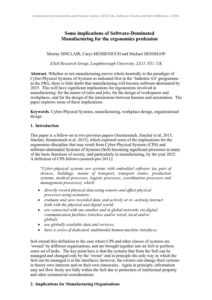
|
Author
Murray SINCLAIR, Carys SIEMIENIUCH and Michael HENSHAW |
Abstract
Whether or not manufacturing moves whole-heartedly to the paradigm of Cyber-Physical Systems of Systems as indicated first in the ‘Industrie 4.0’ programme in the FRG, there is little doubt that manufacturing will become software-dominated by 2025. This will have significant implications for ergonomists involved in manufacturing: for the nature of roles and jobs, for the design of workspaces and workplaces, and for the design of the interactions between humans and automation. The paper explores some of these implications. |
Publish Date: Oct 30, 2018 | Keywords: Contemporary EHF 2017, Manufacturing, Musculoskeletal, Publications
| Document
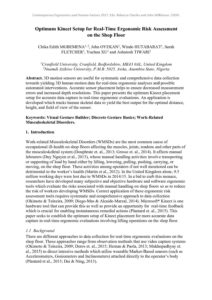
|
Author
Chika Edith MGBEMENA, John OYEKAN, Windo HUTABARAT, Sarah FLETCHER, Yuchun XU and Ashutosh TIWARI |
Abstract
3D motion sensors are useful for systematic and comprehensive data collection towards yielding 3D human motion data for real-time ergonomic analyses and possible automated interventions. Accurate sensor placement helps to ensure decreased measurement errors and increased depth resolutions. This paper presents the optimum Kinect placement setup for accurate data capture in real-time ergonomic evaluations. An application is developed which tracks human skeletal data to yield the best output for the optimal distance, height, and field of view of the sensor. |
Publish Date: Jun 3, 2024 | Keywords: Aviation, Contemporary EHF 2024, Human factors integration, Publications
| Document
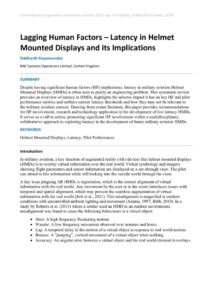
|
Author
Siddharth Shyamsundar |
Abstract
Despite having significant human factors (HF) implications, latency in military aviation Helmet Mounted Displays (HMDs) is often seen as purely an engineering problem. This systematic review provides an overview of latency in HMDs, highlights the adverse impact it has on key HF and pilot performance metrics and outlines current latency thresholds and how they may not be relevant to the military aviation context. Drawing from extant literature, this paper provides recommendations for HF involvement, research and technology application in the development of low latency HMDs. It serves as a call to action, promoting significant HF involvement within a multidisciplinary, collaborative approach to exploring latency in the development of future military aviation HMDs. |
Publish Date: May 30, 2024 | Keywords: Aviation, Comfort, Contemporary EHF 2024, Publications
| Document
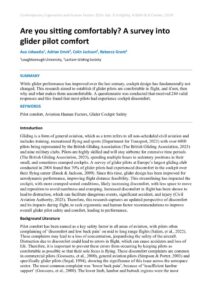
|
Author
Ava Udwadia1, Adrian Emck2, Colin Jackson2, Rebecca Grant1 |
Abstract
While glider performance has improved over the last century, cockpit design has fundamentally not changed. This research aimed to establish if glider pilots are comfortable in flight, and if not, then why and what makes them uncomfortable. A questionnaire was conducted that received 244 valid responses and this found that most pilots had experience cockpit discomfort. |
Publish Date: Apr 17, 2020 | Keywords: Contemporary EHF 2020, Publications, Sociotechnical systems, Systems
| Document
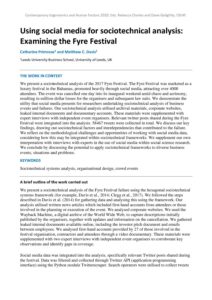
|
Author
Catherine Primrose and Matthew C. Davis |
Abstract
We present a sociotechnical analysis of the 2017 Fyre Festival. The Fyre Festival was marketed as a luxury festival in the Bahamas, promoted heavily through social media, attracting over 4000 attendees. The event was cancelled one day into its inaugural weekend amid chaos and acrimony, resulting in million-dollar losses for the organisers and subsequent law suits. We demonstrate the utility that social media presents for researchers undertaking sociotechnical analysis of business events and failures. Our sociotechnical analysis utilised archival materials, corporate websites, leaked internal documents and documentary accounts. These materials were supplemented with expert interviews with independent event organisers. Relevant twitter posts shared during the Fyre Festival were integrated into the analysis. 58467 tweets were collected in total. We discuss our key findings, drawing out sociotechnical factors and interdependencies that contributed to the failure. We reflect on the methodological challenges and opportunities of working with social media data, considering how this may be integrated within sociotechnical frameworks. We supplement our own interpretation with interviews with experts in the use of social media within social science research. We conclude by discussing the potential to apply sociotechnical frameworks to diverse business events, situations and problems. |
Publish Date: Jun 23, 2022 | Keywords: Aviation, Contemporary EHF 2022, Interface design, Publications, Usability
| Document
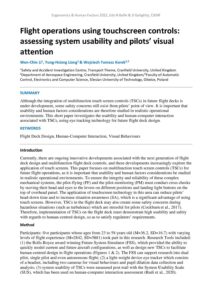
|
Author
Wen-Chin Li, Yung-Hsiang Liang & Wojciech Tomasz Korek |
Abstract
Although the integration of multifunction touch screen controls (TSCs) in future flight decks is under development, some safety concerns still exist from pilots’ point of view. It is important that usability and human factors considerations are therefore studied in realistic operational environments. This short paper investigates the usability and human-computer interaction associated with TSCs, using eye tracking technology for future flight deck design. |
Publish Date: Sep 8, 2019 | Keywords: Contemporary EHF 2019, Human performance, Publications, Rail
| Document
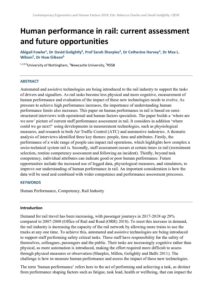
|
Author
Abigail Fowler, Dr David Golightly, Prof Sarah Sharples, Dr Catherine Harvey, Dr Max L. Wilson, Dr Huw Gibson |
Abstract
Automated and assistive technologies are being introduced to the rail industry to support the tasks of drivers and signallers. As rail tasks become less physical and more cognitive, measurement of human performance and evaluation of the impact of these new technologies needs to evolve. As pressure to achieve high performance increases, the importance of understanding human performance limits also increases. This paper on human performance in rail is based on semi-structured interviews with operational and human factors specialists. The paper builds a ‘where are we now’ picture of current staff performance assessment in rail. It considers in addition ‘where could we go next?’ using developments in measurement technologies, such as physiological measures, and research in both Air Traffic Control (ATC) and automotive industries. A thematic analysis of interviews identified three key themes: people, time and attributes. Firstly, the performance of a wide range of people can impact rail operations, which highlights how complex a socio-technical system rail is. Secondly, staff assessment occurs at certain times in rail (recruitment selection, routine competency assessment and following an incident). Thirdly, beyond task competency, individual attributes can indicate good or poor human performance. Future opportunities include the increased use of logged data, physiological measures, and simulators, to improve our understanding of human performance in rail. An important consideration is how the data will be used and combined with wider competence and performance assessment processes. |
Publish Date: Aug 11, 2021 | Keywords: Automotive, Comfort, Comfort Congress 2021, Publications
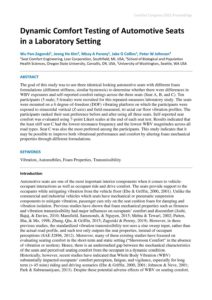 |
Author
Wu Pan-Zagorski, Jeong Ho Kim, Missy A Pereny, Jake G Collins & Peter W Johnson |
Abstract
The goal of this study was to use three identical looking automotive seats with different foam formulations (different stiffness, similar hysteresis) to determine whether there were differences in WBV exposures and self-reported comfort ratings across the three seats (Seat A, B, and C). Ten participants (5 male; 5 female) were recruited for this repeated-measures laboratory study. The seats were mounted on a 6 degree-of-freedom (DOF) vibrating platform on which the participants were exposed to sinusoidal vertical (Z-axis) and field-measured, tri-axial car floor vibration profiles. The participants ranked their seat preference before and after using all three seats. Self-reported seat comfort was evaluated using 7-point Likert scales at the end of each seat test. Results indicated that the least stiff seat C had the lowest resonance frequency and the lowest WBV magnitudes across all road types. Seat C was also the most preferred among the participants. This study indicates that it may be possible to improve both vibrational performance and comfort by altering foam mechanical properties through different formulations. |
Publish Date: Apr 8, 2021 | Keywords: Contemporary EHF 2021, Healthcare, Pandemic, Publications, SEIPS, Systems
| Document
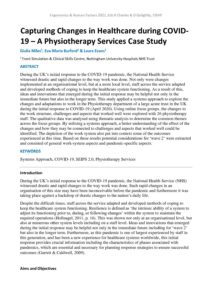
|
Author
Giulia Miles, Eva-Maria Burford & Laura Evans |
Abstract
During the UK’s initial response to the COVID-19 pandemic, the National Health Service witnessed drastic and rapid changes to the way work was done. Not only were changes implemented at an organisational level, but at a more local level, staff across the service adapted and developed methods of coping to keep the healthcare system functioning. As a result of this, ideas and innovations that emerged during the initial response may be helpful not only in the immediate future but also in the longer term. This study applied a systems approach to explore the changes and adaptations to work in the Physiotherapy department of a large acute trust in the UK during the initial response to COVID-19 (April 2020). Using online focus groups, the changes to the work structure, challenges and aspects that worked well were explored with 26 physiotherapy staff. The qualitative data was analysed using thematic analysis to determine the common themes across the focus groups. By utilising a systems approach, a better understanding of the effect of the changes and how they may be connected to challenges and aspects that worked well could be identified. The depiction of the work system also put into context some of the outcomes experienced at this time. Based on these results potential considerations for ‘wave 2’ were extracted and consisted of general work-system aspects and pandemic-specific aspects. |
Publish Date: Oct 23, 2018 | Keywords: Automotive, Contemporary EHF 2018, Publications, Technology
| Document
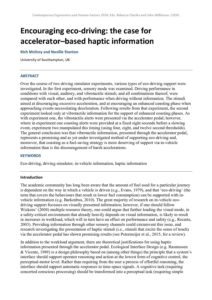
|
Author
Rich McIlroy and Neville Stanton |
Abstract
Over the course of two driving simulator experiments, various types of eco-driving support were investigated. In the first experiment, sensory mode was examined. Driving performance in conditions with visual, auditory, and vibrotactile stimuli, and all combinations thereof, were compared with each other, and with performance when driving without information. The stimuli aimed at discouraging excessive acceleration, and at encouraging an enhanced coasting phase when approaching events necessitating deceleration. Following results from that experiment, the second experiment looked only at vibrotactile information for the support of enhanced coasting phases. As with experiment one, the vibrotactile alerts were presented via the accelerator pedal; however, where in experiment one coasting alerts were provided at a fixed eight seconds before a slowing event, experiment two manipulated this timing (using four, eight, and twelve second thresholds). The general conclusion was that vibrotactile information, presented through the accelerator pedal, represents a promising and as yet under investigated method of supporting eco-driving and, moreover, that coasting as a fuel-saving strategy is more deserving of support via in-vehicle information than is the discouragement of harsh accelerations. |
Publish Date: Apr 16, 2020 | Keywords: Contemporary EHF 2020, Publications, Resilience, Systems
| Document
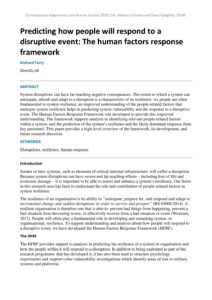
|
Author
Richard Farry |
Abstract
System disruptions can have far reaching negative consequences. The extent to which a system can anticipate, absorb and adapt to a disruption is a characteristic of its resilience. As people are often fundamental to system resilience, an improved understanding of the people-related factors that underpin system resilience helps in predicting system vulnerability and the response to a disruptive event. The Human Factors Response Framework was developed to provide this improved understanding. The framework supports analysts in identifying relevant people-related factors within a system, and the prediction of the system’s resilience and the likely dominant response from key personnel. This paper provides a high-level overview of the framework, its development, and future research direction. |
Publish Date: Jun 3, 2024 | Keywords: Contemporary EHF 2024, Defence, Design, Organisational design, Publications
| Document
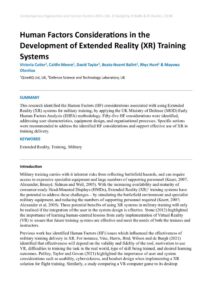
|
Author
Victoria Cutler, Caitlin Moore, David Taylo, Beata-Noemi Balint, Rhys Hunt & Mayowa Olonilua |
Abstract
This research identified the Human Factors (HF) considerations associated with using Extended Reality (XR) systems for military training, by applying the UK Ministry of Defence (MOD) Early Human Factors Analysis (EHFA) methodology. Fifty-five HF considerations were identified, addressing user characteristics, equipment design, and organisational processes. Specific actions were recommended to address the identified HF considerations and support effective use of XR in training delivery. |
Publish Date: Jun 11, 2025 | Keywords: Contemporary EHF 2025, Medical Devices, Patient Safety, Publications, Technology
| Document
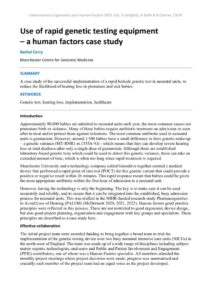
|
Author
Rachel Corry |
Abstract
A case study of the successful implementation of a rapid bedside genetic test in neonatal units, to reduce the likelihood of hearing loss in premature and sick babies. |
Publish Date: May 27, 2025 | Keywords: Artificial intelligence, Contemporary EHF 2025, Education, training & skills, Publications
| Document
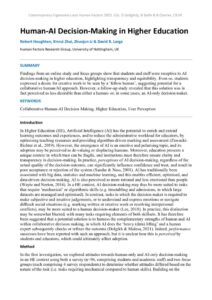
|
Author
Robert Houghton, Xinrui Zhai, Zhuojun Li & David R. Large |
Abstract
Findings from an online study and focus groups show that students and staff were receptive to AI decision-making in higher education, highlighting transparency and equitability. Even so, students expressed a desire for creative work to be seen by a ‘fellow human’, suggesting potential for a collaborative human/AI approach. However, a follow-up study revealed that this solution was in fact perceived as less desirable than either a human- or, in some cases, an AI-only decision maker. |
Publish Date: Oct 30, 2018 | Keywords: Contemporary EHF 2017, Healthcare, Musculoskeletal, Publications
| Document
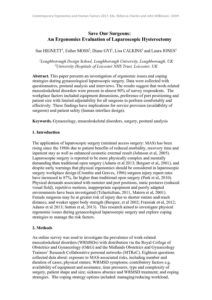
|
Author
Sue HIGNETT, Esther MOSS, Diane GYI, Lisa CALKINS and Laura JONES |
Abstract
This paper presents an investigation of ergonomic issues and coping strategies during gynaecological laparoscopic surgery. Data were collected with questionnaires, postural analysis and interviews. The results suggest that work-related musculoskeletal disorders were present in almost 90% of survey respondents. The workplace factors included equipment dimensions, preference of port positioning and patient size with limited adjustability for all surgeons to perform comfortably and effectively. These findings have implications for service provision (availability of surgeons) and patient safety (human interface design). |
Publish Date: Jun 3, 2024 | Keywords: Contemporary EHF 2024, Energy, Human factors integration, Publications
| Document
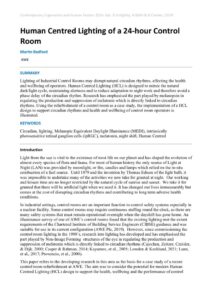
|
Author
Martin Redford |
Abstract
Lighting of Industrial Control Rooms may disrupt natural circadian rhythms, affecting the health and wellbeing of operators. Human Centred Lighting (HCL) is designed to mimic the natural dark/light cycle, maintaining alertness and to reduce adaptation to night work and therefore avoid a phase delay of the circadian rhythm. Research has emphasised the part played by melanopsin in regulating the production and suppression of melatonin which is directly linked to circadian rhythms. Using the refurbishment of a control room as a case study, the implementation of a HCL design to support circadian rhythms and health and wellbeing of control room operators is illustrated. |
Publish Date: Aug 6, 2021 | Keywords: Comfort, Comfort Congress 2021, Equality, diversity & inclusion (EDI), Publications
| Document
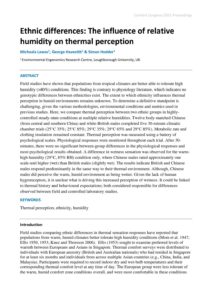
|
Author
Micheala Lawes, George Havenith & Simon Hodder |
Abstract
A protocol was developed to test theoretical assumptions associated with the interrelationship between thermal sensation, thermal discomfort, and physical contact temperatures in humans. To achieve this, perceptual responses (thermal sensation and thermal discomfort) to the application of seventeen absolute physical temperatures, ranging from cold to hot (18 - 42°C) were examined. In addition, the present study tested the confidence of participants in their thermal sensation ratings also, across a wide spectrum of thermal stimuli. Seventeen Western European university students volunteered and consented to participate in the study. The location of the application of the probe was marked on their skin, ensuring consistent application across temperatures, and all participants were blinded to the environment conditions, as well as the temperature of thermal probe controller unit, to avoid expectation bias. Physical temperatures were applied with a conductive thermal probe (Physitemp Instruments Inc., USA) consisting of a 25 cm2 metal surface, applied with a pressure of 4 kPa, in a mixed counterbalanced order. The probe was applied to the skin for 10 seconds for all applications, at the end of which participants rated their local thermal sensation, the confidence of thermal sensation, and local thermal discomfort. A recovery time between thermal probe applications of at least 20 seconds was used. Local skin temperature has been reported to have returned to its baseline value using a single spot infrared thermometer (FLUKE 566, Fluke Corporation, USA) prior to each subsequent thermal probe application. |
Publish Date: Mar 24, 2019 | Keywords: Contemporary EHF 2016, Publications, Technology
| Document
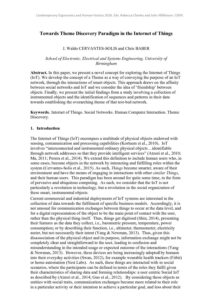
|
Author
J. Waldo CERVANTES-SOLIS and Chris BABER |
Abstract
In this paper, we present a novel concept for exploring the Internet of Things (IoT). We develop the concept of a Theme as a way of conveying the purpose of an IoT network, through the interactions of smart objects. This approach draws on the affinity between social networks and IoT and we consider the idea of ‘friendship’ between objects. Finally, we present the initial findings from a study involving a collection of instrumented objects and the identification of sequences and patterns in their data towards establishing the overarching theme of that test-bed network. |
Publish Date: Jun 24, 2022 | Keywords: Artificial intelligence, Contemporary EHF 2022, Publications, Sociotechnical systems, Technology
| Document
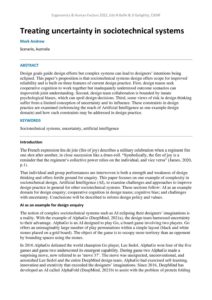
|
Author
Mark Andrew |
Abstract
Design goals guide design efforts but complex systems can lead to designers’ intentions being eclipsed. This paper’s proposition is that sociotechnical systems design offers scope for improved reliability and is built on three features of current design practice. First, design teams seek cooperative cognition to work together but inadequately understood outcome scenarios can impoverish joint understanding. Second, design team collaboration is bounded by innate psychological biases, which can spoil design decisions. Third, some views of risk in design thinking suffer from a limited conception of uncertainty and its influence. These constraints in design practice are examined (referencing the reach of Artificial Intelligence as one example design domain) and how such constraints may be addressed in design practice. |
Publish Date: Sep 8, 2019 | Keywords: Aviation, Contemporary EHF 2019, Perception, Publications, Risk assessment, Safety
| Document
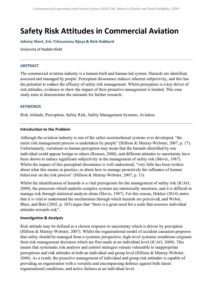
|
Author
Johnny Short, Eric Tchouamou Njoya & Nick Hubbard |
Abstract
The commercial aviation industry is a human-built and human-led system. Hazards are identified, assessed and managed by people. Perceptual dissonance induces inherent subjectivity, and this has the potential to reduce the efficacy of safety risk management. Whilst perception is a key driver of risk attitudes, evidence to show the impact of their proactive management is limited. This case study aims to demonstrate the rationale for further research. |
Publish Date: Sep 8, 2019 | Keywords: Contemporary EHF 2019, Publications, Rail
| Document
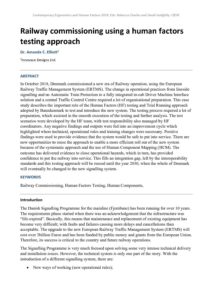
|
Author
Dr. Amanda C. Elliott |
Abstract
In October 2018, Denmark commissioned a new era of Railway operation, using the European Railway Traffic Management System (ERTMS). The change in operational practices from lineside signalling and no Automatic Train Protection to a fully integrated in-cab Driver Machine Interface solution and a central Traffic Control Centre required a lot of organisational preparation. This case study describes the important role of the Human Factors (HF) testing and Trial Running approach adopted by Banedanmark to test and introduce the new system. The testing process required a lot of preparation, which assisted in the smooth execution of the testing and further analysis. The test scenarios were developed by the HF team, with test responsibility also managed by HF coordinators. Any negative findings and outputs were fed into an improvement cycle which highlighted where technical, operational rules and training changes were necessary. Positive findings were used to provide evidence that the system would be safe to put into service. There are now opportunities to reuse the approach to enable a more efficient roll out of the new system because of the systematic approach and the use of Human Component Mapping (HCM). The outcome has delivered evidence to close operational hazards, which in turn, has provided confidence to put the railway into service. This fills an integration gap, left by the interoperability standards and this testing approach will be reused until the year 2030, when the whole of Denmark will eventually be changed to the new signalling system. |
Publish Date: May 27, 2025 | Keywords: Automotive, Autonomous vehicles, Contemporary EHF 2025, Publications, Road safety
| Document
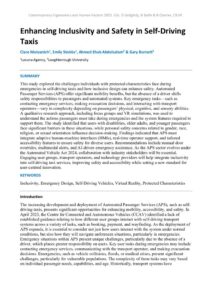
|
Author
Clare Mutzenich, Emily Stobbs, Ahmed Ehab Abdelsalam & Gary Burnett |
Abstract
This study explored the challenges individuals with protected characteristics face during emergencies in self-driving taxis and how inclusive design can enhance safety. Automated Passenger Services (APS) offer significant mobility benefits, but the absence of a driver shifts safety responsibilities to passengers and automated systems. Key emergency tasks—such as contacting emergency services, making evacuation decisions, and interacting with transport operators—vary in complexity depending on passengers’ physical, cognitive, and sensory abilities. A qualitative research approach, including focus groups and VR simulations, was used to understand the actions passengers must take during emergencies and the system features required to support them. The study identified that users with disabilities, older adults, and younger passengers face significant barriers in these situations, while personal safety concerns related to gender, race, religion, or sexual orientation influence decision-making. Findings indicated that APS must integrate adaptive human-machine interfaces (HMIs), real-time operator support, and tailored accessibility features to ensure safety for diverse users. Recommendations include manual door overrides, multimodal alerts, and AI-driven emergency assistance. As the APS sector evolves under the Automated Vehicle Act 2024, collaboration with industry stakeholders will be essential. Engaging user groups, transport operators, and technology providers will help integrate inclusivity into self-driving taxi services, improving safety and accessibility while setting a new standard for user-centred innovation. |
Publish Date: Apr 15, 2020 | Keywords: Artificial intelligence, Contemporary EHF 2020, Decision making, Human-machine interaction, Publications
| Document
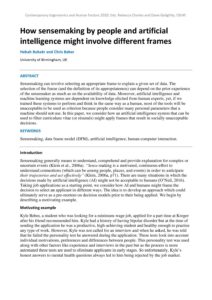
|
Author
Hebah Bubakr and Chris Baber |
Abstract
Sensemaking can involve selecting an appropriate frame to explain a given set of data. The selection of the frame (and the definition of its appropriateness) can depend on the prior experience of the sensemaker as much as on the availability of data. Moreover, artificial intelligence and machine learning systems are dependent on knowledge elicited from human experts, yet, if we trained these systems to perform and think in the same way as a human, most of the tools will be unacceptable to be used as criterion because people consider many personal parameters that a machine should not use. In this paper, we consider how an artificial intelligence system that can be used to filter curriculum vitae (or résumés) might apply frames that result in socially unacceptable decisions. |
Publish Date: Jun 22, 2022 | Keywords: Climate change, Contemporary EHF 2022, Office ergonomics, Publications
| Document
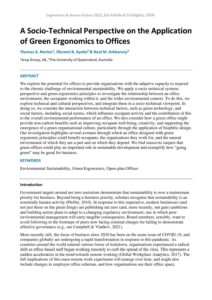
|
Author
Thomas A. Norton, Oluremi B. Ayoko & Neal M. Ashkanasy |
Abstract
We explore the potential for offices to provide organisations with the adaptive capacity to respond to the chronic challenge of environmental sustainability. We apply a socio-technical systems perspective and green ergonomics principles to investigate the relationship between an office environment, the occupants working within it, and the wider environmental context. To do this, we explore technical and cultural perspectives, and integrate these in a socio-technical viewpoint. In doing so, we consider the interaction between technical factors, such as green technology, and social factors, including social norms, which influence occupant activity and the contribution of this to the overall environmental performance of an office. We also consider how a green office might provide non-carbon benefits such as improving occupant well-being, creativity, and supporting the emergence of a green organisational culture, particularly through the application of biophilic design. Our investigation highlights several avenues through which an office designed with green ergonomic principles could benefit occupants, the organisations they work for, and the natural environment of which they are a part and on which they depend. We find reason to suspect that green offices could play an important role in sustainable development and exemplify how “going green” may be good for business. |
Publish Date: Apr 9, 2021 | Keywords: Artificial intelligence, Contemporary EHF 2021, Decision making, Publications
| Document
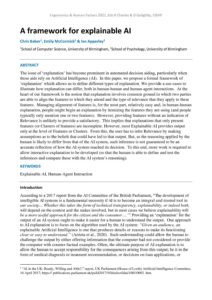
|
Author
Chris Baber, Emily McCormick & Ian Apperley |
Abstract
The issue of ‘explanation’ has become prominent in automated decision aiding, particularly when those aids rely on Artificial Intelligence (AI). In this paper, we propose a formal framework of ‘explanation’ which allows us to define different types of explanation. We provide a use-cases to illustrate how explanation can differ, both in human-human and human-agent interactions. At the heart of our framework is the notion that explanation involves common ground in which two parties are able to align the features to which they attend and the type of relevance that they apply to these features. Managing alignment of features is, for the most part, relatively easy and, in human-human explanation, people might begin an explanation by itemizing the features they are using (and people typically only mention one or two features). However, providing features without an indication of Relevance is unlikely to provide a satisfactory. This implies that explanations that only present features (or Clusters of features) are incomplete. However, most Explainable AI provides output only at the level of Features or Clusters. From this, the user has to infer Relevance by making assumptions as to the beliefs that could have led to that output. But, as the reasoning applied by the human is likely to differ from that of the AI system, such inference is not guaranteed to be an accurate reflection of how the AI system reached its decision. To this end, more work is required to allow interactive explanation to be developed (so that the human is able to define and test the inferences and compare these with the AI system’s reasoning). |
Publish Date: Oct 23, 2018 | Keywords: Contemporary EHF 2018, Publications, Technology, Usability
| Document
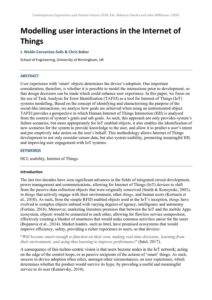
|
Author
J. Waldo Cervantes-Solis & Chris Baber |
Abstract
User experience with ‘smart’ objects determines the device’s adoption. One important consideration, therefore, is whether it is possible to model the interactions prior to development, so that design decisions can be made which could enhance user experience. In this paper, we focus on the use of Task Analysis for Error Identification (TAFEI) as a tool for Internet of Things (IoT) systems modelling. Based on the concept of identifying and characterising the purpose of the social-like interactions, we analyse how goals are achieved when using an instrumented object. TAFEI provides a perspective in which Human-Internet of Things Interaction (HII) is analysed from the context of system’s goals and sub goals. As such, this approach not only provides system’s failure scenarios, but more appropriately for IoT enabled objects, it also enables the identification of new scenarios for the system to provide knowledge to the user, and allow it to predict a user’s intent and pre-emptively take action on the user’s behalf. This methodology allows Internet of Things development to not only consider sensor data, but also system usability, promoting meaningful HII, and improving user engagement with IoT systems. |
Publish Date: May 27, 2025 | Keywords: Contemporary EHF 2025, Defence, Publications, Risk assessment, Safety
| Document
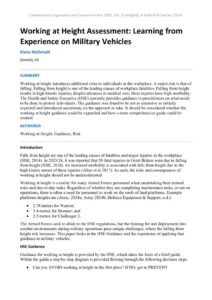
|
Author
Elaine McDonald |
Abstract
Working at height introduces additional risks to individuals in the workplace. A major risk is that of falling. Falling from height is one of the leading causes of workplace fatalities. Falling from height results in high kinetic injuries; despite advances in medical care, these injuries have high morbidity. The Health and Safety Executive (HSE) currently provides guidance to practitioners on what needs to be done to protect individuals. The guidance was found to be not as extensive as initially expected and introduced uncertainty on the approach to take. It should be considered whether the working at height guidance could be expanded and how a more comprehensive guide could be created. |
Publish Date: Sep 7, 2019 | Keywords: Contemporary EHF 2019, Publications
| Document
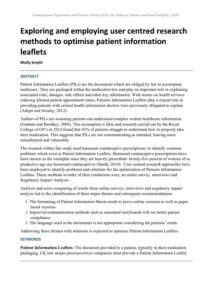
|
Author
Molly Smyth |
Abstract
Patient Information Leaflets (PILs) are the documents which are obliged by law to accompany medicines. They are packaged within the medication box and play an important role in explaining associated risks, dosages, side effects and other key information. With strains on health services reducing allotted patient appointment times, Patients Information Leaflets play a crucial role in providing patients with critical health information doctors were previously obligated to explain (Adepu and Swamy, 2012). Authors of PILs are assuming patients can understand complex written healthcare information (Graham and Brookey, 2008). This assumption is false and research carried out by the Royal College of GP’s in 2014 found that 42% of patients struggle to understand how to properly take their medication. This suggests that PILs are not communicating as intended, leaving users misinformed and vulnerable. The research within this study used hormonal contraceptive prescriptions, to identify common problems which exist in Patient Information Leaflets. Hormonal contraceptive prescriptions have been chosen as the exemplar since they are heavily prescribed- twenty-five percent of women of re-productive age use hormonal contraceptives (Smith, 2010). User centred research approaches have been employed to identify problems and solutions for the optimisation of Patients Information Leaflets. These methods in order of their conduction were, an online survey, interviews and Regulatory Impact Analysis. Analysis and cross comparing of results from online surveys, interviews and regulatory impact analysis led to the identification of three major themes and subsequent recommendations. 1. The formatting of Patient Information Sheets needs to prove online versions as well as paper based versions. 2. Improved communication methods such as annotated storyboards will see better patient compliance. 3. The language used in the documents is not appropriate considering the patients’ needs. Addressing these themes with solutions is expected to optimise Patient Information Leaflets. |
Publish Date: Feb 27, 2019 | Keywords: Contemporary EHF 2016, Data, Publications, Safety, Safety culture
| Document
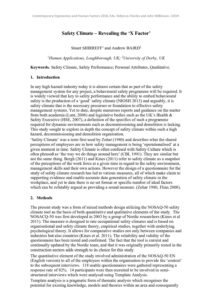
|
Author
Stuart SHIRREFF and Andrew BAIRD |
Abstract
|
Publish Date: Mar 25, 2019 | Keywords: Contemporary EHF 2016, Healthcare, Mental health & wellbeing, Patient Safety, Publications, Systems
| Document
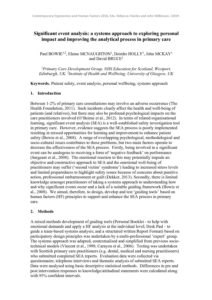
|
Author
Paul BOWIE, Elaine MCNAUGHTON, Deirdre HOLLY, John MCKAY and David BRUCE |
Abstract
|
Publish Date: Jun 23, 2022 | Keywords: Automotive, Contemporary EHF 2022, Perception, Publications, User experience
| Document
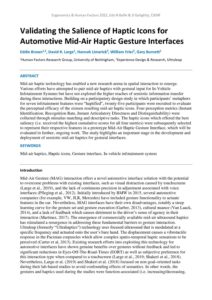
|
Author
Eddie Brown, David R. Large, Hannah Limerick, William Frier & Gary Burnett |
Abstract
Mid-air haptic technology has enabled a new research arena in spatial interaction to emerge. Various efforts have attempted to pair mid-air haptics with gestural input for In-Vehicle Infotainment Systems but have not explored the higher reaches of semiotic information transfer during these interactions. Building on a participatory design study in which participants’ metaphors for seven infotainment features were “haptified”, twenty-five participants were recruited to evaluate the perceptual efficacy of the sixteen resulting mid-air haptic icons. Four perception metrics (Instant Identification, Recognition Rate, Instant Articulatory Directness and Distinguishability) were collected through stimulus matching and descriptive tasks. The haptic icons which offered the best saliency (i.e. received the highest cumulative scores for all four metrics) were subsequently selected to represent their respective features in a prototype Mid-Air Haptic Gesture Interface, which will be evaluated in further, ongoing work. The study highlights an important stage in the development and deployment of semiotic mid-air haptics for gestural interfaces. |
Publish Date: Jun 3, 2024 | Keywords: Contemporary EHF 2024, Incidents, Publications, Risk assessment, Systems
| Document
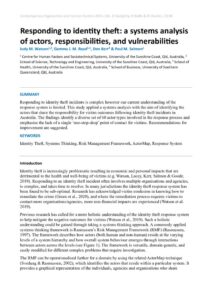
|
Author
Judy M. Watson, Gemma J. M. Read, Don Kerr & Paul M. Salmon |
Abstract
Responding to identity theft incidents is complex however our current understanding of the response system is limited. This study applied a systems analysis with the aim of identifying the actors that share the responsibility for victim outcomes following identity theft incidents in Australia. The findings identify a diverse set of 60 actor types involved in the response process and emphasise the lack of a single ‘one-stop-shop’ point of contact for victims. Recommendations for improvement are suggested. |
Publish Date: May 27, 2025 | Keywords: Automation, Automotive, Contemporary EHF 2025, Human-machine interaction, Publications
| Document
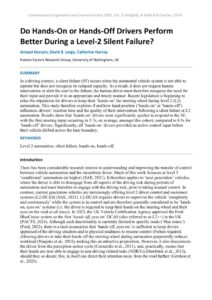
|
Author
Amaad Hussain, David R. Large, Catherine Harvey |
Abstract
In a driving context, a silent failure (SF) occurs when the automated vehicle system is not able to operate but does not recognise its reduced capacity. As a result, it does not request human intervention or alert the user to the failure; the human driver must therefore recognise the need for their input and provide it in an appropriate and timely manner. Recent legislation is beginning to relax the stipulation for drivers to keep their ‘hands-on’ the steering wheel during level 2 (L2) automation. This study therefore explores if and how hand position (‘hands-on’ or ‘hands-off’) influences drivers’ reaction time and the quality of their intervention following a silent failure at L2 automation. Results show that ‘hands-on’ drivers were significantly quicker to respond to the SF, with the first steering input occurring in 3.7s, on average, amongst this cohort, compared to 8.5s for ‘hands-off’ drivers. Significantly, all ‘hands-on’ drivers provided an active control input before their vehicle drifted across the lane boundary. |
Publish Date: May 30, 2024 | Keywords: Contemporary EHF 2024, Human performance, Non-technical skills, Publications
| Document
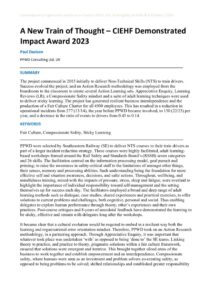
|
Author
Paul Davison |
Abstract
The project commenced in 2015 initially to deliver Non-Technical Skills (NTS) to train drivers. Success evolved the project, and an Action Research methodology was employed from the boardroom to the classroom to create several Action Learning sets. Appreciative Enquiry, Learning Reviews (LR), a Compassionate Safety mindset and a suite of adult learning techniques were used to deliver sticky learning. The project has generated resilient business interdependence and the production of a Fair Culture Charter for all 4500 employees. This has resulted in a reduction in operational incidents from 277 (13/14), the year before PPWD became involved, to 150 (22/23) per year, and a decrease in the ratio of events to drivers from 0.43 to 0.14. |
Publish Date: Aug 10, 2021 | Keywords: Aviation, Comfort Congress 2021, Publications, Seating
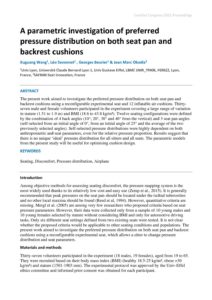 |
Author
Xuguang Wang, Léo Savonnet , Georges Beurier & Jean Marc Obadia |
Abstract
The present work aimed to investigate the preferred pressure distribution on both seat pan and backrest cushions using a reconfigurable experimental seat and 12 inflatable air cushions. Thirty-seven male and female volunteers participated in the experiment covering a large range of variation in stature (1.51 to 1.9 m) and BMI (18.6 to 43.8 kg/m²). Twelve seating configurations were defined by the combination of 4 back angles (10°; 20°, 30° and 40° from the vertical) and 3 seat pan angles (self-selected from an initial angle of 0°, from an initial angle of 25° and the average of the two previously selected angles). Self-selected pressure distributions were highly dependent on both anthropometric and seat parameters, even for the relative pressure proportion. Results suggest that there is no unique ‘ideal’ pressure distribution for all sitters and all seats. The parametric models from the present study will be useful for optimising cushion design. |
Publish Date: Jun 23, 2022 | Keywords: Autonomous vehicles, Aviation, Contemporary EHF 2022, Publications
| Document
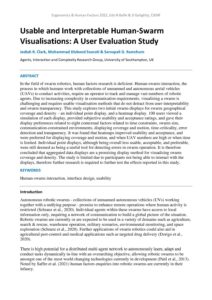
|
Author
Jediah R. Clark, Mohammad Divband Soorati & Sarvapali D. Ramchurn |
Abstract
In the field of swarm robotics, human factors research is deficient. Human-swarm interaction, the process in which humans work with collections of unmanned and autonomous aerial vehicles (UAVs) to conduct activities, require an operator to track and manage vast numbers of robotic agents. Due to increasing complexity in communication requirements, visualising a swarm is challenging and requires usable visualisation methods that do not detract from user-interpretability and swarm transparency. This study explores two initial swarm-displays for swarm geographical coverage and density – an individual point display, and a heatmap display. 100 users viewed a simulation of each display, provided subjective usability and acceptance ratings, and gave their display preferences related to eight contextual factors related to time constraints, swarm size, communication-constrained environments, displaying coverage and motion, time-criticality, error detection and transparency. It was found that heatmaps improved usability and acceptance, and were preferred for displaying coverage and motion, and when UAV numbers are high or when time is limited. Individual point displays, although being overall less usable, acceptable, and preferable, were still deemed as being a useful tool for detecting errors in swarm operation. It is therefore concluded that aggregated data displays are a promising display method for visualising swarm coverage and density. The study is limited due to participants not being able to interact with the displays, therefore further research is required to further test the effects reported in this study. |
Publish Date: Jun 11, 2025 | Keywords: Contemporary EHF 2025, Design, Medical Devices, Publications
| Document
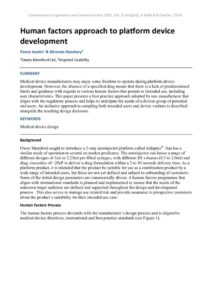
|
Author
Finola Austin & Miranda Newbery |
Abstract
Medical device manufacturers may enjoy some freedom to operate during platform device development. However, the absence of a specified drug means that there is a lack of predetermined limits and guidance with regards to various human factors that pertain to intended use, including user characteristics. This paper presents a best practice approach adopted by one manufacturer that aligns with the regulatory process and helps to anticipate the needs of a diverse group of potential end users. An inclusive approach to sampling both intended users and device variants is described alongside the resulting design decisions. |
Publish Date: Apr 17, 2020 | Keywords: Contemporary EHF 2020, Design, Healthcare, Publications, Systems
| Document
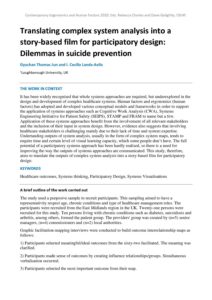
|
Author
Gyuchan Thomas Jun and I. Cecilia Landa-Avila |
Abstract
It has been widely recognised that whole systems approaches are required, but underexplored in the design and development of complex healthcare systems. Human factors and ergonomics (human factors) has adopted and developed various conceptual models and frameworks in order to support the application of systems approaches such as Cognitive Work Analysis (CWA), Systems Engineering Intitiative for Patient Safety (SEIPS), STAMP and FRAM to name but a few. Application of these systems approaches benefit from the involvement of all relevant stakeholders and the inclusion of their input in system design. However, evidence also suggests that involving healthcare stakeholders is challenging mainly due to their lack of time and system expertise. Undertanding outputs of system analysis, usually in the form of complex system maps, tends to require time and certain level of visual learning capacity, which some people don’t have. The full potential of a participatory systems approach has been hardly realised, so there is a need for improving the way the outputs of systems approaches are communicated. This study, therefore, aims to translate the outputs of complex system analysis into a story-based film for participatory design. |
Publish Date: May 30, 2024 | Keywords: Artificial intelligence, Contemporary EHF 2024, Healthcare, Publications
| Document
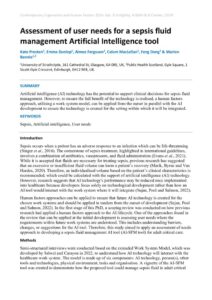
|
Author
Kate Preston, Emma Dunlop, Aimee Ferguson, Calum MacLellan, Feng Dong & Marion Bennie |
Abstract
Artificial intelligence (AI) technology has the potential to support clinical decisions for sepsis fluid management. However, to ensure the full benefit of the technology is realised, a human factors approach, utilising a work system model, can be applied from the outset in parallel with the AI development to ensure the technology is created for the setting within which it will be integrated. |
Publish Date: Jun 23, 2022 | Keywords: Autonomous vehicles, Contemporary EHF 2022, Design, Human-machine interaction, Publications, Usability, User experience, Virtual reality
| Document
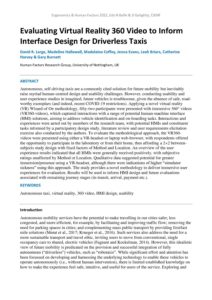
|
Author
David R. Large, Madeline Hallewell, Madelaine Coffey, Jenna Evans, Leah Briars, Catherine Harvey & Gary Burnett |
Abstract
Autonomous, self-driving taxis are a commonly cited solution for future mobility but inevitably raise myriad human-centred design and usability challenges. However, conducting usability and user experience studies in imagined, future vehicles is troublesome, given the absence of safe, road-worthy exemplars (and indeed, recent COVID-19 restrictions). Applying a novel virtual reality (VR) Wizard-of Oz methodology, fifty-two participants were presented with immersive 360° videos (VR360-videos), which captured interactions with a range of potential human-machine interface (HMI) solutions, aiming to address vehicle identification and on-boarding tasks. Interactions and experiences were acted out by members of the research team, with potential HMIs and constituent tasks informed by a participatory design study, literature review and user requirements elicitation exercise also conducted by the authors. To evaluate the methodological approach, the VR360-videos were presented using either a VR-headset or laptop web-browser, with respondents offered the opportunity to participate in the laboratory or from their home, thus affording a 2×2 between-subjects study design with fixed factors of Method and Location. An overview of the user experience results indicated that all HMIs were generally received positively, with subjective ratings unaffected by Method or Location. Qualitative data suggested potential for greater immersion/presence using a VR-headset, although there were indications of higher “simulator sickness” using this approach. The study provides a novel methodology to deliver immersive user experiences for evaluation. Results will be used to inform HMI design and future evaluations associated with remaining journey stages (in-transit, arrival, payment etc.). |
Publish Date: Mar 25, 2019 | Keywords: Contemporary EHF 2016, Mental health & wellbeing, Occupational health, Publications
| Document
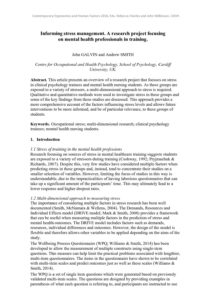
|
Author
John GALVIN and Andrew SMITH |
Abstract
This article presents an overview of a research project that focuses on stress in clinical psychology trainees and mental health nursing students. As these groups are exposed to a variety of stressors, a multi-dimensional approach to stress is required. Qualitative and quantitative methods were used to investigate stress in these groups and some of the key findings from these studies are discussed. This approach provides a more comprehensive account of the factors influencing stress levels and allows future interventions to be more informed, and be of particular relevance, to these groups of students. |
Publish Date: Jun 23, 2022 | Keywords: Accessibility, Contemporary EHF 2022, Interface design, Publications, Usability, User experience
| Document
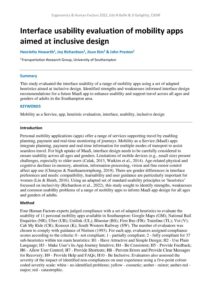
|
Author
Henrietta Howarth, Joy Richardson, Jisun Kim & John Preston |
Abstract
This study evaluated the interface usability of a range of mobility apps using a set of adapted heuristics aimed at inclusive design. Identified strengths and weaknesses informed interface design recommendations for a future MaaS app to enhance usability and support travel across all ages and genders of adults in the Southampton area. |
Publish Date: Apr 9, 2021 | Keywords: Contemporary EHF 2021, Design, Education, training & skills, Publications
| Document
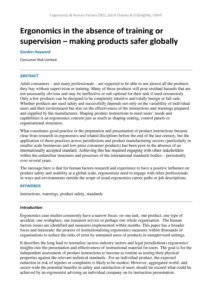
|
Author
Gordon Hayward |
Abstract
Adult consumers – and many professionals – are expected to be able to use almost all the products they buy without supervision or training. Many of those products will pose residual hazards that are not necessarily obvious and may be ineffective or sub-optimal for their task if used erroneously. Only a few products can be designed to be completely intuitive and totally benign or fail-safe. Whether products are used safely and successfully depends not only on the variability of individual users and their environment but also on the effectiveness of the instructions and warnings prepared and supplied by the manufacturer. Shaping product instructions to meet users’ needs and capabilities is an ergonomics concern just as much as shaping seating, control panels or organisational structures. What constitutes good practice in the preparation and presentation of product instructions became clear from research in ergonomics and related disciplines before the end of the last century, but the application of these practices across jurisdictions and product manufacturing sectors (particularly in smaller scale businesses and low-price consumer products) has been poor in the absence of an internationally accepted standard. Achieving this has required engaging with other stakeholders within the unfamiliar structures and processes of the international standards bodies – persistently over several years. The message here is that for human factors research and experience to have a positive influence on product safety and usability at a global scale, ergonomists need to engage with other professionals in ways and environments outside the scope of usual ergonomics career paths or job descriptions. |
Publish Date: Apr 16, 2020 | Keywords: Construction, Contemporary EHF 2020, Publications, Safety, Virtual reality
| Document
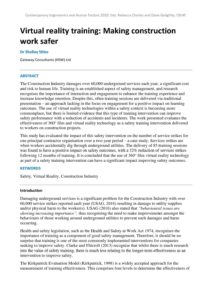
|
Author
Dr Shelley Stiles |
Abstract
The Construction Industry damages over 60,000 underground services each year, a significant cost and risk to human life. Training is an established aspect of safety management, and research recognises the importance of interaction and engagement to enhance the training experience and increase knowledge retention. Despite this, often training sessions are delivered via traditional presentation – an approach lacking in the focus on engagement for a positive impact on learning outcomes. The use of virtual reality technologies within a safety context is becoming more commonplace, but there is limited evidence that this type of training intervention can improve safety performance with a reduction of accidents and incidents. The work presented evaluates the effectiveness of 360° film and virtual reality technology as a safety training intervention delivered to workers on construction projects. This study has evaluated the impact of this safety intervention on the number of service strikes for one principal contractor organisation over a two-year period – a case study. Services strikes are when workers accidentally dig through underground utilities. The delivery of 85 training sessions was found to have a positive impact on safety outcomes, with a 32% reduction of services strikes following 12 months of training. It is concluded that the use of 360° film virtual reality technology as part of a safety training intervention can have a significant impact improving safety outcomes. |
Publish Date: Feb 27, 2019 | Keywords: Contemporary EHF 2016, Design, Healthcare, Publications
| Document
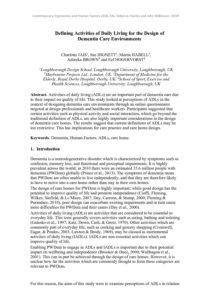
|
Author
Charlotte JAIS, Sue HIGNETT, Martin HABELL, Adonika BROWN and Eef HOGERVORST |
Abstract
Activities of daily living (ADLs) are an important part of dementia care due to their impact on quality of life. This study looked at perceptions of ADLs in the context of designing dementia care environments through an online questionnaire targeted at design professionals and healthcare workers. Participants suggested that certain activities such as physical activity and social interaction, which go beyond the traditional definition of ADLs, are also highly important considerations in the design of dementia care homes. The results suggest that current definitions of ADLs may be too restrictive. This has implications for care practice and care home design. |
Publish Date: Dec 18, 2018 | Keywords: Contemporary EHF 2017, Design, Healthcare, Publications
| Document
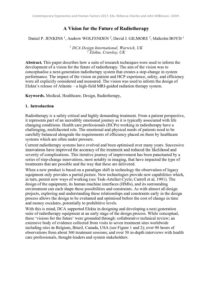
|
Author
Daniel P. JENKINS, Andrew WOLFENDEN, David J. GILMORE, Malcolm BOYD |
Abstract
This paper describes how a suite of research techniques were used to inform the development of a vision for the future of radiotherapy. The aim of the vision was to conceptualise a next-generation radiotherapy system that creates a step-change in system performance. The impact of the vision on patient and HCP experience, safety, and efficiency were all explicitly considered and measured. The vision was used to inform the design of Elekta’s release of Atlantic – a high-field MRI-guided radiation therapy system. |
Publish Date: Apr 9, 2021 | Keywords: Contemporary EHF 2021, Health & Safety, Publications, Rail
| Document
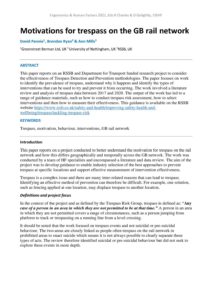
|
Author
David Pennie, Brendan Ryan & Ann Mills |
Abstract
This paper reports on an RSSB and Department for Transport funded research project to consider the effectiveness of Trespass Detection and Prevention methodologies. The paper focuses on work to identify the prevalence of trespass, understand why it happens and identify the types of interventions that can be used to try and prevent it from occurring. The work involved a literature review and analysis of trespass data between 2017 and 2020. The output of the work has led to a range of guidance materials, such as how to conduct trespass risk assessment, how to select interventions and then how to measure their effectiveness. This guidance is available on the RSSB website https://www.rssb.co.uk/safety-and-health/improving-safety-health-and-wellbeing/trespass/tackling-trespass-risk |
Publish Date: Apr 16, 2020 | Keywords: Contemporary EHF 2020, Leadership, Manufacturing, Publications
| Document
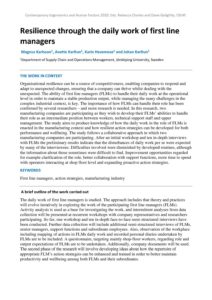
|
Author
Magnus Karlsson, Anette Karltun, Karin Havemose and Johan Karltun |
Abstract
Organisational resilience can be a source of competitiveness, enabling companies to respond and adapt to unexpected changes, ensuring that a company can thrive whilst dealing with the unexpected. The ability of first line managers (FLMs) to handle their daily work at the operational level in order to maintain a stable production output, while managing the many challenges in the complex industrial context, is key. The importance of how FLMs can handle their role has been confirmed by several researchers – and more research is needed. In this research, two manufacturing companies are participating as they wish to develop their FLMs’ abilities to handle their role as an intermediate position between workers, technical support staff and upper management. The study aims to produce knowledge of how the daily work in the role of FLMs is enacted in the manufacturing context and how resilient action strategies can be developed for both performance and wellbeing. The study follows a collaborative approach in which two manufacturing companies are participating. After an initial workshop and ten in-depth interviews with FLMs the preliminary results indicate that the disturbances of daily work per se were expected by many of the interviewees. Difficulties involved were diminished by developed routines, although the information about those sometimes were difficult to find. Improvement opportunities regarded for example clarification of the role, better collaboration with support functions, more time to spend with operators interacting at shop floor level and expanding proactive action strategies. |
Publish Date: Sep 8, 2019 | Keywords: Contemporary EHF 2019, Fatigue & sleep, Publications, Technology
| Document
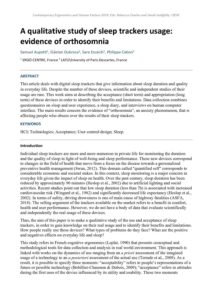
|
Author
Samuel Aupetit, Gäetan Dubroca, Sara Escaich, Philippe Cabon |
Abstract
This article deals with digital sleep trackers that give information about sleep duration and quality in everyday life. Despite the number of these devices, scientific and independent studies of their usage are rare. This work aims at describing the acceptance (short term) and appropriation (long term) of these devices in order to identify their benefits and limitations. Data collection combines questionnaires on sleep and user experience, a sleep diary, and interviews on human computer interface. The main results concern the evidence of “orthosomnia”, an anxiety phenomenon, that is affecting people who obsess over the results of their sleep trackers. |
Publish Date: Apr 9, 2021 | Keywords: Communication, Contemporary EHF 2021, Design, Pandemic, Publications, Usability
| Document
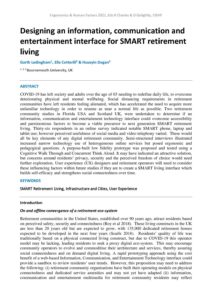
|
Author
Garth Ledingham, Ella Cotterill & Huseyin Dogan |
Abstract
COVID-19 has left society and adults over the age of 65 needing to redefine daily life, to overcome deteriorating physical and mental wellbeing. Social distancing requirements in retirement communities have left residents feeling alienated, which has accelerated the need to acquire more unfamiliar technology in order to resume as near a normal life as possible. Two retirement community studies in Florida USA and Scotland UK, were undertaken to determine if an information, communication and entertainment technology interface could overcome accessibility and parsimonious factors to become a viable precursor to next generation SMART retirement living. Thirty-six respondents in an online survey indicated notable SMART phone, laptop and tablet use; however perceived usefulness of social media and video telephony varied. These would all be key elements of any digital retirement community. Semi-structured interviews illustrated increased narrow technology use of heterogeneous online services but posed ergonomic and pedagogical questions. A purpose-built low fidelity prototype was proposed and tested using a Cognitive Walk Through and Concurrent Think Aloud. It may have indicated an attractive solution, but concerns around residents’ privacy, security and the perceived freedom of choice would need further exploration. User experience (UX) designers and retirement operators will need to consider these influencing factors within future studies if they are to create a SMART living interface which builds self-efficacy and strengthens social connectedness over time. |
Publish Date: Jun 24, 2022 | Keywords: Aviation, Contemporary EHF 2022, Investigation, Publications
| Document
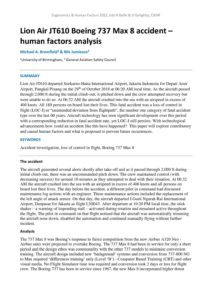
|
Author
Michael A. Bromfield & Nils Jamieson |
Abstract
Lion Air JT610 departed Soekarno-Hatta International Airport, Jakarta Indonesia for Depati Amir Airport, Pangkal Pinang on the 29th of October 2018 at 06:20 AM local time. As the aircraft passed through 2,000 ft during the initial climb-out, it pitched down and the crew attempted recovery but were unable to do so. At 06:32 AM the aircraft crashed into the sea with an airspeed in excess of 400 knots. All 189 persons on board lost their lives. This fatal accident was a loss of control in flight (LOC-I) or “unintended deviation from flightpath”, the number one category of fatal accident type over the last 60 years. Aircraft technology has seen significant development over this period with a corresponding reduction in fatal accident rate, yet LOC-I still persists. With technological advancements how could an accident like this have happened? This paper will explore contributory and causal human factors and what is proposed to prevent future occurrences. |
Publish Date: Jun 12, 2023 | Keywords: Behaviour, Construction, Contemporary EHF 2023, Design, Publications, Safety
| Document
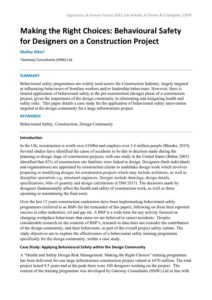
|
Author
Shelley Stiles |
Abstract
Behavioural safety programmes are widely used across the Construction Industry, largely targeted at influencing behaviours of frontline workers and/or leadership behaviours. However, there is limited application of behavioural safety at the pre-construction (design) phase of a construction project, given the importance of the design community in eliminating and mitigating health and safety risks. This paper details a case study for the application of behavioural safety intervention targeted at the design community for a large infrastructure project. |
Publish Date: Aug 18, 2021 | Keywords: Automation, Comfort, Comfort Congress 2021, Publications, Virtual reality
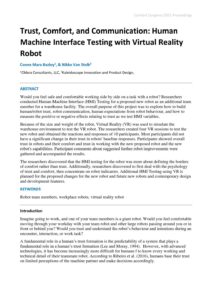 |
Author
Conne Mara Bazley & Nikko Van Stolk |
Abstract
Would you feel safe and comfortable working side by side on a task with a robot? Researchers conducted Human Machine Interface (HMI) Testing for a proposed new robot as an additional team member for a warehouse facility. The overall purpose of this project was to explore how to build human/robot trust, robot communication, human expectations from robot behaviour, and how to measure the positive or negative effects relating to trust as we test HMI variables. Because of the size and weight of the robot, Virtual Reality (VR) was used to simulate the warehouse environment to test the VR robot. The researchers created four VR sessions to test the new robot and obtained the reactions and responses of 10 participants. Most participants did not have a significant change in their trust in robots' baseline responses. Participants showed overall trust in robots and their comfort and trust in working with the new proposed robot and the new robot's capabilities. Participant comments about suggested further robot improvements were gathered and accompanied the results. The researchers discovered that the HMI testing for the robot was more about defining the borders of comfort rather than trust. Additionally, researchers discovered to first deal with the psychology of trust and comfort, then concentrate on robot indicators. Additional HMI Testing using VR is planned for the proposed changes for the new robot and future new robots and contemporary design and development features. |
Publish Date: Jun 23, 2022 | Keywords: Cognition, Contemporary EHF 2022, Healthcare, Patient Safety, Publications
| Document
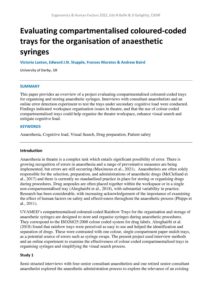
|
Author
Victoria Laxton, Edward J.N. Stupple, Frances Maratos & Andrew Baird |
Abstract
This paper provides an overview of a project evaluating compartmentalised coloured-coded trays for organising and storing anaesthetic syringes. Interviews with consultant anaesthetists and an online error detection experiment to test the trays under secondary cognitive load were conducted. Findings indicated workspace organisation issues in theatre, and that the use of colour-coded compartmentalised trays could help organise the theatre workspace, enhance visual search and mitigate cognitive load. |
Publish Date: Mar 24, 2019 | Keywords: Aviation, Contemporary EHF 2016, Publications, Systems
| Document
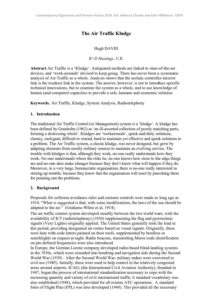
|
Author
Hugh DAVID |
Abstract
Air Traffic is a ‘Kludge’. Antiquated methods are linked to state-of-the-art devices, and ‘work-arounds’ devised to keep going. There has never been a systematic analysis of Air Traffic as a whole. Analysis shows that the archaic controller-aircrew link is the weakest link in the system. The answer, however, is not to introduce specific technical innovations, but to examine the system as a whole, and to use knowledge of human (and computer) capacities to provide a safe, humane and economic solution. |
Publish Date: Jun 8, 2023 | Keywords: Autonomous vehicles, Contemporary EHF 2023, Incidents, Publications, Road safety
| Document
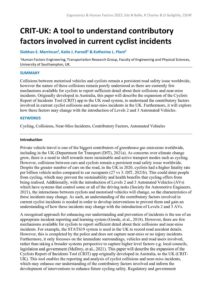
|
Author
Siobhan E. Merriman, Katie J. Parnell & Katherine L. Plant |
Abstract
Collisions between motorised vehicles and cyclists remain a persistent road safety issue worldwide, however the nature of these collisions remain poorly understood as there are currently few mechanisms available for cyclists to report sufficient detail about their collisions and near-miss incidents. Originally developed in Australia, this paper will describe the expansion of the Cyclists Report of Incidents Tool (CRIT) app to the UK road system, to understand the contributory factors involved in current cyclist collisions and near-miss incidents in the UK. Furthermore, it will explore how these factors may change with the introduction of Levels 2 and 3 Automated Vehicles. |
Publish Date: May 31, 2024 | Keywords: Accessibility, Contemporary EHF 2024, Publications, Rail, Transport
| Document
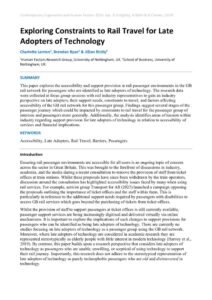
|
Author
Charlotte Lenton, Brendan Ryan & Jillian Rickly |
Abstract
This paper explores the accessibility and support provision in rail passenger environments in the GB rail network for passengers who are identified as late adopters of technology. The research data were collected at focus group sessions with rail industry representatives to gain an industry perspective on late adopters, their support needs, constraints to travel, and factors affecting accessibility of the GB rail network for this passenger group. Findings suggest several stages of the passenger journey which could be impacted by constraints to rail travel for the passenger group of interests and passengers more generally. Additionally, the analysis identifies areas of tension within industry regarding support provision for late adopters of technology in relation to accessibility of services and financial implications. |
Publish Date: Jun 23, 2022 | Keywords: Contemporary EHF 2022, Fatigue & sleep, Healthcare, Publications, Tools & techniques
| Document
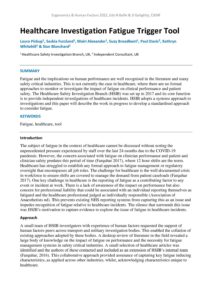
|
Author
Laura Pickup, Saskia Fursland, Mairi Alexander, Suzy Broadbent, Paul Davis, Kathryn Whitehill & Sian Blanchard |
Abstract
Fatigue and the implications on human performance are well recognised in the literature and many safety critical industries. This is not currently the case in healthcare, where there are no formal approaches to monitor or investigate the impact of fatigue on clinical performance and patient safety. The Healthcare Safety Investigation Branch (HSIB) was set up in 2017 and its core function is to provide independent investigations of healthcare incidents. HSIB adopts a systems approach to investigations and this paper will describe the work in progress to develop a standardised approach to consider fatigue. |
Publish Date: Jun 23, 2022 | Keywords: Contemporary EHF 2022, Healthcare, Incidents, Patient Safety, Publications
| Document
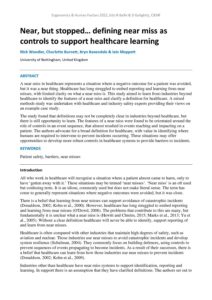
|
Author
Nick Woodier, Charlotte Burnett, Bryn Baxendale & Iain Moppett |
Abstract
A near miss in healthcare represents a situation where a negative outcome for a patient was avoided, but it was a near thing. Healthcare has long struggled to embed reporting and learning from near misses, with limited clarity on what a near miss is. This study aimed to learn from industries beyond healthcare to identify the features of a near miss and clarify a definition for healthcare. A mixed methods study was undertaken with healthcare and industry safety experts providing their views on an example case study. The study found that definitions may not be completely clear in industries beyond healthcare, but there is still opportunity to learn. The features of a near miss were found to be orientated around the role of controls in an event sequence, that almost resulted in events reaching and impacting on a patient. The authors advocate for a broad definition for healthcare, with value in identifying where humans are required to intervene to prevent incidents occurring. These situations may offer opportunities to develop more robust controls in healthcare systems to provide barriers to incidents. |
Publish Date: Sep 8, 2019 | Keywords: Automation, Automotive, Communication, Contemporary EHF 2019, Interface design, Publications
| Document
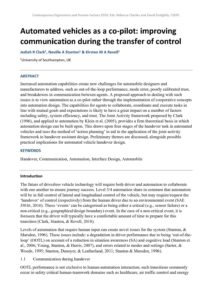
|
Author
Jediah R Clark, Neville A Stanton & Kirsten M A Revell |
Abstract
Increased automation capabilities create new challenges for automobile designers and manufacturers to address, such as out-of-the-loop performance, mode error, poorly calibrated trust, and breakdowns in communication between agents. A proposed approach to dealing with such issues is to view automation as a co-pilot rather through the implementation of cooperative concepts into automation design. The capabilities for agents to collaborate, coordinate and execute tasks in line with mutual goals and expectations is likely to have a great impact on a number of factors including safety, system efficiency, and trust. The Joint Activity framework proposed by Clark (1996), and applied to automation by Klein et al. (2005), provides a firm theoretical basis in which automation design can be built upon. This draws upon four stages of the handover task in automated vehicles and uses the method of ‘action planning’ to aid in the application of the joint activity framework to handover assistant design. Preliminary themes are discussed, alongside possible practical implications for automated vehicle handover design. |
Publish Date: Jun 11, 2025 | Keywords: Contemporary EHF 2025, Decision making, Manufacturing, Publications
| Document
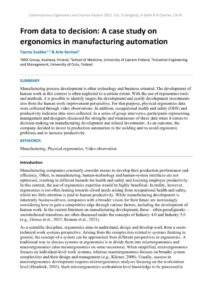
|
Author
Teemu Suokko & Arto Reiman |
Abstract
Manufacturing process development is often technology and business oriented. The development of human work in this context is often neglected to a certain extent. With the use of ergonomics tools and methods, it is possible to identify targets for development and justify development investments also from the human work improvement perspective. For that purpose, physical ergonomics data were collected through video observations. In addition, occupational health and safety (OHS) and productivity indicator data were collected. In a series of group interviews, participants representing management and designers discussed the strengths and weaknesses of these data when it comes to decision-making on manufacturing development and related investments. As an outcome, the company decided to invest in production automation in the welding unit to avoid ergonomic problems and to increase productivity. |
Publish Date: Mar 17, 2019 | Keywords: Aviation, Contemporary EHF 2016, Design, Publications
| Document
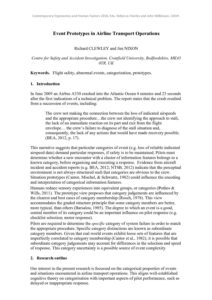
|
Author
Richard CLEWLEY and Jim NIXON |
Abstract
|
Publish Date: Dec 18, 2018 | Keywords: Contemporary EHF 2017, Healthcare, Publications, Safety
| Document
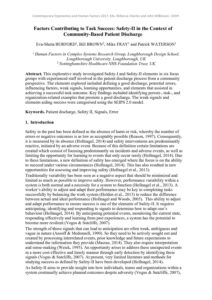
|
Author
Eva-Maria BURFORD, Bill BROWN, Mike FRAY and Patrick WATERSON |
Abstract
This explorative study investigated Safety-I and Safety-II elements in six focus groups with experienced staff involved in the patient discharge process from a community perspective. The elements explored included defining a good discharge, potential errors, influencing factors, weak signals, learning opportunities, and elements that assisted in achieving a successful task outcome. Key findings included identifying person-, task-, and organization-related examples that promote a good discharge. The weak signals and elements aiding success were categorised using the SEIPS 2.0 model. |
Publish Date: Jun 23, 2022 | Keywords: Contemporary EHF 2022, Healthcare, Patient Safety, Publications, Resilience
| Document
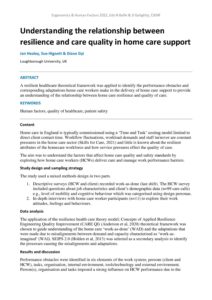
|
Author
Jan Healey, Sue Hignett & Diane Gyi |
Abstract
A resilient healthcare theoretical framework was applied to identify the performance obstacles and corresponding adaptations home care workers make in the delivery of home care support to provide an understanding of the relationship between home care resilience and quality of care. |
Publish Date: Apr 16, 2020 | Keywords: Contemporary EHF 2020, Design, Education, training & skills, Publications
| Document
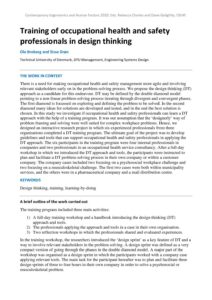
|
Author
Ole Broberg and Sisse Grøn |
Abstract
There is a need for making occupational health and safety management more agile and involving relevant stakeholders early on in the problem-solving process. We propose the design thinking (DT) approach as a candidate for this endeavour. DT may be defined by the double diamond model pointing to a non-linear problem-solving process iterating through divergent and convergent phases. The first diamond is focussed on exploring and defining the problem to be solved. In the second diamond many ideas for solutions are developed and tested, and in the end the best solution is chosen. In this study we investigate if occupational health and safety professionals can learn a DT approach with the help of a training program. It was our assumption that the ‘designerly’ way of problem framing and solving were well suited for complex workplace problems. Hence, we designed an interactive research project in which six experienced professionals from three organisations completed a DT training program. The ultimate goal of the project was to develop guidelines and tools that can support occupational health and safety professionals in applying the DT approach. The six participants in the training program were four internal professionals in companies and two professionals in an occupational health service consultancy. After a full-day workshop in which we introduced the DT approach and tools, the participants were instructed to plan and facilitate a DT problem-solving process in their own company or within a customer company. The company cases included two focusing on a psychosocial workplace challenge and two focusing on a musculoskeletal challenge. The first two cases were both within municipality services, and the others were in a pharmaceutical company and a mail distribution centre. |
Publish Date: Jun 11, 2025 | Keywords: Contemporary EHF 2025, Education, training & skills, Healthcare, Patient Safety, Publications
| Document
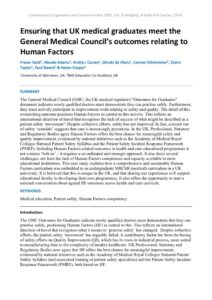
|
Author
Fraser Gold, Maude Adams, Andre J Carpio, Dinuki de Alwis, Connor Schlemmer, Claire Taylor, Paul Bowie & Helen Vosper |
Abstract
The General Medical Council (GMC) “Outcomes for Graduates” document indicates that newly qualified doctors must demonstrate that they can practise safely, and positions Human Factors as central to this activity. Including Human Factors-related outcomes in health and care educational programmes is not a minor ‘bolt on’ – it requires a co-ordinated and strategic educational approach, which we would argue presents a significant challenge for most educational institutions. This case study explores how a comprehensive and sustainable Human Factors curriculum was embedded in an undergraduate MBChB (medical) curriculum in a UK university. |
Publish Date: Jun 10, 2024 | Keywords: Cognition, Contemporary EHF 2024, Human performance, Publications, Workload
| Document
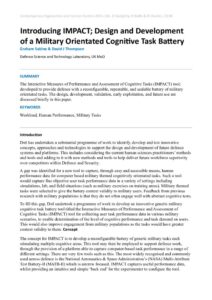
|
Author
Graham Sabine & David J Thompson |
Abstract
The Interactive Measures of Performance and Assessment of Cognitive Tasks (IMPACT) tool; developed to provide defence with a reconfigurable, repeatable, and scalable battery of military orientated tasks. The design, development, validation, early exploitation, and future use are discussed briefly in this paper. |
Publish Date: Sep 20, 2018 | Keywords: Aviation, Contemporary EHF 2018, Decision making, Publications
| Document
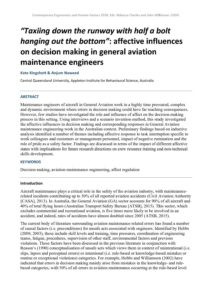
|
Author
Kate Kingshott & Anjum Naweed |
Abstract
Maintenance engineers of aircraft in General Aviation work in a highly time pressured, complex and dynamic environment where errors in decision making could have far reaching consequences. However, few studies have investigated the role and influence of affect on the decision-making process in this setting. Using interviews and a scenario invention method, this study investigated the affective influences in decision making and corresponding responses in General Aviation maintenance engineering work in the Australian context. Preliminary findings based on inductive analysis identified a number of themes including affective response to task interruption specific to work colleagues and customers or management personnel, impact of negative rumination and the role of pride as a safety factor. Findings are discussed in terms of the impact of different affective states with implications for future research directions on crew resource training and non-technical skills development. |
Publish Date: May 27, 2025 | Keywords: Contemporary EHF 2025, Publications, Risk assessment, Systems
| Document
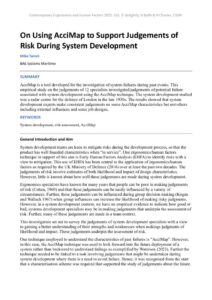
|
Author
Mike Tainsh |
Abstract
AcciMap is a tool developed for the investigation of system failures during past events. This empirical study on the judgements of 12 specialists investigated judgements of potential failure associated with system development using the AcciMap technique. The system development studied was a radar centre for the defence of London in the late 1930s. The results showed that system development experts make consistent judgements on some AcciMap characteristics but not others including external influences and some job designs. |
Publish Date: May 30, 2024 | Keywords: Aviation, Contemporary EHF 2024, Design, Publications
| Document
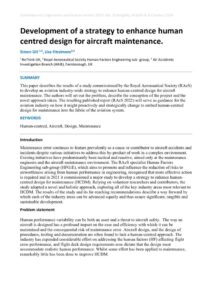
|
Author
Simon Gill, Lisa Fitzsimons |
Abstract
This paper describes the results of a study commissioned by the Royal Aeronautical Society (RAeS) to develop an aviation industry-wide strategy to enhance human-centred design for aircraft maintenance. The authors will set out the problem, describe the conception of the project and the novel approach taken. The resulting published report (RAeS 2022) will serve as guidance for the aviation industry on how it might proactively and strategically change to embed human-centred design for maintenance into the fabric of the aviation system. |
Publish Date: May 27, 2025 | Keywords: Artificial intelligence, Contemporary EHF 2025, Publications, Sociotechnical systems
| Document
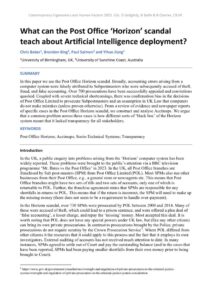
|
Author
Chris Baber, Brandon King, Paul Salmon and Yihao Jiang |
Abstract
In this paper we use the Post Office Horizon scandal. Broadly, accounting errors arising from a computer system were falsely attributed to Subpostmasters who were subsequently accused of theft, fraud, and false accounting. Over 700 prosecutions have been successfully appealed and convictions quashed. Coupled with severe technical shortcomings, there was confirmation bias in the decisions of Post Office Limited to prosecute Subpostmasters and an assumption in UK Law that computers do not make mistakes (unless proven otherwise). From a review of evidence and newspaper reports of specific cases in the Post Office Horizon scandal, we construct and analyse Accimaps. We argue that a common problem across these cases is how different sorts of ‘black box’ of the Horizon system meant that it lacked transparency for all stakeholders. |
Publish Date: Feb 26, 2019 | Keywords: Contemporary EHF 2016, Publications, Systems
| Document
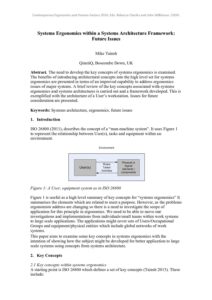
|
Author
Mike Tainsh |
Abstract
The need to develop the key concepts of systems ergonomics is examined. The benefits of introducing architectural concepts into the high level set for systems ergonomics are presented in terms of an improved capability to address ergonomics issues of major systems. A brief review of the key concepts associated with systems ergonomics and systems architectures is carried out and a framework developed. This is exemplified with the architecture of a User’s workstation. Issues for future consideration are presented. |
Publish Date: May 30, 2024 | Keywords: Contemporary EHF 2024, Healthcare, Publications
| Document
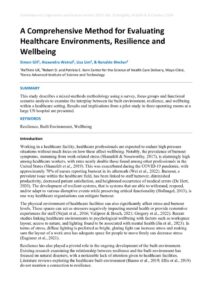
|
Author
Simon Gill, Alexandra Watral , Lisa Lim , & Renaldo Blocker |
Abstract
This study describes a mixed-methods methodology using a survey, focus groups and functional scenario analysis to examine the interplay between the built environment, resilience, and wellbeing within a healthcare setting. Results and implications from a pilot study in three operating rooms at a large US hospital are presented. |
Publish Date: Jun 23, 2022 | Keywords: Aviation, Contemporary EHF 2022, Human factors integration, Publications, Systems
| Document
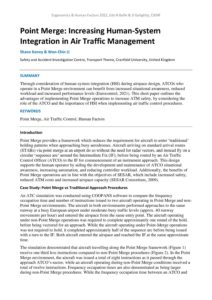
|
Author
Shane Kenny & Wen-Chin Li |
Abstract
Through consideration of human-system integration (HSI) during airspace design, ATCOs who operate in a Point Merge environment can benefit from increased situational awareness, reduced workload and increased performance levels (Eurocontrol, 2021). This short paper outlines the advantages of implementing Point Merge operations to increase ATM safety, by considering the role of the ATCO and the importance of HSI when implementing air traffic control procedures. |
Publish Date: Mar 17, 2019 | Keywords: Automotive, Contemporary EHF 2016, Design, Publications, Technology, Workload
| Document
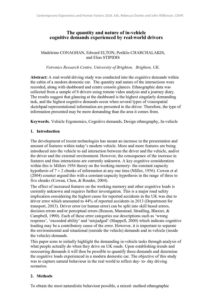
|
Author
Madeleine CONAGHAN, Edward ELTON, Periklis CHARCHALAKIS, and Elias STIPIDIS |
Abstract
A real-world driving study was conducted into the cognitive demands within the cabin of a modern domestic car. The quantity and nature of the interactions were recorded, along with dashboard and centre console glances. Ethnographic data was collected from a sample of 8 drivers using remote video analysis and a journey diary. The results suggest that glancing at the dashboard is the highest singularly demanding task, and the highest cognitive demands occur when several types of visuospatial sketchpad representational information are presented to the driver. Therefore, the type of information presented may be more demanding than the area it comes from. |
Publish Date: Jun 3, 2024 | Keywords: Contemporary EHF 2024, Design, Human factors integration, Patient Safety, Publications
| Document
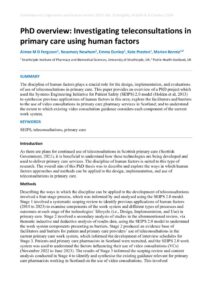
|
Author
Aimee M D Ferguson, Rosemary Newham, Emma Dunlop, Kate Preston, Marion Bennie |
Abstract
The discipline of human factors plays a crucial role for the design, implementation, and evaluations of use of teleconsultations in primary care. This paper provides an overview of a PhD project which used the Systems Engineering Initiative for Patient Safety (SEIPS) 2.0 model (Holden et al, 2013) to synthesise previous applications of human factors in this area; explore the facilitators and barriers to the use of video consultations in primary care pharmacy services in Scotland; and to understand the extent to which existing video consultation guidance considers each component of the current work system. |
Publish Date: Jun 11, 2025 | Keywords: Contemporary EHF 2025, Design, Medical Devices, Publications, Systems
| Document
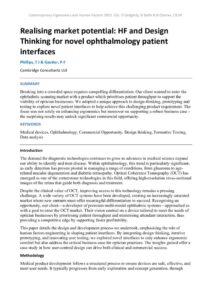
|
Author
Phillips, T J & Gautier, P-F |
Abstract
Breaking into a crowded space requires compelling differentiation. Our client wanted to enter the ophthalmic scanning market with a product which prioritises patient throughput to support the viability of optician businesses. We adopted a unique approach to design-thinking, prototyping and testing to explore novel patient interfaces to help achieve this challenging product requirement. The focus was not solely on enhancing ergonomics but moreover on supporting a robust business case - the surprising results may unlock significant commercial opportunity. |
Publish Date: Apr 16, 2020 | Keywords: Contemporary EHF 2020, Emergency services, Maritime, Publications, Safety
| Document
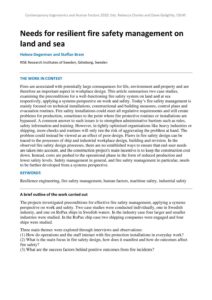
|
Author
Helene Degerman and Staffan Bram |
Abstract
Fires are associated with potentially large consequences for life, environment and property and are therefore an important aspect in workplace design. This article summarises two case studies, examining the preconditions for a well-functioning fire safety system on land and at sea respectively, applying a systems perspective on work and safety. Today’s fire safety management is mainly focused on technical installations, constructional and building measures, control plans and evacuation routines. Fire safety installations could meet all regulative requirements and still create problems for production, sometimes to the point where fire protective routines or installations are bypassed. A common answer to such issues is to strengthen administrative barriers such as rules, safety information and training. However, in tightly optimised organisations like heavy industries or shipping, more checks and routines will only run the risk of aggravating the problem at hand. The problem could instead be viewed as an effect of poor design. Flaws in fire safety design can be traced to the processes of ship and industrial workplace design, building and revision. In the observed fire safety design processes, there are no established ways to ensure that end-user needs are taken into account, and the construction project's main incentive is to keep the construction cost down. Instead, costs are pushed to the operational phase in the form of reduced production and lower safety levels. Safety management in general, and fire safety management in particular, needs to be further developed from a systems perspective. |
Publish Date: Apr 20, 2021 | Keywords: Anthropometry, Aviation, Contemporary EHF 2021, Healthcare, Publications, Transport
| Document
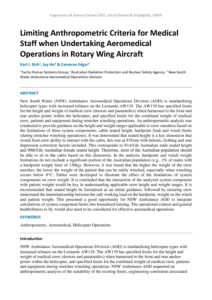
|
Author
Karl J. Rich, Joy Ho & Cameron Edgar |
Abstract
New South Wales (NSW) Ambulance Aeromedical Operations Division (AOD) is standardising helicopter types with increased reliance on the Leonardo AW139. The AW139 has specified limits for the height and weight of medical crew (doctors and paramedics) when harnessed to the front and rear anchor points within the helicopter, and specified limits for the combined weight of medical crew, patients and equipment during stretcher winching operations. An anthropometric analysis was conducted to provide guidance on the height and weight ranges applicable to crew members based on the limitations of three system components: cabin seated height, hardpoint limit and winch limits (during stretcher winching operations). It was determined that seated height is a key dimension that would limit crew ability to interact with the cabin, this was at 935mm with helmet, clothing and seat depression correction factors included. This corresponds to 91st%ile Australian male seated height and 99th%ile Australian female seated height. Therefore, most of the Australian population should be able to sit in the cabin based on this dimension. In the analysis, hardpoint and winch weight limitations do not exclude a significant portion of the Australian population (e.g., 3% of males with a hardpoint weight limit of 130kg). However, it was found that the higher the weight of the crew member, the lower the weight of the patient that can be safely winched, especially when winching occurs below 0°C. Tables were developed to illustrate the effect of the limitations of system components on crew weight. It is concluded that the interaction of the analysed system component with patient weight would be key in understanding applicable crew height and weight ranges. It is recommended that seated height be formalised as an initial guidance, followed by ensuring crew understand the interrelationship between the safe working load on the hardpoint, weight on the winch and patient weight. This presented a good opportunity for NSW Ambulance AOD to integrate calculations of system component limits into formalised training. The operational context and general health/fitness to fly would also need to be considered for effective aeromedical operations. |
Publish Date: May 30, 2024 | Keywords: Contemporary EHF 2024, Fatigue & sleep, Human factors integration, Publications, Safety
| Document
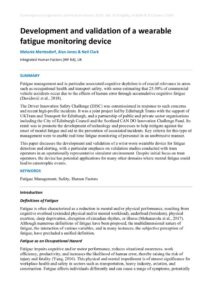
|
Author
Melanie Mertesdorf, Alan Jones & Neil Clark |
Abstract
Fatigue management and in particular associated cognitive depletion is of crucial relevance in areas such as occupational health and transport safety, with some estimating that 25-50% of commercial vehicle accidents occur due to the effects of human error through accumulative cognitive fatigue (Davidović et al., 2018). The Driver Innovation Safety Challenge (DISC) was commissioned in response to such concerns and recent high-profile incidents. It was a joint project led by Edinburgh Trams with the support of UKTram and Transport for Edinburgh, and a partnership of public and private sector organisations including the City of Edinburgh Council and the Scotland CAN DO Innovation Challenge Fund. Its remit was to promote the development of technology and processes to help mitigate against the onset of mental fatigue and aid in the prevention of associated incidents. Key criteria for this type of management were to enable real time fatigue monitoring of personnel in an unobtrusive manner. This paper discusses the development and validation of a wrist-worn wearable device for fatigue detection and alerting, with a particular emphasis on validation studies conducted with tram operators in an operationally representative simulator environment. Despite initial focus on tram operators, the device has potential applications for many other domains where mental fatigue could lead to catastrophic events. |
Publish Date: Mar 25, 2019 | Keywords: Contemporary EHF 2016, Healthcare, Patient Safety, Publications
| Document
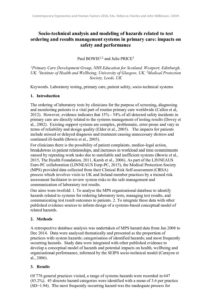
|
Author
Paul BOWIE and Julie PRICE |
Abstract
|
Publish Date: Aug 12, 2021 | Keywords: Aviation, Comfort, Comfort Congress 2021, Fatigue & sleep, Publications
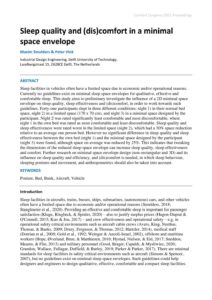 |
Author
Maxim Smulders & Peter Vink |
Abstract
Sleep facilities in vehicles often have a limited space due to economic and/or operational reasons. Currently no guidelines exist on minimal sleep space envelopes for qualitative, effective and comfortable sleep. This study aims to preliminary investigate the influence of a 2D minimal space envelope on sleep quality, sleep effectiveness and (dis)comfort, in order to work towards such guidelines. Forty-one participants slept in three different conditions: night 1) in their normal bed space, night 2) in a limited space (170 x 70 cm), and night 3) in a minimal space designed by the participant. Night 2 was rated significantly least comfortable and most discomfortable, where night 1 in the own bed was rated as most comfortable and least discomfortable. Sleep quality and sleep effectiveness were rated worst in the limited space (night 2), which had a 30% space reduction relative to an average one person bed. However no significant difference in sleep quality and sleep effectiveness between the own bed (night 1) and the minimal space designed by the participant (night 3) were found, although space on average was reduced by 25%. This indicates that tweaking the dimensions of the reduced sleep space envelope can increase sleep quality, sleep effectiveness and comfort. Further research on minimal space envelope design (non-rectangular and 3D) and its influence on sleep quality and efficiency, and (dis)comfort is needed, in which sleep behaviour, sleeping postures and movement, and anthropometrics should also be taken into account. |
Publish Date: Mar 26, 2019 | Keywords: Contemporary EHF 2016, Design, Publications, Technology
| Document
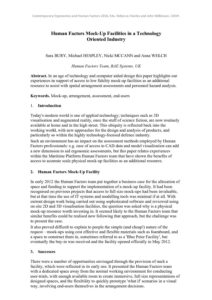
|
Author
Sara BURY, Michael HESPLEY, Nicki MCCANN and Anna WELCH |
Abstract
In an age of technology and computer aided design this paper highlights our experiences in support of access to low fidelity mock-up facilities as an additional resource to assist with spatial arrangement assessments and personnel hazard analysis. |
Publish Date: May 27, 2025 | Keywords: Contemporary EHF 2025, Defence, Human-machine interaction, Publications
| Document
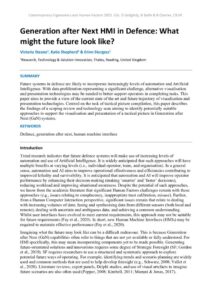
|
Author
Victoria Steane, Katie Shepherd & Erinn Sturgess |
Abstract
Future systems in defence are likely to incorporate increasingly levels of automation and Artificial Intelligence. With data proliferation representing a significant challenge, alternative visualisation and presentation technologies may be needed to better support operators in completing tasks. This paper aims to provide a view of the current state of the art and future trajectory of visualisation and presentation technologies. Centred on the task of tactical picture compilation, this paper describes the findings of a scoping review and technology scan aiming to identify potentially suitable approaches to support the visualisation and presentation of a tactical picture in Generation after Next (GaN) systems. |
Publish Date: Mar 17, 2019 | Keywords: Contemporary EHF 2016, Occupational health, Publications
| Document
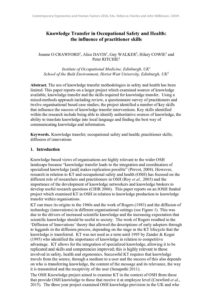
|
Author
Joanne O CRAWFORD, Alice DAVIS, Guy WALKER, Hilary COWIE and Peter RITCHIE |
Abstract
The use of knowledge transfer methodologies in safety and health has been limited. This paper reports on a larger project which examined sources of knowledge available, knowledge transfer and the skills required for knowledge transfer. Using a mixed-methods approach including review, a questionnaire survey of practitioners and twelve organisational based case studies; the project identified a number of key skills that influence the success of knowledge transfer interventions. Key skills identified within the research include being able to identify authoritative sources of knowledge, the ability to translate knowledge into local language and finding the best way of communicating knowledge and information. |
Publish Date: Jun 11, 2025 | Keywords: Contemporary EHF 2025, Musculoskeletal, Publications, Rail
| Document

|
Author
Kirsten Huysamen, Owen McCulloch, Faye Bacon, Jemma Widdows, Barbro Arnes & Paul Leach |
Abstract
Musculoskeletal disorders (MSDs) are one of the leading causes of absence in the UK railway. The data required to address this issue is not readily available. The Rail Safety and Standards Board instigated a study to carry out the first industry-wide MSD survey to understand the prevalence and types of MSDs rail workers are experiencing and why this may be occurring. A railway-specific MSD survey was created using evidence from scientific literature and consultations with UK rail organisations, railway unions and the regulator, and the objectives of the survey. The survey underwent user testing to assess its readability, usability, and applicability to UK heavy rail. The survey was active for a duration of 5 months (July 2024 – December 2024) and open to all job roles contributing to heavy rail operations in the UK. The paper provides details on the survey development and initial findings. |
Publish Date: Jun 11, 2025 | Keywords: Artificial intelligence, Contemporary EHF 2025, Energy, Human performance, Publications
| Document
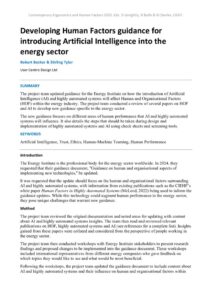
|
Author
Robert Becker & Stirling Tyler |
Abstract
The project team updated guidance for the Energy Institute on how the introduction of Artificial Intelligence (AI) and highly automated systems will affect Human and Organisational Factors (HOF) within the energy industry. The project team conducted a review of several papers on HOF and AI to develop new guidance specific to the energy sector. The new guidance focuses on different areas of human performance that AI and highly automated systems will influence. It also details the steps that should be taken during design and implementation of highly automated systems and AI using check sheets and screening tools. |
Publish Date: Jun 8, 2023 | Keywords: Augmented reality, Contemporary EHF 2023, Emergency services, Publications, Technology, Virtual reality
| Document
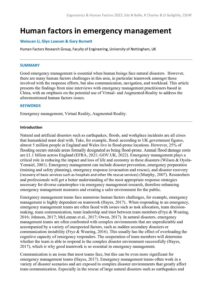
|
Author
Weixuan Li, Glyn Lawson & Gary Burnett |
Abstract
Good emergency management is essential when human beings face natural disasters. However, there are many human factors challenges in this area, in particular teamwork amongst those involved with the response efforts, but also communication, navigation, and workload. This article presents the findings from nine interviews with emergency management practitioners based in China, with an emphasis on the potential use of Virtual- and Augmented-Reality to address the aforementioned human factors issues. |
Publish Date: Jun 4, 2024 | Keywords: Contemporary EHF 2024, Publications, Transport, User experience
| Document
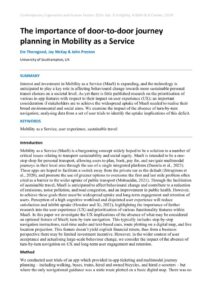
|
Author
Em Thorogood, Joy McKay & John Preston |
Abstract
Interest and investment in Mobility as a Service (MaaS) is expanding, and the technology is anticipated to play a key role in affecting behavioural change towards more sustainable personal transit choices on a societal level. As yet there is little published research on the prioritisation of various in-app features with respect to their impact on user experience (UX); an important consideration if stakeholders are to achieve the widespread uptake of MaaS needed to realise their broad environmental and social aims. We examine the impact of the absence of turn-by-turn navigation; analysing data from a set of user trials to identify the uptake implications of this deficit. |
Publish Date: Apr 9, 2020 | Keywords: Automotive, Autonomous vehicles, Behaviour, Contemporary EHF 2020, Publications
| Document
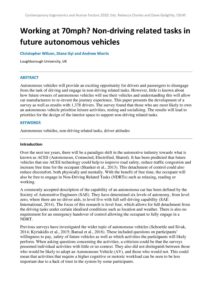
|
Author
Christopher Wilson, Diane Gyi and Andrew Morris |
Abstract
Autonomous vehicles will provide an exciting opportunity for drivers and passengers to disengage from the task of driving and engage in non-driving related tasks. However, little is known about how future owners of autonomous vehicles will use their vehicles and understanding this will allow car manufacturers to re-invent the journey experience. This paper presents the development of a survey as well as results with 1,378 drivers. The survey found that those who are most likely to own an autonomous vehicle prioritise leisure activities, resting and socialising. The results will lead to priorities for the design of the interior space to support non-driving related tasks. |
Publish Date: Sep 8, 2019 | Keywords: Agriculture & forestry, Contemporary EHF 2019, Decision making, Non-technical skills, Publications, Risk assessment
| Document
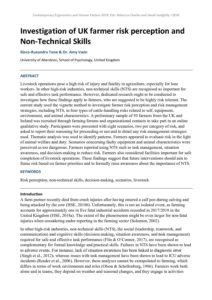
|
Author
Ilinca-Ruxandra Tone & Dr. Amy Irwin |
Abstract
Livestock operations pose a high risk of injury and fatality in agriculture, especially for lone workers. In other high-risk industries, non-technical skills (NTS) are recognised as important for safe and effective task performance. However, dedicated research ought to be conducted to investigate how these findings apply to farmers, who are suggested to be highly risk tolerant. The current study used the vignette method to investigate farmer risk perception and risk management strategies, including NTS, in four types of cattle-handling risks related to self, equipment, environment, and animal characteristics. A preliminary sample of 50 farmers from the UK and Ireland was recruited through farming forums and organisational contacts to take part in an online qualitative study. Participants were presented with eight scenarios, two per category of risk, and asked to report their reasoning for proceeding or not and to detail any risk management strategies used. Thematic analysis was used to identify patterns. Farmers appeared to evaluate risk in the light of animal welfare and duty. Scenarios concerning faulty equipment and animal characteristics were perceived as too dangerous. Farmers reported using NTS such as task management, situation awareness, and decision-making to reduce risk. Farmers also considered facilities important for safe completion of livestock operations. These findings suggest that future interventions should aim to frame risk based on farmer priorities and to formally raise awareness about the importance of NTS. |
Publish Date: Aug 9, 2021 | Keywords: Aviation, Comfort, Comfort Congress 2021, Design, Publications, Transport
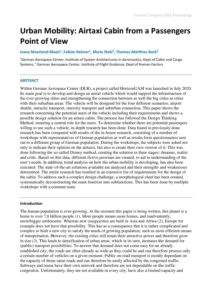 |
Author
Ivana Moerland-Masic, Fabian Reimer, Maria Stolz, Thomas-Matthias Bock |
Abstract
Within German Aerospace Center (DLR), a project called HorizonUAM was launched in July 2020. Its main goal is to develop and design an aerial vehicle which would support the infrastructure of the ever-growing cities and strengthening the connection between as well the big cities as cities with their suburban areas. The vehicle will be designed for the four different scenarios: airport shuttle, intracity transport, intercity transport and suburban connection. This paper shows the research concerning the potential users of the vehicle including their requirements and shows a possible design solution for an airtaxi cabin. The process has followed the Design Thinking Method, ensuring a central role for the users. To determine whether there are potential passengers willing to use such a vehicle, in-depth research has been done. Data found in previously done research has been compared with results of the in-house research, consisting of a number of workshops with representatives of German population as well as results form questionnaires sent out to a different group of German population. During the workshops, the subjects were asked not only to indicate their opinion on the airtaxis, but also to create their own version of it. This was done following the so-called Disney method, creating the solution in three stages: dreamer, realist and critic. Based on this data, different fictive personas are created, to aid in understanding of the user’s needs. In addition, trend analysis on how the urban mobility is developing, has also been executed. The state-of-the-art solutions available are analyzed and their strengths and weaknesses determined. The entire research has resulted in an extensive list of requirements for the design of the cabin. To address such a complex design challenge, a morphological chart has been created, systematically deconstructing the main function into subfunctions. This has been done by multiple workshops with a constant team. |
Publish Date: Apr 9, 2020 | Keywords: Accessibility, Contemporary EHF 2020, Publications, Technology
| Document
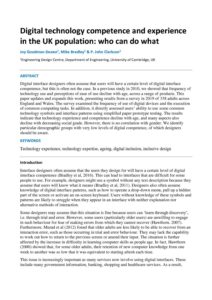
|
Author
Joy Goodman-Deane, Mike Bradley and P. John Clarkson |
Abstract
Digital interface designers often assume that users will have a certain level of digital interface competence, but this is often not the case. In a previous study in 2010, we showed that frequency of technology use and perceptions of ease of use decline with age, across a range of products. This paper updates and expands this work, presenting results from a survey in 2019 of 338 adults across England and Wales. The survey examined the frequency of use of digital devices and the execution of common computing tasks. In addition, it directly assessed users’ ability to use some common technology symbols and interface patterns using simplified paper prototype testing. The results indicate that technology experience and competence decline with age, and many aspects also decline with decreasing social grade. However, there is no correlation with gender. We identify particular demographic groups with very low levels of digital competence, of which designers should be aware. |
Publish Date: Apr 9, 2020 | Keywords: Contemporary EHF 2020, Publications, Sociotechnical systems, Systems
| Document
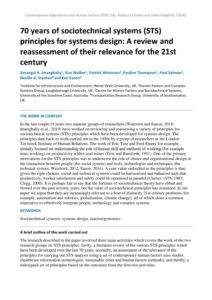
|
Author
Amangul A. Imanghaliy, Guy Walker, Patrick Waterson, Pauline Thompson, Paul Salmon, Neville A. Stanton and Ken Eason |
Abstract
In the last couple of years two separate groups of researchers (Waterson and Eason, 2018; Imanghaliy et al., 2019) have worked on reviewing and reassessing a variety of principles for sociotechnical systems (STS) principles which have been developed for systems design. The principles date back to work carried out in the 1950s by a group of researchers at the London Tavistock Institute of Human Relations. The work of Eric Trist and Fred Emery for example, initially focused on understanding the role of human skill and methods of working (for example team working) on productivity within coal mines (Trist and Bamforth, 1951). One of the primary motivations for the STS principles was to underscore the role of choice and organisational design in the interaction between people (the social system) and tools, technologies and techniques (the technical system; Weisbord, 2012; Eason, 2014). A core value embodied in the principles is that, given the right choices, social and technical systems could be harmonised and balanced such that productivity, worker satisfaction and safety could be optimised in parallel (Cherns, 1976, 1987; Clegg, 2000). It is perhaps fair to say that the fortunes of sociotechnical theory have ebbed and flowed over the past seventy years, but the value of sociotechnical principles has remained. In our paper we argue that they are increasingly relevant to a host of distinctly 21st century problems (for example, automation and robotics, globalisation, climate change), all of which share a common imperative to effectively integrate people, technology and complex systems. |
Publish Date: Jun 23, 2022 | Keywords: Aviation, Contemporary EHF 2022, Publications, Safety, Simulation, Situation awareness
| Document
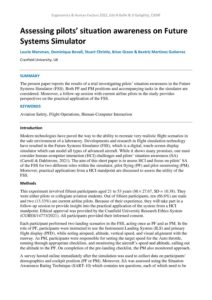
|
Author
Laurie Marsman, Dominique Bovell, Stuart Christie, Brian Green & Beatriz Martinez Gutierrez |
Abstract
The present paper reports the results of a trial investigating pilots’ situation awareness in the Future Systems Simulator (FSS). Both PF and PM positions and accompanying tasks in the simulator are considered. Moreover, a follow-up session with current airline pilots in the study provides perspectives on the practical application of the FSS. |
Publish Date: Sep 7, 2019 | Keywords: Contemporary EHF 2019, Defence, Publications, Technology
| Document
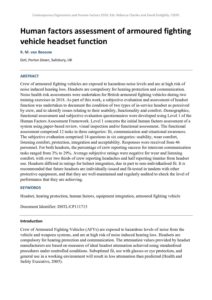
|
Author
R. M. van Besouw |
Abstract
Crew of armoured fighting vehicles are exposed to hazardous noise levels and are at high risk of noise induced hearing loss. Headsets are compulsory for hearing protection and communication. Noise health risk assessments were undertaken for British armoured fighting vehicles during two training exercises in 2018. As part of this work, a subjective evaluation and assessment of headset function was undertaken to document the condition of two types of in-service headset as perceived by crew, and to identify issues relating to their usability, functionality and comfort. Demographics, functional assessment and subjective evaluation questionnaires were developed using Level 1 of the Human Factors Assessment Framework. Level 1 concerns the initial human factors assessment of a system using paper-based review, visual inspection and/or functional assessment. The functional assessment comprised 12 tasks in three categories: fit, communication and situational awareness. The subjective evaluation comprised 14 questions in six categories: usability, wear comfort, listening comfort, protection, integration and acceptability. Responses were received from 46 personnel. For both headsets, the percentage of crew reporting success for intercom communication tasks ranged from 3% to 29%. Average subjective ratings were negative for wear and listening comfort, with over two thirds of crew reporting headaches and half reporting tinnitus from headset use. Headsets differed in ratings for helmet integration, due in part to non-individualised fit. It is recommended that future headsets are individually-issued and fit-tested in tandem with other protective equipment, and that they are well-maintained and regularly audited to check the level of performance that they are achieving. |
Publish Date: Apr 9, 2021 | Keywords: Contemporary EHF 2021, Musculoskeletal, Office ergonomics, Pandemic, Publications
| Document
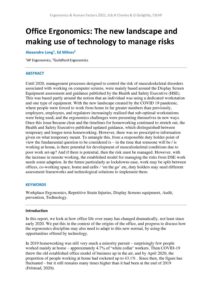
|
Author
Alexandre Long, Ed Milnes |
Abstract
Until 2020, management processes designed to control the risk of musculoskeletal disorders associated with working on computer screens, were mainly based around the Display Screen Equipment assessment and guidance published by the Health and Safety Executive (HSE). This was based partly around the notion that an individual was using a dedicated workstation and one type of equipment. With the new landscape created by the COVID 19 pandemic, where people were forced to work from home in far greater numbers than previously, employers, employees, and regulators increasingly realised that sub-optimal workstations were being used, and the ergonomics challenges were presenting themselves in new ways. Once this issue became clear and the timelines for homeworking continued to stretch out, the Health and Safety Executive published updated guidance, which distinguished between temporary and longer-term homeworking. However, there was no prescriptive information given on what temporary meant. To untangle this, from a responsible duty holder point of view the fundamental question to be considered is – in the time that someone will be / is working at home, is there potential for development of musculoskeletal conditions due to poor work set-up? And if there is potential, then the risk must be managed. However, with the increase in remote working, the established model for managing the risks from DSE work needs some adaption. In the future particularly as lockdowns ease, work may be split between offices, co-working space, home and cafés / ‘on the go’ etc, duty holders may need different assessment frameworks and technological solutions to implement them. |
Publish Date: Apr 9, 2021 | Keywords: Aviation, Contemporary EHF 2021, Education, training & skills, Publications, Transport
| Document
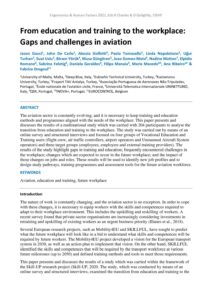
|
Author
Jason Gauci, John De Carlo, Alessia Golfetti, Paola Tomasello, Linda Napoletano, Uğur Turhan, Suat Uslu, Birsen Yörük, Musa Güngören, Joao Gomes-Mota, Nadine Matton, Elpidio Romano, Sabrina Feletig, Daniela Geraldes, Filipa Manaia, Maria Macedo, Ana Ribeiro & Fabrice Drogoul |
Abstract
The aviation sector is constantly evolving, and it is necessary to keep training and education methods and programmes aligned with the needs of the workplace. This paper presents and discusses the results of a multinational study which was carried with 204 participants to analyse the transition from education and training to the workplace. The study was carried out by means of an online survey and structured interviews and focused on four groups of Vocational Education and Training users (flight crew, air traffic controllers, airport operators and Unmanned Aircraft System operators) and three target groups (employees, employers and external training providers). The results of the study highlight gaps in training and education; frequently encountered challenges in the workplace; changes which are expected to occur in the future workplace; and the impact of those changes on jobs and roles. These results will be used to identify new job profiles and to design study pathways, training programmes and assessment tools for the future aviation workforce. |
Publish Date: May 30, 2024 | Keywords: Accessibility, Contemporary EHF 2024, Publications
| Document
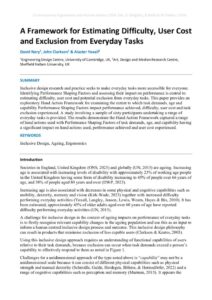
|
Author
David Nery, John Clarkson & Alaster Yoxall |
Abstract
Inclusive design research and practice seeks to make everyday tasks more accessible for everyone. Identifying Performance Shaping Factors and assessing their impact on performance is central to estimating difficulty, user cost and potential exclusion from everyday tasks. This paper provides an exploratory Hand Action Framework for examining the extent to which task demands, age and capability Performance Shaping Factors impact performance achieved, difficulty, user cost and task exclusion experienced. A study involving a sample of sixty participants undertaking a range of everyday tasks is provided. The results demonstrate the Hand Action Framework captured a range of hand actions used with Performance Shaping Factors of task demands, age, and capability having a significant impact on hand actions used, performance achieved and user cost experienced. |
Publish Date: Jun 3, 2024 | Keywords: Contemporary EHF 2024, Human factors integration, Nuclear, Publications, Technology
| Document
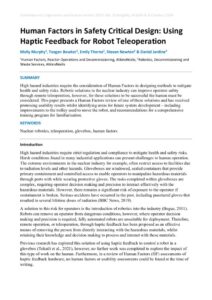
|
Author
Molly Murphy, Teegan Bowker, Emily Thorne, Steven Newton & Daniel Jardine |
Abstract
High hazard industries require the consideration of Human Factors in designing methods to mitigate health and safety risks. Robotic solutions in the nuclear industry can improve operator safety through remote teleoperation, however, for these solutions to be successful the human must be considered. This paper presents a Human Factors review of one of these solutions and has received promising usability results whilst identifying areas for future system development – including improvements to the trolley used to move the robot, and recommendations for a comprehensive training program for familiarisation. |
Publish Date: Sep 20, 2018 | Keywords: Contemporary EHF 2018, Education, training & skills, Healthcare, Publications, Risk assessment
| Document

|
Author
Helen Vosper, Paul Bowie & Sue Hignett |
Abstract
Patient safety is an emergent property of complex sociotechnical healthcare systems. Human Factors and Ergonomics (HFE), with its design-based systems focus, offers frameworks for developing resilient systems, although use in healthcare has been limited to date. Most healthcare educational curricula articulate requirements for students to develop patient safety competencies, but there is scant direction as to how this might be achieved. The authors have produced guidance on embedding HFE in healthcare curricula, but recognise that examples of effective HFE teaching would further support educational practice. This case study outlines a related set of activities based around the NHS Health Check, a population-wide screening programme designed to identify and manage cardiovascular risk. The Health Check represents a cardiovascular risk management system and is amenable to analysis using HFE frameworks. The educational activities described support students in developing a deep awareness of HFE theory, and early development of HFE competencies. The Health Check is a highly relevant professional activity for pharmacy students but would also be relevant to medical and nursing students, as well as healthcare management staff. This case study will form the focus of a discussion that will provide delegates with an opportunity to share experiences of different approaches to HFE education. |
Publish Date: Jun 24, 2022 | Keywords: Contemporary EHF 2022, Manufacturing, Maritime, Publications, Technology
| Document
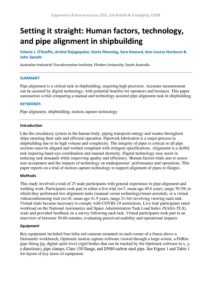
|
Author
Valerie J. O’Keeffe, Arvind Rajagopalan, Kosta Manning, Sara Howard, Ann-Louise Hordacre & John Spoehr |
Abstract
Pipe alignment is a critical task in shipbuilding, requiring high precision. Accurate measurement can be assisted by digital technology, with potential benefits for operators and business. This paper summarises a trial comparing a manual and technology-assisted pipe alignment task in shipbuilding. |
Publish Date: Jul 3, 2018 | Keywords: Contemporary EHF 2018, Publications, Resilience
| Document
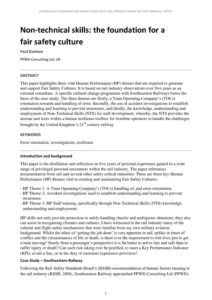
|
Author
Paul Davison |
Abstract
This paper highlights three vital Human Performance (HP) themes that are required to generate and support Fair Safety Cultures. It is based on rail industry observations over five years as an external consultant. A specific cultural change programme with Southeastern Railways forms the basis of the case study. The three themes are firstly, a Train Operating Company’s (TOCs) orientation towards and handling of error. Secondly, the use of accident investigations to establish understanding and learning to prevent recurrence, and thirdly, the knowledge, understanding and employment of Non-Technical Skills (NTS) for staff development, whereby, the NTS provides the armour and tools within a human resilience toolbox for frontline operators to handle the challenges brought by the United Kingdom’s 21st century railway. |
Publish Date: Jun 8, 2023 | Keywords: Contemporary EHF 2023, Healthcare, Publications, Safety, SEIPS
| Document
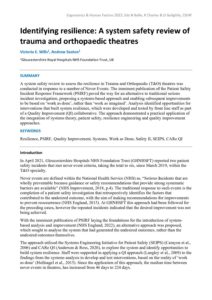
|
Author
Victoria E. Wills, Andrew Seaton |
Abstract
A system safety review to assess the resilience in Trauma and Orthopaedic (T&O) theatres was conducted in response to a number of Never Events. The imminent publication of the Patient Safety Incident Response Framework (PSIRF) paved the way for an alternative to traditional serious incident investigation, proposing a systems-based approach and enabling subsequent improvements to be based on ‘work as done’, rather than ‘work as imagined’. Analysis identified opportunities for interventions that built system resilience, which were developed and tested by front line staff as part of a Quality Improvement (QI) collaborative. The approach demonstrated a practical application of the integration of systems theory, patient safety, resilience engineering and quality improvement approaches. |
Publish Date: Jun 8, 2023 | Keywords: Artificial intelligence, Automation, Contemporary EHF 2023, Cybersecurity, Energy, Human performance, Publications
| Document
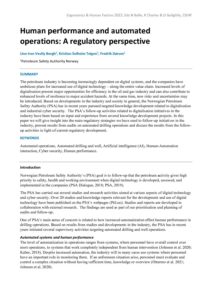
|
Author
Linn Iren Vestly Bergh, Kristian Solheim Teigen & Fredrik Dørum |
Abstract
The petroleum industry is becoming increasingly dependent on digital systems, and the companies have ambitious plans for increased use of digital technology – along the entire value chain. Increased levels of digitalisation present major opportunities for efficiency in the oil and gas industry and can also contribute to enhanced levels of resilience to major accident hazards. At the same time, new risks and uncertainties may be introduced. Based on developments in the industry and society in general, the Norwegian Petroleum Safety Authority (PSA) has in recent years pursued targeted knowledge development related to digitalisation and industrial cyber security. The PSA’s follow-up activities related to digitalisation initiatives in the industry have been based on input and experience from several knowledge development projects. In this paper we will give insight into the main regulatory strategies we have used to follow-up initiatives in the industry, present results from audits on automated drilling operations and discuss the results from the follow-up activities in light of current regulatory development. |
Publish Date: Mar 17, 2019 | Keywords: Contemporary EHF 2016, Healthcare, Publications
| Document
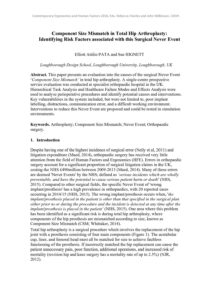
|
Author
Elliott Attilio PATA and Sue HIGNETT |
Abstract
This paper presents an evaluation into the causes of the surgical Never Event ‘Component Size Mismatch’ in total hip arthroplasty. A single-centre prospective service evaluation was conducted at specialist orthopaedic hospital in the UK. Hierarchical Task Analysis and Healthcare Failure Modes and Effects Analysis were used to analyse perioperative procedures and identify potential causes and interventions. Key vulnerabilities in the system included, but were not limited to, poor implant labelling, distractions, communication error, and a difficult working environment. Interventions to reduce this Never Event are proposed and could be tested in simulation environments. |
Publish Date: May 30, 2024 | Keywords: Construction, Contemporary EHF 2024, Publications, Risk assessment, Safety
| Document
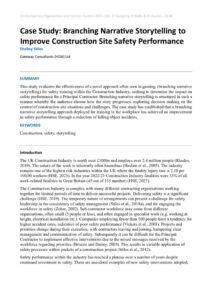
|
Author
Shelley Stiles |
Abstract
This study evaluates the effectiveness of a novel approach often seen in gaming, (branching narrative storytelling) for safety training within the Construction Industry, seeking to determine the impact on safety performance for a Principal Contractor. Branching narrative storytelling is structured in such a manner whereby the audience choose how the story progresses, exploring decision making on the context of construction site situations and challenges. The case study has established that a branching narrative storytelling approach deployed for training in the workplace has achieved an improvement in safety performance through a reduction of falling object incidents. |
Publish Date: Jun 24, 2022 | Keywords: Contemporary EHF 2022, Publications, Tools & techniques, Workload
| Document
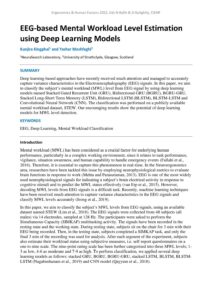
|
Author
Kunjira Kingphai & Yashar Moshfeghi |
Abstract
Deep learning-based approaches have recently received much attention and managed to accurately capture variance characteristics in the Electroencephalography (EEG) signals. In this paper, we aim to classify the subject’s mental workload (MWL) level from EEG signal by using deep learning models named Stacked Gated Recurrent Unit (GRU), Bidirectional GRU (BGRU), BGRU-GRU, Stacked Long-Short Term Memory (LSTM), Bidirectional LSTM (BLSTM), BLSTM-LSTM and Convolutional Neural Network (CNN). The classification was performed on a publicly available mental workload dataset, STEW. Our encouraging results show the potential of deep learning models for MWL level detection. |
Publish Date: Aug 18, 2021 | Keywords: Clothing, Comfort, Comfort Congress 2021, Publications
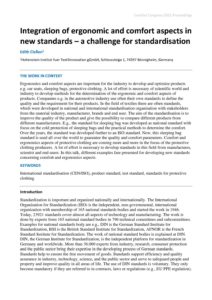 |
Author
Edith Claßen |
Abstract
Ergonomics and comfort aspects are important for the industry to develop and optimize products e.g. car seats, sleeping bags, protective clothing. A lot of effort is necessary of scientific world and industry to develop methods for the determination of the ergonomic and comfort aspects of products. Companies e.g. in the automotive industry use often their own standards to define the quality and the requirement for their products. In the field of textiles there are often standards, which were developed in national and international standardisation organisation with stakeholders from the material industry, manufacturer, brands and end user. The aim of the standardisation is to improve the quality of the product and give the possibility to compare different products from different manufacturers. E.g., the standard for sleeping bag was developed as national standard with focus on the cold protection of sleeping bags and the practical methods to determine the comfort. Over the years, the standard was developed further to an ISO standard. Now, this sleeping bag standard is used all over the world to guarantee the quality and comfort parameters. Comfort and ergonomics aspects of protective clothing are coming more and more in the focus of the protective clothing producers. A lot of effort is necessary to develop standards in this field from manufactures, scientist and end users. In this talk, different examples fare presented for developing new standards concerning comfort and ergonomics aspects. |
Publish Date: Jun 8, 2023 | Keywords: Autonomous systems, Contemporary EHF 2023, Emergency services, Healthcare, Publications
| Document
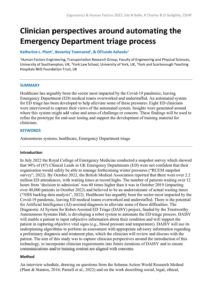
|
Author
Katherine L. Plant, Beverley Townsend, & OlTunde Ashaolu |
Abstract
Healthcare has arguably been the sector most impacted by the Covid-19 pandemic, leaving Emergency Department (ED) medical teams overworked and understaffed. An automated system for ED triage has been developed to help alleviate some of these pressures. Eight ED clinicians were interviewed to capture their views of the automated system. Insights were generated around where this system might add value and areas of challenge or concern. These findings will be used to refine the prototype for end-user testing and support the development of training material for clinicians. |
Publish Date: Aug 19, 2021 | Keywords: Aviation, Comfort Congress 2021, Publications, Seating
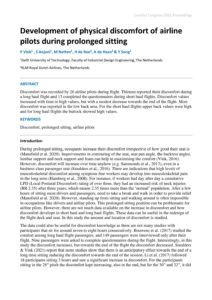 |
Author
P Vink, S Anjani, M Netten, H de Ree, A de Haan & Y Song |
Abstract
Discomfort was recorded by 26 airline pilots during flight. Thirteen reported their discomfort during a long haul flight and 13 completed the questionnaires during short haul flights. Discomfort values increased with time to high values, but with a modest decrease towards the end of the flight. Most discomfort was reported in the low back area. For the short haul flights upper back values were high and for long haul flights the buttock showed high values. |
Publish Date: May 23, 2025 | Keywords: Construction, Contemporary EHF 2025, Health & Safety, Musculoskeletal, Publications
| Document
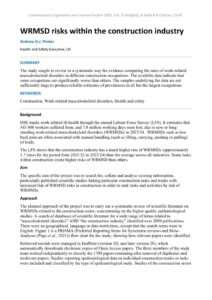
|
Author
Andrew D.J. Pinder |
Abstract
The study sought to review in a systematic way the evidence comparing the rates of work-related musculoskeletal disorders in different construction occupations. The available data indicate that some occupations are significantly worse than others. The samples underlying the data are not sufficiently large to produce reliable estimates of prevalences in all but the largest occupations. |
Publish Date: Jun 3, 2024 | Keywords: Contemporary EHF 2024, Healthcare, Publications, Systems, Tools & techniques
| Document
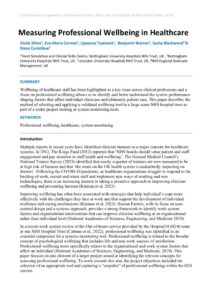
|
Author
Giulia Miles, Eva-Maria Carman,Upasana Topiwala, Benjamin Warren, Sasha Blackwood & Steve Cantellow |
Abstract
Wellbeing of healthcare staff has been highlighted as a key issue across clinical professions and a focus on professional wellbeing allows us to identify and better understand the system performance shaping factors that affect individual clinicians and ultimately patient care. This paper describes the method of selecting and applying a validated wellbeing tool in a large acute NHS hospital trust as part of a wider project looking at system monitoring tools. |
Publish Date: Jun 4, 2024 | Keywords: Contemporary EHF 2024, Investigation, Publications, Systems, Tools & techniques
| Document
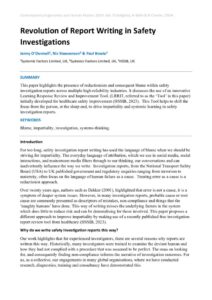
|
Author
Jenny O’Donnell, Nic Steevenson & Paul Bowie |
Abstract
This paper highlights the presence of reductionism and consequent blame within safety investigation reports across multiple high-reliability industries. It discusses the use of an innovative Learning Response Review and Improvement Tool, (LRRIT, referred to as the ‘Tool’ in this paper) initially developed for healthcare safety improvement (HSSIB, 2023). This Tool helps to shift the focus from the person, at the sharp end, to drive impartiality and systemic learning in safety investigation reports. |
Publish Date: Dec 17, 2018 | Keywords: Contemporary EHF 2017, Healthcare, Human factors integration, Publications, Safety
| Document
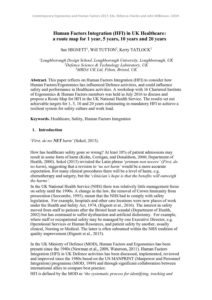
|
Author
Sue HIGNETT, Will TUTTON, Kerry TATLOCK |
Abstract
This paper reflects on Human Factors Integration (HFI) to consider how Human Factors/Ergonomics has influenced Defence activities, and could influence safety and performance in Healthcare activities. A workshop with 16 Chartered Institute of Ergonomics & Human Factors members was held in July 2016 to discuss and propose a Route Map for HFI in the UK National Health Service. The results set out achievable targets for 1, 5, 10 and 20 years culminating in mandatory HFI to achieve a resilient system for safety culture and work load. |
Publish Date: Jun 12, 2023 | Keywords: Contemporary EHF 2023, Healthcare, Human factors integration, Publications
| Document
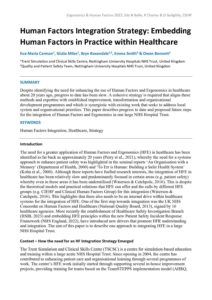
|
Author
Eva-Maria Carman, Giulia Miles, Bryn Baxendale, Emma Smith & Owen Bennett |
Abstract
Despite identifying the need for enhancing the use of Human Factors and Ergonomics in healthcare about 20 years ago, progress to date has been slow. A cohesive strategy is required that aligns these methods and expertise with established improvement, transformation and organisational development programmes and which is synergistic with existing work that seeks to address local system and organisational priorities. This paper describes progress to date and proposed future steps for the integration of Human Factors and Ergonomics in one large NHS Hospital Trust. |
Publish Date: Jun 24, 2022 | Keywords: Contemporary EHF 2022, Data, Incidents, Publications, Safety culture
| Document
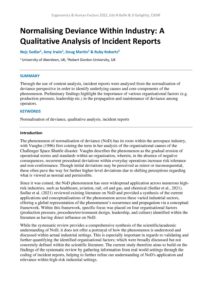
|
Author
Nejc Sedlar, Amy Irwin, Doug Martin & Ruby Roberts |
Abstract
Through the use of content analysis, incident reports were analysed from the normalisation of deviance perspective in order to identify underlying causes and core components of the phenomenon. Preliminary findings highlight the importance of various organisational factors (e.g. production pressure, leadership etc.) in the propagation and maintenance of deviance among operators. |
Publish Date: Apr 8, 2021 | Keywords: Autonomous vehicles, Aviation, Contemporary EHF 2021, Publications, Transport
| Document
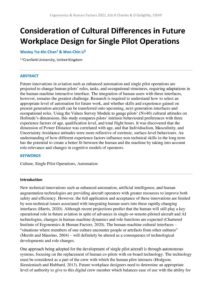
|
Author
Wesley Tsz-Kin Chan & Wen-Chin Li |
Abstract
Future innovations in aviation such as enhanced automation and single pilot operations are projected to change human pilots’ roles, tasks, and occupational structures, requiring adaptations in the human-machine interactive interface. The integration of human users with these interfaces, however, remains the greatest challenge. Research is required to understand how to select an appropriate level of automation for future work, and whether skills and experience gained on present generation aircraft can be transferred onto upcoming, next-generation interfaces and occupational roles. Using the Values Survey Module to gauge pilots’ (N=40) cultural attitudes on Hofstede’s dimensions, this study compares pilots’ intrinsic behavioural preferences with three experience factors of age, qualification level, and total flight hours. It was discovered that the dimension of Power Distance was correlated with age, and that Individualism, Masculinity, and Uncertainty Avoidance attitudes were more reflective of extrinsic, surface-level behaviours. An understanding of how different experience factors influence non-technical skills in the long term has the potential to create a better fit between the human and the machine by taking into account role-relevance and changes in cognitive models of operators. |
Publish Date: Jun 4, 2024 | Keywords: Contemporary EHF 2024, Data, Publications, Systems, Task analysis
| Document
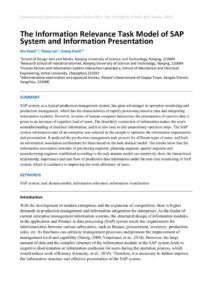
|
Author
Wu Xiaoli, Zhang Lan, Huang Xiaoli |
Abstract
SAP system, as a typical production management system, has great advantages in operation monitoring and production management, which has the characteristics of rapidly processing massive data and integrating information modules. However, in terms of human-computer interaction, the presentation of massive data is prone to an increase of cognitive load of users. The disorderly connection of information makes the user's misunderstanding of interface information, and it is also easy to add unnecessary operation steps. The SAP system information data of an enterprise was selected as the sample to optimize the information organization and presentation. It analyzed the production management task process for different types of users, and built an information association architecture for them based on the task domain model. The results show that the information association structure of purchasing engineer, planning engineer, quality engineer and manufacturing engineer established according to the task domain model can intuitively show the hierarchical relationship, importance and task flow of production data information under the real-time monitoring of SAP system, which is conducive to improving the work efficiency of users. |
Publish Date: Aug 16, 2021 | Keywords: Climate change, Clothing, Comfort, Comfort Congress 2021, Perception, Publications
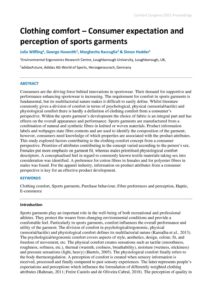 |
Author
Julia Wilfling, George Havenith, Margherita Raccuglia & Simon Hodder |
Abstract
Consumers are the driving force behind innovations in sportswear. Their demand for supportive and performance enhancing sportswear is increasing. The requirement for comfort in sports garments is fundamental, but its multifactorial nature makes it difficult to easily define. Whilst literature commonly gives a division of comfort in terms of psychological, physical (sensorial/tactile) and physiological comfort there is hardly a definition of clothing comfort from a consumer’s perspective. Within the sports garment’s development the choice of fabric is an integral part and has effects on the overall appearance and performance. Sports garments are manufactured from a combination of natural and synthetic fibres in knitted or woven materials. Product information labels and webpages state fibre contents and are used to identify the composition of the garment; however, consumers need knowledge of which properties are associated with the product attributes. This study explored factors contributing to the clothing comfort concept from a consumer perspective. Priorities of attributes contributing to the concept varied according to the person’s sex. Females put more emphasis on garment fit, whereas males prioritised physiological comfort descriptors. A conceptualised feel in regard to commonly known textile materials taking sex into consideration was identified. A preference for cotton fibres in females and for polyester fibres in males was found. For the apparel industry, information on product attributes from a consumer perspective is key for an effective product development. |
Publish Date: Dec 17, 2018 | Keywords: Contemporary EHF 2017, Publications, Road safety, Sport & leisure, Teamwork
| Document

|
Author
Paul SALMON, Clare DALLAT, Amanda CLACY |
Abstract
This paper presents the findings from a study examining situation awareness and teamwork in elite women’s cycling. This involved observing an elite racing team during two Australian National Road Series race events and conducting post-race critical decision method interviews. The data were analyzed using the Event Analysis of Systemic Teamwork framework to show the task, social and situation awareness networks underpinning team performance. The findings are discussed in relation to enhancing cycling team performance and potential applications in other sports. |
Publish Date: Aug 18, 2021 | Keywords: Aviation, Comfort, Comfort Congress 2021, Musculoskeletal, Publications, Seating
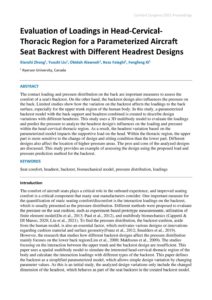 |
Author
Xianzhi Zhong, Yuezhi Liu, Obidah Alawneh, Reza Faieghi & Fengfeng Xi |
Abstract
The contact loading and pressure distribution on the back are important measures to assess the comfort of a seat's backrest. On the other hand, the backrest design also influences the pressure on the back. Limited studies show how the variation on the backrest affects the loadings to the back surface, especially for the upper trunk region of the human body. In this study, a parameterized backrest model with the back support and headrest combined is created to describe design variations with different headrests. This study uses a 3D multibody model to evaluate the loadings and predict the pressure to analyze the headrest design's influences on the loading and pressure within the head-cervical-thoracic region. As a result, the headrest variation based on the parameterized model impacts the supportive load on the head. Within the thoracic region, the upper part is more sensitive to the change of design and sitting condition than the lower part. Different designs also affect the location of higher-pressure areas. The pros and cons of the analyzed designs are discussed. This study provides an example of assessing the design using the proposed load and pressure prediction method for the backrest. |
Publish Date: Jun 4, 2024 | Keywords: Aviation, Contemporary EHF 2024, Design, Human-machine interaction, Publications, Workload
| Document
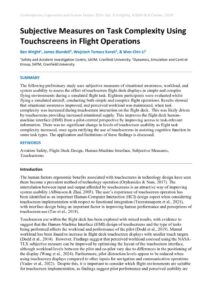
|
Author
Ben Wright, James Blundell, Wojciech Tomasz Korek, & Wen-Chin Li |
Abstract
The following preliminary study uses subjective measures of situational awareness, workload, and system usability to assess the effect of touchscreen flight deck displays in simple and complex flying environments during a simulated flight task. Eighteen participants were evaluated whilst flying a simulated aircraft, conducting both simple and complex flight operations. Results showed that situational awareness improved, and perceived workload was maintained, when task complexity was increased during touchscreen interaction on the flight deck. This was likely driven by touchscreens providing increased attentional supply. This improves the flight deck human�machine interface (HMI) from a pilot-centred perspective by improving access to task-relevant information. There was no significant change in levels of touchscreen usability as flight task complexity increased, once again ratifying the use of touchscreens in assisting cognitive function in some task types. The application and limitations of these findings is discussed. |
Publish Date: Jun 8, 2023 | Keywords: Construction, Contemporary EHF 2023, Design, Healthcare, Publications
| Document
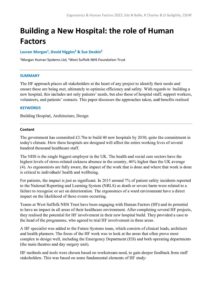
|
Author
Lauren Morgan, David Higgins & Sue Deakin |
Abstract
The HF approach places all stakeholders at the heart of any project to identify their needs and ensure these are being met, ultimately to optimise efficiency and safety. With regards to building a new hospital, this includes not only patients’ needs, but also those of hospital staff, support workers, volunteers, and patients’ contacts. This paper discusses the approaches taken, and benefits realised |
Publish Date: Apr 9, 2020 | Keywords: Contemporary EHF 2020, Healthcare, Mental health & wellbeing, Psychology, Publications
| Document
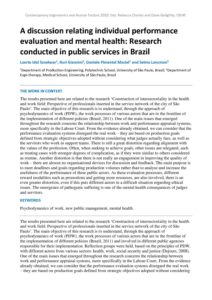
|
Author
Laerte Idal Sznelwar, Ruri Giannini, Daniele Pimentel Maciel and Selma Lancman |
Abstract
The results presented here are related to the research ‘Construction of intersectoriality in the health and work field: Perspective of professionals inserted in the service network of the city of São Paulo’. The main objective of this research is to understand, through the approach of psychodynamics of work (PDW), the work processes of various actors that are in the frontline of the implementation of different policies (Brasil, 2011). One of the main issues that emerged throughout the research concerns the relationship between work and performance appraisal systems, more specifically in the Labour Court. From the evidence already obtained, we can consider that the performance evaluation systems disregard the real work – they are based on production goals defined from strategic objectives adopted without considering what judges actually face, as well as the servitors who work in support teams. There is still a great distortion regarding alignment with the values of the profession. Often, when seeking to achieve goals, other issues are relegated, such as treating cases with stronger degrees of complication, as if they were similar to others considered as routine. Another distortion is that there is not really an engagement in improving the quality of work – there are almost no organisational devices for discussion and feedback. The main purpose is to meet deadlines and goals regarding production volumes rather than to analyse and increase the usefulness of the performance of these public actors. As these evaluation processes, different reward modalities such as promotions and getting more resources, are also involved, there is an even greater distortion, even if this puts different actors in a difficult situation regarding ethical issues. The emergence of pathogenic suffering is one of the mental health consequences of judges and servitors. |
Publish Date: Jun 3, 2024 | Keywords: Automation, Contemporary EHF 2024, Design, Publications, Systems, Technology
| Document
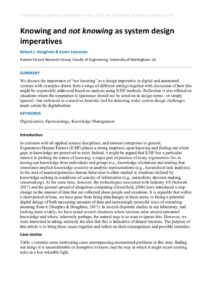
|
Author
Robert J. Houghton & Karen Lancaster |
Abstract
We discuss the importance of “not knowing” as a design imperative in digital and automated systems with examples drawn from a range of different settings together with discussion of how this might be responsibly addressed based on analysis using E/HF methods. Reflection is also offered on situations where the temptation to ignorance should not be acted on in design terms - or simply ignored - but embraced as a sensitive heuristic tool for detecting wider system design challenges made salient by digitalisation. |
Publish Date: Jun 3, 2024 | Keywords: Contemporary EHF 2024, Defence, Human performance, Publications, Workload
| Document
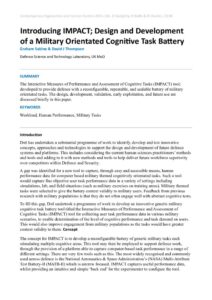
|
Author
Graham Sabine & David J Thompson |
Abstract
The Interactive Measures of Performance and Assessment of Cognitive Tasks (IMPACT) tool; developed to provide defence with a reconfigurable, repeatable, and scalable battery of military orientated tasks. The design, development, validation, early exploitation, and future use are discussed briefly in this paper. |
Publish Date: Jun 4, 2024 | Keywords: Contemporary EHF 2024, Psychology, Publications, Risk assessment
| Document
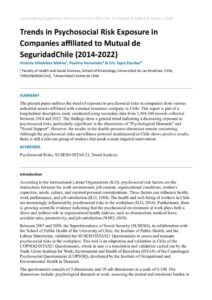
|
Author
Victoria Villalobos-Molina, Paulina Hernandez & Eric Tapia Escobar |
Abstract
The present paper outlines the trend of exposure to psychosocial risks in companies from various industrial sectors affiliated with a mutual insurance company in Chile. This report is part of a longitudinal descriptive study conducted using secondary data from 1,568,340 records collected between 2014 and 2022. The findings show a general trend indicating a decreasing exposure to psychosocial risks, particularly significant in the dimensions of "Psychological Demands" and "Social Support". However, the results in the double presence dimension remain concerning. Although the psychosocial risks surveillance protocol implemented in Chile shows positive results, there is still a relevant group of workers that needs a more targeted intervention. |
Publish Date: Oct 23, 2018 | Keywords: Anthropometry, Contemporary EHF 2018, Fatigue & sleep, Publications
| Document
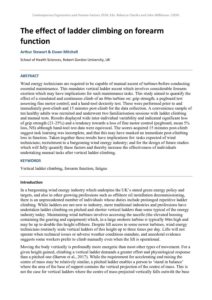
|
Author
Arthur Stewart & Dawn Mitchell |
Abstract
Wind energy technicians are required to be capable of manual ascent of turbines before conducting essential maintenance. This mandates vertical ladder ascent which involves considerable forearm exertion which may have implications for such maintenance tasks. This study aimed to quantify the effect of a simulated and continuous climb of an 80m turbine on: grip strength; a pegboard test assessing fine motor control; and a hand-tool dexterity test. These were performed prior to and immediately post-climb and 15 minutes post-climb for the data collection. A convenience sample of ten healthy adults was recruited and underwent two familiarisation sessions with ladder climbing and manual tests. Results displayed wide inter-individual variability and indicated significant loss of grip strength (21-25%) and a tendency towards a loss of fine motor control (pegboard, mean 5% loss, NS) although hand-tool test data were equivocal. The scores acquired 15 minutes post-climb suggest task learning was incomplete, and that this may have masked an immediate post-climbing loss in function. Taken together these results have implications for: tasks expected of wind technicians; recruitment to a burgeoning wind energy industry; and for the design of future studies which will fully quantify these factors and thereby increase the effectiveness of individuals undertaking manual tasks after vertical ladder climbing. |
Publish Date: Jun 23, 2022 | Keywords: Contemporary EHF 2022, Design, Healthcare, Publications
| Document
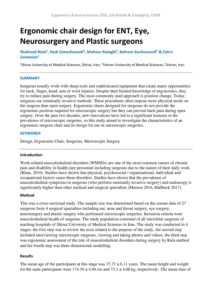
|
Author
Shahrzad Riaei, Hadi Daneshmandi, Mohsen Razeghi, Bahram Kouhnavard & Zahra Zamanian |
Abstract
Surgeons usually work with sharp tools and sophisticated equipment that create many opportunities for neck, finger, hand, arm or wrist injuries. Despite their limited knowledge of ergonomics, they try to reduce pain during surgery. The most commonly used approach is position change. Today, surgeons use minimally invasive methods. These procedures often impose more physical needs on the surgeon than open surgery. Ergonomic chairs designed for surgeons do not provide the ergonomic position required for microscopic surgery but they can prevent back pain during open surgery. Over the past two decades, new innovations have led to a significant increase in the prevalence of microscopic surgeries, so this study aimed to investigate the characteristics of an ergonomic surgeon chair and its design for use in microscopic surgeries. |
Publish Date: May 30, 2024 | Keywords: Contemporary EHF 2024, Human factors integration, Publications, Safety
| Document
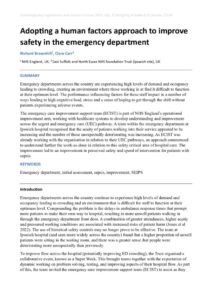
|
Author
Richard Brownhill, Clare Carr |
Abstract
Emergency departments across the country are experiencing high levels of demand and occupancy leading to crowding, creating an environment where those working in at find it difficult to function at their optimum level. The performance influencing factors for these staff impact in a number of ways leading to high cognitive load, stress and a sense of hoping to get through the shift without patients experiencing adverse events. The emergency care improvement support team (ECIST) is part of NHS England’s operational improvement arm, working with healthcare systems to develop understanding and improvement across the urgent and emergency care (UEC) pathway. A team within the emergency department at Ipswich hospital recognised that the acuity of patients walking into their service appeared to be increasing and the number of those unexpectedly deteriorating was increasing. As ECIST was already working with the organisation in relation to their UEC pathways, an approach commenced to understand further the work-as-done in relation to this safety critical area of hospital care. The improvement led to an improvement in perceived safety and speed of intervention for patients with sepsis. |
Publish Date: May 30, 2024 | Keywords: Automation, Contemporary EHF 2024, Publications, Transport
| Document
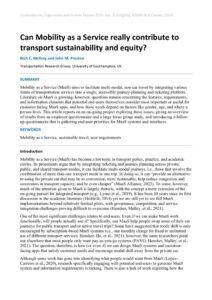
|
Author
Rich C. McIlroy and John M. Preston |
Abstract
Mobility as a Service (MaaS) aims to facilitate multi-modal, non-car travel by integrating various forms of transportation services into a single, accessible journey-planning and ticketing platform. Literature on MaaS is growing; however, questions remain concerning the features, requirements, and information elements that potential end users themselves consider most important or useful for customer facing MaaS apps, and how those needs depend on factors like gender, age, and where a person lives. This article reports on an on-going project exploring these issues, giving an overview of results from an employer questionnaire and a large focus group study, and introducing a follow�up questionnaire that is gathering end-user priorities for MaaS systems and interfaces. |
Publish Date: Jun 4, 2024 | Keywords: Contemporary EHF 2024, Data, Publications, Transport
| Document
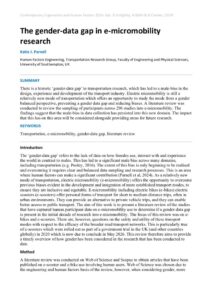
|
Author
Katie J. Parnell |
Abstract
There is a historic ‘gender-data gap’ in transportation research, which has led to a male-bias in the design, experience and development of the transport industry. Electric micromobility is still a relatively new mode of transportation which offers an opportunity to study the mode from a gender balanced perspective, preventing a gender data gap and reducing biases. A literature review was conducted to review the sampling of participants across 296 studies into e-micromobility. The findings suggest that the male-bias in data collection has persisted into this new domain. The impact that this has on this area will be considered alongside providing areas for future research. |
Publish Date: Jun 8, 2023 | Keywords: Contemporary EHF 2023, Equality, diversity & inclusion (EDI), Publications, Road safety
| Document
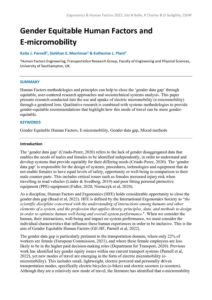
|
Author
Katie J. Parnell, Siobhan E. Merriman & Katherine L. Plant |
Abstract
Human Factors methodologies and principles can help to close the ‘gender data gap’ through equitable, user-centered research approaches and sociotechnical systems analysis. This paper presents research conducted into the use and uptake of electric micromobility (e-micromobility) through a gendered lens. Qualitative research is combined with systems methodologies to provide gender-equitable recommendations that highlight how this mode of travel can be more gender-equitable. |
Publish Date: Jul 2, 2018 | Keywords: Contemporary EHF 2018, Health & Safety, Leadership, Publications
| Document
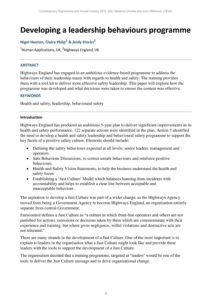
|
Author
Nigel Heaton, Claire Philps & Andy Stocks |
Abstract
Highways England has engaged in an ambitious evidence-based programme to address the behaviours of their leadership teams with regards to health and safety. The training provides them with a tool kit to deliver more effective safety leadership. This paper will explore how the programme was developed and what decisions were taken to ensure the content was effective. |
Publish Date: Jun 24, 2022 | Keywords: Accimaps, Contemporary EHF 2022, Interface design, Investigation, Publications, Rail
| Document
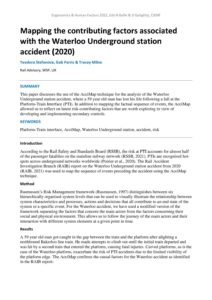
|
Author
Teodora Stefanova, Gab Parris & Tracey Milne |
Abstract
This paper discusses the use of the AcciMap technique for the analysis of the Waterloo Underground station accident, where a 59 year old man has lost his life following a fall at the Platform-Train Interface (PTI). In addition to mapping the factual sequence of events, the AcciMap allowed us to reflect on latent risk-contributing factors that are worth exploring in view of developing and implementing secondary controls. |
Publish Date: Jun 8, 2023 | Keywords: Cognition, Contemporary EHF 2023, Publications, Usability, User centred design
| Document
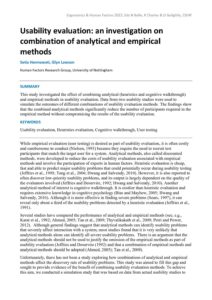
|
Author
Setia Hermawati & Glyn Lawson |
Abstract
This study investigated the effect of combining analytical (heuristics and cognitive walkthrough) and empirical methods in usability evaluation. Data from two usability studies were used to simulate the outcomes of different combinations of usability evaluation methods. The findings show that the combined analytical methods significantly reduce the number of participants required in the empirical method without compromising the results of the usability evaluation. |
Publish Date: May 31, 2024 | Keywords: Contemporary EHF 2024, Publications, Technology
| Document
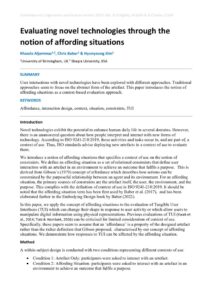
|
Author
Khawla Aljammaz, Chris Baber & Hyunyoung Kim |
Abstract
User interactions with novel technologies have been explored with different approaches. Traditional approaches seem to focus on the abstract form of the artefact. This paper introduces the notion of affording situations as a context-based evaluation approach. |
Publish Date: Jun 23, 2022 | Keywords: Contemporary EHF 2022, Defence, Publications, Submarines
| Document
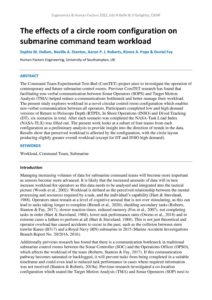
|
Author
Sophie M. Hallam, Neville A. Stanton, Aaron P. J. Roberts, Kiome A. Pope & Daniel Fay |
Abstract
The Command Team Experimental Test-Bed (ComTET) project aims to investigate the operation of contemporary and future submarine control rooms. Previous ComTET research has found that facilitating non-verbal communication between Sonar Operators (SOPS) and Target Motion Analysts (TMA) helped reduce a communications bottleneck and better manage their workload. The present study explores workload in a novel circular control room configuration which enables non-verbal communication between all operators. Participants completed low and high demand versions of Return to Periscope Depth (RTPD), In Shore Operations (INSO) and Dived Tracking (DT), six scenarios in total. After each scenario was completed the NASA-Task Load Index (NASA-TLX) was filled out. The present work looks at a subset of four teams from each configuration as a preliminary analysis to provide insight into the direction of trends in the data. Results show that perceived workload is affected by the configuration, with the circle layout producing slightly greater overall workload (except for DT and INSO high demand). |
Publish Date: Sep 30, 2018 | Keywords: Cognition, Contemporary EHF 2018, Decision making, Healthcare, Publications, Task analysis
| Document
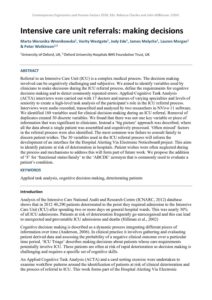
|
Author
Marta Weronika Wronikowska, Verity Westgate, Jody Ede, James Malycha, Lauren Morgan & Peter Watkinson |
Abstract
Referral to an Intensive Care Unit (ICU) is a complex medical process. The decision making involved can be cognitively challenging and subjective. We aimed to identify variables used by clinicians to make decisions during the ICU referral process, define the requirements for cognitive decision making and to detect commonly repeated errors. Applied Cognitive Task Analysis (ACTA) interviews were carried out with 17 doctors and nurses of varying specialties and levels of seniority to create a high-level task analysis of the participant’s role in the ICU referral process. Interviews were audio recorded, transcribed and analysed by two researchers in NVivo 11 software. We identified 188 variables used for clinical decision-making during an ICU referral. Removal of duplicates created 30 discrete variables. We found that there was not one key variable or piece of information that was significant to clinicians. Instead a ‘big picture’ approach was described, where all the data about a single patient was assembled and cognitively processed. ‘Often missed’ factors in the referral process were also identified. The most common was failure to consult family to discern patient wishes. The 30 variables used in the ICU referral process will inform the development of an interface for the Hospital Alerting Via Electronic Noticeboard project. This aims to identify patients at risk of deterioration in hospitals. Patient wishes were often neglected during the process and mechanisms to address this will form part of future work. We propose the addition of ‘F’ for ‘functional status/family’ to the ‘ABCDE’ acronym that is commonly used to evaluate a patient’s condition. |
Publish Date: Apr 17, 2020 | Keywords: Contemporary EHF 2020, Publications, Workload
| Document
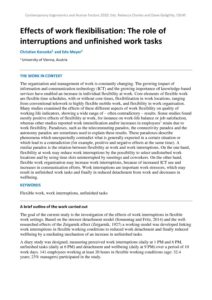
|
Author
Christian Korunka and Edo Meyer |
Abstract
The organisation and management of work is constantly changing. The growing impact of information and communication technology (ICT) and the growing importance of knowledge-based services have enabled an increase in individual flexibility at work. Core elements of flexible work are flexible time schedules, with or without core times, flexibilisation in work locations, ranging from conventional telework to highly flexible mobile work, and flexibility in work organisation. Many studies examined the effects of these different aspects of work flexibility on quality of working life indicators, showing a wide range of – often contradictory – results. Some studies found mostly positive effects of flexibility at work, for instance on work-life balance or job satisfaction, whereas other studies reported work intensification and/or increases in employees’ strain due to work flexibility. Paradoxes, such as the telecommuting paradox, the connectivity paradox and the autonomy paradox are sometimes used to explain these results. These paradoxes describe phenomena which unexpectedly contradict what is generally expected in a certain situation or which lead to a contradiction (for example, positive and negative effects at the same time). A similar paradox is the relation between flexibility at work and work interruptions. On the one hand, flexibility at work may reduce work interruptions by the possibility to select undisturbed work locations and by using time slots uninterrupted by meetings and coworkers. On the other hand, flexible work organisation may increase work interruptions, because of increased ICT use and increases in communication efforts. Work interruptions are important work stressors, which may result in unfinished work tasks and finally in reduced detachment from work and decreases in wellbeing. |
Publish Date: Apr 8, 2021 | Keywords: Automotive, Contemporary EHF 2021, Organisational design, Pandemic, Publications
| Document
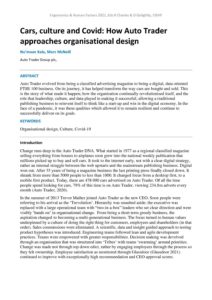
|
Author
Nu’maan Kala, Marc McNeill |
Abstract
Auto Trader evolved from being a classified advertising magazine to being a digital, data oriented FTSE 100 business. On its journey, it has helped transform the way cars are bought and sold. This is the story of what made it happen; how the organisation continually revolutionised itself, and the role that leadership, culture, and data played in making it successful; allowing a traditional publishing business to reinvent itself to think like a start-up and win in the digital economy. In the face of a pandemic, it was these qualities which allowed it to remain resilient and continue to successfully deliver on its goals. |
Publish Date: Feb 27, 2019 | Keywords: Automotive, Behaviour, Construction, Contemporary EHF 2016, Health & Safety, Publications
| Document
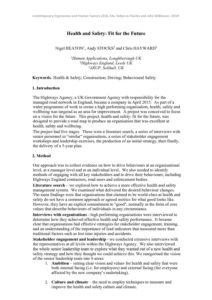
|
Author
Nigel HEATON, Andy STOCKS and Chris HAYWARD |
Abstract
|
Publish Date: Apr 9, 2021 | Keywords: Contemporary EHF 2021, Perception, Publications, Tools & techniques
| Document
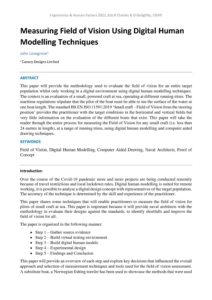
|
Author
John Lovegrove |
Abstract
This paper will provide the methodology used to evaluate the field of vision for an entire target population whilst only working in a digital environment using digital human modelling techniques. The context is an evaluation of a small, powered craft at sea, operating at different running trims. The maritime regulations stipulate that the pilot of the boat must be able to see the surface of the water at one boat length. The standard BS EN ISO 11591:2019 ‘Small craft – Field of Vision from the steering position’ provides the practitioner with the target conditions in the horizontal and vertical fields but very little information on the evaluation of the different boats that exist. This paper will take the reader through the entire process for measuring the Field of Vision for any small craft (i.e. less than 24 metres in length), at a range of running trims, using digital human modelling and computer aided drawing techniques. |
Publish Date: Mar 17, 2019 | Keywords: Aviation, Contemporary EHF 2016, Publications, Workload
| Document
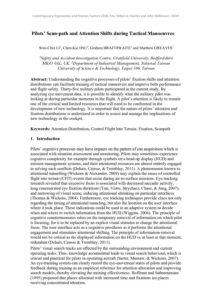
|
Author
Wen-Chin LI, Chen-Kai HSU, Graham BRAITHWAITE and Matthew GREAVES |
Abstract
Understanding the cognitive processes of pilots’ fixation shifts and attention distributions can facilitate training of tactical maneuvers and improve both performance and flight safety. Thirty-five military pilots participated in the current study. By analyzing eye movement data, it is possible to identify what the military pilot was looking at during particular moments in the flight. A pilot’s attention is likely to remain one of the critical and limited resources that will need to be confronted in the development of new technology. It is important that the nature of pilots’ attention and fixation distributions is understood in order to assess and manage the implications of new technology in the cockpit. |
Publish Date: Jun 11, 2025 | Keywords: Contemporary EHF 2025, Design, Pharmaceutical, Publications, Safety
| Document
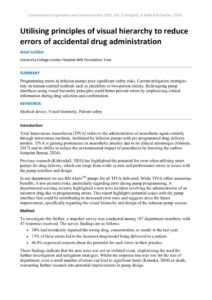
|
Author
Amol Lotlikar |
Abstract
Programming errors in infusion pumps pose significant safety risks. Current mitigation strategies rely on human-centred methods such as checklists or two-person checks. Redesigning pump interfaces using visual hierarchy principles could better prevent errors by emphasising critical information during drug selection and confirmation. |
Publish Date: Aug 18, 2021 | Keywords: Comfort, Comfort Congress 2021, Publications
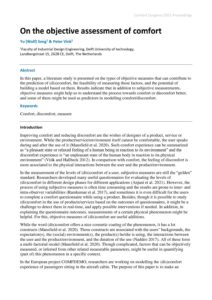 |
Author
Yu (Wolf) Song & Peter Vink |
Abstract
In this paper, a literature study is presented on the types of objective measures that can contribute to the prediction of (dis)comfort, the feasibility of measuring those factors, and the potential of building a model based on them. Results indicate that in addition to subjective measurements, objective measures might help us to understand the process towards comfort or discomfort better, and some of them might be used as predictors in modelling comfort/discomfort. |
Publish Date: Dec 17, 2018 | Keywords: Contemporary EHF 2017, Data, Defence, Design, Publications, User centred design
| Document
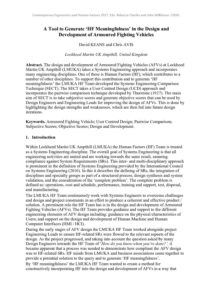
|
Author
David KEANE and Chris AVIS |
Abstract
The design and development of Armoured Fighting Vehicles (AFVs) at Lockheed Martin UK Ampthill (LMUKA) takes a Systems Engineering approach and incorporates many engineering disciplines. One of these is Human Factors (HF), which contributes to a number of other disciplines. To support this contribution and to generate ‘HF meaningfulness’ the LMUKA HF Team developed the Systems Engineering Comparison Technique (SECT). The SECT takes a User Centred Design (UCD) approach and incorporates the pairwise comparison technique developed by Thurstone (1927). The main aim of SECT is to take subjective scores and generate objective scores that can be used by Design Engineers and Engineering Leads for improving the design of AFVs. This is done by highlighting the design strengths and weaknesses, which are then fed into future design iterations. |
Publish Date: May 27, 2025 | Keywords: Contemporary EHF 2025, Musculoskeletal, Publications, Risk assessment
| Document
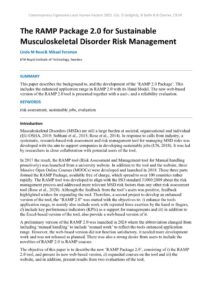
|
Author
Linda M Rose & Mikael Forsman |
Abstract
This paper describes the background to, and the development of the ‘RAMP 2.0 Package’. This includes the enhanced application range in RAMP 2.0 with its Hand Model. The new web-based version of the RAMP 2.0 tool is presented together with a user-, and a reliability evaluation. |
Publish Date: Sep 7, 2019 | Keywords: Behaviour, Contemporary EHF 2019, Publications, Risk assessment, Road safety
| Document
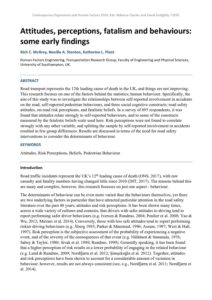
|
Author
Rich C. McIlroy, Neville A. Stanton, Katherine L. Plant |
Abstract
Road transport represents the 12th leading cause of death in the UK, and things are not improving. This research focuses on one of the factors behind the statistics; human behaviour. Specifically, the aim of this study was to investigate the relationships between self-reported involvement in accidents on the road, self-reported pedestrian behaviours, and three social cognitive constructs; road safety attitudes, on-road risk perceptions, and fatalistic beliefs. In a survey of 695 respondents, it was found that attitudes relate strongly to self-reported behaviours, and to some of the constructs measured by the fatalistic beliefs scale used here. Risk perceptions were not found to correlate strongly with any other variable, and splitting the sample by self-reported involvement in accidents resulted in few group differences. Results are discussed in terms of the need for road safety interventions to consider the determinants of behaviour. |
Publish Date: May 30, 2024 | Keywords: Artificial intelligence, Contemporary EHF 2024, Healthcare, Human factors integration, Publications
| Document
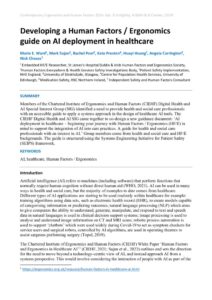
|
Author
Marie E. Ward, Mark Sujan, Rachel Pool, Kate Preston, Huayi Huang, Angela Carrington, Nick Chozos |
Abstract
Members of the Chartered Institute of Ergonomics and Human Factors (CIEHF) Digital Health and AI Special Interest Group (SIG) identified a need to provide health and social care professionals with an accessible guide to apply a systems approach in the design of healthcare AI tools. The CIEHF Digital Health and AI SIG came together to co-design a new guidance document: ‘AI deployment in healthcare – beginning your journey with Human Factors / Ergonomics (HF/E) in mind to support the integration of AI into care practices. A guide for health and social care professionals with an interest in AI.’ Group members come from health and social care and HF/E backgrounds. The guide is structured using the Systems Engineering Initiative for Patient Safety (SEIPS) framework. |
Publish Date: Jun 8, 2023 | Keywords: Contemporary EHF 2023, Publications, Rail, Situation awareness
| Document
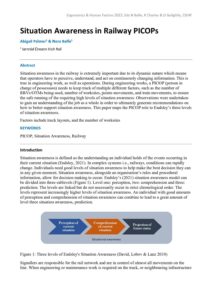
|
Author
Abigail Palmer & Nora Balfe |
Abstract
Situation awareness in the railway is extremely important due to its dynamic nature which means that operators have to perceive, understand, and act on continuously changing information. This is true in engineering work, as well as operations. During engineering works, a PICOP (person in charge of possession) needs to keep track of multiple different factors, such as the number of RRVs/OTMs being used, number of worksites, points movements, and train movements, to ensure the safe running of the requiring high levels of situation awareness. Observations were undertaken to gain an understanding of the job as a whole in order to ultimately generate recommendations on how to better support situation awareness. This paper maps the PICOP role to Endsley’s three levels of situation awareness. Factors include track layouts, and the number of worksites |
Publish Date: May 27, 2025 | Keywords: Cognition, Contemporary EHF 2025, Publications, Virtual reality
| Document
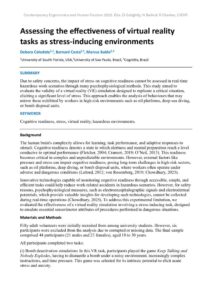
|
Author
Debora Colodete, Bernard Costa & Marcus Baldo |
Abstract
Due to safety concerns, the impact of stress on cognitive readiness cannot be assessed in real-time hazardous work scenarios through many psychophysiological methods. This study aimed to evaluate the validity of a virtual reality (VR) simulation designed to replicate a critical situation, eliciting a significant level of stress. This approach enables the analysis of behaviours that may mirror those exhibited by workers in high-risk environments such as oil platforms, deep-sea diving, or bomb disposal units. |
Publish Date: Apr 9, 2020 | Keywords: Contemporary EHF 2020, Investigation, Publications
| Document
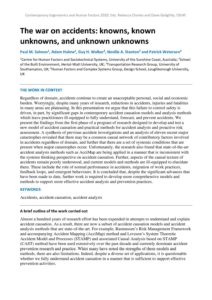
|
Author
Paul M. Salmon, Adam Hulme, Guy H. Walker, Neville A. Stanton and Patrick Waterson |
Abstract
Regardless of domain, accidents continue to create an unacceptable personal, social and economic burden. Worryingly, despite many years of research, reductions in accidents, injuries and fatalities in many areas are plateauing. In this presentation we argue that this failure to control safety is driven, in part, by significant gaps in contemporary accident causation models and analysis methods which leave practitioners ill-equipped to fully understand, forecast, and prevent accidents. We present the findings from the first phase of a program of research designed to develop and test a new model of accident causation and practical methods for accident analysis and proactive risk assessment. A synthesis of previous accident investigations and an analysis of eleven recent major catastrophes revealed that there may be a common causal network of contributory factors involved in accidents regardless of domain, and further that there are a set of systemic conditions that are present when major catastrophes occur. Unfortunately, the research also found that state-of-the-art accident analysis methods such as AcciMap are being applied in a manner that is inconsistent with the systems thinking perspective on accident causation. Further, aspects of the causal texture of accidents remain poorly understood, and current models and methods are ill-equipped to elucidate them. These include the role of normal performance in accidents, migration of work practices, feedback loops, and emergent behaviours. It is concluded that, despite the significant advances that have been made to date, further work is required to develop more comprehensive models and methods to support more effective accident analysis and prevention practices. |
Publish Date: Aug 6, 2021 | Keywords: Comfort, Comfort Congress 2021, Publications, Simulation
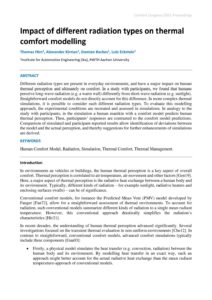 |
Author
Thomas Hirn, Alexander Kirmas, Damian Backes & Lutz Eckstein |
Abstract
Different radiation types are present in everyday environments, and have a major impact on human thermal perception and ultimately on comfort. In a study with participants, we found that humans perceive long-wave radiation (e.g. a warm wall) differently from short-wave radiation (e.g. sunlight). Straightforward comfort models do not directly account for this difference. In more complex thermal simulations, it is possible to consider such different radiation types. To evaluate this modelling approach, the experimental conditions are recreated and assessed in simulations. In analogy to the study with participants, in the simulation a human manikin with a comfort model predicts human thermal perception. Then, participants’ responses are contrasted to the comfort model predictions. Comparison of simulated and participant-reported results allow identification of deviations between the model and the actual perception, and thereby suggestions for further enhancements of simulations are derived. |
Publish Date: May 31, 2024 | Keywords: Contemporary EHF 2024, Publications, Rail, Technology, Transport
| Document
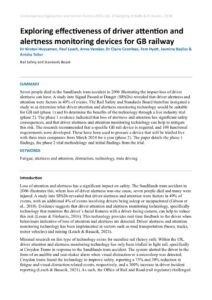
|
Author
Dr Kirsten Huysamen, Paul Leach, Anna Vereker, Dr Claire Coombes, Tom Hyat, Jasmine Bayliss & Anisha Tailor |
Abstract
Seven people died in the Sandilands tram accident in 2006 illustrating the impact loss of driver alertness can have. A study into Signal Passed at Danger (SPADs) revealed that driver alertness and attention were factors in 49% of events. The Rail Safety and Standards Board therefore instigated a study to a) determine what driver attention and alertness monitoring technology would be suitable for GB rail (phase 1) and b) determine the benefits of the technology through a live industry trial (phase 2). The phase 1 evidence indicated that loss of alertness and attention has significant safety consequences, and that driver alertness and attention monitoring technology can help to mitigate this risk. The research recommended that a specific GB rail device is required, and 108 functional requirements were developed. These have been used to procure a device that will be trialled live with three train companies from March 2024 for a year (phase 2). The paper details the phase 1 findings, the phase 2 trial methodology and initial findings from the trial. |
Publish Date: Oct 23, 2018 | Keywords: Contemporary EHF 2018, Defence, Publications, Submarines, Workload
| Document
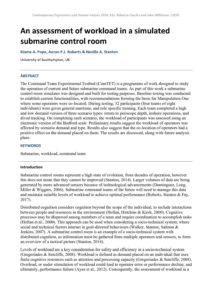
|
Author
Kiome A. Pope, Aaron P.J. Roberts & Neville A. Stanton |
Abstract
The Command Team Experimental Testbed (ComTET) is a programme of work designed to study the operation of current and future submarine command teams. As part of this work a submarine control room simulator was designed and built for testing purposes. Baseline testing was conducted to establish current functionalities, with recommendations forming the basis for Manipulation One where some operators were co-located. During testing, 32 participants (four teams of eight individuals) were given general maritime, and role specific training. Each team completed a high and low demand version of three scenario types: return to periscope depth, inshore operations, and dived tracking. On completing each scenario, the workload of participants was assessed using an electronic version of the Bedford scale. Preliminary results suggest the workload of operators was affected by scenario demand and type. Results also suggest that the co-location of operators had a positive effect on the demand placed on them. The results are discussed, along with future analysis plans. |
Publish Date: Dec 17, 2018 | Keywords: Contemporary EHF 2017, Mental health & wellbeing, Publications
| Document
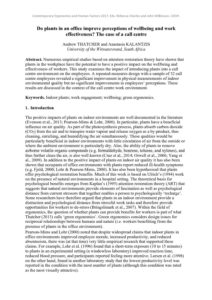
|
Author
Andrew THATCHER and Anastasia KALANTZIS |
Abstract
Numerous empirical studies based on attention restoration theory have shown that plants in the workplace have the potential to have a positive impact on the wellbeing and effectiveness of workers. This study examines the impact of introducing plants into a call centre environment on the employees. A repeated-measures design with a sample of 32 call centre employees revealed a significant improvement in physical measurements of indoor environmental quality but no significant improvements in employees’ perceptions. These results are discussed in the context of the call centre work environment. |
Publish Date: Aug 11, 2021 | Keywords: Automotive, Autonomous vehicles, Comfort, Comfort Congress 2021, Publications, Seating
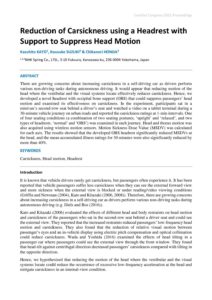 |
Author
Kazuhito Kato, Kousuke Suzuki & Chikanori Honda |
Abstract
There are growing concerns about increasing carsickness in a self-driving car as drivers perform various non-driving tasks during autonomous driving. It would appear that reducing motion of the head where the vestibular and the visual systems locate effectively reduces carsickness. Hence, we developed a novel headrest with occipital bone support (OBS) that could suppress passengers’ head motion and examined its effectiveness on carsickness. In the experiment, participants sat in a minivan’s second-row seat behind a driver’s seat and watched a video on a tablet terminal during a 30-minute vehicle journey on urban roads and reported the carsickness ratings at 1-min intervals. One of four seating conditions (a combination of two seating postures, ‘upright’ and ‘relaxed’, and two types of headrests, ‘normal’ and ‘OBS’) was examined in each journey. Head and thorax motion was also acquired using wireless motion sensors. Motion Sickness Dose Value (MSDV) was calculated for each axis. The results showed that the developed OBS headrest significantly reduced MSDVs at the head, and the mean accumulated illness ratings for 30 minutes were also significantly reduced by more than 40%. |
Publish Date: Apr 9, 2020 | Keywords: Contemporary EHF 2020, Healthcare, Publications
| Document
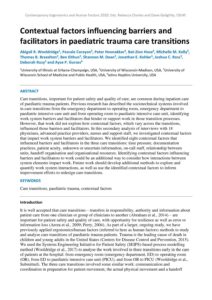
|
Author
Abigail R. Wooldridge, Pascale Carayon, Peter Hoonakker, Bat-Zion Hose, Michelle M. Kelly,Thomas B. Brazelton, Ben Eithun, Shannon M. Dean, Jonathan E. Kohler, Joshua C. Ross, Deborah Rusy and Ayse P. Gurses |
Abstract
Care transitions, important for patient safety and quality of care, are common during inpatient care of paediatric trauma patients. Previous research has described the sociotechnical systems involved in care transitions from the emergency department to operating room, emergency department to paediatric intensive care unit and from operating room to paediatric intensive care unit, identifying work system barriers and facilitators that hinder or support work in those transition processes. However, that work did not explore how contextual factors, which vary across the transitions, influenced those barriers and facilitators. In this secondary analysis of interviews with 18 physicians, advanced practice providers, nurses and support staff, we investigated contextual factors that impact work system barriers and facilitators. We identified eight contextual factors that influenced barriers and facilitators in the three care transitions: time pressure, documentation practices, patient acuity, unknown or uncertain information, on-call staff, relationship between units, handoff organisation and organisational resources. Identifying contextual factors influencing barriers and facilitators to work could be an additional way to consider how interactions between system elements impact work. Future work should develop additional methods to explore and quantify work system interactions, as well as use the identified contextual factors to inform improvement efforts to redesign care transitions. |
Publish Date: Jun 24, 2022 | Keywords: Contemporary EHF 2022, Maritime, Mental health & wellbeing, Pandemic, Publications
| Document
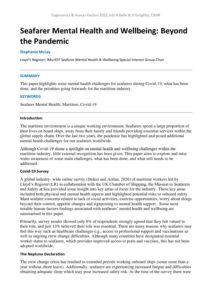
|
Author
Stephanie McLay |
Abstract
This paper highlights some mental health challenges for seafarers during Covid-19, what has been done, and the priorities going forwards for the maritime industry. |
Publish Date: Jun 8, 2023 | Keywords: Contemporary EHF 2023, Publications, Systems
| Document
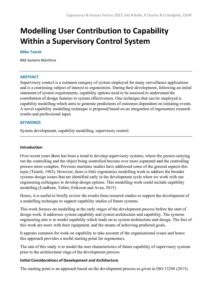
|
Author
Mike Tainsh |
Abstract
Supervisory control is a common category of system employed for many surveillance applications and is a continuing subject of interest to ergonomists. During their development, following an initial statement of system requirements, capability options need to be assessed to understand the contribution of design features to system effectiveness. One technique that can be employed is capability modelling which aims to generate predictions of outcomes dependent on initiating events. A novel capability modelling technique is proposed based on an integration of ergonomics research results and professional input. |
Publish Date: Jun 23, 2022 | Keywords: Contemporary EHF 2022, Design, Interface design, Publications, User experience
| Document
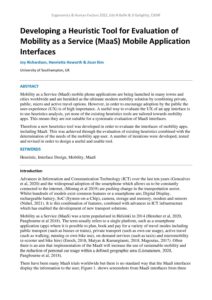
|
Author
Joy Richardson, Henrietta Howarth & Jisun Kim |
Abstract
Mobility as a Service (MaaS) mobile phone applications are being launched in many towns and cities worldwide and are heralded as the ultimate modern mobility solution by combining private, public, micro and active travel options. However, in order to encourage adoption by the public the user-experience (UX) is of high importance. A useful way to evaluate the UX of an app interface is to use heuristics analysis, yet none of the existing heuristics tools are tailored towards mobility apps. This means they are not suitable for a systematic evaluation of MaaS interfaces. Therefore a new heuristics tool was developed in order to evaluate the interfaces of mobility apps, including MaaS. This was achieved through the evaluation of existing heuristics combined with the determination of the needs of the mobility app user. A number of iterations were developed, tested and revised in order to design a useful and usable tool. |
Publish Date: May 27, 2025 | Keywords: Contemporary EHF 2025, Defence, Human factors integration, Publications
| Document
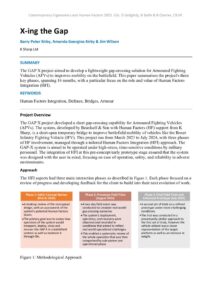
|
Author
Barry Peter Kirby, Amanda Georgina Kirby & Jim Wilson |
Abstract
The GAP X project aimed to develop a lightweight gap-crossing solution for Armoured Fighting Vehicles (AFVs) to improves mobility on the battlefield. This paper summarises the project's three key phases, spanning 16 months, with a particular focus on the role and value of Human Factors Integration (HFI). |
Publish Date: Feb 26, 2019 | Keywords: Contemporary EHF 2016, Healthcare, Organisational design, Publications, Safety culture
| Document
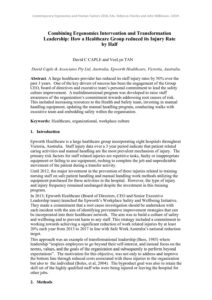
|
Author
David C CAPLE and VeeLyn TAN |
Abstract
A large healthcare provider has reduced its staff injury rates by 50% over the past 3 years. One of the key drivers of success has been the engagement of the Group CEO, board of directives and executive team’s personal commitment to lead the safety culture improvement. A multidimensional program was developed to raise staff awareness of the organization’s commitment towards addressing root causes of risk. This included increasing resources to the Health and Safety team, investing in manual handling equipment, updating the manual handling program, conducting walks with executive team and embedding safety within the organisation. |
Publish Date: Jun 8, 2023 | Keywords: Contemporary EHF 2023, Publications, Rail
| Document
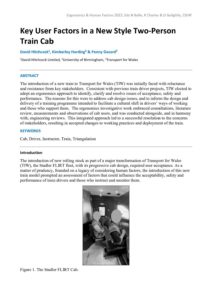
|
Author
David Hitchcock, Kimberley Harding & Penny Gazard |
Abstract
The introduction of a new train to Transport for Wales (TfW) was initially faced with reluctance and resistance from key stakeholders. Consistent with previous train driver projects, TfW elected to adopt an ergonomics approach to identify, clarify and resolve issues of acceptance, safety and performance. The reasons for this were to address cab design issues, and to inform the design and delivery of a training programme intended to facilitate a cultural shift in drivers’ ways of working and those who support them. The ergonomics investigative work embraced consultations, literature review, measurements and observations of cab users, and was conducted alongside, and in harmony with, engineering reviews. This integrated approach led to a successful resolution to the concerns of stakeholders, resulting in accepted changes to working practices and deployment of the train. |
Publish Date: Jun 11, 2025 | Keywords: Contemporary EHF 2025, Publications, Transport, User centred design
| Document

|
Author
Phuong Anh Nguyen, Robert Houghton, Amanda Crompton & Sarah Sharples |
Abstract
There is increasing interest in the concept of human-centred design (HCD) for policymaking and the application of Human Factors and Ergonomics (HF/E) methods in this area. In this study, we explored perceptions of a specific method, mainly personas, in the transport policy space. This research aim was accomplished through sixteen interviews with transport policymakers and analysts working in both national and local government, employing critical decision methods and thematic analysis to examine the transcripts. |
Publish Date: Jun 12, 2023 | Keywords: Contemporary EHF 2023, Education, training & skills, Publications, Simulation, Situation awareness, Virtual reality
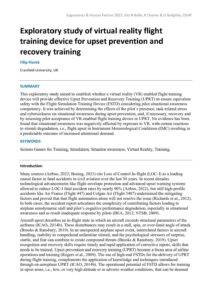
| Document
Insert here |
Author
Filip Florek |
Abstract
This exploratory study aimed to establish whether a virtual reality (VR) enabled flight training device will provide effective Upset Prevention and Recovery Training (UPRT) to ensure equivalent safety with the Flight Simulation Training Device (FSTD) considering pilot situational awareness competency. It was achieved by determining the effects of the pilot’s presence, task-related stress and cybersickness on situational awareness during upset prevention, and, if necessary, recovery and by assessing pilot acceptance of VR-enabled flight training device in UPRT. No evidence has been found that situational awareness was negatively affected by exposure to VR, with certain reactions to stimuli degradation, i.e., flight upset in Instrument Meteorological Conditions (IMC) resulting in a predictable outcome of increased attentional demand. |
Publish Date: Apr 16, 2020 | Keywords: Automotive, Contemporary EHF 2020, Publications, Risk assessment
| Document
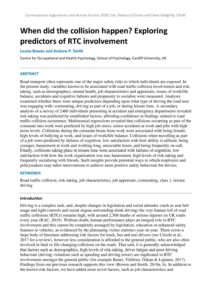
|
Author
Louise Bowen and Andrew P. Smith |
Abstract
Road transport often represents one of the major safety risks to which individuals are exposed. In the present study, variables known to be associated with road traffic collision involvement and risk-taking, such as demographics, mental health, job characteristics and appraisals, issues of work/life balance, accidents and cognitive failures and propensity to socialise were measured. Analyses examined whether there were unique predictors depending upon what type of driving the road user was engaging with: commuting, driving as part of a job, or during leisure time. A secondary analysis of a survey of 2488 individuals presenting at accident and emergency departments revealed risk-taking was predicted by established factors, affording confidence in findings related to road traffic collision occurrence. Multinomial regressions revealed that collisions occurring as part of the commute into work were predicted by high job stress, minor accidents at work and jobs with high noise levels. Collisions during the commute home from work were associated with being female, high levels of bullying at work, and issues of work/life balance. Collisions when travelling as part of a job were predicted by failures of cognition, low satisfaction with how ability is utilised, being younger, harassment at work and working long, unsociable hours, and being frequently on-call. Finally, collisions taking place in leisure time were associated with failures of cognition, low satisfaction with how the work organisation was run, harassment, high levels of risk-taking and frequently socialising with friends. Such insights provide potential ways in which employers and policymakers may tailor interventions to achieve more positive safety behaviour for drivers. |
Publish Date: Apr 17, 2020 | Keywords: Contemporary EHF 2020, Education, training & skills, Leadership, Publications, Rail
| Document
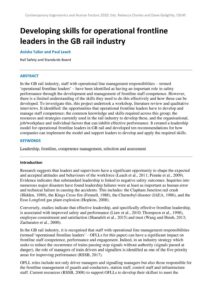
|
Author
Anisha Tailor and Paul Leach |
Abstract
In the GB rail industry, staff with operational line management responsibilities – termed ‘operational frontline leaders’ – have been identified as having an important role in safety performance through the development and management of frontline staff competence. However, there is a limited understanding of the skills they need to do this effectively and how these can be developed. To investigate this, this project undertook a workshop, literature review and qualitative interviews. It identified: the opportunities that operational frontline leaders have to develop and manage staff competence; the common knowledge and skills required across this group; the resources and strategies currently used in the rail industry to develop these, and the organisational, job/workplace and individual factors that can inhibit effective performance. It created a leadership model for operational frontline leaders in GB rail and developed ten recommendations for how companies can implement the model and support leaders to develop and apply the required skills. |
Publish Date: Jun 12, 2023 | Keywords: Contemporary EHF 2023, Healthcare, Patient Safety, Publications, Systems
| Document
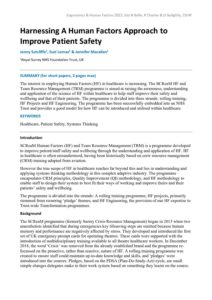
|
Author
Jenny Sutcliffe, Suzi Lomax & Jennifer Macallan |
Abstract
The interest in employing Human Factors (HF) in healthcare is increasing. The SCReaM HF and Team Resource Management (TRM) programme is aimed at raising the awareness, understanding and application of the science of HF within healthcare to help staff improve their safety and wellbeing and that of their patients. The programme is divided into three strands: rolling training, HF Projects and HF Engineering. The programme has been successfully embedded into an NHS Trust and provides a good model for how HF can be introduced and utilised within healthcare. |
Publish Date: Sep 7, 2019 | Keywords: Contemporary EHF 2019, Occupational health, Publications
| Document
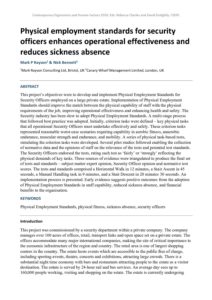
|
Author
Mark P Rayson & Nick Bennett |
Abstract
This project’s objectives were to develop and implement Physical Employment Standards for Security Officers employed on a large private estate. Implementation of Physical Employment Standards should improve the match between the physical capability of staff with the physical requirements of the job, improving operational effectiveness and enhancing health and safety. The Security industry has been slow to adopt Physical Employment Standards. A multi-stage process that followed best practice was adopted. Initially, criterion tasks were defined – key physical tasks that all operational Security Officers must undertake effectively and safely. These criterion tasks represented reasonable worst-case scenarios requiring capability in aerobic fitness, anaerobic endurance, muscular strength and endurance, and mobility. A series of physical task-based tests, simulating the criterion tasks were developed. Several pilot studies followed enabling the collection of normative data and the opinions of staff on the relevance of the tests and potential test standards. The Security Officers endorsed the tests, rating each test as ‘fairly’ or ‘strongly’ reflecting the physical demands of key tasks. Three sources of evidence were triangulated to produce the final set of tests and standards – subject matter expert opinion, Security Officer opinion and normative test scores. The tests and standards comprised a Horizontal Walk in 12 minutes, a Stair Ascent in 45 seconds, a Manual Handling task in 9 minutes, and a Stair Descent in 20 minutes 30 seconds. An implementation process is presented. Early evidence suggests positive outcomes from the adoption of Physical Employment Standards in staff capability, reduced sickness absence, and financial benefits to the organisation. |
Publish Date: Apr 16, 2020 | Keywords: Accimaps, Contemporary EHF 2020, Investigation, Publications
| Document
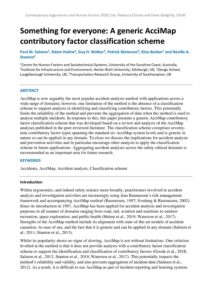
|
Author
Paul M. Salmon, Adam Hulme, Guy H. Walker, Patrick Waterson, Elise Berber and Neville A. Stanton |
Abstract
AcciMap is now arguably the most popular accident analysis method with applications across a wide range of domains; however, one limitation of the method is the absence of a classification scheme to support analysts in identifying and classifying contributory factors. This potentially limits the reliability of the method and prevents the aggregation of data when the method is used to analyse multiple incidents. In response to this, this paper presents a generic AcciMap contributory factor classification scheme that was developed based on a review and analysis of the AcciMap analyses published in the peer-reviewed literature. The classification scheme comprises seventy-nine contributory factor types spanning the standard six AcciMap system levels and is generic in nature so can be applied in any domain. To close we discuss the implications for accident analysis and prevention activities and in particular encourage other analysts to apply the classification scheme in future applications. Aggregating accident analyses across the safety critical domains is recommended as an important area for future research. |
Publish Date: Sep 8, 2019 | Keywords: Contemporary EHF 2019, Publications
| Document
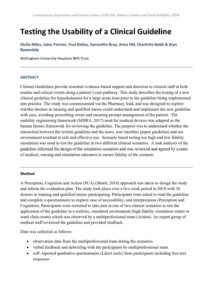
|
Author
Giulia Miles, Jaina Parmar, Paul Bailey, Samantha Bray, Anna Hill, Charlotte Bebb & Bryn Baxendale |
Abstract
Clinical Guidelines provide essential evidence-based support and direction to clinical staff at both routine and critical events along a patient’s care pathway. This study describes the testing of a new clinical guideline for hyperkalaemia for a large acute trust prior to the guideline being implemented into practice. The study was commissioned via the Pharmacy lead, and was designed to explore whether doctors in training and qualified nurses could understand and implement the new guideline with ease, avoiding prescribing errors and ensuring prompt management of the patient. The usability engineering framework (MHRA, 2017) used for medical devices was adapted as the human factors framework for reviewing the guideline. The purpose was to understand whether the interaction between the written guideline and the users, user interface (paper guideline) and use environment resulted in safe and effective use. Scenario based testing use high and low fidelity simulation was used to test the guideline in two different clinical scenarios. A task analysis of the guideline informed the design of the simulation scenarios and was reviewed and agreed by a team of medical, nursing and simulation educators to ensure fidelity of the scenario. |
Publish Date: Mar 24, 2019 | Keywords: Contemporary EHF 2016, Energy, Organisational design, Publications, Safety
| Document
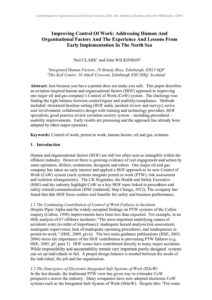
|
Author
Neil CLARK and John WILKINSON |
Abstract
Just because you have a permit does not make you safe. This paper describes an aviation-inspired human and organisational factors (HOF) approach to improving one major oil and gas company’s Control of Work (CoW) system. The challenge was finding the right balance between control/rigour and usability/compliance. Methods included: structured baseline setting (HOF audit, incident review and survey); active user involvement; collaborative design with training and technology providers, HOF specialists; good practice review (aviation sector); system – including procedural – usability improvements. Early results are promising and the approach has already been adopted by other major operators. |
Publish Date: Jun 24, 2022 | Keywords: Contemporary EHF 2022, Design, Equality, diversity & inclusion (EDI), Maritime, Publications
| Document
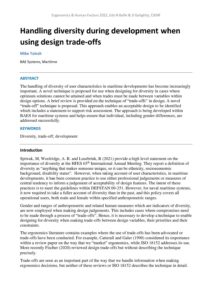
|
Author
Mike Tainsh |
Abstract
The handling of diversity of user characteristics in maritime developments has become increasingly important. A novel technique is proposed for use when designing for diversity in cases where optimum solutions cannot be attained and when trades must be made between variables within design options. A brief review is provided on the technique of “trade-offs” in design. A novel “trade-off” technique is proposed. This approach enables an acceptable design to be identified which includes a statement to support risk assessment. The approach is being developed within BAES for maritime systems and helps ensure that individual, including gender differences, are addressed successfully. |
Publish Date: Dec 17, 2018 | Keywords: Aviation, Contemporary EHF 2017, Publications, Sociotechnical systems
| Document
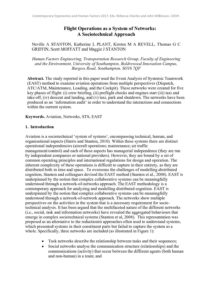
|
Author
Neville A STANTON, Katherine L PLANT, Kirsten M A REVELL, Thomas G C GRIFFIN, Scott MOFFATT and Maggie J STANTON |
Abstract
The study reported in this paper used the Event Analysis of Systemic Teamwork (EAST) method to examine aviation operations from multiple perspectives (Dispatch, ATC/ATM, Maintenance, Loading, and the Cockpit). These networks were created for five key phases of flight: (i) crew briefing, (ii) preflight checks and engines start (iii) taxi and take-off, (iv) descent and landing, and (v) taxi, park and shutdown. The networks have been produced as an ‘information audit’ in order to understand the interactions and connections within the current system. |
Publish Date: Jun 11, 2025 | Keywords: Contemporary EHF 2025, Healthcare, Interface design, Patient Safety, Publications, Usability
| Document
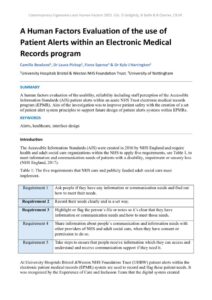
|
Author
Camilla Rowland, Dr Laura Pickup, Fiona Spence & Dr Kyle J Harrington |
Abstract
A human factors evaluation of the usability, reliability including staff perception of the Accessible Information Standards (AIS) patient alerts within an acute NHS Trust electronic medical records program (EPMR). Aim of the investigation was to improve patient safety with the creation of a set of patient alert system principles to support future design of patient alerts systems within EPMRs. |
Publish Date: Jun 11, 2025 | Keywords: Contemporary EHF 2025, Healthcare, Patient Safety, Publications, Systems
| Document
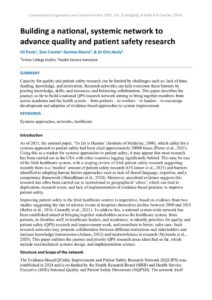
|
Author
Jill Poots, Sam Cromie, Gemma Moore, & Dr Orla Healy |
Abstract
Capacity for quality and patient safety research can be limited by challenges such as: lack of time, funding, knowledge, and motivation. Research networks can help overcome these barriers by pooling knowledge, skills, and resources, and bolstering collaboration. This paper describes the journey so far to build a national QPS research network aiming to bring together members from across academia and the health system – from patients – to workers – to leaders – to encourage development and adoption of evidence-based approaches to system improvement. |
Publish Date: Dec 18, 2018 | Keywords: Anthropometry, Contemporary EHF 2017, Publications, Technology, Usability
| Document
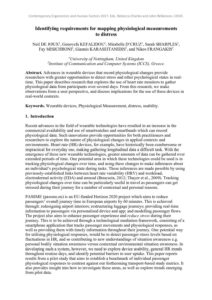
|
Author
Neil DE JOUX, Genovefa KEFALIDOU, Mirabelle D’CRUZ, Sarah SHARPLES, Fay MISICHRONI, Giannis KARASEITANIDIS, and Nikos FRANGAKIS |
Abstract
Advances in wearable devices that record physiological changes provide researchers with greater opportunities to detect stress and other psychological states in real-time. This paper describes research that explores the use of heart rate monitors to gather physiological data from participants over several days. From this research, we make observations from a user perspective, and discuss implications for the use of these devices in real-world contexts. |
Publish Date: Jun 11, 2025 | Keywords: Contemporary EHF 2025, Publications, Rail, Systems, User experience
| Document
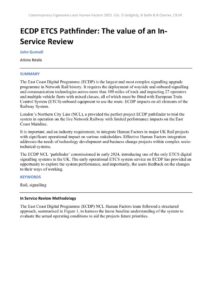
|
Author
John Gunnell |
Abstract
The East Coast Digital Programme (ECDP) is the largest and most complex signalling upgrade programme in Network Rail history. It requires the deployment of wayside and onboard signalling and communication technologies across more than 100 miles of track and impacting 27 operators and multiple vehicle fleets with mixed classes, all of which must be fitted with European Train Control System (ETCS) onboard equipment to use the route. ECDP impacts on all elements of the Railway System. London’s Northern City Line (NCL), a provided the perfect project ECDP pathfinder to trial the system in operation on the live Network Railway with limited performance impacts on the East Coast Mainline. It is important, and an industry requirement, to integrate Human Factors in major UK Rail projects with significant operational impact on various stakeholders. Effective Human Factors integration addresses the needs of technology development and business change projects within complex socio-technical systems. The ECDP NCL ‘pathfinder’ commissioned in early 2024, introducing one of the only ETCS digital signalling systems in the UK. The early operational ETCS system service on ECDP has provided an opportunity to explore the system performance, and importantly, the users feedback on the changes to their ways of working. |
Publish Date: Apr 9, 2020 | Keywords: Contemporary EHF 2020, Healthcare, Publications, Task analysis
| Document
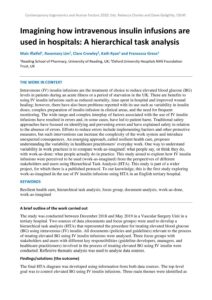
|
Author
Mais Iflaifel, Rosemary Lim, Clare Crowley, Kath Ryan and Francesca Greco |
Abstract
Intravenous (IV) insulin infusions are the treatment of choice to reduce elevated blood glucose (BG) levels in patients during an acute illness or a period of starvation in the UK. There are benefits to using IV insulin infusions such as reduced mortality, time spent in hospital and improved wound healing; however, there have also been problems reported with its use such as variability in insulin doses, complex preparation of insulin infusion in clinical areas, and the need for frequent monitoring. The wide range and complex interplay of factors associated with the use of IV insulin infusions have resulted in errors and, in some cases, have led to patient harm. Traditional safety approaches have focused on identifying and preventing errors and have explained safety in relation to the absence of errors. Efforts to reduce errors include implementing barriers and other protective measures, but such interventions can increase the complexity of the work system and introduce unexpected consequences. An emerging approach, called resilient health care, proposes understanding the variability in healthcare practitioners’ everyday work. One way to understand variability in work practices is to compare work-as-imagined: what people say, or think they do, with work-as-done: what people actually do in practice. This study aimed to explore how IV insulin infusions were perceived to be used (work-as-imagined) from the perspectives of different stakeholders and users using Hierarchical Task Analysis (HTA). This study is part of a wider project, for which there is a published protocol. To our knowledge, this is the first study exploring work-as-imagined in the use of IV insulin infusions using HTA in an English tertiary hospital. |
Publish Date: Mar 24, 2019 | Keywords: Contemporary EHF 2016, Office ergonomics, Publications
| Document
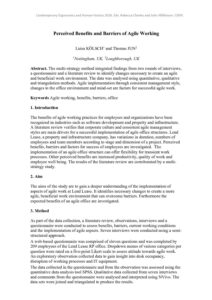
|
Author
Luisa KÖLSCH and Thomas JUN |
Abstract
The multi-strategy method integrated findings from two rounds of interviews, a questionnaire and a literature review to identify changes necessary to create an agile and beneficial work environment. The data was analysed using quantitative, qualitative and triangulation methods. Agile implementation through consistent management style, changes to the office environment and mind-set are factors for successful agile work. |
Publish Date: Jun 12, 2023 | Keywords: Contemporary EHF 2023, Publications, Rail, Simulation
| Document
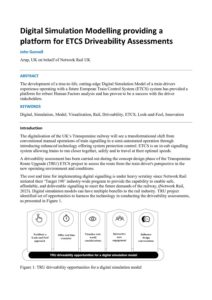
|
Author
John Gunnell |
Abstract
The development of a true-to-life, cutting-edge Digital Simulation Model of a train drivers experience operating with a future European Train Control System (ETCS) system has provided a platform for robust Human Factors analysis and has proven to be a success with the driver stakeholders. |
Publish Date: Aug 16, 2021 | Keywords: Clothing, Comfort, Comfort Congress 2021, Publications
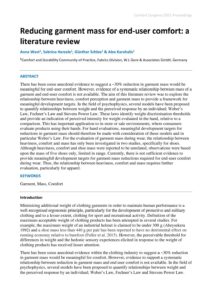 |
Author
Anna West, Sabrina Herzele, Günther Schlee & Alex Karahalis |
Abstract
There has been some anecdotal evidence to suggest a ~30% reduction in garment mass would be meaningful for end-user comfort. However, evidence of a systematic relationship between mass of a garment and end-user comfort is not available. The aim of this literature review was to explore the relationship between heaviness, comfort perception and garment mass to provide a framework for meaningful development targets. In the field of psychophysics, several models have been proposed to quantify relationships between weight and the perceived response by an individual; Weber’s Law, Fechner’s Law and Stevens Power Law. These laws identify weight discrimination thresholds and provide an indication of perceived intensity for weight evaluated in the hand, relative to a comparison. This has important application to in-store or sale environments, where consumers evaluate products using their hands. For hand evaluations, meaningful development targets for reductions in garment mass should therefore be made with consideration of these models and in particular Weber’s Law. For the evaluation of garment mass during wear, the relationship between heaviness, comfort and mass has only been investigated in two studies, specifically for shoes. Although heaviness, comfort and shoe mass were reported to be unrelated, observations were based upon the mass of five shoes only, limited in range. Currently, there is not sufficient evidence to provide meaningful development targets for garment mass reductions required for end-user comfort during wear. Thus, the relationship between heaviness, comfort and mass requires further evaluation, particularly for apparel. |
Publish Date: Jun 4, 2024 | Keywords: Contemporary EHF 2024, Publications, Safety, Systems, Transport
| Document
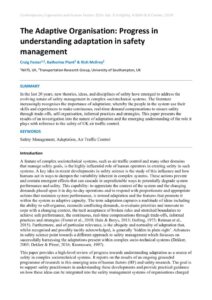
|
Author
Craig Foster, Katherine Plant & Rich McIlroy |
Abstract
In the last 20 years, new theories, ideas, and disciplines of safety have emerged to address the evolving nature of safety management in complex sociotechnical systems. The literature increasingly recognises the importance of adaptation; whereby the people in the system use their skills and experiences to make continuous, real-time demand compensations to ensure safety through trade-offs, self-organisation, informal practices and strategies. This paper presents the results of an investigation into the nature of adaptation and the emerging understanding of the role it plays with reference to the safety of UK air traffic control. |
Publish Date: Jun 24, 2022 | Keywords: Contemporary EHF 2022, Manufacturing, Mental health & wellbeing, Pandemic, Publications
| Document
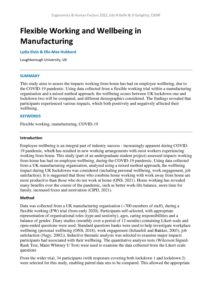
|
Author
Lydia Elvin & Ella-Mae Hubbard |
Abstract
This study aims to assess the impacts working from home has had on employee wellbeing, due to the COVID-19 pandemic. Using data collected from a flexible working trial within a manufacturing organisation and a mixed method approach, the wellbeing scores between UK lockdown one and lockdown two will be compared, and different demographics considered. The findings revealed that participants experienced various impacts, which both positively and negatively affected their wellbeing. |
Publish Date: Jun 12, 2023 | Keywords: Anthropometry, Contemporary EHF 2023, Musculoskeletal, Publications, Task analysis
| Document
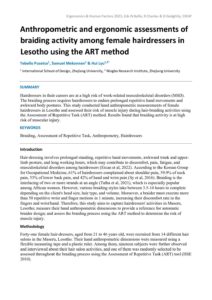
|
Author
Tebello Pusetso, Samuel Mekonnen & Hui Lyu |
Abstract
Hairdressers in their careers are at a high risk of work-related musculoskeletal disorders (MSD). The braiding process requires hairdressers to endure prolonged repetitive hand movements and awkward body postures. This study conducted hand anthropometric measurements of female hairdressers in Lesotho and assessed their risk of muscle injury during hair-braiding activities using the Assessment of Repetitive Task (ART) method. Results found that braiding activity is at high risk of muscular injury. |
Publish Date: Apr 8, 2021 | Keywords: Autonomous vehicles, Contemporary EHF 2021, Human-machine interaction, Publications
| Document
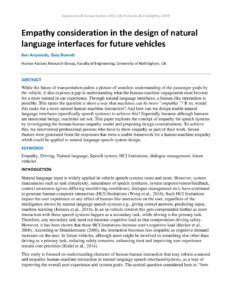
|
Author
Ben Anyasodo and Gary Burnett |
Abstract
While the future of transportation paints a picture of seamless understanding of the passenger goals by the vehicle, it also exposes a gap in understanding what the human-machine engagement must become for a more natural in-car experience. Through natural language interfaces, a human-like interaction is possible. This raises the question is there a way that machines can be more “empathic”? If so, would this make for a more natural human-machine interaction? And how can we design usable natural language interfaces (specifically speech systems) to achieve this? Especially because although humans are emotional beings, machines are not. This paper explores the concept of empathy for speech systems by investigating the human-human empathy model and proposing design considerations. To achieve this, we interviewed professional persons who have to show empathy as part of their work. Seven themes were generated from the responses that form a usable framework for a human-machine empathy which could be applied to natural language speech system design. |
Publish Date: Apr 9, 2021 | Keywords: Contemporary EHF 2021, Decision making, Healthcare, Publications
| Document
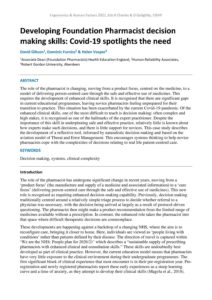
|
Author
David Gibson, Dominic Furniss & Helen Vosper |
Abstract
The role of the pharmacist is changing, moving from a product focus, centred on the medicine, to a model of delivering person-centred care through the safe and effective use of medicines. This requires the development of enhanced clinical skills. It is recognised that there are significant gaps in current educational programmes, leaving novice pharmacists feeling unprepared for their transition to practice. This situation has been exacerbated by the current Covid-19 pandemic. Of the enhanced clinical skills, one of the most difficult to teach is decision making: often complex and high stakes, it is recognised as one of the hallmarks of the expert practitioner. Despite the importance of this skill in underpinning safe and effective practice, relatively little is known about how experts make such decisions, and there is little support for novices. This case study describes the development of a reflective tool, informed by naturalistic decision making and based on the aviation model of Threat and Error Management. This encourages systems thinking to help novice pharmacists cope with the complexities of decisions relating to real life patient-centred care. |
Publish Date: Sep 7, 2019 | Keywords: Contemporary EHF 2019, Maritime, Musculoskeletal, Publications
| Document
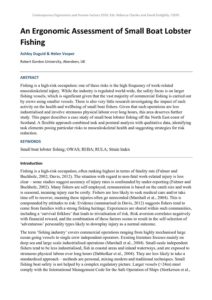
|
Author
Ashley Duguid & Helen Vosper |
Abstract
Fishing is a high-risk occupation: one of these risks is the high frequency of work-related musculoskeletal injury. While the industry is regulated world-wide, the safety focus is on larger fishing vessels, which is significant given that the vast majority of commercial fishing is carried out by crews using smaller vessels. There is also very little research investigating the impact of such activity on the health and wellbeing of small boat fishers. Given that such operations are less industrialised and involve strenuous physical labour over long hours, this area deserves further study. This paper describes a case study of small boat lobster fishing off the North East coast of Scotland. A flexible approach combined task and postural analysis with qualitative data, identifying task elements posing particular risks to musculoskeletal health and suggesting strategies for risk reduction. |
Publish Date: Dec 18, 2018 | Keywords: Climate change, Contemporary EHF 2017, Design, Publications, Systems
| Document
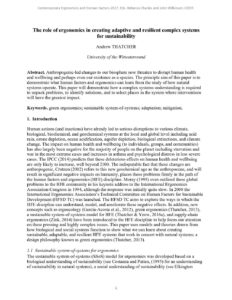
|
Author
Andrew THATCHER |
Abstract
Anthropogenic-led changes to our biosphere now threaten to disrupt human health and wellbeing and perhaps even our existence as a species. The principle aim of this paper is to demonstrate what human factors and ergonomics can learn from the study of how natural systems operate. This paper will demonstrate how a complex systems understanding is required to unpack problems, to identify solutions, and to select places in the system where interventions will have the greatest impact. |
Publish Date: Jun 4, 2024 | Keywords: Contemporary EHF 2024, Incidents, Investigation, Patient Safety, Publications, Safety, Safety culture
| Document
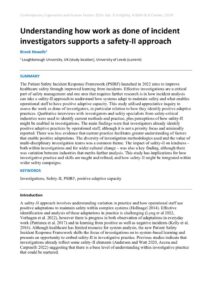
|
Author
Brook Howells |
Abstract
The Patient Safety Incident Response Framework (PSIRF) launched in 2022 aims to improve healthcare safety through improved learning from incidents. Effective investigations are a critical part of safety management and one area that requires further research is in how incident analysis can take a safety-II approach to understand how systems adapt to maintain safety and what enables operational staff to have positive adaptive capacity. This study utilised appreciative inquiry to assess the work as done of investigators, in particular relation to how they identify positive adaptive practices. Qualitative interviews with investigators and safety specialists from safety-critical industries were used to identify current methods and practice, plus perceptions of how safety-II might be enabled in investigations. The main findings were that investigators already identify positive adaptive practices by operational staff, although it is not a priority focus and minimally reported. There was less evidence that current practice facilitates greater understanding of factors that enable positive adaptations. The diversity of investigation methodologies used and the value of multi-disciplinary investigation teams was a common theme. The impact of safety-II on kindness – both within investigations and for wider cultural change – was also a key finding, although there was variation between industries that merits further analysis. This study has implications for how investigative practice and skills are taught and refined, and how safety-II might be integrated within wider safety campaigns. |
Publish Date: Feb 27, 2019 | Keywords: Anthropometry, Contemporary EHF 2016, Publications
| Document
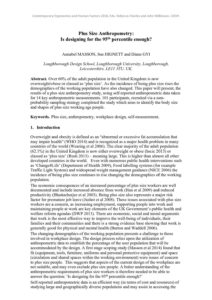
|
Author
Annabel MASSON, Sue HIGNETT and Diane GYI |
Abstract
Over 60% of the adult population in the United Kingdom is now overweight/obese or classed as ‘plus size’. As the incidence of being plus size rises the demographics of the working population have also changed. This paper will present, the results of a plus size anthropometry study, using self-reported anthropometric data taken for 14 key anthropometric measurements. 101 participants, recruited via a non-probability sampling strategy completed the study which aims to identify the body size and shapes of plus size working age people. |
Publish Date: Aug 9, 2021 | Keywords: Automotive, Autonomous systems, Autonomous vehicles, Comfort, Comfort Congress 2021, Design, Publications
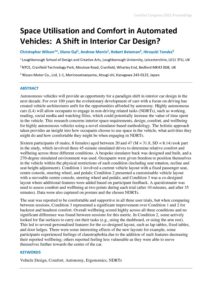 |
Author
Christopher Wilson, Diane Gyi, Andrew Morris, Robert Bateman, Hiroyuki Tanaka |
Abstract
Autonomous vehicles will provide an opportunity for a paradigm shift in interior car design in the next decade. For over 100 years the evolutionary development of cars with a focus on driving has created vehicle architectures unfit for the opportunities afforded by autonomy. Highly autonomous cars (L4) will allow occupants to engage in non-driving related tasks (NDRTs), such as working, reading, social media and watching films, which could potentially increase the value of time spent in the vehicle. This research concerns interior space requirements, design, comfort, and wellbeing for highly autonomous vehicles using a novel simulator-based methodology. The holistic approach taken provides an insight into how occupants choose to use space in the vehicle, what activities they might do and how comfortable they might be when engaging in NDRTs. Sixteen participants (8 males, 8 females) aged between 20 and 47 (M = 31.8, SD = 8.14) took part in the study, which involved three 45-minute simulated drives to determine relative comfort and wellbeing across three different conditions. A bespoke simulator buck was designed and built, and a 270-degree simulated environment was used. Occupants were given freedom to position themselves in the vehicle within the physical restrictions of each condition (including seat rotation, recline and seat height adjustment). Condition 1 involved a current vehicle layout with a fixed passenger seat, centre console, steering wheel, and pedals; Condition 2 presented a customisable vehicle layout with a moveable centre console, steering wheel and pedals; and Condition 3 was a co-designed layout where additional features were added based on participant feedback. A questionnaire was used to assess comfort and wellbeing at two points during each trial (after 10 minutes, and after 35 minutes). Data were also captured on posture and the chosen NDRTs. The seat was reported to be comfortable and supportive in all three user trials, but when comparing between sessions, Condition 3 represented a significant improvement over Condition 1 and 2 for backrest and headrest comfort. Overall wellbeing scored highly across all three conditions and no significant difference was found between sessions for this metric. In Condition 2, some actively looked for flat surfaces to carry out their tasks (e.g., using the dashboard, or using the arm rest). This led to several personalised features for the co-designed layout, such as lap tables, fixed tables, and door ledges. There were some interesting effects of the new layouts for example, some participants experienced feelings of claustrophobia due to the addition of such features decreasing their reported wellbeing; others reported feeling less vulnerable as they were able to move themselves further towards the centre of the car. |
Publish Date: Apr 9, 2021 | Keywords: Automotive, Autonomous vehicles, Behaviour, Contemporary EHF 2021, Publications, Transport
| Document
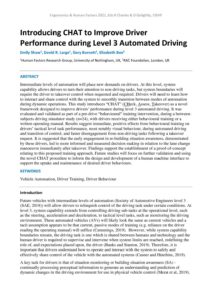
|
Author
Emily Shaw, David R. Large, Gary Burnett, Elizabeth Box |
Abstract
Intermediate levels of automation will place new demands on drivers. At this level, system capability allows drivers to turn their attention to non-driving tasks, but system boundaries will require the driver to takeover control when requested and required. Drivers will need to learn how to interact and share control with the system to smoothly transition between modes of automation during dynamic operations. This study introduces “CHAT” (CHeck, Assess, Takeover) as a novel framework designed to improve drivers’ performance during level 3 automated driving. It was evaluated and validated as part of a pre-drive “behavioural” training intervention, during a between-subjects driving simulator study (n=24), with drivers receiving either behavioural training or a written operating manual. Results suggest immediate, positive effects from behavioural training on drivers’ tactical level task performance, most notably visual behaviour, during automated driving and transition of control, and faster disengagement from non-driving tasks following a takeover request. It is suggested that the early engagement in re-building situation awareness, demonstrated by these drivers, led to more informed and measured decision making in relation to the lane change manoeuvre immediately after takeover. Findings support the establishment of a proof-of-concept relating to this proposed training approach. Future studies will focus on further validation and using the novel CHAT procedure to inform the design and development of a human machine interface to support the uptake and maintenance of desired driver behaviours. |
Publish Date: Apr 9, 2020 | Keywords: Automotive, Autonomous vehicles, Contemporary EHF 2020, Human-machine interaction, Publications
| Document
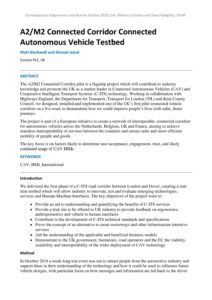
|
Author
Matt Blackwell and Ahmad Jamal |
Abstract
The A2/M2 Connected Corridor pilot is a flagship project which will contribute to industry knowledge and promote the UK as a market leader in Connected Autonomous Vehicles (CAV) and Cooperative Intelligent Transport Systems (C-ITS) technology. Working in collaboration with Highways England, the Department for Transport, Transport for London (TfL) and Kent County Council, we designed, installed and implemented one of the UK’s first pilot connected vehicle corridors on a live road, to demonstrate how we could improve people’s lives with safer, faster journeys. The project is part of a European initiative to create a network of interoperable, connected corridors for autonomous vehicles across the Netherlands, Belgium, UK and France, aiming to achieve seamless interoperability of services between the countries and ensure safer and more efficient mobility of people and goods. The key focus is on factors likely to determine user acceptance, engagement, trust, and likely continued usage of CAV HMIs. |
Publish Date: Sep 8, 2019 | Keywords: Contemporary EHF 2019, Incidents, Non-technical skills, Publications, Rail
| Document
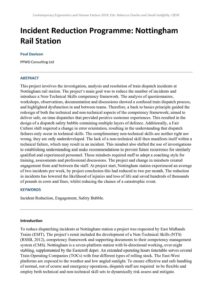
|
Author
Paul Davison |
Abstract
This project involves the investigation, analysis and resolution of train dispatch incidents at Nottingham rail station. The project’s main goal was to reduce the number of incidents and introduce a Non-Technical Skills competency framework. The analysis of questionnaires, workshops, observations, documentation and discussions showed a confused train dispatch process, and highlighted dysfunction in and between teams. Therefore, a back to basics principle guided the redesign of both the technical and non-technical aspects of the competency framework; aimed to deliver safe, on time dispatches that provided positive customer experiences. This resulted in the design of a dispatch safety bubble containing multiple layers of defence. Additionally, a Fair Culture shift required a change in error orientation, resulting in the understanding that dispatch failures only occur in technical skills. The complimentary non-technical skills are neither right nor wrong, they are only underdeveloped. The lack of a non-technical skill then manifests itself within a technical failure, which may result in an incident. This mindset also shifted the use of investigations to establishing understanding and make recommendations to prevent future recurrence for similarly qualified and experienced personnel. These mindsets required staff to adopt a coaching style for training, assessments and professional discussions. The project and change in mindsets created engagement from and between the staff. At project start, Nottingham station experienced an average of two incidents per week, by project conclusion this had reduced to two per month. The reduction in incidents has lowered the likelihood of injuries and loss of life and saved hundreds of thousands of pounds in costs and fines, whilst reducing the chance of a catastrophic event. |
Publish Date: May 14, 2025 | Keywords: Agriculture & forestry, Climate change, Contemporary EHF 2025, Publications
| Document
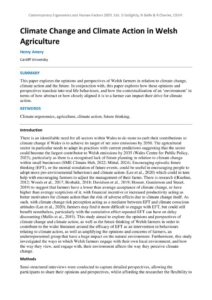
|
Author
Henry Amery |
Abstract
This paper explores the opinions and perspectives of Welsh farmers in relation to climate change, climate action and the future. In conjunction with, this paper explores how these opinions and perspectives translate into real life behaviours, and how the contextualisation of an ‘environment’ in terms of how abstract or how closely aligned it is to a farmer can impact their drive for climate action. |
Publish Date: May 30, 2024 | Keywords: Artificial intelligence, Aviation, Contemporary EHF 2024, Publications
| Document
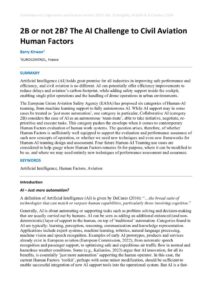
|
Author
Barry Kirwan |
Abstract
Artificial Intelligence (AI) holds great promise for all industries in improving safe performance and efficiency, and civil aviation is no different. AI can potentially offer efficiency improvements to reduce delays and aviation’s carbon footprint, while adding safety support inside the cockpit, enabling single pilot operations and the handling of drone operations in urban environments. The European Union Aviation Safety Agency (EASA) has proposed six categories of Human-AI teaming, from machine learning support to fully autonomous AI. While AI support may in some cases be treated as ‘just more automation’, one category in particular, Collaborative AI (category 2B) considers the case of AI as an autonomous ‘team-mate’, able to take initiative, negotiate, re�prioritise and execute tasks. This category pushes the envelope when it comes to contemporary Human Factors evaluation of human work systems. The question arises, therefore, of whether Human Factors is sufficiently well equipped to support the evaluation and performance assurance of such new concepts of operation, or whether we need new techniques and even new frameworks for Human-AI teaming design and assessment. Four future Human-AI Teaming use cases are considered to help gauge where Human Factors remains fit-for-purpose, where it can be modified to be so, and where we may need entirely new techniques of performance assessment and assurance. |
Publish Date: Apr 9, 2020 | Keywords: Autonomous vehicles, Behaviour, Contemporary EHF 2020, Publications
| Document
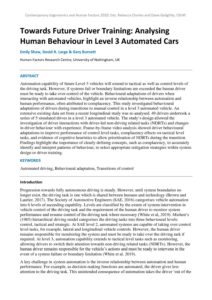
|
Author
Emily Shaw, David R. Large and Gary Burnett |
Abstract
Automation capability of future Level 3 vehicles will extend to tactical as well as control levels of the driving task. However, if systems fail or boundary limitations are exceeded the human driver must be ready to take over control of the vehicle. Behavioural adaptations of drivers when interacting with automated vehicles, highlight an inverse relationship between automation and human performance, often attributed to complacency. This study investigated behavioural adaptations of drivers during transitions to manual control in a level 3 automated vehicle. An extensive existing data set from a recent longitudinal study was re-analysed. 49 drivers undertook a series of 5 simulated drives in a level 3 automated vehicle. The study’s design allowed the investigation of driver interactions with driver-led non-driving related tasks (NDRTs) and changes in driver behaviour with experience. Frame-by-frame video analysis showed driver behavioural adaptations to improve performance of control level tasks, complacency effects on tactical level tasks, and evidence of cognitive heuristics to allow prioritisation of NDRTs during the transition. Findings highlight the importance of clearly defining concepts, such as complacency, to accurately identify and interpret patterns of behaviour, to select appropriate mitigation strategies within system design or driver training. |
Publish Date: Mar 25, 2019 | Keywords: Anthropometry, Contemporary EHF 2016, Musculoskeletal, Publications, Rail
| Document
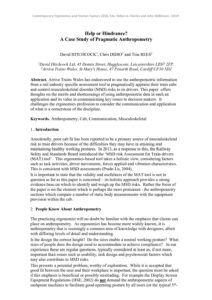
|
Author
David HITCHCOCK, Chris DIDIO and Tina REES |
Abstract
Arriva Trains Wales has endeavored to use the anthropometric information from a rail industry specific assessment tool to pragmatically appraise their train cabs and control musculoskeletal disorder (MSD) risks to its drivers. This paper offers thoughts on the merits and shortcomings of using anthropometric data in such an application and its value in communicating key issues to decision makers. It challenges the ergonomics profession to consider the communication and application of what is a cornerstone of the discipline. |
Publish Date: Jun 11, 2025 | Keywords: Behaviour, Contemporary EHF 2025, Publications, Rail, Safety
| Document
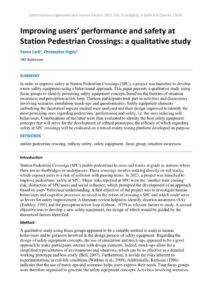
|
Author
Yanna Carli, Christopher Paglia |
Abstract
In order to improve safety at Station Pedestrian Crossings (SPC), a project was launched to develop a new safety equipment using a behavioural approach. This paper presents a qualitative study using focus groups to identify promising safety equipment concepts based on the theories of situation awareness and perception/action loop. Thirteen participants took part in activities and discussions involving scenarios simulation, mock-ups and questionnaires. Safety equipment elements embodying the theoretical aspects studied were analysed and their design improved to identify the most promising ones regarding pedestrians’ performance and safety, i.e. the ones inducing safe behaviours. Combinations of the latter were then evaluated to identity the best safety equipment concepts that will serve for the development of refined prototypes, the efficacy of which regarding safety at SPC crossings will be evaluated on a mixed-reality testing platform developed on purpose. |
Publish Date: May 30, 2024 | Keywords: Aviation, Contemporary EHF 2024, Publications, Situation awareness, Transport
| Document
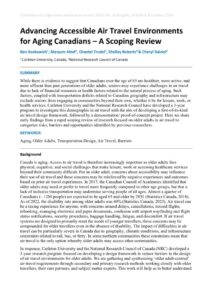
|
Author
Ben Koskowich , Maryam Attef, Chantal Trudel, Shelley Roberts& Cheryl Dalziel |
Abstract
While there is evidence to suggest that Canadians over the age of 65 are healthier, more active, and more affluent than past generations of older adults, seniors may experience challenges in air travel due to lack of financial resources or health factors related to the natural process of aging. Such factors, coupled with transportation deficits related to Canadian geography and infrastructure may exclude seniors from engaging in communities beyond their own, whether it be for leisure, work, or health services. Carleton University and the National Research Council have developed a 3-year program to investigate this demographic in air travel with the aim of developing a first-of-its-kind air travel design framework, followed by a demonstration/ proof-of-concept project. Here we share early findings from a rapid scoping review of research focused on older adults in air travel to categorize risks, barriers and opportunities identified by previous researchers. |
Publish Date: Apr 15, 2020 | Keywords: Cognition, Contemporary EHF 2020, Defence, Publications, Submarines
| Document
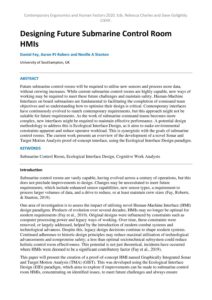
|
Author
Daniel Fay, Aaron PJ Robers and Neville A Stanton |
Abstract
Future submarine control rooms will be required to utilise new sensors and process more data, without crewing increases. While current submarine control rooms are highly capable, new ways of working may be required to meet these future challenges and maintain safety. Human-Machine Interfaces on board submarines are fundamental to facilitating the completion of command team objectives and so understanding how to optimise their design is critical. Contemporary interfaces have continuously evolved to match contemporary requirements, but this approach might not be suitable for future requirements. As the work of submarine command teams becomes more complex, new interfaces might be required to maintain effective performance. A potential design methodology to address this is Ecological Interface Design, as it aims to make environmental constraints apparent and reduce operator workload. This is synergistic with the goals of submarine control rooms. The current work presents an overview of the development of a novel Sonar and Target Motion Analysis proof-of-concept interface, using the Ecological Interface Design paradigm. |
Publish Date: Jun 11, 2025 | Keywords: Contemporary EHF 2025, Musculoskeletal, Publications, Rail, Risk assessment
| Document

|
Author
Arun Nandakumar, Manal Elhamri, Zain Shah, Kailash Manohara Selvan, Stephen Womack, Simon Carpenter |
Abstract
Risk assessments are a central part in Work-related Musculoskeletal Disorder (MSD) risk management. Wearable sensors integrated into workwear present a promising approach for industrial ergonomic risk assessment This paper has three objectives: first, we assess the accuracy and efficacy of a workwear-integrated sensor system in estimating the MSD risks comparing it to an optical measurement technique, secondly, we outline approaches for using the system for continuous MSD risk assessment using industry standard methods and a Cumulative Damage (CD) exposure metric based on Fatigue Failure Theory (FFT) and third, we demonstrate feasibility by applying the system and approach for assessing 3 manual-handling tasks within the rail industry. Results confirm that the system, and approach can enable a proactive and data-driven approach to MSD management. Key considerations necessary for the wider adoption are also presented. |
Publish Date: May 23, 2025 | Keywords: Aviation, Behaviour, Contemporary EHF 2025, Publications
| Document
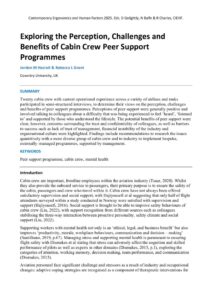
|
Author
Jordan M Hazrati & Rebecca L Grant |
Abstract
Twenty cabin crew with current operational experience across a variety of airlines and ranks participated in semi-structured interviews, to determine their views on the perception, challenges and benefits of peer support programmes. Perceptions of peer support were generally positive and involved talking to colleagues about a difficulty that was being experienced to feel ‘heard’, ‘listened to’ and supported by those who understood the lifestyle. The potential benefits of peer support were clear, however, concerns surrounding the trust and confidentiality of colleagues, as well as barriers to success such as lack of trust of management, financial instability of the industry and organisational culture were highlighted. Findings include recommendations to research the issues quantitively with a more diverse group of cabin crew and to industry to implement bespoke, externally–managed programmes, supported by management. |
Publish Date: Jun 24, 2022 | Keywords: Automation, Contemporary EHF 2022, Cybersecurity, Publications, Rail, Tools & techniques
| Document
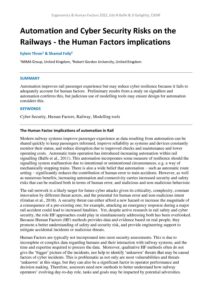
|
Author
Eylem Thron & Shamal Faily |
Abstract
Automation improves rail passenger experience but may reduce cyber resilience because it fails to adequately account for human factors. Preliminary results from a study on signallers and automation confirms this, but judicious use of modelling tools may ensure design for automation considers this. |
Publish Date: Feb 27, 2019 | Keywords: Contemporary EHF 2016, Equality, diversity & inclusion (EDI), Occupational health, Publications
| Document
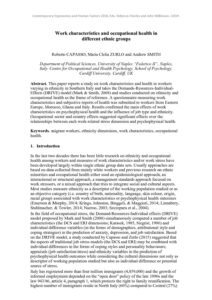
|
Author
Roberto CAPASSO, Maria Clelia ZURLO and Andrew SMITH |
Abstract
This paper reports a study on work characteristics and health in workers varying in ethnicity in Southern Italy and takes the Demands-Resources-Individual-Effects (DRIVE) model (Mark & Smith, 2008) and studies conducted on ethnicity and occupational health as the frame of reference. A questionnaire measuring work characteristics and subjective reports of health was submitted to workers from Eastern Europe, Morocco, Ghana and Italy. Results confirmed the main effects of work characteristics on psychophysical health and the influence of job type and ethnicity. Occupational sector and country effects suggested significant effects over the relationships between each work-related stress dimension and psychophysical health. |
Publish Date: Feb 27, 2019 | Keywords: Contemporary EHF 2016, Healthcare, Publications, Technology, User centred design
| Document
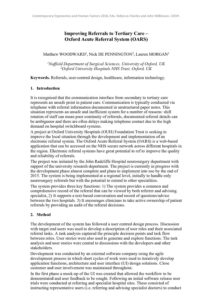
|
Author
Matthew WOODWARD, Nick DE PENNINGTON, Lauren MORGAN |
Abstract
|
Publish Date: May 30, 2024 | Keywords: Contemporary EHF 2024, Ergonomics, Publications, Workplace Design
| Document
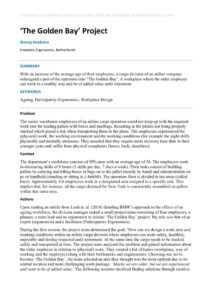
|
Author
Gonny Hoekstra |
Abstract
With an increase of the average age of their employees, a cargo division of an airline company redesigned a part of the operation into “The Golden Bay’. A workplace where the older employee can work in a healthy way and be of added value until retirement. |
Publish Date: Dec 17, 2018 | Keywords: Contemporary EHF 2017, Publications, Sport & leisure, Systems
| Document
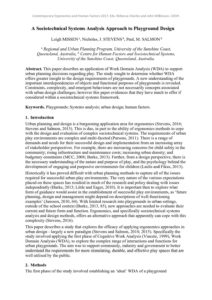
|
Author
Leigh MISSEN a, Nicholas, J. STEVENS b, Paul, M. SALMON b |
Abstract
This paper describes an application of Work Domain Analysis (WDA) to support urban planning decisions regarding play. The study sought to determine whether WDA offers greater insight to the design requirements of playgrounds. A new understanding of the important interdependencies of objects and functional purposes of playgrounds is revealed. Constraints, complexity, and emergent behaviours are not necessarily concepts associated with urban design challenges; however this paper evidences that they have much to offer if considered within a sociotechnical systems framework. |
Publish Date: May 23, 2025 | Keywords: Contemporary EHF 2025, Human performance, Human-machine interaction, Publications, Technology
| Document
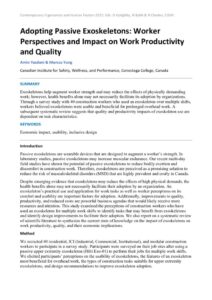
|
Author
Amin Yazdani & Marcus Yung |
Abstract
Exoskeletons help augment worker strength and may reduce the effects of physically demanding work; however, health benefits alone may not necessarily facilitate its adoption by organizations. Through a survey study with 40 construction workers who used an exoskeleton over multiple shifts, workers believed exoskeletons were usable and beneficial for prolonged overhead work. A subsequent systematic review suggests that quality and productivity impacts of exoskeleton use are dependent on task characteristics. |
Publish Date: Jun 12, 2023 | Keywords: Automotive, Contemporary EHF 2023, Publications
| Document
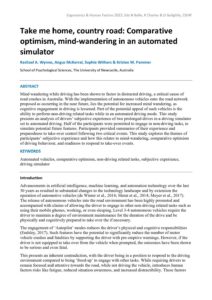
|
Author
Rachael A. Wynne, Angus McKerral, Sophie Withers & Kristen M. Pammer |
Abstract
Mind wandering while driving has been shown to factor in distracted driving, a critical cause of road crashes in Australia. With the implementation of autonomous vehicles onto the road network proposed as occurring in the near future, lies the potential for increased mind wandering, as cognitive engagement in driving is lessened. Part of the potential appeal of such vehicles is the ability to perform non-driving related tasks while in an automated driving mode. This study presents an analysis of drivers’ subjective experience of two prolonged drives in a driving simulator set to automated driving. Half of the participants were permitted to engage in non-driving tasks, to simulate potential future features. Participants provided summaries of their experience and preparedness to take-over control following two critical events. This study explores the themes of participants’ subjective experience and how this relates to mind-wandering, comparative optimism of driving behaviour, and readiness to respond to take-over events. |
Publish Date: Apr 15, 2020 | Keywords: Contemporary EHF 2020, Healthcare, Leadership, Publications
| Document
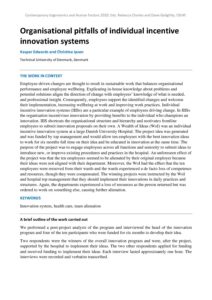
|
Author
Kasper Edwards and Christine Ipsen |
Abstract
Employee-driven changes are thought to result in sustainable work that balances organisational performance and employee wellbeing. Explicating in-house knowledge about problems and potential solutions aligns the direction of change with employees’ knowledge of what is needed, and professional insight. Consequently, employees support the identified changes and welcome their implementation, increasing wellbeing at work and improving work practices. Individual incentive innovation systems (IIISs) are a particular example of employees driving change. In IIISs the organisation incentivises innovation by providing benefits to the individual who champions an innovation. IIIS shortcuts the organisational structure and hierarchy and motivates frontline employees to submit innovation proposals on their own. A Wealth of Ideas (WoI) was an individual incentive innovation system at a large Danish University Hospital. The project idea was generated and was funded by top management and would allow ten employees with the best innovation ideas to work for six months full time on their idea and be educated in innovation at the same time. The purpose of the project was to engage employees across all functions and seniority to submit ideas to introduce new, or improve existing procedures and practices in the hospital. An unforeseen effect of the project was that the ten employees seemed to be alienated by their original employer because their ideas were not aligned with their department. Moreover, the WoI had the effect that the ten employees were removed from their wards and the wards experienced a de facto loss of competence and resources, though they were compensated. The winning projects were instructed by the WoI and hospital top management that they should implement their innovations in daily practices and structures. Again, the departments experienced a loss of resources as the person returned but was ordered to work on something else, causing further alienation. |
Publish Date: Apr 15, 2020 | Keywords: Contemporary EHF 2020, Healthcare, Publications, SEIPS
| Document
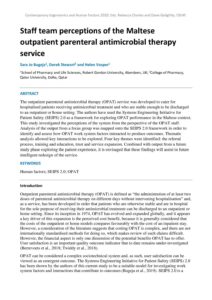
|
Author
Sara Jo Bugeja, Derek Stewart and Helen Vosper |
Abstract
The outpatient parenteral antimicrobial therapy (OPAT) service was developed to cater for hospitalised patients receiving antimicrobial treatment and who are stable enough to be discharged to an outpatient or home setting. The authors have used the Systems Engineering Initiative for Patient Safety (SEIPS) 2.0 as a framework for exploring OPAT performance in the Maltese context. This study investigated the perceptions of the system from the perspective of the OPAT staff. Analysis of the output from a focus group was mapped onto the SEIPS 2.0 framework in order to identify and assess how OPAT work system factors interacted to produce outcomes. Thematic analysis allowed key interactions to be explored. Four key themes were identified: the referral process, training and education, trust and service expansion. Combined with output from a future study phase exploring the patient experience, it is envisaged that these findings will assist in future intelligent redesign of the service. |
Publish Date: Jun 24, 2022 | Keywords: Contemporary EHF 2022, Publications, Tools & techniques, Workload
| Document
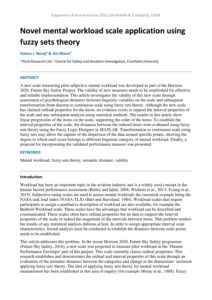
|
Author
Hanna J. Neroj & Jim Nixon |
Abstract
A new scale measuring pilot subjective mental workload was developed as part of the Horizon 2020, Future Sky Safety Project: The validity of new measures needs to be established for effective and reliable implementation. This article investigates the validity of this new scale through assessment of psychological distances between linguistic variables on the scale and subsequent transformation from discrete to continuous scale using fuzzy sets theory. Although the new scale has claimed ordinal properties for the items, no evidence exists to support the interval properties of the scale and any subsequent analysis using statistical methods. The results in this article show linear progression of the items on the scale, supporting the order of the items. To establish the interval properties of the scale, the distances between the ordered items were evaluated using fuzzy sets theory using the Fuzzy Logic Designer in MATLAB. Transformation to continuous scale using fuzzy sets may allow the capture of the dispersion of the data around specific points, showing the degree to which each score belongs to different linguistic category of mental workload. Finally, a proposal for incorporating the validated performance measure was presented. |
Publish Date: Sep 7, 2019 | Keywords: Contemporary EHF 2019, Design, Perception, Publications, Technology
| Document
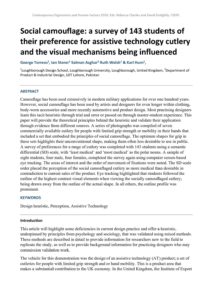
|
Author
George Torrens, Ian Storer, Salman Asghar, Ruth Welsh & Karl Hurn |
Abstract
Camouflage has been used extensively in modern military applications for over one hundred years. However, social camouflage has been used by artists and designers for even longer within clothing, body-worn accessories and more recently automotive and product design. Most practising designers learn this tacit heuristic through trial and error or passed on through master-student experience. This paper will provide the theoretical principles behind the heuristic and validate their application through evidence from different sources. A series of photographs was compiled of seven commercially available cutlery for people with limited grip strength or mobility in their hands that included a set that embodied the principles of social camouflage. The optimum shapes for grip in these sets highlights their unconventional shape, making them often less desirable to use in public. A survey of preferences for a range of cutlery was completed with 143 students using a semantic differential (SD) scale, with ‘least medical’ and ‘most medical’ as the polar nouns. A sample of eight students, four male, four females, completed the survey again using computer screen-based eye tracking. The areas of interest and the order of movement of fixations were noted. The SD scale order placed the perception of the social camouflaged cutlery as more medical than desirable in contradiction to current sales of the product. Eye tracking highlighted that students followed the outline of the highest contrast visual elements when viewing the socially camouflaged cutlery; being drawn away from the outline of the actual shape. In all others, the outline profile was prominent. |
Publish Date: Aug 9, 2021 | Keywords: Automotive, Autonomous vehicles, Comfort, Comfort Congress 2021, Mental health & wellbeing, Publications
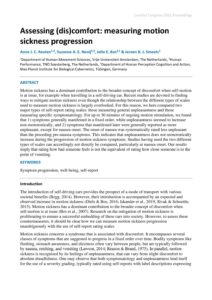 |
Author
Anna J. C. Reuten, Suzanne A. E. Nooij, Jelte E. Bos & Jeroen B. J. Smeets |
Abstract
Motion sickness has a dominant contribution to the broader concept of discomfort when self-motion is at issue, for example when travelling in a self-driving car. Recent studies are devoted to finding ways to mitigate motion sickness even though the relationship between the different types of scales used to measure motion sickness is largely overlooked. For this reason, we here compared two major types of self-report rating scales: those measuring general unpleasantness and those measuring specific symptomatology. For up to 30 minutes of ongoing motion stimulation, we found that 1) symptoms generally manifested in a fixed order, while unpleasantness seemed to increase non-monotonically, and 2) symptoms that manifested later were generally reported as more unpleasant, except for nausea onset. The onset of nausea was systematically rated less unpleasant than the preceding pre-nausea symptoms. This indicates that unpleasantness does not monotonically increase during the progression of motion sickness symptoms. Studies having used the two different types of scales can accordingly not directly be compared, particularly at nausea onset. Our results imply that rating how bad someone feels is not the equivalent of rating how close someone is to the point of vomiting. |
Publish Date: Apr 9, 2020 | Keywords: Automation, Contemporary EHF 2020, Human factors integration, Human-machine interaction, Publications, Rail
| Document
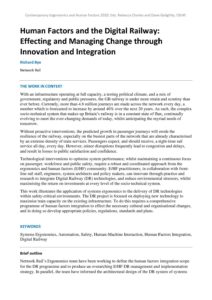
|
Author
Richard Bye |
Abstract
With an infrastructure operating at full capacity, a testing political climate, and a mix of government, regulatory and public pressures, the GB railway is under more strain and scrutiny than ever before. Currently, more than 4.8 million journeys are made across the network every day, a number which is forecasted to increase by around 40% over the next 20 years. As such, the complex sociotechnical system that makes up Britain’s railway is in a constant state of flux, continually evolving to meet the everchanging demands of today, whilst anticipating the myriad needs of tomorrow. Without proactive interventions, the predicted growth in passenger journeys will erode the resilience of the railway, especially on the busiest parts of the network that are already characterised by an extreme density of train services. Passengers expect, and should receive, a right-time rail service all day, every day. However, minor disruptions frequently lead to congestion and delays, and result in losses to public satisfaction and confidence. Technological interventions to optimise system performance, whilst maintaining a continuous focus on passenger, workforce and public safety, require a robust and coordinated approach from the ergonomics and human factors (human factors) community. Human factors practitioners, in collaboration with frontline rail staff, engineers, system architects and policy makers, can innovate through practice and research to integrate digital railway (DR) technologies, and reduce environmental stressors, whilst maximising the return on investments at every level of the sociotechnical system. This work illustrates the application of systems ergonomics to the delivery of DR technologies within safety-critical work environments. The DR project is focused on deploying new technology to maximise train capacity on the existing infrastructure. To do this requires a comprehensive programme of human factors integration to effect the necessary cultural and organisational changes, and in doing so develop appropriate policies, regulations, standards and plans. |
Publish Date: Apr 9, 2021 | Keywords: Contemporary EHF 2021, Fatigue & sleep, Publications, Risk assessment
| Document
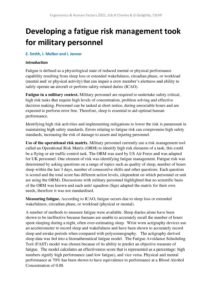
|
Author
E. Smith, I. Mollan and I. Jenner |
Abstract
|
Publish Date: May 27, 2025 | Keywords: Contemporary EHF 2025, Publications, Risk assessment, Safety, Systems
| Document
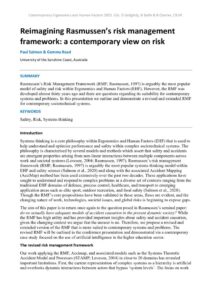
|
Author
Paul Salmon & Gemma Read |
Abstract
Rasmussen’s Risk Management Framework (RMF; Rasmussen, 1997) is arguably the most popular model of safety and risk within Ergonomics and Human Factors (EHF). However, the RMF was developed almost thirty years ago and there are questions regarding its suitability for contemporary systems and problems. In this presentation we outline and demonstrate a revised and extended RMF for contemporary sociotechnical systems. |
Publish Date: Jun 11, 2025 | Keywords: Automotive, Behaviour, Contemporary EHF 2025, Design, Publications, Systems
| Document
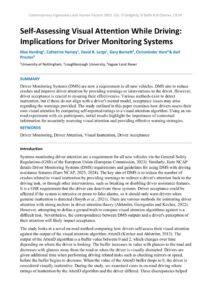
|
Author
Max Harding, Catherine Harvey, David R. Large, Gary Burnett, Chrisminder Hare & Karl Proctor |
Abstract
Driver Monitoring Systems (DMS) are now a requirement in all new vehicles. DMS aim to reduce crashes and improve driver attention by providing warnings or interventions to the driver. However, driver acceptance is crucial to ensuring their effectiveness. Various methods exist to detect inattention, but if these do not align with a driver's mental model, acceptance issues may arise regarding the warnings provided. The study outlined in this paper examines how drivers assess their own visual attention by comparing self-reported ratings to a visual attention algorithm. Using an on-road experiment with six participants, initial results highlight the importance of contextual information for accurately assessing visual attention and providing effective warning strategies. |
Publish Date: Apr 9, 2021 | Keywords: Contemporary EHF 2021, Musculoskeletal, Publications
| Document
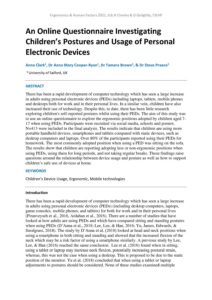
|
Author
Anna Clark, Dr Anna Mary Cooper-Ryan, Dr Tamara Brown, & Dr Steve Preece |
Abstract
There has been a rapid development of computer technology which has seen a large increase in adults using personal electronic devices (PEDs) including laptops, tablets, mobile phones and desktops both for work and in their personal lives. In a similar vein, children have also increased their use of technology. Despite this, to date, there has been little research exploring children's self-reported postures whilst using their PEDs. The aim of this study was to use an online questionnaire to explore the ergonomic positions adopted by children aged 7-17 when using PEDs. Participants were recruited via social media, schools and posters. N=413 were included in the final analysis. The results indicate that children are using more portable handheld devices, smartphones and tablets compared with static devices, such as desktop computers and laptops. Over 80% of the participants reported using their PEDs for homework. The most commonly adopted position when using a PED was sitting on the sofa. The results show that children are reporting adopting less or non-ergonomic positions when using PEDs, using them for long periods, and not taking regular breaks. These findings raise questions around the relationship between device usage and posture as well as how to support children’s safe use of devices at home. |
Publish Date: Jun 24, 2022 | Keywords: Contemporary EHF 2022, Education, training & skills, Publications, Tools & techniques
| Document
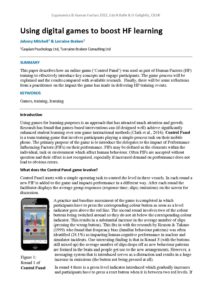
|
Author
Johnny Mitchell & Lorraine Braben |
Abstract
This paper describes how an online game (‘Control Panel’) was used as part of Human Factors (HF) training to effectively introduce key concepts and engage participants. The game process will be explained and the results compared with available research. Finally, there will be some reflections from a practitioner on the impact the game has made in delivering HF training events. |
Publish Date: May 15, 2024 | Keywords: Contemporary EHF 2024, Healthcare, Publications, Usability
| Document
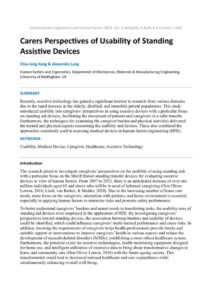
|
Author
Chia-Jung Kang & Alexandra Lang |
Abstract
Recently, assistive technology has gained a significant interest in research from various domains due to the rapid increase in the elderly, disabled, and immobile patient populations. This study introduced usability into caregivers’ perspectives in using assistive devices with a particular focus on standing aid devices, facilitating the movement of patients and caregivers in a safer transfer. Furthermore, the techniques for examining the caregiver burden and physical activities delivered the mental and physical aspects concerning the usability and devices. These also combined the approaches commonly used in assessing medical devices in human factors engineering (HFE). |
Publish Date: Jun 24, 2022 | Keywords: Behaviour, Contemporary EHF 2022, Mental health & wellbeing, Publications, Veterinary
| Document
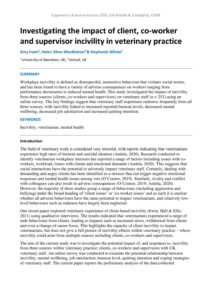
|
Author
Amy Irwin, Helen Silver-MacMahon & Stephanie Wilcke |
Abstract
Workplace incivility is defined as disrespectful, insensitive behaviour that violates social norms, and has been found to have a variety of adverse consequences on workers ranging from performance decrements to reduced mental health. This study investigated the impact of incivility from three sources (clients, co-workers and supervisors) on veterinary staff (n = 252) using an online survey. The key findings suggest that veterinary staff experience rudeness frequently from all three sources, with incivility linked to increased reported burnout levels, decreased mental wellbeing, decreased job satisfaction and increased quitting intention. |
Publish Date: Jun 24, 2022 | Keywords: Contemporary EHF 2022, Equality, diversity & inclusion (EDI), Psychology, Publications, Tools & techniques
| Document
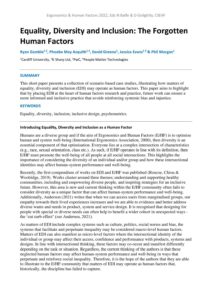
|
Author
Ryan Gamble, Phoebe May Asquith1, David Greeno, Jessica Evans & Phil Morgan |
Abstract
This short paper presents a collection of scenario-based case studies, illustrating how matters of equality, diversity and inclusion (EDI) may operate as human factors. This paper aims to highlight that by placing EDI at the heart of human factors research and practice, future work can ensure a more informed and inclusive practice that avoids reinforcing systemic bias and injustice. |
Publish Date: Apr 17, 2020 | Keywords: Contemporary EHF 2020, Publications, Road safety
| Document
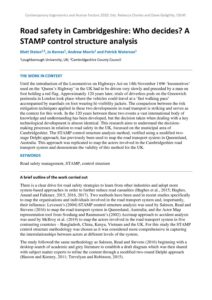
|
Author
Matt Staton, Jo Barnes, Andrew Morris and Patrick Waterson |
Abstract
Until the introduction of the Locomotives on Highways Act on 14th November 1896 ‘locomotives’ used on the ‘Queen’s Highway’ in the UK had to be driven very slowly and preceded by a man on foot holding a red flag. Approximately 120 years later, trials of driverless pods on the Greenwich peninsula in London took place where the vehicles could travel at a ‘fast walking pace’ accompanied by marshals on foot wearing hi-visibility jackets. The comparison between the risk mitigation techniques applied in these two developments in road transport is striking and serves as the context for this work. In the 120 years between these two events a vast international body of knowledge and understanding has been developed, but the decision taken when dealing with a key technological development is almost identical. This research aims to understand the decision-making processes in relation to road safety in the UK, focussed on the municipal area of Cambridgeshire. The STAMP control structure analysis method, verified using a modified two-stage Delphi approach, has previously been used to map the road transport system in Queensland, Australia. This approach was replicated to map the actors involved in the Cambridgeshire road transport system and demonstrate the validity of this method for the UK. |
Publish Date: May 30, 2024 | Keywords: Contemporary EHF 2024, Human factors integration, Publications, Rail, Workload
| Document
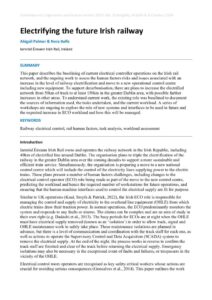
|
Author
Abigail Palmer & Nora Balfe |
Abstract
This paper describes the baselining of current electrical controller operations on the Irish rail network, and the ongoing work to assess the human factors risks and issues associated with an increase in the level of railway electrification and move to a new operational control centre including new equipment. To support decarbonisation, there are plans to increase the electrified network from 50km of track to at least 150km in the greater Dublin area, with possible further increases in other areas. To understand current work, the existing role was baselined to document the sources of information used, the tasks undertaken, and the current workload. A series of workshops are ongoing to explore the role of new systems and interfaces to be used in future and the expected increase in ECO workload and how this will be managed. |
Publish Date: Apr 15, 2020 | Keywords: Contemporary EHF 2020, Publications, Task analysis, Technology
| Document
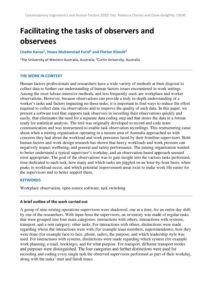
|
Author
Lisette Kanse, Hawa Muhammad Farid and Florian Klonek |
Abstract
Human factors professionals and researchers have a wide variety of methods at their disposal to collect data to further our understanding of human factors issues encountered in work settings. Among the most labour-intensive methods, and less frequently used, are workplace and worker observations. However, because observations can provide a truly in-depth understanding of a worker’s tasks and factors impacting on these tasks, it is important to find ways to reduce the effort required to collect data via observations and to improve the quality of such data. In this paper, we present a software tool that supports task observers in recording their observations quickly and easily, that eliminates the need for a separate data coding step and that stores the data in a format ready for statistical analysis. The tool was originally developed to record and code team communication and was restructured to enable task observation recordings. This restructuring came about when a mining organisation operating in a remote area of Australia approached us with concerns they had about the workload and work pressures faced by their frontline supervisors. Both human factors and work design research has shown that heavy workloads and work pressure can negatively impact wellbeing, and general and safety performance. The mining organisation wanted to better understand a typical supervisor’s workday, and an observation-based approach seemed most appropriate. The goal of the observations was to gain insight into the various tasks performed, time dedicated to each task, how many and which tasks are juggled on an hour-by-hour basis, when peaks in workload occur, and which potential improvement areas exist to make work life easier for the supervisors and to better support them. |
Publish Date: Apr 15, 2020 | Keywords: Contemporary EHF 2020, Emergency services, Publications, Safety
| Document
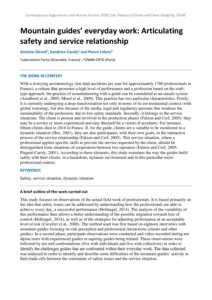
|
Author
Antoine Girard, Sandrine Caroly and Pierre Falzon |
Abstract
With a worrying accidentology (ten fatal accidents per year for approximately 1700 professionals in France), a culture that promotes a high level of performance and a profession based on the craft-type approach, the practice of mountaineering with a guide can be considered as an unsafe system (Amalberti et al., 2005; Morel et al., 2009). This practice has two particular characteristics. Firstly, it is currently undergoing a deep transformation not only in terms of its environmental context (with global warming), but also because of the media, legal and regulatory pressure that weakens the sustainability of the profession, due to low safety standards. Secondly, it belongs to the service situations. The client is present and involved in the production phases (Falzon and Cerf, 2005): they may be a novice or more experienced and may themself be a victim of accidents. For instance, fifteen clients died in 2018 in France. If, for the guide, clients are a variable to be monitored in a dynamic situation (Hoc, 2001), they are also participants, with their own goals, in the interactive process of the service relationship (Falzon and Cerf, 2005). This service situation, where a professional applies specific skills to provide the service requested by the client, should be distinguished from situations of cooperation between two operators (Falzon and Cerf, 2005; Flageul-Caroly, 2001). According to these elements, this study examines the way the guides build safety with their clients, in a hazardous, dynamic environment and in this particular socio-professional context. |
Publish Date: Mar 24, 2019 | Keywords: Contemporary EHF 2016, Healthcare, Publications, Safety
| Document
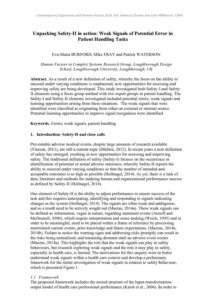
|
Author
Eva-Maria BURFORD, Mike FRAY and Patrick WATERSON |
Abstract
As a result of a new definition of safety, whereby the focus on the ability to succeed under varying conditions is emphasised, new opportunities for assessing and improving safety are being developed. This study investigated both Safety-I and Safety-II elements using a focus group method with two expert groups in patient handling. The Safety-I and Safety-II elements investigated included potential errors, weak signals and learning opportunities arising from these situations. The weak signals that were identified were classified as originating from either an external or internal source. Potential learning opportunities to improve signal recognition were identified. |
Publish Date: Jun 11, 2025 | Keywords: Climate change, Contemporary EHF 2025, Design, Medical Devices, Publications
| Document
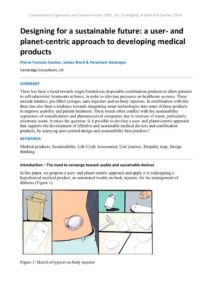
|
Author
Pierre-Francois Gautier, James Ward & Paramesh Natarajan |
Abstract
There has been a trend towards single/limited-use disposable combination products to allow patients to self-administer treatments at home, in order to alleviate pressures on healthcare systems. These include inhalers, pre-filled syringes, auto-injectors and on-body injectors. In combination with this there has also been a tendency towards integrating smart technologies into some of these products to improve usability and patient treatment. These trends often conflict with the sustainability aspirations of manufacturers and pharmaceutical companies due to increase of waste, particularly electronic waste. It raises the question: Is it possible to develop a user- and planet-centric approach that supports the development of effective and sustainable medical devices and combination products, by marrying user-centred design and sustainability best practices? |
Publish Date: Mar 24, 2019 | Keywords: Contemporary EHF 2016, Healthcare, Publications, Resilience
| Document
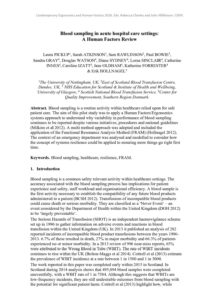
|
Author
Laura PICKUP, Sarah ATKINSON, Sam RAWLINSON, Paul BOWIE, Sandra GRAY, Douglas WATSON, Diane SYDNEY, Lorna SINCLAIR, Catherine INNES, Caroline IZATT, Jane OLDHAM, Katherine FORRESTER & Erik HOLLNAGEL |
Abstract
Blood sampling is a routine activity within healthcare relied upon for safe patient care. The aim of this pilot study was to apply a Human Factors/Ergonomics systems approach to understand why variability in performance of blood sampling continues to be reported despite various initiatives, procedures and national guidelines (Milkins et al 2012). A multi method approach was adopted and included the application of the Functional Resonance Analysis Method (FRAM) (Hollnagel 2012). The context of an emergency department was analysed and modelled to consider how the concept |
Publish Date: Jun 24, 2022 | Keywords: Contemporary EHF 2022, Human factors integration, Publications, Rail, Systems
| Document
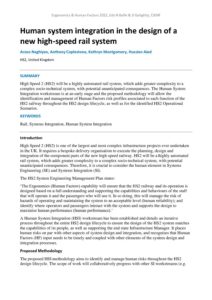
|
Author
Arzoo Naghiyev, Anthony Coplestone, Kathryn Montgomery & Hussien Aied |
Abstract
High Speed 2 (HS2) will be a highly automated rail system, which adds greater complexity to a complex socio-technical system, with potential unanticipated consequences. The Human System Integration workstream is at an early stage and the proposed methodology will allow the identification and management of Human Factors risk profiles associated to each function of the HS2 railway throughout the HS2 design lifecycle, as well as for the identified HS2 Operational Scenarios. |
Publish Date: Apr 9, 2020 | Keywords: Contemporary EHF 2020, Healthcare, Publications, Tools & techniques
| Document
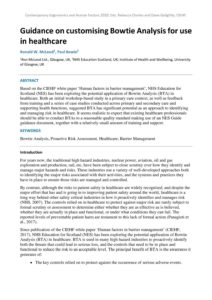
|
Author
Ronald W. McLeod and Paul Bowie |
Abstract
Based on the CIEHF white paper ‘Human factors in barrier management’, NHS Education for Scotland (NES) has been exploring the potential application of Bowtie Analysis (BTA) in healthcare. Both an initial workshop-based study in a primary care context, as well as feedback from training and a series of case studies conducted across primary and secondary care and supporting health functions, suggested BTA has significant potential as an approach to identifying and managing risk in healthcare. It seems realistic to expect that existing healthcare professionals should be able to conduct BTAs to a reasonable quality standard making use of an NES Guide guidance document, together with a relatively small amount of training and support. |
Publish Date: Feb 26, 2019 | Keywords: Automotive, Contemporary EHF 2016, Interface design, Mining, Publications
| Document
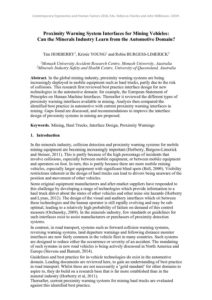
|
Author
Tim HORBERRY, Kristie YOUNG and Robin BURGESS-LIMERICK |
Abstract
In the global mining industry, proximity warning systems are being increasingly deployed in mobile equipment such as haul trucks, partly due to the risk of collisions. This research first reviewed best practice interface design for new technologies in the automotive domain: for example, the European Statement of Principles on Human Machine Interfaces. Thereafter it reviewed the different types of proximity warning interfaces available in mining. Analysis then compared the identified best practice in automotive with current proximity warning interfaces in mining. Gaps found are discussed, and recommendations to improve the interface design of proximity systems in mining are proposed. |
Publish Date: Apr 15, 2020 | Keywords: Automotive, Contemporary EHF 2020, Publications
| Document
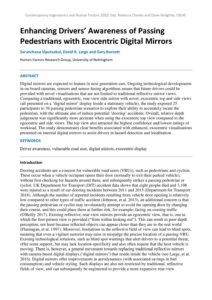
|
Author
Sarunchana Viputsakul, David R. Large and Gary Burnett |
Abstract
Digital mirrors are expected to feature in next generation cars. Ongoing technological developments in on-board cameras, sensors and sensor-fusing algorithms means that future drivers could be provided with novel visualisations that are not limited to traditional reflective mirror views. Comparing a traditional, egocentric, rear-view side mirror with novel, exocentric top and side views (all presented on a ‘digital mirror’ display inside a stationary vehicle), the study exposed 25 participants to 36 passing pedestrian scenarios to explore their ability to accurately locate the pedestrian, with the ultimate aim of reduce potential ‘dooring’ accidents. Overall, relative depth judgement was significantly more accurate when using the exocentric top view compared to the egocentric and side views. The top view also attracted the highest confidence and lowest ratings of workload. The study demonstrates clear benefits associated with enhanced, exocentric visualisations presented on internal digital mirrors to assist drivers in hazard detection and localisation. |
Publish Date: Jun 24, 2022 | Keywords: Contemporary EHF 2022, Mental health & wellbeing, Publications, Systems
| Document
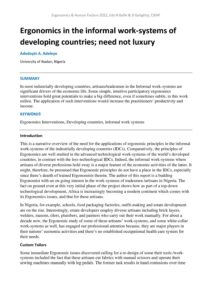
|
Author
Adedoyin A. Adeleye |
Abstract
In most industrially developing countries, artisans/tradesmen in the Informal work-systems are significant drivers of the economic life. Some simple, intuitive participatory ergonomics interventions hold great potentials to make a big difference, even if sometimes subtle, in this work milieu. The application of such interventions would increase the practitioners’ productivity and income. |
Publish Date: Jun 12, 2023 | Keywords: Contemporary EHF 2023, Design, Publications, Rail
| Document
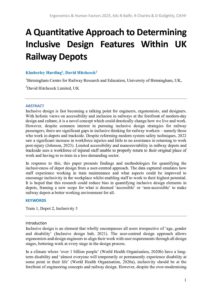
|
Author
Kimberley Harding & David Hitchcock |
Abstract
Inclusive design is fast becoming a talking point for engineers, ergonomists, and designers. With holistic views on accessibility and inclusion in railways at the forefront of modern-day design and culture, it is a novel concept which could drastically change how we live and work. However, despite common interest in pursuing inclusive design strategies for railway passengers, there are significant gaps in inclusive thinking for railway workers – namely those who work in depots and trackside. Despite reforming modern system safety techniques, 2022 saw a significant increase in workforce injuries and little to no assistance in returning to work post-injury (Johnson, 2023). Limited accessibility and manoeuvrability in railway depots and trackside sees a workforce of injured staff unable to properly return to their original place of work and having to re-train in a less demanding sector. In response to this, this paper presents findings and methodologies for quantifying the inclusiveness of depot design from a user-centred approach. The data captured emulates how staff experience working in train maintenance and what aspects could be improved to encourage inclusivity in the workplace whilst enabling staff to work to their highest potential. It is hoped that this research could reduce bias in quantifying inclusive design elements in depots, framing a new scope for what is deemed ‘accessible’ or ‘non-accessible’ to make railway depots a better working environment for all. |
Publish Date: Apr 9, 2020 | Keywords: Contemporary EHF 2020, Design, Publications, Technology
| Document
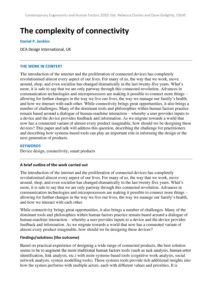
|
Author
Daniel P. Jenkins |
Abstract
The introduction of the internet and the proliferation of connected devices has completely revolutionised almost every aspect of our lives. For many of us, the way that we work, move around, shop, and even socialise has changed dramatically in the last twenty-five years. What’s more, it is safe to say that we are only partway through this connected revolution. Advances in communication technologies and microprocessors are making it possible to connect more things – allowing for further changes in the way we live our lives, the way we manage our family’s health, and how we interact with each other. While connectivity brings great opportunities, it also brings a number of challenges. Many of the dominant tools and philosophies within human factors practice remain based around a dialogue of human-machine interaction – whereby a user provides inputs to a device and the device provides feedback and information. As we migrate towards a world that now has a connected variant of almost every product imaginable, how should we be designing these devices? This paper and talk will address this question, describing the challenge for practitioners and describing how systems-based tools can play an important role in informing the design or the next generation of products. |
Publish Date: Aug 10, 2021 | Keywords: Anthropometry, Automotive, Autonomous vehicles, Comfort, Comfort Congress 2021, Publications, Seating
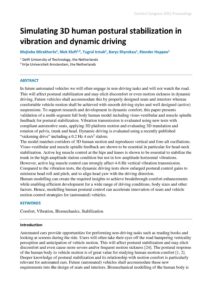 |
Author
Mojtaba Mirakhorlo, Nick Kluft, Tugrul Irmak, Barys Shyrokau & Riender Happee |
Abstract
In future automated vehicles we will often engage in non-driving tasks and will not watch the road. This will affect postural stabilization and may elicit discomfort or even motion sickness in dynamic driving. Future vehicles shall accommodate this by properly designed seats and interiors whereas comfortable vehicle motion shall be achieved with smooth driving styles and well designed (active) suspensions. To support research and development in dynamic comfort, this paper presents validation of a multi-segment full body human model including visuo-vestibular and muscle spindle feedback for postural stabilization. Vibration transmission is evaluated using new tests with compliant automotive seats, applying 3D platform motion and evaluating 3D translation and rotation of pelvis, trunk and head. Dynamic driving is evaluated using a recently published “sickening drive” including a 0.2 Hz 4 m/s2 slalom. The model matches corridors of 3D human motion and reproduces vertical and fore-aft oscillations. Visuo-vestibular and muscle spindle feedback are shown to be essential in particular for head-neck stabilization. Active leg muscle control at the hips and knees is shown to be essential to stabilize the trunk in the high amplitude slalom condition but not in low amplitude horizontal vibrations. However, active leg muscle control can strongly affect 4-6 Hz vertical vibration transmission. Compared to the vibration tests, the dynamic driving tests show enlarged postural control gains to minimise head roll and pitch, and to align head yaw with the driving direction. Human modelling can create the required insights to achieve breakthrough comfort enhancements while enabling efficient development for a wide range of driving conditions, body sizes and other factors. Hence, modelling human postural control can accelerate innovation of seats and vehicle motion control strategies for (automated) vehicles. |
Publish Date: Jun 8, 2023 | Keywords: Contemporary EHF 2023, Equality, diversity & inclusion (EDI), Healthcare, Publications, Road safety
| Document
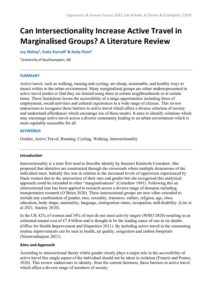
|
Author
Joy McKay, Katie Parnell & Katie Plant |
Abstract
Active travel, such as walking, running and cycling, are cheap, sustainable, and healthy ways to transit within in the urban environment. Many marginalised groups are either underrepresented in active travel modes or find they are limited using them in certain neighbourhoods or at certain times. These limitations lessen the accessibility of a range opportunities including those of employment, social activities and cultural experiences to a wide range of citizens. This review endeavours to recognise those barriers to active travel which affect a diverse selection of society and understand affordances which encourage use of these modes. It aims to identify solutions which may encourage active travel across a diverse community leading to an urban environment which is more equitably accessible for all. |
Publish Date: Aug 12, 2021 | Keywords: Automotive, Comfort, Comfort Congress 2021, Design, Perception, Publications, Seating, Usability
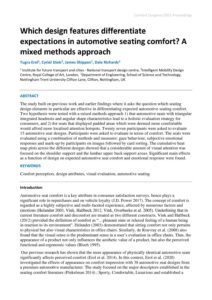 |
Author
Tugra Erol, Cyriel Diels, James Shippen & Dale Richards |
Abstract
The study built on previous work and earlier findings where it asks the question which seating design elements in particular are effective in differentiating expected automotive seating comfort. Two hypothesis were tested with a mixed methods approach 1) that automotive seats with triangular integrated headrests and angular shape characteristics lead to a holistic evaluation strategy for consumers, and 2) for seats that displayed padded areas which were deemed more comfortable would afford more localised attention hotspots. Twenty seven participants were asked to evaluate 15 automotive seat designs. Participants were asked to evaluate in terms of comfort. The seats were evaluated using a combination of methods and measures: gaze behaviour, subjective emotional responses and mark-up by participants on images followed by card sorting. The cumulative heat map plots across the different designs showed that a considerable amount of visual attention was focused on the shoulder support and the lumbar upper back support areas. Significant main effects as a function of design on expected automotive seat comfort and emotional response were found. |
Publish Date: Apr 9, 2020 | Keywords: Aerospace, Contemporary EHF 2020, Publications, Teamwork
| Document
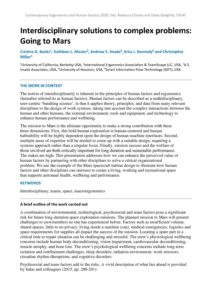
|
Author
Cristina G. Banks, Kathleen L. Mosier, Andrew S. Imada, Kriss J. Kennedy and Christopher Miller |
Abstract
The notion of interdisciplinarity is inherent in the principles of human factors and ergonomics (hereafter referred to as human factors). Human factors can be described as a multidisciplinary, user-centric ‘bundling science’, in that it applies theory, principles, and data from many relevant disciplines to the design of work systems, taking into account the complex interactions between the human and other humans, the external environment, tools and equipment, and technology to enhance human performance and wellbeing. The mission to Mars is the ultimate opportunity to make a strong contribution with these three dimensions. First, this bold human exploration is human-centered and human habitability will be highly dependent upon the design of human-machine interfaces. Second, multiple areas of expertise will be needed to come up with a suitable design, requiring a systems approach rather than a singular focus. Finally, mission success and the welfare of those involved are both critically important for long duration and sustainable performance. The stakes are high. This presentation addresses how we can enhance the perceived value of human factors by partnering with other disciplines to solve a critical organisational problem. We use the example of the Mars spacecraft habitat design to illustrate how human factors and other disciplines can intersect to create a living, working and recreational space that supports astronaut health, wellbeing and performance. |
Publish Date: Apr 9, 2021 | Keywords: Contemporary EHF 2021, Maritime, Publications, Resilience
| Document
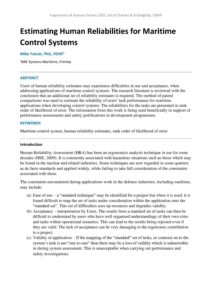
|
Author
Mike Tainsh |
Abstract
Users of human reliability estimates may experience difficulties in use and acceptance, when addressing applications of maritime control systems. The research literature is reviewed with the conclusion that an additional set of reliability estimates is required. The method of paired comparisons was used to estimate the reliability of users’ task performance for maritime applications when developing control systems. The reliabilities for the tasks are presented in rank order of likelihood of error. The information from this work is being used beneficially in support of performance assessments and safety justifications in development programmes. |
Publish Date: Jun 4, 2024 | Keywords: Contemporary EHF 2024, Data, Defence, Publications
| Document
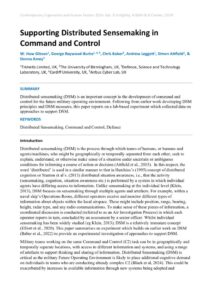
|
Author
W. Huw Gibson, George Raywood-Burke, Chris Baber, Andrew Leggatt, Simon Attfield, & Donna Amey |
Abstract
Distributed sensemaking (DSM) is an important concept in the development of command and control for the future military operating environment. Following from earlier work developing DSM principles and DSM measures, this paper reports on a lab-based experiment which collected data on approaches to support DSM. |
Publish Date: Dec 17, 2018 | Keywords: Contemporary EHF 2017, Cybersecurity, Publications, Sociotechnical systems, Technology
| Document
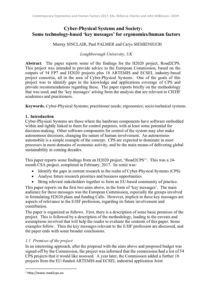
|
Author
Murray SINCLAIR, Paul PALMER and Carys SIEMIENIUCH |
Abstract
The paper reports some of the findings for the H2020 project, Road2CPS. This project was intended to provide advice to the European Commission, based on the outputs of 54 FP7 and H2020 projects plus 18 ARTEMIS and ECSEL industry-based project consortia, all in the area of Cyber-Physical Systems. One of the goals of this project was to identify gaps in the knowledge and applications coverage of CPS and provide recommendations regarding these. The paper reports briefly on the methodology that was used, and the ‘key messages’ arising from the analysis that are relevant to CIEHF academics and pracitioners. |
Publish Date: Jun 24, 2022 | Keywords: Contemporary EHF 2022, Health & Safety, Publications, Rail
| Document
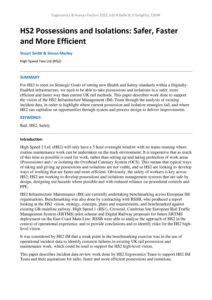
|
Author
Stuart Smith & Simon Morley |
Abstract
For HS2 to meet its Strategic Goals of setting new Health and Safety standards within a Digitally-Enabled infrastructure, we need to be able to take possessions and isolations in a safer, more efficient and faster way than current UK rail methods. This paper describes work done to support the vision of the HS2 Infrastructure Management (IM) Team through the analysis of existing incident data, in order to highlight where current possession and isolation strategies fail, and where HS2 can capitalise on opportunities through system and process design to deliver improvements. |
Publish Date: Apr 16, 2020 | Keywords: Contemporary EHF 2020, Manufacturing, Mental health & wellbeing, Publications
| Document
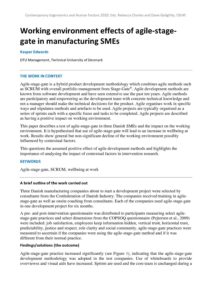
|
Author
Kasper Edwards |
Abstract
Agile-stage-gate is a hybrid product development methodology which combines agile methods such as SCRUM with overall portfolio management from Stage-Gate®. Agile development methods are known from software development and have seen extensive use the past ten years. Agile methods are participatory and empowering as the development team with concrete technical knowledge and not a manager should make the technical decisions for the product. Agile organises work in specific ways and stipulates methods and artefacts to be used. Agile projects are typically organised as a series of sprints each with a specific focus and tasks to be completed. Agile projects are described as having a positive impact on working environment. This paper describes a test of agile-stage-gate in three Danish SMEs and the impact on the working environment. It is hypothesised that use of agile-stage-gate will lead to an increase in wellbeing at work. Results show general but non-significant decline of the working environment possibly influenced by contextual factors. This questions the assumed positive effect of agile development methods and highlights the importance of analysing the impact of contextual factors in intervention research. |
Publish Date: Apr 9, 2021 | Keywords: Artificial intelligence, Contemporary EHF 2021, Publications
| Document
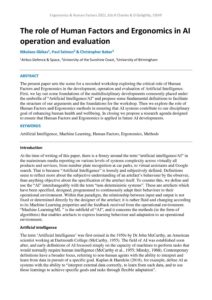
|
Author
Nikolaos Gkikas, Paul Salmon & Christopher Baber |
Abstract
The present paper sets the scene for a recorded workshop exploring the critical role of Human Factors and Ergonomics in the development, operation and evaluation of Artificial Intelligence. First, we lay out some foundations of the multidisciplinary developments commonly placed under the umbrella of “Artificial Intelligence/AI” and propose some fundamental definitions to facilitate the structure of our arguments and the foundations for the workshop. Then we explore the role of Human Factors and Ergonomics methods in ensuring that AI systems contribute to our disciplinary goal of enhancing human health and wellbeing. In closing we propose a research agenda designed to ensure that Human Factors and Ergonomics is applied in future AI developments. |
Publish Date: Oct 23, 2018 | Keywords: Automotive, Contemporary EHF 2018, Education, training & skills, Publications, Simulation
| Document
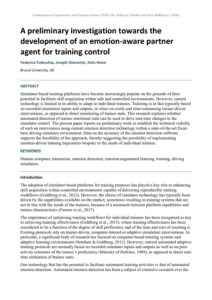
|
Author
Federico Colecchia, Joseph Giacomin, Kate Hone |
Abstract
Simulator-based training platforms have become increasingly popular on the grounds of their potential to facilitate skill acquisition within safe and controlled environments. However, current technology is limited in its ability to adapt to individual trainees. Tailoring is in fact typically based on recorded simulation inputs and outputs, or relies on costly and time-consuming trainer-driven interventions, as opposed to direct monitoring of trainee state. This research explores whether automated detection of trainee emotional state can be used to drive real-time changes to the simulator control. The present paper reports on preliminary work to establish the technical viability of such an intervention using current emotion detection technology within a state-of-the-art fixed-base driving simulator environment. Data on the accuracy of the emotion detection software supports the feasibility of the approach, thereby suggesting the possibility of implementing emotion-driven training trajectories bespoke to the needs of individual trainees. |
Publish Date: Oct 23, 2018 | Keywords: Communication, Contemporary EHF 2018, Publications, Submarines, Teamwork, Tools & techniques
| Document
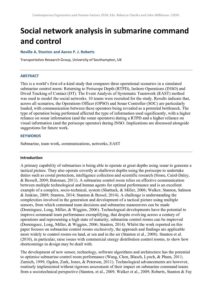
|
Author
Neville A. Stanton and Aaron P. J. Roberts |
Abstract
This is a world’s first-of-a-kind study that compares three operational scenarios in a simulated submarine control room: Returning to Periscope Depth (RTPD), Inshore Operations (INSO) and Dived Tracking of Contact (DT). The Event Analysis of Systematic Teamwork (EAST) method was used to model the social networks. 10 teams were recruited for the study. Results indicate that, across all scenarios, the Operations Officer (OPSO) and Sonar Controller (SOC) are particularly loaded, with communication between these operators being revealed as a potential bottleneck. The type of operation being performed affected the type of information used significantly, with a higher reliance on sonar information (and the sonar operators) during a RTPD and a higher reliance on visual information (and the periscope operator) during INSO. Implications are discussed alongside suggestions for future work. |
Publish Date: May 27, 2025 | Keywords: Contemporary EHF 2025, Human performance, Publications
| Document
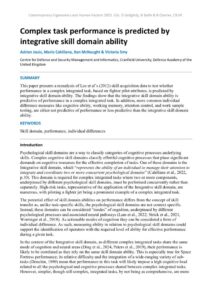
|
Author
Adrien Jouis, Marie Cahillane, Ken McNaught & Victoria Smy |
Abstract
This paper presents a reanalysis of Lee et al’s (2012) skill acquisition data to test whether performance in a complex integrated task, based on fighter pilot attributes, is predicted by integrative skill domain ability. The findings show that the integrative skill domain ability is predictive of performance in a complex integrated task. In addition, more common individual difference measures like cognitive ability, working memory, attention control, and work sample testing, are either not predictive of performance or less predictive than the integrative skill domain ability. |
Publish Date: Jun 8, 2023 | Keywords: Contemporary EHF 2023, Healthcare, Publications, Systems
| Document
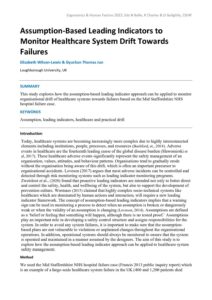
|
Author
Elizabeth Wilson-Lewis & Gyuchan Thomas Jun |
Abstract
This study explores how the assumption-based leading indicator approach can be applied to monitor organisational drift of healthcare systems towards failures based on the Mid Staffordshire NHS hospital failure case. |
Publish Date: Apr 15, 2020 | Keywords: Augmented reality, Aviation, Contemporary EHF 2020, Publications
| Document
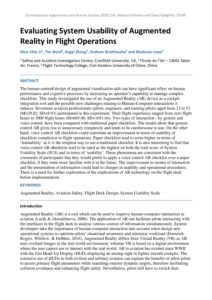
|
Author
Wen-Chin Li, Tim Bord, Jingyi Zhang, Graham Braithwaite and Mudassir Lone |
Abstract
The human-centred design of augmented visualisation aids can have significant effect on human performance and cognitive processes by increasing an operator’s capability to manage complex checklists. This study investigated the use of an Augmented Reality (AR) device as a cockpit integration tool and the possible new challenges relating to Human-Computer interactions it induces. Seventeen aviation professionals (pilots, engineers, and training pilots) aged from 23 to 53 (M=29.82, SD=8.93) participated in this experiment. Their flight experience ranged from zero flight hours to 3000 flight hours (M=605.00, SD=1051.04). Two types of interaction - by gesture and voice control, have been compared with traditional paper checklists. The results show that gesture control AR gives rise to unnecessary complexity and tends to be cumbersome to use. On the other hand, voice control AR checklists could constitute an improvement in terms of usability of checklists completion in flight operations. Paper checklists tend to score higher in terms of ‘learnability’ as it is the simplest way to use a traditional checklist. It is also interesting to find that voice control AR checklists tend to be rated as the highest on both the total score of System Usability Scale (SUS) and in terms of ‘usability’. These phenomena are consistent with the comments of participants that they would prefer to apply a voice control AR checklist over a paper checklist, if they were more familiar with it in the future. The improvement in modes of interaction and the presentation of information could lead to changes in usability and operational procedures. There is a need for further exploration of the implications of AR technology on the flight deck before implementation. |
Publish Date: May 27, 2025 | Keywords: Augmented reality, Contemporary EHF 2025, Defence, Human performance, Publications
| Document
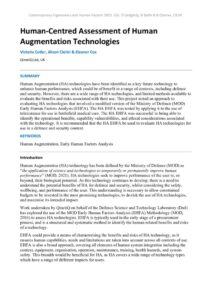
|
Author
Victoria Cutler, Alison Clerici & Eleanor Cox |
Abstract
Human Augmentation (HA) technologies have been identified as a key future technology to enhance human performance, which could be of benefit in a range of contexts, including defence and security. However, there are a wide range of HA technologies, and limited methods available to evaluate the benefits and risks associated with their use. This project tested an approach to evaluating HA technologies that involved a modified version of the Ministry of Defence (MOD) Early Human Factors Analysis (EHFA). The HA EHFA was tested by applying it to the use of telexistence for use in battlefield medical care. The HA EHFA was successful in being able to identify the operational benefits, capability vulnerabilities, and ethical considerations associated with the technology. It is recommended that the HA EHFA be used to evaluate HA technologies for use in a defence and security context. |
Publish Date: Apr 9, 2020 | Keywords: Contemporary EHF 2020, Psychology, Publications
| Document
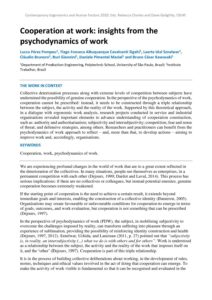
|
Author
Lucca Pérez Pompeu, Tiago Fonseca Albuquerque Cavalcanti Sigahi, Laerte Idal Sznelwar, Cláudio Brunoro, Ruri Giannini, Daniele Pimentel Maciel and Bruno César Kawasaki |
Abstract
Collective deterioration processes along with extreme levels of competition between subjects have undermined the possibility of genuine cooperation. In the perspective of the psychodynamics of work, cooperation cannot be prescribed: instead, it needs to be constructed through a triple relationship between the subject, the activity and the reality of the work. Supported by this theoretical approach, in a dialogue with ergonomic work analysis, research projects conducted in service and industrial organisations revealed important elements to advance understanding of cooperation construction, such as: authority and authoritarianism; subjectivity and intersubjectivity; competition; fear and sense of threat; and defensive strategies, among others. Researchers and practitioners can benefit from the psychodynamics of work approach to reflect – and, more than that, to develop actions – aiming to improve work and, accordingly, organisations. |
Publish Date: Sep 8, 2019 | Keywords: Contemporary EHF 2019, Perception, Publications, Technology
| Document
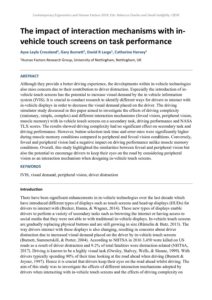
|
Author
Ayse Leyla Crossland, Gary Burnett, David R Large, Catherine Harvey |
Abstract
Although they provide a better driving experience, the developments within in-vehicle technologies also raise concern due to their contribution to driver distraction. Especially the introduction of in-vehicle touch screens has the potential to increase visual demand by the in vehicle information system (IVIS). It is crucial to conduct research to identify different ways for drivers to interact with in-vehicle displays in order to decrease the visual demand placed on the driver. The driving simulator study discussed in this paper aimed to investigate the effects of driving complexity (stationary, simple, complex) and different interaction mechanisms (foveal vision, peripheral vision, muscle memory) with in-vehicle touch screens on a secondary task, driving performance and NASA TLX scores. The results showed driving complexity had no significant effect on secondary task and driving performance. However, button selection task time and error rates were significantly higher during muscle memory conditions compared to peripheral and foveal vision conditions. Conversely, foveal and peripheral vision had a negative impact on driving performance unlike muscle memory conditions. Overall, this study highlighted the similarities between foveal and peripheral vision but also the potential to encourage drivers to keep their eyes on the road by considering peripheral vision as an interaction mechanism when designing in-vehicle touch screens. |
Publish Date: May 30, 2024 | Keywords: Automotive, Autonomous vehicles, Contemporary EHF 2024, Publications
| Document
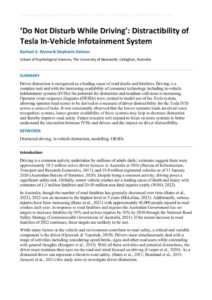
|
Author
Rachael A. Wynne & Stephanie Dolman |
Abstract
Driver distraction is recognised as a leading cause of road deaths and fatalities. Driving is a complex task and with the increasing availability of consumer technology including in-vehicle infotainment systems (IVISs) the potential for distraction and resultant collisions is increasing. Operator event sequence diagrams (OESDs) were created to model use of the Tesla system, allowing operator load scores to be derived as a measure of driver distractibility for the Tesla IVIS across a series of tasks. It was consistently observed that the lowest operator loads involved voice recognition systems, hence greater availability of these systems may help to decrease distraction and thereby improve road safety. Future research will expand to focus on more systems to better understand the interaction between IVISs and drivers and the impact on driver distractibility. |
Publish Date: Jun 23, 2022 | Keywords: Automation, Contemporary EHF 2022, Publications, Systems
| Document
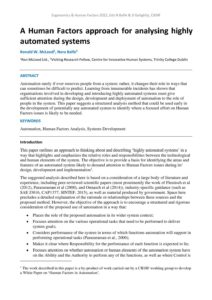
|
Author
Ronald W. McLeod & Nora Balfe |
Abstract
Automation rarely if ever removes people from a system: rather, it changes their role in ways that can sometimes be difficult to predict. Learning from innumerable incidents has shown that organisations involved in developing and introducing highly automated systems must give sufficient attention during the design, development and deployment of automation to the role of people in the system. This paper suggests a structured analysis method that could be used early in the development of potentially any automated system to identify where a focused effort on Human Factors issues is likely to be needed. |
Publish Date: Jun 11, 2025 | Keywords: Aviation, Contemporary EHF 2025, Incidents, Publications, Safety
| Document
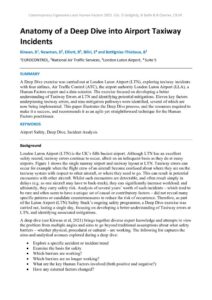
|
Author
Kirwan, B, Newman, D, Elliott, R, Biliri, E and Bettignies-Thiebaux, B |
Abstract
A Deep Dive exercise was carried out at London Luton Airport (LTN), exploring taxiway incidents with four airlines, Air Traffic Control (ATC), the airport authority London Luton Airport (LLA), a Human Factors expert and a data scientist. The exercise focused on developing a better understanding of Taxiway Errors at LTN and identifying potential mitigations. Eleven key factors underpinning taxiway errors, and nine mitigation pathways were identified, several of which are now being implemented. This paper illustrates the Deep Dive process, and the resources required to make it a success, and recommends it as an agile yet straightforward technique for the Human Factors practitioner. |
Publish Date: Jun 11, 2025 | Keywords: Contemporary EHF 2025, Medical Devices, Publications, User centred design
| Document
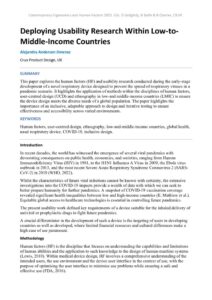
|
Author
Alejandra Anderson Jimenez |
Abstract
This paper explores the human factors (HF) and usability research conducted during the early-stage development of a novel respiratory device designed to prevent the spread of respiratory viruses in a pandemic scenario. It highlights the application of methods within the disciplines of human factors, user-centred design (UCD) and ethnography in low-and middle-income countries (LMIC) to ensure the device design meets the diverse needs of a global population. The paper highlights the importance of an inclusive, adaptable approach to design and iterative testing to ensure effectiveness and accessibility across varied environments. |
Publish Date: Dec 17, 2018 | Keywords: Contemporary EHF 2017, Mental health & wellbeing, Publications, Technology
| Document
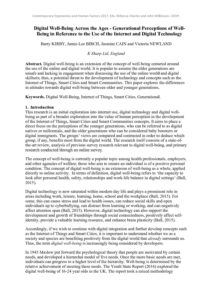
|
Author
Barry KIRBY, Jamie-Lee BIRCH, Jasmine CAIN and Victoria NEWLAND |
Abstract
Digital well-being is an extension of the concept of well-being centered around the use of the online and digital world. It is popular to assume the older generations are unsafe and lacking in engagement when discussing the use of the online world and digital skillsets; thus, a potential threat to the development of technology and concepts such as the Internet of Things, Smart Cities and Smart Communities. This paper explores the differences in attitudes towards digital well-being between older and younger generations. |
Publish Date: Jun 24, 2022 | Keywords: Aviation, Communication, Non-technical skills, Pandemic, Publications, Safety
| Document
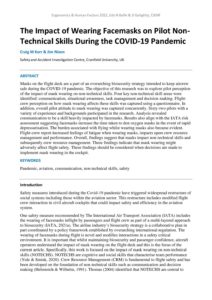
|
Author
Craig M Kerr & Jim Nixon |
Abstract
Masks on the flight deck are a part of an overarching biosecurity strategy intended to keep aircrew safe during the COVID-19 pandemic. The objective of this research was to explore pilot perception of the impact of mask wearing on non-technical skills. Four key non-technical skill areas were identified: communication, situational awareness, task management and decision making. Flight-crew perception on how mask wearing affects these skills was captured using a questionnaire. In addition, overall pilot attitude to mask wearing was captured concurrently. Sixty-two pilots with a variety of experience and backgrounds participated in the research. Analysis revealed communication to be a skill heavily impacted by facemasks. Results also align with the IATA risk assessment suggesting facemasks increase the time taken to don oxygen masks in the event of rapid depressurisation. The burden associated with flying whilst wearing masks also became evident. Flight-crew report increased feelings of fatigue when wearing masks, impacts upon crew resource management and performance. Overall, findings suggest that masks impact non-technical skills and subsequently crew resource management. These findings indicate that mask wearing might adversely affect flight safety. These findings should be considered when decisions are made to implement mask wearing in the cockpit. |
Publish Date: Sep 8, 2019 | Keywords: Climate change, Contemporary EHF 2019, Publications, Systems
| Document
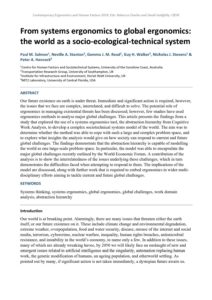
|
Author
Paul M. Salmon, Neville A. Stanton, Gemma J. M. Read, Guy H. Walker, Nicholas J. Stevens & Peter A. Hancock |
Abstract
Our future existence on earth is under threat. Immediate and significant action is required, however, the issues that we face are complex, interrelated, and difficult to solve. The potential role of ergonomics in managing existential threats has been discussed; however, few studies have used ergonomics methods to analyse major global challenges. This article presents the findings from a study that explored the use of a systems ergonomics tool, the abstraction hierarchy from Cognitive Work Analysis, to develop a complex sociotechnical systems model of the world. The aim was to determine whether the method was able to cope with such a large and complex problem space, and to explore what insights the analysis would give on how society can respond to current and future global challenges. The findings demonstrate that the abstraction hierarchy is capable of modelling the world as one large-scale problem space. In particular, the model was able to encapsulate the major global challenges recently outlined by the World Economic Forum. A contribution of the analysis is to show the interrelatedness of the issues underlying these challenges, which in turn demonstrates the difficulties faced when attempting to respond to them. The implications of the model are discussed, along with further work that is required to embed ergonomics in wider multi-disciplinary efforts aiming to tackle current and future global challenges. |
Publish Date: Jun 23, 2022 | Keywords: Contemporary EHF 2022, Healthcare, Organisational design, Pandemic, Publications
| Document
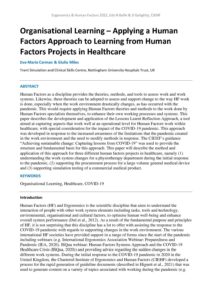
|
Author
Eva-Maria Carman & Giulia Miles |
Abstract
Human Factors as a discipline provides the theories, methods, and tools to assess work and work systems. Likewise, these theories can be adopted to assess and support change to the way HF work is done, especially when the work environment drastically changes, as has occurred with the pandemic. This would require applying Human Factors theories and methods to the work done by Human Factors specialists themselves, to enhance their own working processes and systems. This paper describes the development and application of the Lessons Learnt Reflection Approach, a tool aimed at capturing aspects that work well at an operational level for Human Factors work within healthcare, with special consideration for the impact of the COVID-19 pandemic. This approach was developed in response to the increased awareness of the limitations that the pandemic created in the work environment and the need to modify methods in response. The CIEHF’s guidance “Achieving sustainable change: Capturing lessons from COVID-19” was used to provide the structure and fundamental basis for this approach. This paper will describe the method and application of this approach for three different human factors projects in healthcare, namely (1) understanding the work system changes for a physiotherapy department during the initial response to the pandemic, (2) supporting the procurement process for a large volume general medical device and (3) supporting simulation testing of a commercial medical product. |
Publish Date: Feb 27, 2019 | Keywords: Contemporary EHF 2016, Publications
| Document
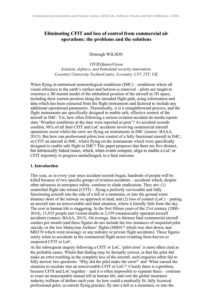
|
Author
Donough WILSON |
Abstract
When flying in instrument meteorological conditions (IMC) – conditions where all visual reference to the earth’s surface and horizon is removed – pilots are taught to construct a 3D mental model of the attitudinal position of the aircraft in 3D space, including their current position along the intended flight path, using information and data which has been extracted from the flight instruments and factored to include any additional operational parameters. Theoretically, it is a straightforward process, and the flight instruments are specifically designed to enable safe, effective control of the aircraft in IMC. Yet, how often following a serious aviation accident do media reports state ‘Weather conditions at the time were reported as poor’? As accident records confirm, 98% of all fatal CFIT and LoC accidents involving commercial aircraft operations occur whilst the crew are flying on instruments in IMC (source: BAAA, 2015). But how can professional pilots lose control of a fully functional aircraft in IMC; or CFIT an aircraft in IMC, whilst flying on the instruments which were specifically designed to enable safe flight in IMC? This paper proposes that there are five distinct, but intrinsically linked issues, which, when events conspire, align to enable a LoC or CFIT trajectory to progress unchallenged, to a fatal outcome. |
Publish Date: Jun 23, 2022 | Keywords: Contemporary EHF 2022, Education, training & skills, Healthcare, Publications, Safety
| Document
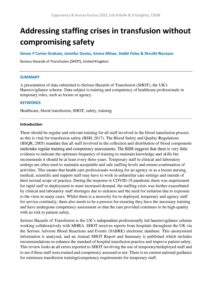
|
Author
Simon P Carter-Graham, Jennifer Davies, Emma Milser, Debbi Poles & Shruthi Narayan |
Abstract
A presentation of data submitted to Serious Hazards of Transfusion (SHOT), the UK's Haemovigilance scheme. Data subject is training and competency of healthcare professionals in temporary roles, such as locum or agency. |
Publish Date: Jun 5, 2024 | Keywords: Contemporary EHF 2024, Decision making, Human performance, Publications, Rail, Safety, Systems
| Document
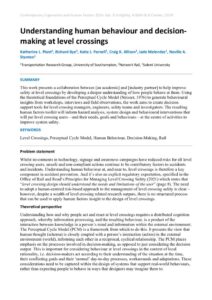
|
Author
Katherine L. Plant, Richard Bye, Katie J. Parnell, Craig K. Allison, Jade Melendez, Neville A. Stanton |
Abstract
This work presents a collaboration between [an academic] and [industry partner] to help improve safety at level crossings by developing a deeper understanding of how people behave at them. Using the theoretical foundations of the Perceptual Cycle Model (Neisser, 1976) to generate behavioural insights from workshops, interviews and field observations, the work aims to create decision support tools for level crossing managers, engineers, safety teams and investigators. The resulting human factors toolkit will inform hazard analysis, system design and behavioural interventions that will put level crossing users—and their needs, goals and behaviours—at the centre of activities to improve system safety. |
Publish Date: Feb 26, 2019 | Keywords: Contemporary EHF 2016, Education, training & skills, Musculoskeletal, Publications, Risk assessment
| Document
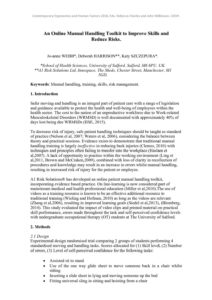
|
Author
Jo-anne WEBB, Deborah HARRISON, Katy SZCZEPURA |
Abstract
|
Publish Date: Jun 7, 2023 | Keywords: Behaviour, Contemporary EHF 2023, Publications, Road safety
| Document
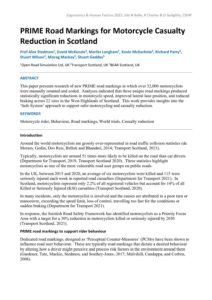
|
Author
Prof Alex Stedmon, David McKenzie, Martin Langham, Kevin McKechnie, Richard Perry, Stuart Wlison, Morag Mackay, Stuart Geddes |
Abstract
This paper presents research of new PRIME road markings in which over 32,000 motorcyclists were manually counted and coded. Analyses indicated that these unique road markings produced statistically significant reductions in motorcycle speed, improved lateral lane position, and reduced braking across 22 sites in the West Highlands of Scotland. This work provides insights into the ‘Safe System’ approach to support safer motorcycling and casualty reduction. |
Publish Date: Sep 7, 2019 | Keywords: Contemporary EHF 2019, Healthcare, Publications, Usability
| Document
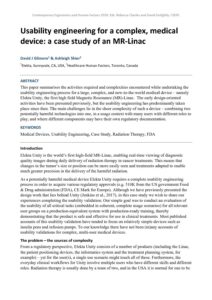
|
Author
David J Gilmore & Ashleigh Shier |
Abstract
This paper summarises the activities required and complexities encountered while undertaking the usability engineering process for a large, complex, and new-to-the-world medical device – namely Elekta Unity, the first high field Magnetic Resonance (MR)-Linac. The early design-oriented activities have been presented previously, but the usability engineering has predominantly taken place since then. The main challenges lie in the sheer complexity of such a device – combining two potentially harmful technologies into one, in a usage context with many users with different roles to play, and where different components may have their own regulatory documentation. |
Publish Date: Sep 7, 2019 | Keywords: Contemporary EHF 2019, Cybersecurity, Organisational design, Publications, Systems
| Document
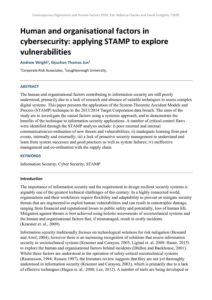
|
Author
Andrew Wright, Gyuchan Thomas Jun |
Abstract
The human and organisational factors contributing to information security are still poorly understood, primarily due to a lack of research and absence of suitable techniques to assess complex digital systems. This paper presents the application of the System-Theoretic Accident Models and Process (STAMP) technique to the 2013/2014 Target Corporation data breach. The aims of the study are to investigate the causal factors using a systemic approach, and to demonstrate the benefits of the technique to information security applications. A number of critical control flaws were identified through the STAMP analysis include: i) poor external and internal communication/co-ordination of new threats and vulnerabilities; ii) inadequate learning from past events, internally and externally; iii) a lack of proactive security management to understand and learn from system successes and good practices as well as system failures; iv) ineffective management and co-ordination with the supply chain. |
Publish Date: May 30, 2024 | Keywords: Aviation, Contemporary EHF 2024, Human factors integration, Publications
| Document
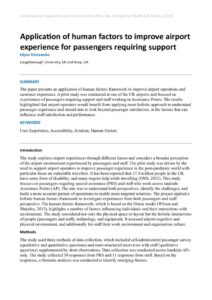
|
Author
Edyta Ostrowska |
Abstract
The paper presents an application of human factors framework to improve airport operations and customer experience. A pilot study was conducted at one of the UK airports and focused on experiences of passengers requiring support and staff working in Assistance Points. The results highlighted that airport operators would benefit from applying more holistic approach to understand passenger experience and should aim to look beyond passenger satisfaction, at the factors that can influence staff satisfaction and performance. |
Publish Date: Apr 9, 2021 | Keywords: Communication, Contemporary EHF 2021, Healthcare, Publications
| Document
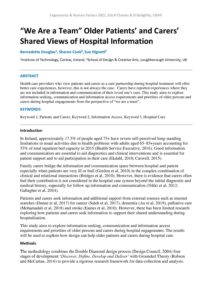
|
Author
Bernadette Douglas, Sharon Cook and Sue Hignett |
Abstract
Health care providers who view patients and carers as a care partnership during hospital treatment will offer better care experiences, however, this is not always the case. Carers have reported experiences where they are not included in information and communication of their loved one’s care. This study aims to explore information seeking, communication and information access requirements and priorities of older persons and carers during hospital engagements from the perspective of “we are a team”. |
Publish Date: Mar 17, 2019 | Keywords: Contemporary EHF 2016, Mental health & wellbeing, Publications, Technology, User centred design
| Document
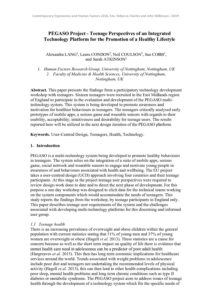
|
Author
Alexandra LANG, Laura CONDON, Neil COULSON, Sue COBB, and Sarah ATKINSON |
Abstract
This paper presents the findings from a participatory technology development workshop with teenagers. Sixteen teenagers were recruited in the East Midlands region of England to participate in the evaluation and development of the PEGASO multi-technology system. This system is being developed to promote awareness and motivation for healthier behaviours in teenagers. The teenagers critically analysed early prototypes of mobile apps, a serious game and wearable sensors with regards to their usability, acceptability, intuitiveness and desirability for teenage users. The results reported here will be utilized in the next design iteration of the PEGASO platform. |
Publish Date: May 23, 2025 | Keywords: Artificial intelligence, Aviation, Behaviour, Contemporary EHF 2025, Publications, Safety
| Document
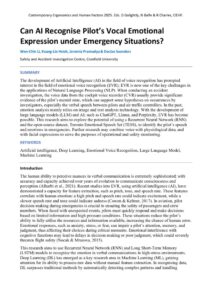
|
Author
Wen-Chin Li, Kuang-Lin Hsieh, Jeremia Pramudya & Declan Saunders |
Abstract
The development of Artificial Intelligence (AI) in the field of voice recognition has prompted interest in the field of emotional voice recognition (EVR); EVR is now one of the key challenges in the applications of Natural Language Processing (NLP). When conducting an accident investigation, the voice data from the cockpit voice recorder (CVR) usually provide significant evidence of the pilot’s mental state, which can support some hypotheses on occurrences by investigators, especially the verbal speech between pilots and air traffic controllers. In the past, emotion analysis mainly relies on image and text analysis technology. With the development of large language models (LLM) and AI; such as ChatGPT, Llama, and Perplexity, EVR has become possible. This research aims to explore the potential of using a Recurrent Neural Network (RNN) and the open-source dataset, Toronto Emotional Speech Set (TESS), to identify the pilot’s speech and emotions in emergencies. Further research may combine voice with physiological data, and with facial expressions to serve the purposes of operational and safety monitoring. |
Publish Date: Jun 3, 2024 | Keywords: Contemporary EHF 2024, Ergonomics, Human factors integration, Publications, Rail, Systems, Technology
| Document
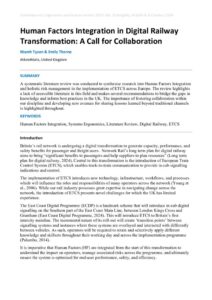
|
Author
Niamh Tyson & Emily Thorne |
Abstract
A systematic literature review was conducted to synthesise research into Human Factors Integration and holistic risk management in the implementation of ETCS across Europe. The review highlights a lack of accessible literature in this field and makes several recommendations to bridge the gaps in knowledge and inform best practices in the UK. The importance of fostering collaboration within our discipline and developing new avenues for sharing lessons learned beyond traditional channels is highlighted throughout. |
Publish Date: Mar 24, 2019 | Keywords: Contemporary EHF 2016, Decision making, Publications, Rail, Simulation
| Document
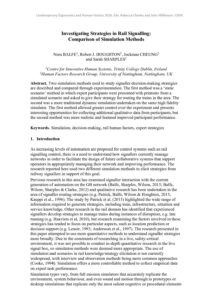
|
Author
Nora BALFE, Robert J. HOUGHTON, Jockman CHEUNG and Sarah SHARPLES |
Abstract
Two simulation methods used to study signaller decision-making strategies are described and compared through experimentation. The first method was a ‘static scenario’ method in which expert participants were presented with printouts from a simulated scenario and asked to give their strategy for routing the trains in the area. The second was a more traditional dynamic simulation undertaken on the same high fidelity simulator. The first method allowed greater control over the experiment and presents interesting opportunities for collecting additional qualitative data from participants, but the second method was more realistic and featured improved participant performance. |
Publish Date: Mar 24, 2019 | Keywords: Aviation, Behaviour, Contemporary EHF 2016, Publications
| Document
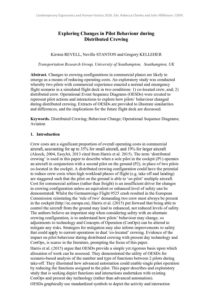
|
Author
Kirsten REVELL, Neville STANTON and Gregory KELLEHER |
Abstract
Changes to crewing configurations in commercial planes are likely to emerge as a means of reducing operating costs. An exploratory study was conducted whereby two pilots with commercial experience enacted a normal and emergency flight scenario in a simulated flight deck in two conditions: 1) co-located crew, and; 2) distributed crew. Operational Event Sequence Diagrams (OESDs) were created to represent pilot actions and interactions to explore how pilots’ behaviour changed during distributed crewing. Extracts of OESDs are provided to illustrate similarities and differences, and the implications for the future flight deck are discussed. |
Publish Date: May 27, 2025 | Keywords: Artificial intelligence, Automation, Contemporary EHF 2025, Publications
| Document
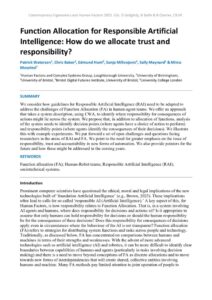
|
Author
Patrick Waterson, Chris Baber, Edmund Hunt, Sanja Milivojevic, Sally Maynard & Mirco Musolesi |
Abstract
We consider how guidelines for Responsible Artificial Intelligence (RAI) need to be adapted to address the challenges of Function Allocation (FA) in human-agent teams. We offer an approach that takes a system description, using CWA, to identify where responsibility for consequences of actions might lie across the system. We propose that, in addition to allocation of functions, analysis of the system needs to identify decision points (where agents have a choice of action to perform) and responsibility points (where agents identify the consequences of their decisions). We illustrate this with example experiments. We put forward a set of open challenges and questions facing researchers in the areas of RAI and FA. We point to the need for greater emphasis on the issue of responsibility, trust and accountability in new forms of automation. We also provide pointers for the future and how these might be addressed in the coming years. |
Publish Date: Jun 24, 2022 | Keywords: Contemporary EHF 2022, Design, Equality, diversity & inclusion (EDI), Publications, Transport
| Document
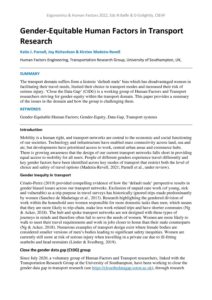
|
Author
Katie J. Parnell, Joy Richardson & Kirsten Madeira-Revell |
Abstract
The transport domain suffers from a historic ‘default male’ bias which has disadvantaged women in facilitating their travel needs, limited their choice in transport modes and increased their risk of serious injury. ‘Close the Data Gap’ (CtDG) is a working group of Human Factors and Transport researchers striving for gender-equity within the transport domain. This paper provides a summary of the issues in the domain and how the group is challenging them. |
Publish Date: Apr 9, 2020 | Keywords: Accimaps, Contemporary EHF 2020, Publications, Sociotechnical systems
| Document
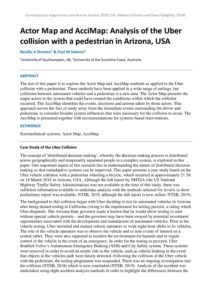
|
Author
Neville A. Stanton & Paul M. Salmon |
Abstract
The aim of this paper is to explore the Actor Map and AcciMap methods as applied to the Uber collision with a pedestrian. These methods have been applied in a wide range of settings, but collisions between automated vehicles and a pedestrian is a new area. The Actor Map presents the major actors in the system that could have created the conditions within which the collision occurred. The AcciMap identifies the events, decisions and actions taken by those actors. This approach moves the foci of study away from the immediate events surrounding the driver and pedestrian, to consider broader system influences that were necessary for the collision to occur. The AcciMap is presented together with recommendations for systems-based interventions. |
Publish Date: May 30, 2024 | Keywords: Contemporary EHF 2024, Ergonomics, Healthcare, Publications
| Document
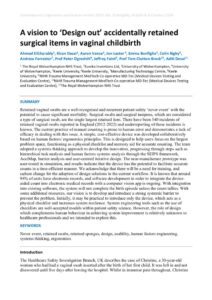
|
Author
Ahmed ElGharably, Kiran Desai, Aaron Vance, Jon Lester, Emma Bonfiglio, Colin Rigby, Andrew Forrester, Prof Peter Ogrodnik, Jeffrey Faint, Prof Tom Clutton-Brock, Aditi Desai |
Abstract
Retained vaginal swabs are a well-recognised and recurrent patient safety ‘never event’ with the potential to cause significant morbidity. Surgical swabs and surgical tampons, which are considered a type of surgical swab, are the single largest retained item. There have been 340 incidents of retained vaginal swabs reported in England (2012-2022) and underreporting of these incidents is known. The current practice of manual counting is prone to human error and demonstrates a lack of efficacy in dealing with this issue. A simple, cost-effective device was developed collaboratively based on human factors/ ergonomics principles. This is designed to help users focus on the largest problem space, functioning as a physical checklist and memory aid for accurate counting. The team adopted a systems thinking approach to develop the innovation, progressing through steps such as hierarchical task analysis and human factors systems analysis through the SEIPS framework, AcciMap, barrier analysis and user-centred iterative design. The near-manufacture prototype was user-tested in simulation, and results indicate that the device has the potential to facilitate accurate counts in a time-efficient manner. We acknowledge that there will be a need for training, and culture change for the adoption of design solutions in the current workflow. It is known that around 94% of units have electronic records, and software development in order to integrate the device�aided count into electronic medical records with a computer vision app is ongoing. With integration into existing software, the system will not complete the birth episode unless the count tallies. With some additional resources, our vision is to develop and introduce a strong systemic barrier to prevent the problem. Initially, it may be practical to introduce only the device, which acts as a physical checklist and increases system resilience. System engineering tools such as the use of checklists are well-accepted models within patient safety science. However, the role of design which complements human behaviour in achieving system improvement is relatively unknown to healthcare professionals and we intended to explore this. |
Publish Date: May 31, 2024 | Keywords: Contemporary EHF 2024, Publications, Transport, Usability
| Document
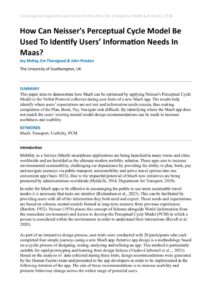
|
Author
Joy McKay, Em Thorogood & John Preston |
Abstract
This paper aims to demonstrate how MaaS can be optimised by applying Neisser's Perceptual Cycle Model to the Verbal Protocol collected during user trials of a new MaaS app. The results help identify where users’ expectations are not met and information needs remain, thus making completion of the Plan, Book, Pay, Navigate task difficult. By identifying where the MaaS app does not match the users’ existing mental model design recommendations can be made to increase usefulness and usability. |
Publish Date: Jun 10, 2024 | Keywords: Contemporary EHF 2024, Fatigue & sleep, Healthcare, Publications
| Document
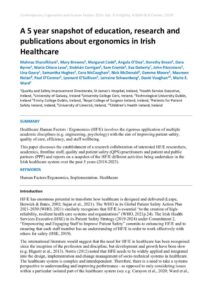
|
Author
Mahnaz Sharafkhani, Mary Browne, Margaret Codd, Angela O’Dea, Dorothy Breen, Dara Byrne, Maria Chiara Leva, Siobhán Corrigan, Sam Cromie, Eva Doherty, John Fitzsimons, Una Geary, Samantha Hughes, Cora McCaughan, Nick McDonald, Gemma Moore, Maureen Nolan, Paul O’Connor, Leonard O’Sullivan, Lorraine Schwanberg, David Vaughan, Marie E. Ward |
Abstract
Healthcare Human Factors / Ergonomics (HF/E) involves the rigorous application of multiple academic disciplines (e.g. engineering, psychology) with the aim of improving patient safety, quality of care, efficiency, and staff wellbeing. This paper discusses the establishment of a research collaboration of interested HF/E researchers, academics, frontline staff, quality and patient safety (QPS) practitioners and patient and public partners (PPP) and reports on a snapshot of the HF/E different activities being undertaken in the Irish healthcare system over the past 5 years (2018-2023). |
Publish Date: Oct 22, 2018 | Keywords: Communication, Contemporary EHF 2018, Healthcare, Publications, Technology
| Document
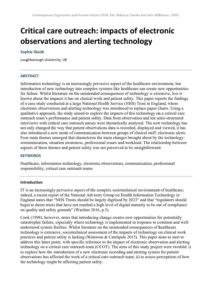
|
Author
Sophie Glazik |
Abstract
Information technology is an increasingly pervasive aspect of the healthcare environment, but introduction of new technology into complex systems like healthcare can create new opportunities for failure. Whilst literature on the unintended consequences of technology is extensive, less is known about the impacts it has on clinical work and patient safety. This paper reports the findings of a case study conducted at a large National Health Service (NHS) Trust in England, where electronic observations and alerting technology was introduced to replace paper charts. Using a qualitative approach, the study aimed to explore the impacts of this technology on a critical care outreach team’s performance and patient safety. Data from observation and ten semi-structured interviews with critical care outreach nurses were thematically analysed. The new technology has not only changed the way that patient observations data is recorded, displayed and viewed, it has also introduced a new mode of communication between groups of clinical staff: electronic alerts. Four main themes emerged that characterise the main changes brought about by the technology: communication, situation awareness, professional issues and workload. The relationship between aspects of these themes and patient safety was not perceived to be straightforward. |
Publish Date: Jun 23, 2022 | Keywords: Accimaps, Contemporary EHF 2022, Healthcare, Incidents, Investigation, Patient Safety, Publications, Safety
| Document
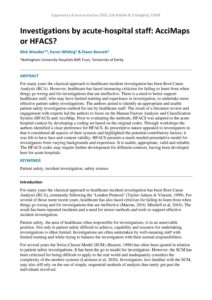
|
Author
Nick Woodier, Karen Whiting & Owen Bennett |
Abstract
For many years the classical approach to healthcare incident investigation has been Root Cause Analysis (RCA). However, healthcare has faced increasing criticism for failing to learn from when things go wrong and for investigations that are ineffective. There is a need to better support healthcare staff, who may have limited training and experience in investigation, to undertake more effective patient safety investigations. The authors aimed to identify an appropriate and usable patient safety investigation method for use by healthcare staff. The result of a literature review and engagement with experts led the authors to focus on the Human Factors Analysis and Classification System (HFACS) and AcciMap. Prior to evaluating the methods, HFACS was adapted to the acute hospital context by developing a coding set based on the original codes. Through workshops the authors identified a clear preference for HFACS. Its prescriptive nature appealed to investigators in that it considered all aspects of their systems and highlighted the potential contributory factors; it was felt to have face and content validity. HFACS presents a much-needed prescriptive model for investigators from varying backgrounds and experience. It is usable, appropriate, valid and reliable. The HFACS codes may require further development for different contexts, having been developed here for acute hospitals. |
Publish Date: May 30, 2024 | Keywords: Comfort, Contemporary EHF 2024, Human factors integration, Human performance, Human-machine interaction, Publications
| Document
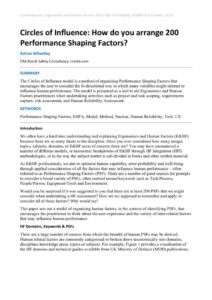
|
Author
Adrian Wheatley |
Abstract
The Circles of Influence model is a method of organising Performance Shaping Factors that encourages the user to consider the bi-directional way in which many variables might interact to influence human performance. The model is presented as a tool to aid Ergonomics and Human Factors practitioners when undertaking activities such as project and task scoping, requirements capture, risk assessment, and Human Reliability Assessment. |
Publish Date: May 30, 2024 | Keywords: Contemporary EHF 2024, Human-machine interaction, Maritime, Publications
| Document
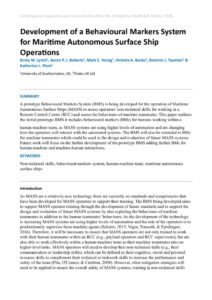
|
Author
Kirsty M. Lynch, Aaron P. J. Roberts, Mark S. Young, Victoria A. Banks, Dominic J. Taunton & Katherine L. Plant |
Abstract
A prototype Behavioural Markers System (BMS) is being developed for the operation of Maritime Autonomous Surface Ships (MASS) to assess operators’ non-technical skills for working in a Remote Control Centre (RCC) and assess the behaviours of machine teammates. This paper outlines the initial prototype BMS it includes behavioural markers (BMs) for humans working within a human-machine team, as MASS systems are using higher levels of automation and are changing how the operators will interact with the automated systems. The BMS will also be extended to BMs for machine teammates which could be used in the design and evaluation of future MASS systems. Future work will focus on the further development of the prototype BMS adding further BMs for human-machine and machine-human interactions. |
Publish Date: Jun 8, 2023 | Keywords: Contemporary EHF 2023, Healthcare, Publications, Safety, Situation awareness
| Document
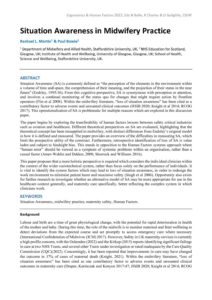
|
Author
Rachael L. Martin & Paul Bowie |
Abstract
Situation Awareness (SA) is commonly defined as “the perception of the elements in the environment within a volume of time and space, the comprehension of their meaning, and the projection of their status in the near future” (Endsley, 1995:36). From this cognitive perspective, SA is synonymous with perception or attention, and involves a continual monitoring of the status quo for changes that might require action by frontline operators (Flin et al 2008). Within the midwifery literature, “loss of situation awareness” has been cited as a contributory factor to adverse events and unwanted clinical outcomes (HSIB 2020; Knight et al 2014; RCOG 2017). This operationalisation of SA is problematic for multiple reasons which are explored in this discussion paper. The paper begins by exploring the transferability of human factors lessons between safety critical industries such as aviation and healthcare. Different theoretical perspectives on SA are evaluated, highlighting that the theoretical concept has been misapplied in midwifery, with distinct differences from Endsley’s original model in how it is defined and measured. The paper provides an overview of the difficulties in measuring SA, which limit the prospective utility of the construct. Furthermore, retrospective identification of loss of SA is value laden and subject to hindsight bias. This stands in opposition to the Human Factors systems approach where “human error” should be viewed as a symptom of systemic problems within an organisation, rather than a causal factor (Amer-Wahlin and Dekker, 2008; Shorrock and Williams 2016). This paper proposes that a more holistic perspective is required which considers the individual clinician within the context of the wider sociotechnical system, rather than focus solely on the performance of individuals. It is vital to identify the system factors which may lead to loss of situation awareness, in order to redesign the work environment to minimise patient harm and maximise safety (Singh et al 2006). Opportunity also exists for further research to investigate whether an alternative model of SA may be more appropriate for use in the healthcare context generally, and maternity care specifically, better reflecting the complex system in which clinicians work. |
Publish Date: Aug 16, 2021 | Keywords: Clothing, Comfort, Comfort Congress 2021, Publications, Tools & techniques
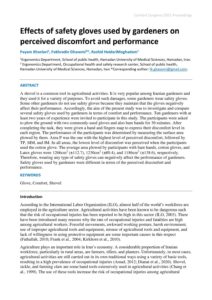 |
Author
Payam Khanlari, Fakhradin Ghasemi, Rashid HeidariMoghadam |
Abstract
A shovel is a common tool in agricultural activities. It is very popular among Iranian gardeners and they used it for a variety of purposes. To avoid such damages, some gardeners wear safety gloves. Some other gardeners do not use safety gloves because they maintain that the gloves negatively affect their performance. Accordingly, the aim of the present study was to investigate and compare several safety gloves used by gardeners in terms of comfort and performance. Ten gardeners with at least two years of experience were invited to participate in this study. The participants were asked to plow the ground with two commonly-used gloves and also bare hands for 30 minutes. After completing the task, they were given a hand and fingers map to express their discomfort level in each region. The performance of the participants was determined by measuring the surface area plowed by them. Area P was the one with the highest level of perceived discomfort, followed by TP, MM, and IM. In all areas, the lowest level of discomfort was perceived when the participants used the cotton glove. The average area plowed by participants with bare hands, cotton gloves, and Latex gloves were 1266cm2 (±112.7), 1230cm2 (±80.4), and 1186cm2 (±138.6), respectively. Therefore, wearing any type of safety gloves can negatively affect the performance of gardeners. Safety gloves used by gardeners were different in terms of the perceived discomfort and performance. |
Publish Date: Aug 16, 2021 | Keywords: Clothing, Comfort, Comfort Congress 2021, Design, Publications
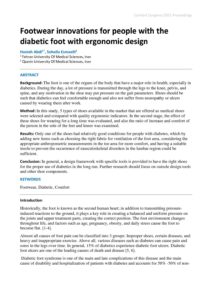 |
Author
Hanieh Abdi, Soheila Esmaeili |
Abstract
Background: The foot is one of the organs of the body that have a major role in health, especially in diabetics. During the day, a lot of pressure is transmitted through the legs to the knee, pelvis, and spine, and any motivation in the shoe may put pressure on the gait parameters. Shoes should be such that diabetics can feel comfortable enough and also not suffer from neuropathy or ulcers caused by wearing them after work. Method: In this study, 5 types of shoes available in the market that are offered as medical shoes were selected and compared with quality ergonomic indicators. In the second stage, the effect of these shoes for wearing for a long time was evaluated, and also the ratio of increase and comfort of the person in the sole of the feet and knees was examined. Results: Only one of the shoes had relatively good conditions for people with diabetes, which by adding new items such as choosing the right fabric for ventilation of the foot area, considering the appropriate anthropometric measurements in the toe area for more comfort, and having a suitable insole to prevent the occurrence of musculoskeletal disorders in the lumbar region could be sufficient. Conclusion: In general, a design framework with specific tools is provided to have the right shoes for the proper use of diabetics in the long run. Further research should focus on outsole design tools and other shoe components. |
Publish Date: May 30, 2024 | Keywords: Artificial intelligence, Contemporary EHF 2024, Design, Publications, User centred design
| Document
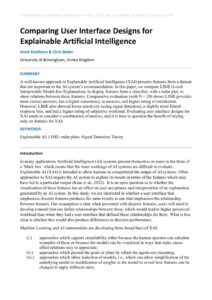
|
Author
Ionut Danilescu & Chris Baber |
Abstract
A well-known approach to Explainable Artificial Intelligence (XAI) presents features from a dataset that are important to the AI system’s recommendation. In this paper, we compare LIME (Local Interpretable Model-free Explanation), to display features from a classifier, with a radar plot, to show relations between these features. Comparative evaluation (with N = 20) shows LIME provides more correct answers, has a higher consistency in answers, and higher rating of satisfaction. However, LIME also showed lower sensitivity (using signal detection), a slightly more liberal response bias, and had a higher rating of subjective workload. Evaluating user interface designs for XAI needs to consider a combination of metrics, and it is time to question the benefit of relying only on features for XAI. |
Publish Date: Sep 7, 2019 | Keywords: Contemporary EHF 2019, Mental health & wellbeing, Office ergonomics, Publications
| Document
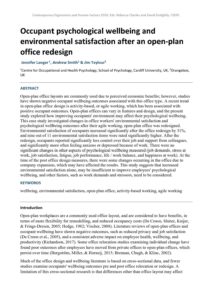
|
Author
Jennifer Langer, Andrew Smith & Jim Taylour |
Abstract
Open-plan office layouts are commonly used due to perceived economic benefits; however, studies have shown negative occupant wellbeing outcomes associated with this office type. A recent trend in open-plan office design is activity-based, or agile working, which has been associated with positive occupant outcomes. Open-plan offices can vary in features and design, and the present study explored how improving occupants' environment may affect their psychological wellbeing. This case study investigated changes in office workers' environmental satisfaction and psychological wellbeing outcomes after their agile working, open-plan office was redesigned. Environmental satisfaction of occupants increased significantly after the office redesign by 31%, and nine out of 11 environmental satisfaction items were rated significantly higher. After the redesign, occupants reported significantly less control over their job and support from colleagues, and significantly more often feeling anxious or depressed because of work. There were no significant changes in other aspects of psychological wellbeing measured (job demands, stress at work, job satisfaction, fatigue, job performance, life / work balance, and happiness at work). At the time of the post office design measures, there were some changes occurring in the office due to company expansion, which may have affected the results. This study suggests that increased environmental satisfaction alone, may be insufficient to improve employees' psychological wellbeing, and other factors, such as work demands and stressors, need to be considered. |
Publish Date: Jun 24, 2022 | Keywords: Autonomous vehicles, Contemporary EHF 2022, Human-machine interaction, Publications, Technology, Virtual reality
| Document
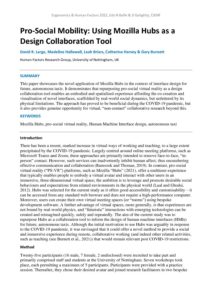
|
Author
David R. Large, Madeline Hallewell, Leah Briars, Catherine Harvey & Gary Burnett |
Abstract
This paper showcases the novel application of Mozilla Hubs in the context of interface design for future, autonomous taxis. It demonstrates that repurposing pro-social virtual reality as a design collaboration tool enables an embodied and spatialised experience affording the co-creation and visualisation of novel interfaces, scaffolded by real-world social dynamics, but unfettered by its physical limitations. The approach has proved to be beneficial during the COVID-19 pandemic, but it also provides genuine opportunity for virtual, “non-contact” collaborative research beyond this. |
Publish Date: Sep 7, 2019 | Keywords: Contemporary EHF 2019, Healthcare, Publications, Technology, Usability
| Document
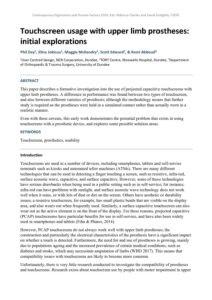
|
Author
Phil Day, Elina Jokisuu, Maggie McKendry, Scott Edward, & Rami Abboud |
Abstract
This paper describes a formative investigation into the use of projected capacitive touchscreens with upper limb prostheses. A difference in performance was found between two types of touchscreen, and also between different varieties of prosthesis; although the methodology means that further study is required as the prostheses were held in a simulated contact rather than actually worn in a realistic manner. Even with these caveats, this early work demonstrates the potential problem that exists in using touchscreens with a prosthetic device, and explores some possible solution areas. |
Publish Date: Jun 11, 2025 | Keywords: Contemporary EHF 2025, Healthcare, Publications, Systems, Tools & techniques
| Document
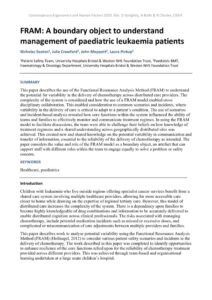
|
Author
Nicholas Seaton, Julie Crawford, John Moppett, Laura Pickup |
Abstract
This paper describes the use of the Functional Resonance Analysis Method (FRAM) to understand the potential for variability in the delivery of chemotherapy across distributed care providers. The complexity of the system is considered and how the use of a FRAM model enabled cross disciplinary collaboration. This enabled consideration to common scenarios and incidents, where variability in the delivery of care is critical to adapt to a patient’s condition. The use of scenarios and incident-based analysis revealed how core functions within the system influenced the ability of teams and families to effectively monitor and communicate treatment regimes. In using the FRAM model to facilitate discussions, the team were able to challenge their beliefs on how knowledge of treatment regimens and a shared understanding across geographically distributed sites was achieved. This created new and shared knowledge on the potential variability in communication and transfer of information, essential to the reliability of the delivery of chemotherapy as intended. The paper considers the value and role of the FRAM model as a boundary object, an artefact that can support staff with different roles within the team to engage equally to solve a problem or safety concern. |
Publish Date: Jun 23, 2022 | Keywords: Contemporary EHF 2022, Healthcare, Publications, Systems
| Document
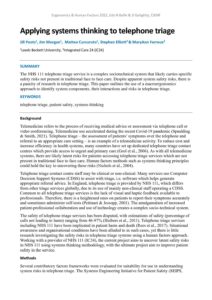
|
Author
Jill Poots, Jim Morgan, Matteo Curcuruto, Stephen Elliott & MaryAnn Ferreux |
Abstract
The NHS 111 telephone triage service is a complex sociotechnical system that likely carries specific safety risks not present in traditional face to face care. Despite apparent system safety risks, there is a paucity of research in telephone triage. This paper outlines the use of a macroergonomics approach to identify system components, their interactions and risks in telephone triage |
Publish Date: Jun 5, 2024 | Keywords: Contemporary EHF 2024, Design, Ergonomics, Human factors integration, Publications, Rail
| Document
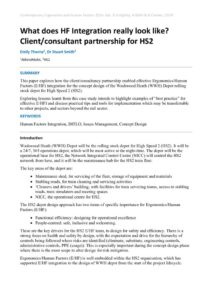
|
Author
Emily Thorne, Dr Stuart Smith |
Abstract
This paper explores how the client/consultancy partnership enabled effective Ergonomics/Human Factors (E/HF) integration for the concept design of the Washwood Heath (WWH) Depot rolling stock depot for High Speed 2 (HS2). Exploring lessons learnt from this case study intends to highlight examples of “best practice” for effective E/HFI and discuss practical tips and tools for implementation which may be transferrable to other projects, and sectors beyond the rail sector. |
Publish Date: Sep 7, 2019 | Keywords: Anthropometry, Contemporary EHF 2019, Publications
| Document
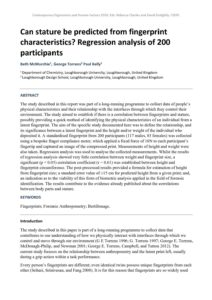
|
Author
Beth McMurchie, George Torrens Paul Kelly |
Abstract
The study described in this report was part of a long-running programme to collect data of people’s physical characteristics and their relationship with the interfaces through which they control their environment. The study aimed to establish if there is a correlation between fingerprints and stature, possibly providing a quick method of identifying the physical characteristics of an individual from a latent fingerprint. The aim of the specific study documented here was to define the relationship, and its significance between a latent fingerprint and the height and/or weight of the individual who deposited it. A standardised fingerprint from 200 participants (117 males, 83 females) was collected using a bespoke finger compliance meter, which applied a fixed force of 10N to each participant’s fingertip and captured an image of the compressed print. Measurements of height and weight were also taken. Regression analysis was used to analyse the collected measurements. Whilst the results of regression analysis showed very little correlation between weight and fingerprint size, a significant (p < 0.05) correlation coefficient (r = 0.61) was established between height and fingerprint circumference. The post-processed results provided a formula for estimation of height from fingerprint size; a standard error value of ±15 cm for predicted height from a given print; and, an indication as to the viability of this form of biometric analysis applied in the field of forensic identification. The results contribute to the evidence already published about the correlations between body parts and stature. |
Publish Date: Apr 9, 2020 | Keywords: Contemporary EHF 2020, Leadership, Mental health & wellbeing, Organisational design, Publications
| Document
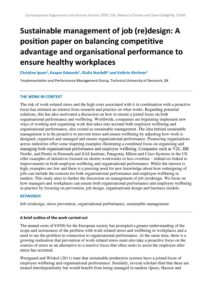
|
Author
Christine Ipsen, Kasper Edwards, Giulia Nardelli and Kathrin Kirchner |
Abstract
The risk of work-related stress and the high costs associated with it in combination with a proactive focus has initiated an interest from research and practice on what works. Regarding potential solutions, this has also motivated a discussion on how to ensure a joined focus on both organisational performance and wellbeing. Worldwide, companies are beginning implement new ways of working and organising work that takes into account both employee wellbeing and organisational performance, also coined as sustainable management. The idea behind sustainable management is to be proactive to prevent stress and ensure wellbeing by adjusting how work is designed, organised and managed and ensure organisational performance. Pioneering organisations across industries offer some inspiring examples illustrating a combined focus on organising and managing both organisational performance and employee wellbeing. Companies such as V2C, IIH Nordic, and Pentia in Denmark and SAS Institute, Patagonia, Hilton and Cisco Systems in the US offer examples of initiatives focused on shorter workweeks or less overtime – initiatives linked to improvements in both employee wellbeing and organisational performance. While the interest is high, examples are few and there is a pressing need for new knowledge about how redesigning of jobs can include the concern for both organisational performance and employee wellbeing in tandem. This study aims to further the discussion on management of job (re)design. We focus on how managers and workplaces can ensure both organisational performance and employee wellbeing in practice by focusing on prevention, job design, organisational design and business models. |
Publish Date: Jun 23, 2022 | Keywords: Automation, Contemporary EHF 2022, Defence, Design, Human-machine interaction, Publications
| Document
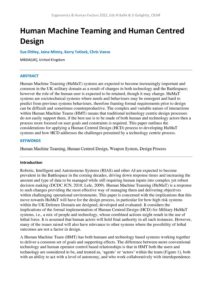
|
Author
Sue Ottley, Jaina Mistry, Kerry Tatlock & Chris Vance |
Abstract
Human Machine Teaming (HuMaT) systems are expected to become increasingly important and common in the UK military domain as a result of changes in both technology and the Battlespace; however the role of the human user is expected to be retained, though it may change. HuMaT systems are sociotechnical systems where needs and behaviours may be emergent and hard to predict from previous systems behaviours, therefore framing formal requirements prior to design can be difficult and sometimes counterproductive. The complex and variable nature of interactions within Human Machine Teams (HMT) means that traditional technology centric design processes do not easily support them, if the best use is to be made of both human and technology actors then a process more focused on user goals and constraints is required. This paper outlines the considerations for applying a Human Centred Design (HCD) process to developing HuMaT systems and how HCD addresses the challenges presented by a technology centric process. |
Publish Date: Apr 9, 2021 | Keywords: Contemporary EHF 2021, Fatigue & sleep, Occupational health, Publications, Safety, Technology
| Document
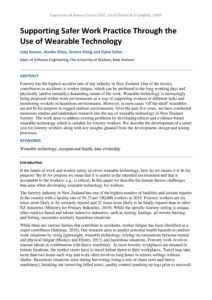
|
Author
Judy Bowen, Annika Hinze, Jemma König and Dylan Exton |
Abstract
Forestry has the highest accident rate of any industry in New Zealand. One of the known contributors to accidents is worker fatigue, which can be attributed to the long working days and physically (and/or mentally) demanding nature of the work. Wearable technology is increasingly being proposed within work environments as a way of supporting workers in different tasks and monitoring workers in hazardous environments. However, in most cases ‘off the shelf’ wearables are not fit for purpose in rugged outdoor environments. Over the past five years, we have conducted numerous studies and undertaken research into the use of wearable technology in New Zealand forestry. The work aims to address existing problems by developing ethical and evidence-based wearable technology which is suitable for forestry workers. We describe the development of a smart vest for forestry workers along with key insights gleaned from the development, design and testing processes. |
Publish Date: Sep 7, 2019 | Keywords: Contemporary EHF 2019, Human-machine interaction, Publications, Tools & techniques
| Document
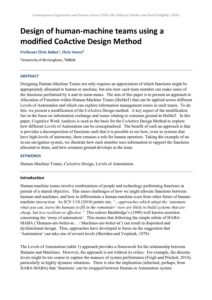
|
Author
Professor Chris Baber, Chris Vance |
Abstract
Designing Human-Machine Teams not only requires an appreciation of which functions might be appropriately allocated to human or machine, but also how each team member can make sense of the functions performed by it and its team-mates. The aim of this paper is to present an approach to Allocation of Function within Human-Machine Teams (HuMaT) that can be applied across different Levels of Automation and which can explore information management issues in such teams. To do this, we present a modification of the CoActive Design method. A key aspect of the modification lies in the focus on information exchange and issues relating to common ground in HuMaT. In this paper, Cognitive Work Analysis is used as the basis for the CoActive Design Method to explore how different Levels of Automation can be conceptualised. The benefit of such an approach is that is provides a decomposition of functions such that it is possible to see how, even in systems that have high-levels of autonomy, there remains a role for human operators. Taking the example of an in-car navigation system, we illustrate how each member uses information to support the functions allocated to them, and how common ground develops in the team. |
Publish Date: May 30, 2024 | Keywords: Contemporary EHF 2024, Publications, Road safety, Safety, Simulation
| Document
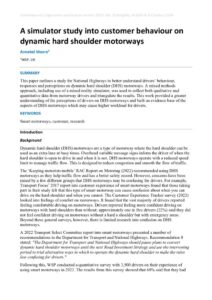
|
Author
Annabel Moore |
Abstract
This paper outlines a study for National Highways to better understand drivers’ behaviour, responses and perceptions on dynamic hard shoulder (DHS) motorways. A mixed methods approach, including use of a mixed reality simulator, was used to collect both qualitative and quantitative data from motorway drivers and triangulate the results. This work provided a greater understanding of the perceptions of drivers on DHS motorways and built an evidence base of the aspects of DHS motorways which may cause higher workload for drivers. |
Publish Date: Oct 22, 2018 | Keywords: Aviation, Contemporary EHF 2018, Human performance, Publications, Technology, Workload
| Document
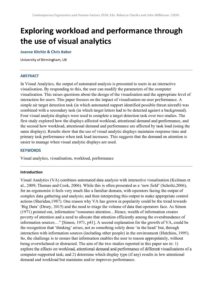
|
Author
Joanne Kitchin & Chris Baber |
Abstract
In Visual Analytics, the output of automated analysis is presented to users in an interactive visualisation. By responding to this, the user can modify the parameters of the computer visualisation. This raises questions about the design of the visualisation and the appropriate level of interaction for users. This paper focuses on the impact of visualisation on user performance. A simple air target detection task (in which automated support identified possible threat aircraft) was combined with a secondary task (in which target letters had to be detected against a background). Four visual analytic displays were used to complete a target detection task over two studies. The first study explored how the displays affected workload, attentional demand and performance, and the second how workload, attentional demand and performance are affected by task load (using the same displays). Results show that the use of visual analytic displays maintains response time and primary task performance when task load increases. This suggests that the demand on attention is easier to manage when visual analytic displays are used. |
Publish Date: Apr 9, 2021 | Keywords: Communication, Contemporary EHF 2021, Defence, Publications, Submarines
| Document
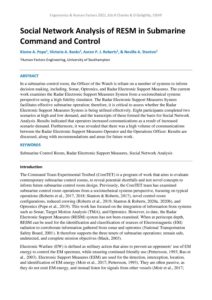
|
Author
Kiome A. Pope, Victoria A. Banks, Aaron P. J. Roberts, & Neville A. Stanton |
|
Abstract
In a submarine control room, the Officer of the Watch is reliant on a number of systems to inform decision making, including, Sonar, Optronics, and Radar Electronic Support Measures. The current work examines the Radar Electronic Support Measures System from a sociotechnical systems perspective using a high fidelity simulator. The Radar Electronic Support Measures System facilitates effective submarine operation; therefore, it is critical to assess whether the Radar Electronic Support Measures System is being utilised effectively. Eight participants completed two scenarios at high and low demand, and the transcripts of these formed the basis for Social Network Analysis. Results indicated that operators increased communications as a result of increased scenario demand. Furthermore, it was revealed that there was a high volume of communications between the Radar Electronic Support Measures Operator and the Operations Officer. Results are discussed, along with recommendations and areas for future work. |
Publish Date: May 30, 2024 | Keywords: Aviation, Contemporary EHF 2024, Design, Publications, Safety, Transport
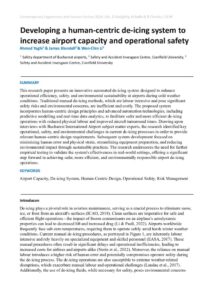
|
Author
Ahmed Yaghi & James Blundell & Wen-Chin Li |
Abstract
This research paper presents an innovative automated de-icing system designed to enhance operational efficiency, safety, and environmental sustainability at airports during cold weather conditions. Traditional manual de-icing methods, which are labour intensive and pose significant safety risks and environmental concerns, are inefficient and costly. The proposed system incorporates human-centric design principles and advanced automation technologies, including predictive modelling and real-time data analytics, to facilitate safer and more efficient de-icing operations with reduced physical labour and improved aircraft turnaround times. Drawing upon interviews with Bucharest International Airport subject matter experts, the research identified key operational, safety, and environmental challenges in current de-icing processes in order to provide relevant human-centric design requirements. Subsequent system development focused on minimizing human error and physical strain, streamlining equipment preparation, and reducing environmental impact through sustainable practices. The research underscores the need for further empirical testing to validate the system's effectiveness in real-world settings, offering a significant step forward in achieving safer, more efficient, and environmentally responsible airport de-icing operations. |
Publish Date: Apr 17, 2020 | Keywords: Automation, Contemporary EHF 2020, Energy, Publications, Systems, Tools & techniques
| Document
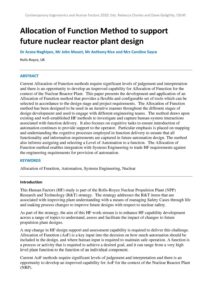
|
Author
Dr Arzoo Naghiyev, Mr John Mount, Mr Anthony Rice and Mrs Caroline Sayce |
Abstract
Current Allocation of Function methods require significant levels of judgement and interpretation and there is an opportunity to develop an improved capability for Allocation of Function for the context of the Nuclear Reactor Plant. This paper presents the development and application of an Allocation of Function method that provides a flexible and configurable set of tools which can be selected in accordance to the design stage and project requirements. The Allocation of Function method has been designed to be used in an iterative manner throughout the different stages of design development and used to engage with different engineering teams. The method draws upon existing and well-established HF methods to investigate and capture human-system interactions associated with function delivery. It also focuses on cognitive tasks to ensure introduction of automation continues to provide support to the operator. Particular emphasis is placed on mapping and understanding the cognitive processes employed in function delivery to ensure that all functionality and information requirements are captured in future automation design. The method also informs assigning and selecting a Level of Automation to a function. The Allocation of Function method enables integration with Systems Engineering to trade HF requirements against the engineering requirements for provision of automation. |
Publish Date: Apr 9, 2021 | Keywords: Contemporary EHF 2021, Healthcare, Publications, Resilience
| Document
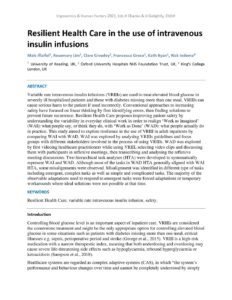
|
Author
Mais Iflaifel, Rosemary Lim, Clare Crowley, Francesca Greco, Kath Ryan, Rick Iedema |
Abstract
Variable rate intravenous insulin infusions (VRIIIs) are used to treat elevated blood glucose in severely ill hospitalised patients and those with diabetes missing more than one meal. VRIIIs can cause serious harm to the patient if used incorrectly. Conventional approaches to increasing safety have focused on linear thinking by first identifying errors, then finding solutions to prevent future recurrence. Resilient Health Care proposes improving patient safety by understanding the variability in everyday clinical work in order to realign ‘Work as Imagined’ (WAI): what people say, or think they do, with ‘Work as Done’ (WAD): what people actually do in practice. This study aimed to explore resilience in the use of VRIII in adult inpatients by comparing WAI with WAD. WAI was explored by analysing VRIIIs guidelines and focus groups with different stakeholders involved in the process of using VRIIIs. WAD was explored by first videoing healthcare practitioners while using VRIII, selecting video clips and discussing them with participants in reflexive meetings, then transcribing and analysing the reflexive meeting discussions. Two hierarchical task analyses (HTA) were developed to systematically represent WAI and WAD. Although most of the tasks in WAD HTA generally aligned with WAI HTA, some misalignments were observed. Misalignment was identified in different type of tasks including emergent, complex tasks as well as simple and complicated tasks. The majority of the observable adaptations used to respond to emergent tasks were forced adaptations or temporary workarounds where ideal solutions were not possible at that time. |
Publish Date: Jun 12, 2023 | Keywords: Contemporary EHF 2023, Human performance, Publications, Rail
| Document
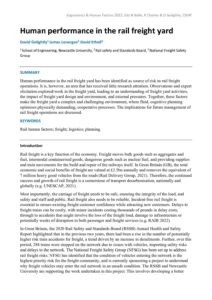
|
Author
David Golightly, James Lonergan & David Ethell |
Abstract
Human performance in the rail freight yard has been identified as source of risk to rail freight operations. It is, however, an area that has received little research attention. Observations and expert elicitation explored work in the freight yard, leading to an understanding of freight yard activities, the impact of freight yard design and environment, and external pressures. Together, these factors make the freight yard a complex and challenging environment, where fluid, cognitive planning optimises physically demanding, cooperative processes. The implications for future management of rail freight operations are discussed. |
Publish Date: Apr 17, 2020 | Keywords: Automation, Contemporary EHF 2020, Publications, Submarines
| Document
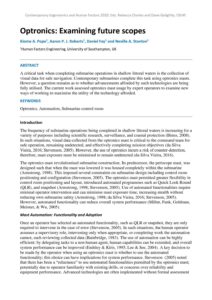
|
Author
Kiome A. Pope, Aaron P. J. Roberts, Daniel Fay and Neville A. Stanton |
Abstract
A critical task when completing submarine operations in shallow littoral waters is the collection of visual data for safe navigation. Contemporary submarines complete this task using optronics masts. However, a question remains as to whether advancements afforded by such technologies are being fully utilised. The current work assessed optronics mast usage by expert operators to examine new ways of working to maximise the utility of the technology afforded. |
Publish Date: May 30, 2024 | Keywords: Contemporary EHF 2024, Decision making, Healthcare, Publications, Systems
| Document
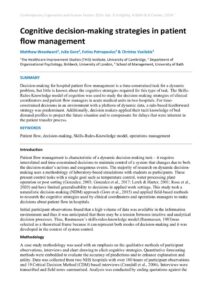
|
Author
Matthew Woodward, Julie Gore, Fotios Petropoulus & Christos Vasilakis |
Abstract
Decision-making for hospital patient flow management is a time-constrained task for a dynamic problem, but little is known about the cognitive strategies required for this type of task. The Skills�Rules-Knowledge model of cognition was used to study the decision-making strategies of clinical coordinators and patient flow managers in acute medical units in two hospitals. For time�constrained decisions in an environment with a plethora of dynamic data, a rule-based feedforward strategy was predominant. Additionally, decision makers applied their tacit knowledge of bed demand profiles to project the future situation and to compensate for delays that were inherent in the patient transfer process. |
Publish Date: Sep 7, 2019 | Keywords: Automotive, Contemporary EHF 2019, Publications
| Document
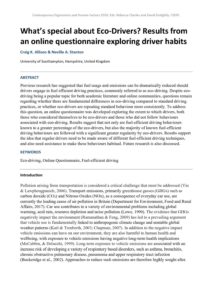
|
Author
Craig K. Allison & Neville A. Stanton |
Abstract
Previous research has suggested that fuel usage and emissions can be dramatically reduced should drivers engage in fuel efficient driving practices, commonly referred to as eco-driving. Despite eco-driving being a popular topic for both academic literature and online communities, questions remain regarding whether there are fundamental differences in eco-driving compared to standard driving practices, or whether eco-drivers are repeating standard behaviour more consistently. To address this question, an online questionnaire was developed exploring the extent to which drivers, both those who considered themselves to be eco-drivers and those who did not follow behaviours associated with eco-driving. Results suggest that not only are fuel-efficient driving behaviours known to a greater percentage of the eco-drivers, but also the majority of known fuel-efficient driving behaviours are followed with a significant greater regularity by eco-drivers. Results support the idea that regular drivers need to be made aware of different fuel-efficient driving techniques, and also need assistance to make these behaviours habitual. Future research is also discussed. |
Publish Date: Dec 18, 2018 | Keywords: Contemporary EHF 2017, Publications, Safety, Systems
| Document
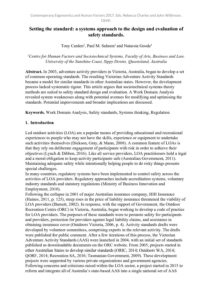
|
Author
Tony Carden, Paul M. Salmon and Natassia Goode |
Abstract
In 2003, adventure activity providers in Victoria, Australia, began to develop a set of common operating standards. The resulting Victorian Adventure Activity Standards became a model for similar standards in other Australian states. However, the development process lacked systematic rigour. This article argues that sociotechnical systems theory methods are suited to safety standard design and evaluation. A Work Domain Analysis revealed system weaknesses along with potential avenues for modifying and optimising the standards. Potential improvements and broader implications are discussed. |
Publish Date: Jun 11, 2025 | Keywords: Contemporary EHF 2025, Healthcare, Publications, Risk assessment, Teamwork, Workload
| Document
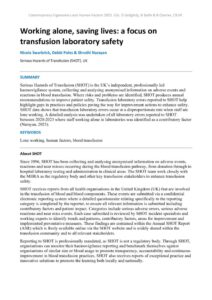
|
Author
Nicola Swarbrick, Debbi Poles & Shruthi Narayan |
Abstract
Serious Hazards of Transfusion (SHOT) is the UK’s independent, professionally led haemovigilance system, collecting and analysing anonymised information on adverse events and reactions in blood transfusion. Where risks and problems are identified, SHOT produces annual recommendations to improve patient safety. Transfusion laboratory errors reported to SHOT help highlight gaps in practices and policies paving the way for improvement actions to enhance safety. SHOT data shows that transfusion laboratory errors occur at a disproportionate rate when staff are lone working. A detailed analysis was undertaken of all laboratory errors reported to SHOT between 2020-2023 where staff working alone in laboratories was identified as a contributory factor (Narayan, 2023). |
Publish Date: Sep 8, 2019 | Keywords: Contemporary EHF 2019, Healthcare, Publications
| Document
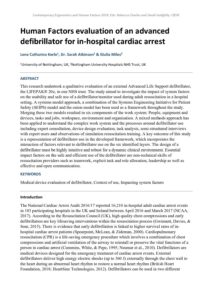
|
Author
Lena Catharina Kerle, Dr. Sarah Atkinson & Giulia Miles |
Abstract
This research undertook a qualitative evaluation of an external Advanced Life Support defibrillator, the LIFEPAK® 20e, in one NHS trust. The study aimed to investigate the impact of system factors on the usability and safe use of a defibrillator/monitor used during adult resuscitation in a hospital setting. A systems model approach, a combination of the Systems Engineering Initiative for Patient Safety (SEIPS) model and the onion model has been used as a framework throughout the study. Merging these two models resulted in six components of the work system: People, equipment and devices, tasks and jobs, workspace, environment and organisation. A mixed methods approach has been applied to understand the complex work system and the processes around defibrillator use including expert consultation, device design evaluation, task analysis, semi-structured interviews with expert users and observations of simulation resuscitation training. A key outcome of this study is a representation of defibrillator use in the developed framework, which incorporates the interaction of factors relevant to defibrillator use on the six identified layers. The design of a defibrillator must be highly intuitive and robust for a dynamic clinical environment. Essential impact factors on the safe and efficient use of the defibrillator are non-technical skills of resuscitation providers such as teamwork, explicit task and role allocation, leadership as well as effective and open communication. |
Publish Date: May 31, 2024 | Keywords: Contemporary EHF 2024, Ergonomics, Healthcare, Human factors integration, Publications
| Document
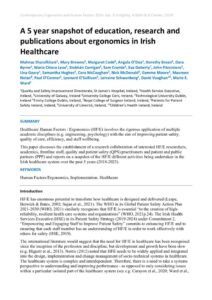
|
Author
Mahnaz Sharafkhani, Mary Browne, Margaret Codd, Angela O’Dea, Dorothy Breen, Dara Byrne, Maria Chiara Leva, Siobhán Corrigan, Sam Cromie, Eva Doherty, John Fitzsimons, Una Geary, Samantha Hughes, Cora McCaughan, Nick McDonald, Gemma Moore, Maureen Nolan, Paul O’Connor, Leonard O’Sullivan, Lorraine Schwanberg, David Vaughan, Marie E. Ward |
Abstract
Healthcare Human Factors / Ergonomics (HF/E) involves the rigorous application of multiple academic disciplines (e.g. engineering, psychology) with the aim of improving patient safety, quality of care, efficiency, and staff wellbeing. This paper discusses the establishment of a research collaboration of interested HF/E researchers, academics, frontline staff, quality and patient safety (QPS) practitioners and patient and public partners (PPP) and reports on a snapshot of the HF/E different activities being undertaken in the Irish healthcare system over the past 5 years (2018-2023). |
Publish Date: Feb 27, 2019 | Keywords: Automotive, Contemporary EHF 2016, Fatigue & sleep, Musculoskeletal, Publications, Seating
| Document
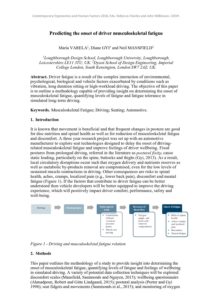
|
Author
Maria VARELA, Diane GYI and Neil MANSFIELD |
Abstract
Driver fatigue is a result of the complex interaction of environmental, psychological, biological and vehicle factors exacerbated by conditions such as vibration, long duration sitting or high-workload driving. The objective of this paper is to outline a methodology capable of providing insight on determining the onset of musculoskeletal fatigue, quantifying levels of fatigue and fatigue tolerance in simulated long-term driving. |
Publish Date: Sep 7, 2019 | Keywords: Contemporary EHF 2019, Design, Publications, Technology
| Document
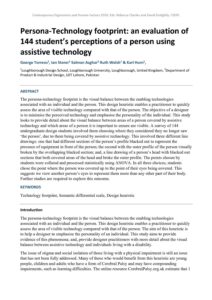
|
Author
George Torrens, Ian Storer Salman Asghar Ruth Welsh & Karl Hurn |
Abstract
The persona-technology footprint is the visual balance between the enabling technologies associated with an individual and the person. This design heuristic enables a practitioner to quickly assess the area of visible technology compared with that of the person. The objective of a designer is to minimise the perceived technology and emphasise the personality of the individual. This study looks to provide detail about the visual balance between areas of a person covered by assistive technology and which areas of a person it is important to ensure are visible. A survey of 144 undergraduate design students involved them choosing where they considered they no longer saw ‘the person’, due to them being covered by assistive technology. This involved three different line drawings: one that had different sections of the person’s profile blacked out to represent the presence of equipment in front of the person; the second with the outer profile of the person visually broken by the overlapping blacked section; and, a line drawing of a person’s head with blacked out sections that both covered areas of the head and broke the outer profile. The points chosen by students were collated and processed statistically using ANOVA. In all three choices, students chose the point where the person was covered up to the point of their eyes being covered. This suggests we view another person’s eyes to represent them more than any other part of their body. Further studies are required to explore this outcome. |
Publish Date: Jun 23, 2022 | Keywords: Contemporary EHF 2022, Defence, Publications, Systems
| Document
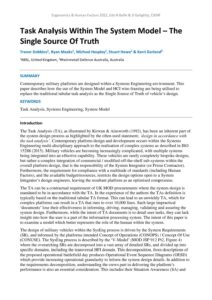
|
Author
Trevor Dobbins, Ryan Meeks, Michael Hespley, Stuart Howe & Kerri Garland |
Abstract
Contemporary military platforms are designed within a Systems Engineering environment. This paper describes how the use of the System Model and HCI wire-framing are being utilised to replace the traditional tabular task analysis as the Single Source of Truth of vehicle’s design. |
Publish Date: Jun 3, 2024 | Keywords: Contemporary EHF 2024, Decision making, Ergonomics, Human factors integration, Nuclear, Publications
| Document
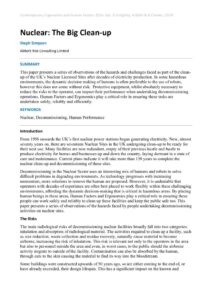
|
Author
Steph Simpson |
Abstract
This paper presents a series of observations of the hazards and challenges faced as part of the clean�up of the UK’s Nuclear Licensed Sites after decades of electricity production. In some hazardous environments, the dynamic decision making of humans is often preferable to the use of robots, however this does not come without risk. Protective equipment, whilst absolutely necessary to reduce the risks to the operator, can impact their performance when undertaking decommissioning operations. Human Factors and Ergonomics play a critical role in ensuring these tasks are undertaken safely, reliably and efficiently. |
Publish Date: Sep 7, 2019 | Keywords: Contemporary EHF 2019, Interface design, Publications, Sport & leisure, Usability
| Document
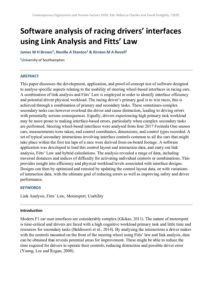
|
Author
James W H Brown, Neville A Stanton & Kirsten M A Revell |
Abstract
This paper discusses the development, application, and proof-of-concept test of software designed to analyse specific aspects relating to the usability of steering wheel-based interfaces in racing cars. A combination of link analysis and Fitts’ Law is employed in order to identify interface efficiency and potential driver physical workload. The racing driver’s primary goal is to win races, this is achieved through a combination of primary and secondary tasks. These sometimes-complex secondary tasks can however overload the driver and cause distraction, leading to driving errors with potentially serious consequences. Equally, drivers experiencing high primary task workload may be more prone to making interface-based errors, particularly when complex secondary tasks are performed. Steering wheel-based interfaces were analysed from four 2017 Formula One season cars, measurements were taken, and control coordinates, dimensions, and control types recorded. A set of typical secondary interactions involving interface controls common to all the cars that might take place within the first ten laps of a race were derived from on-board footage. A software application was developed to load this control layout and interaction data, and carry out link analysis, Fitts’ Law and hybrid calculations. The analysis revealed a range of data, including traversal distances and indices of difficulty for activating individual controls or combinations. This provides insight into efficiency and physical workload levels associated with interface designs. Designs can then by optimised and retested by updating the control layout data, or with variations of interaction data, with the ultimate goal of reducing errors as well as improving safety and driver performance. |
Publish Date: Jun 8, 2023 | Keywords: Contemporary EHF 2023, Healthcare, Publications
| Document
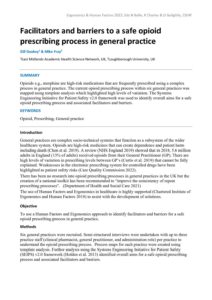
|
Author
Gill Gookey & Mike Fray |
Abstract
Opioids e.g., morphine are high-risk medications that are frequently prescribed using a complex process in general practice. The current opioid prescribing process within six general practices was mapped using template analysis which highlighted high levels of variation. The Systems Engineering Initiative for Patient Safety v2.0 framework was used to identify overall aims for a safe opioid prescribing process and associated facilitators and barriers. |
Publish Date: Aug 9, 2021 | Keywords: Comfort, Comfort Congress 2021, Publications, Transport
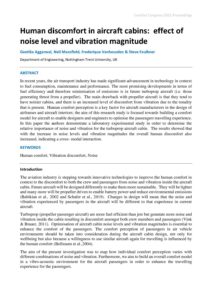 |
Author
Geetika Aggarwal, Neil Mansfield, Frederique Vanheusden & Steve Faulkner |
Abstract
In recent years, the air transport industry has made significant advancement in technology in context to fuel consumption, maintenance and performance. The most promising developments in terms of fuel efficiency and therefore minimisation of emissions is in future turboprop aircraft (i.e. those generating thrust from a propeller). The main drawback with propeller aircraft is that they tend to have noisier cabins, and there is an increased level of discomfort from vibration due to the tonality that is present. Human comfort perception is a key factor for aircraft manufacturers in the design of airframes and aircraft interiors; the aim of this research study is focused towards building a comfort model for aircraft to enable designers and engineers to optimise the passengers travelling experience. In this paper the authors demonstrate a laboratory experimental study in order to determine the relative importance of noise and vibration for the turboprop aircraft cabin. The results showed that with the increase in noise levels and vibration magnitudes the overall human discomfort also increased, indicating a cross- modal interaction. |
Publish Date: Oct 30, 2018 | Keywords: Contemporary EHF 2017, Healthcare, Patient Safety, Pharmaceutical, Publications, Task analysis
| Document
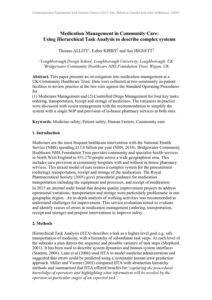
|
Author
Thomas ALLITT, Esther KIRBY and Sue HIGNETT |
Abstract
This paper presents an investigation into medication management at a UK Community Healthcare Trust. Data were collected at two community in-patient facilities to review practice at the two sites against the Standard Operating Procedures for (1) Medicines Management and (2) Controlled Drugs Management for four key tasks: ordering, transportation, receipt and storage of medicines. The variances in practice were discussed with senior management with the recommendation to simplify the system with a single SOP and provision of in-house pharmacy services at both sites. |
Publish Date: Mar 17, 2019 | Keywords: Communication, Contemporary EHF 2016, Defence, Publications, Situation awareness
| Document
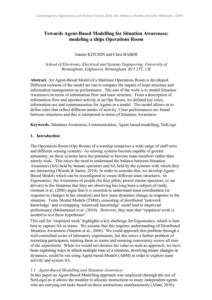
|
Author
Joanne KITCHIN and Chris BABER |
Abstract
An Agent-Based Model of a Maritime Operations Room is developed. Different versions of the model are run to compare the impact of team structure and information management on performance. The aim of the work is to model Situation Awareness in terms of information flow and team structure. From a description of information flow and operator activity in an Ops Room, we defined key roles, information use and communication for Agents in a model. The model allows us to define rules that reflect different modes of activity. Clear performances are found between structures and this is interpreted in terms of Situation Awareness. |
Publish Date: May 30, 2024 | Keywords: Contemporary EHF 2024, Pharmaceutical, Publications, Risk assessment
| Document
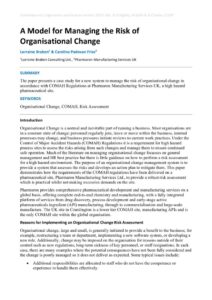
|
Author
Lorraine Braben & Carolina Padovan Frias |
Abstract
The paper presents a case study for a new system to manage the risk of organisational change in accordance with COMAH Regulations at Pharmaron Manufacturing Services UK, a high hazard pharmaceutical site. |
Publish Date: Dec 18, 2018 | Keywords: Contemporary EHF 2017, Interface design, Publications, Technology
| Document
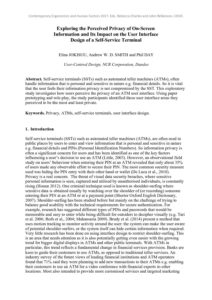
|
Author
Elina JOKISUU, Andrew W. D. SMITH and Phil DAY |
Abstract
Self-service terminals (SSTs) such as automated teller machines (ATMs), often handle information that is personal and sensitive in nature e.g. financial details. So it is vital that the user feels their information privacy is not compromised by the SST. This exploratory study investigates how users perceive the privacy of an ATM user interface. Using paper prototyping and role-play, the study participants identified those user interface areas they perceived to be the most and least private. |
Publish Date: Apr 15, 2020 | Keywords: Contemporary EHF 2020, Manufacturing, Publications, Technology
| Document
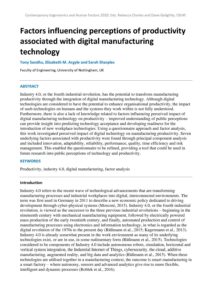
|
Author
Tony Sandhu, Elizabeth M. Argyle and Sarah Sharples |
Abstract
Industry 4.0, or the fourth industrial revolution, has the potential to transform manufacturing productivity through the integration of digital manufacturing technology. Although digital technologies are considered to have the potential to enhance organisational productivity, the impact of such technologies on humans and the systems they work within is not fully understood. Furthermore, there is also a lack of knowledge related to factors influencing perceived impact of digital manufacturing technology on productivity – improved understanding of public perceptions can provide insight into predicting technology acceptance and developing readiness for the introduction of new workplace technologies. Using a questionnaire approach and factor analysis, this work investigated perceived impact of digital technology on manufacturing productivity. Seven underlying factors associated with productivity were found through principal component analysis and included innovation, adaptability, reliability, performance, quality, time efficiency and risk management. This enabled the questionnaire to be refined, providing a tool that could be used in future research into public perceptions of technology and productivity. |
Publish Date: Jun 11, 2025 | Keywords: Contemporary EHF 2025, Psychology, Publications, Transport, User experience
| Document

|
Author
Cara Tyrrell, Katie Parnell & Katie Plant |
Abstract
The aim of this study was to understand how adults respond to public transport (PT) disruption when travelling with young children. A series of semi-structured interviews were conducted based on a hypothetical scenario of a 45-minute delay. Analysis of responses revealed distinct differences in how adults respond when travelling accompanied versus alone. Considering the findings a series of recommendations are made which will improve experience of PT when travelling with young children and potentially encourage greater use of PT networks. |
Publish Date: Apr 16, 2020 | Keywords: Contemporary EHF 2020, Interface design, Publications, Usability
| Document
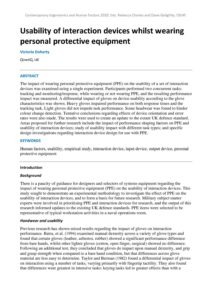
|
Author
Victoria Doherty |
Abstract
The impact of wearing personal protective equipment (PPE) on the usability of a set of interaction devices was examined using a single experiment. Participants performed two concurrent tasks: tracking and monitoring/response, while wearing or not wearing PPE, and the resulting performance impact was measured. A differential impact of gloves on device usability according to the glove characteristics was shown. Heavy gloves impaired performance on both response times and the tracking task. Light gloves did not impede task performance. Some headwear was found to hinder colour change detection. Tentative conclusions regarding effects of device orientation and error rates were also made. The results were used to create an update to the extant UK defence standard. Areas proposed for further research include the impact of performance shaping factors on PPE and usability of interaction devices; study of usability impact with different task types; and specific design investigations regarding interaction device design for use with PPE. |
Publish Date: May 23, 2025 | Keywords: Aviation, Contemporary EHF 2025, Publications, Safety
| Document
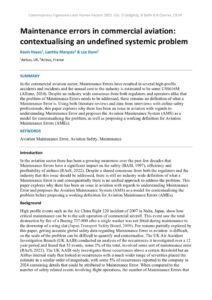
|
Author
Kevin Hayes, Laetitia Marquie & Lee Dann |
Abstract
In the commercial aviation sector, Maintenance Errors have resulted in several high-profile accidents and incidents and the annual cost to the industry is estimated to be some US$616M (Allianz, 2024). Despite an industry wide consensus from both regulators and operators alike that the problem of Maintenance Errors needs to be addressed, there remains no definition of what a Maintenance Error is. Using both literature reviews and data from interviews with airline safety professionals, this paper explores why there has been an issue in aviation with regards to understanding Maintenance Error and proposes the Aviation Maintenance System (AMS) as a model for contextualising the problem, as well as proposing a working definition for Aviation Maintenance Errors (AMEs). |
Publish Date: Jun 8, 2023 | Keywords: Contemporary EHF 2023, Non-technical skills, Publications, Rail
| Document
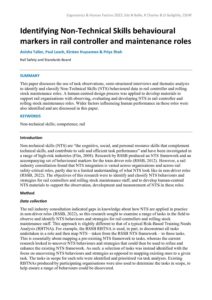
|
Author
Anisha Tailor, Paul Leach, Kirsten Huysamen & Priya Shah |
Abstract
This paper discusses the use of task observations, semi-structured interviews and thematic analysis to identify and classify Non-Technical Skills (NTS) behavioural data in rail controller and rolling stock maintenance roles. A human-centred design process was applied to develop materials to support rail organisations with observing, evaluating and developing NTS in rail controller and rolling stock maintenance roles. Wider factors influencing human performance in these roles were also identified and are discussed in this paper. |
Publish Date: Mar 26, 2019 | Keywords: Contemporary EHF 2016, Education, training & skills, Publications, Rail, Risk assessment
| Document
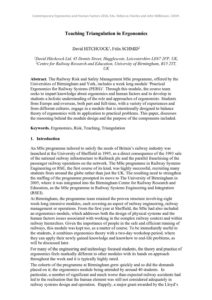
|
Author
David HITCHCOCK, Felix SCHMID |
Abstract
The Railway Risk and Safety Management MSc programme, offered by the Universities of Birmingham and York, includes a week long module ‘Practical Ergonomics for Railway Systems (PERS)’. Through this module, the course team seeks to impart knowledge about ergonomics and human factors and to develop in students a holistic understanding of the role and approaches of ergonomists. Students from Europe and overseas, both part and full-time, with a variety of experiences and from different cultures, engage in a module that is intentionally designed to balance theory of ergonomics with its application to practical problems. This paper, discusses the reasoning behind the module design and the purpose of the components included. |
Publish Date: Apr 15, 2020 | Keywords: Contemporary EHF 2020, Healthcare, Incidents, Publications, Systems, Tools & techniques
| Document
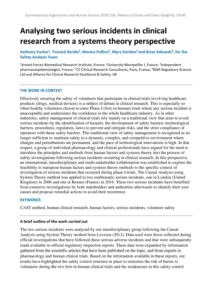
|
Author
Anthony Vacher, Yannick Bardie, Monica Pollina, Myra Daridan and Brian Edwards, for the Safety Analysis Team |
Abstract
Effectively ensuring the safety of volunteers that participate in clinical trials involving healthcare products (drugs, medical devices) is a subject of debate in clinical research. This is especially so when healthy volunteers choose to enter Phase I (first-in-human) trials where any serious incident is unacceptable and undermines the confidence in the whole healthcare industry. As in other industries, safety management of clinical trials rely mainly on a traditional view that aims to avoid serious incidents by the identification of hazards, the development of safety barriers (technological barriers, procedures, regulation, laws) to prevent and mitigate risks, and the strict compliance of operators with these safety barriers. This traditional view of safety management is recognised as no longer sufficient to maintain safety in a dynamic, complex, and competitive environment where changes and perturbations are permanent, and the pace of technological innovations is high. In that respect, a group of individual pharmacology and clinical professionals have argued for the need to introduce the principles and methods from human factors and systems theory into the process of safety investigations following serious incidents occurring in clinical research. In this perspective, an international, interdisciplinary and multi-stakeholder collaboration was established to explore the feasibility to transpose human factors and systems theory methods to the specific context of investigation of serious incidents that occurred during phase I-trials. The Causal Analysis using System Theory method was applied to two emblematic serious incidents, one in London (United Kingdom) in 2006 and one in Rennes (France) in 2016. These two serious incidents have benefited from extensive investigations by both stakeholders and authorities afterwards to identify their root-causes and propose remedial actions to avoid their recurrence. |
Publish Date: Jun 11, 2025 | Keywords: Contemporary EHF 2025, Medical Devices, Publications, Usability
| Document
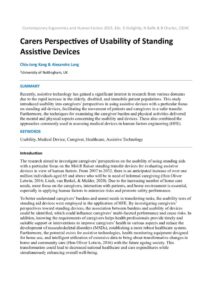
|
Author
Chia-Jung Kang & Alexandra Lang |
Abstract
Recently, assistive technology has gained a significant interest in research from various domains due to the rapid increase in the elderly, disabled, and immobile patient populations. This study introduced usability into caregivers’ perspectives in using assistive devices with a particular focus on standing aid devices, facilitating the movement of patients and caregivers in a safer transfer. Furthermore, the techniques for examining the caregiver burden and physical activities delivered the mental and physical aspects concerning the usability and devices. These also combined the approaches commonly used in assessing medical devices in human factors engineering (HFE). |
Publish Date: Sep 7, 2019 | Keywords: Aerospace, Artificial intelligence, Contemporary EHF 2019, Publications
| Document
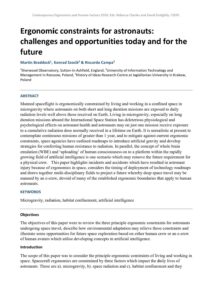
|
Author
Martin Braddock, Konrad Szocik & Riccardo Campa |
Abstract
Manned spaceflight is ergonomically constrained by living and working in a confined space in microgravity where astronauts on both short and long duration missions are exposed to daily radiation levels well above those received on Earth. Living in microgravity, especially on long duration missions aboard the International Space Station has deleterious physiological and psychological effects on astronaut health and astronauts may on just one mission receive exposure to a cumulative radiation dose normally received in a lifetime on Earth. It is unrealistic at present to contemplate continuous missions of greater than 1 year, and to mitigate against current ergonomic constraints, space agencies have outlined roadmaps to introduce artificial gravity and develop strategies for conferring human resistance to radiation. In parallel, the concept of whole brain emulation (WBE) and ‘uploading’ of human consciousness on to a platform within the rapidly growing field of artificial intelligence is one scenario which may remove the future requirement for a physical crew. This paper highlights incidents and accidents which have resulted in astronaut injury because of ergonomics in space, considers the timing of deployment of technology roadmaps and draws together multi-disciplinary fields to project a future whereby deep space travel may be manned by an e-crew, devoid of many of the established ergonomic boundaries that apply to human astronauts. |
Publish Date: Feb 27, 2019 | Keywords: Contemporary EHF 2016, Office ergonomics, Publications
| Document
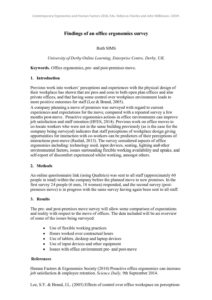
|
Author
Ruth SIMS |
Abstract
|
Publish Date: Mar 17, 2019 | Keywords: Contemporary EHF 2016, Fatigue & sleep, Publications, Workload
| Document
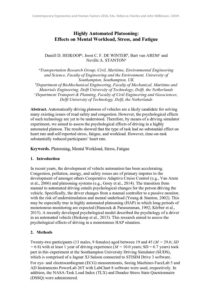
|
Author
Daniël D. HEIKOOP, Joost C. F. DE WINTER, Bart van AREM and Neville A. STANTON |
Abstract
Automatically driving platoons of vehicles are a likely candidate for solving many existing issues of road safety and congestion. However, the psychological effects of such technology are yet to be understood. Therefore, by means of a driving simulator experiment, we aimed to assess the psychological effects of driving in a highly automated platoon. The results showed that the type of task had no substantial effect on heart rate and self-reported stress, fatigue, and workload. However, time-on-task substantially reduced participants’ heart rate. |
Publish Date: Jun 8, 2023 | Keywords: Contemporary EHF 2023, Healthcare, Publications, Technology
| Document
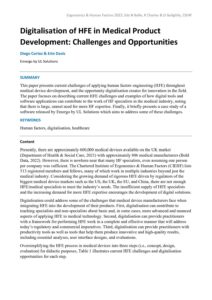
|
Author
Diego Cortez & Erin Davis |
Abstract
This paper presents current challenges of applying human factors engineering (HFE) throughout medical device development, and the opportunity digitalisation creates for innovation in the field. The paper focuses on describing current HFE challenges and examples of how digital tools and software applications can contribute to the work of HF specialists in the medical industry, noting that there is large, unmet need for more HF expertise. Finally, it briefly presents a case study of a software released by Emergo by UL Solutions which aims to address some of these challenges. |
Publish Date: Apr 9, 2020 | Keywords: Contemporary EHF 2020, Publications
| Document
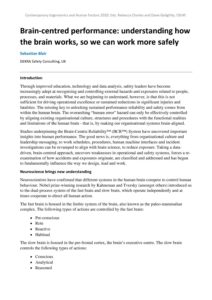
|
Author
Sebastian Blair |
Abstract
Through improved education, technology and data analysis, safety leaders have become increasingly adept at recognising and controlling external hazards and exposures related to people, processes, and materials. What we are beginning to understand, however, is that this is not sufficient for driving operational excellence or sustained reductions in significant injuries and fatalities. The missing key to unlocking sustained performance reliability and safety comes from within the human brain. The overarching “human error” hazard can only be effectively controlled by aligning existing organisational culture, structures and procedures with the functional realities and limitations of the human brain - that is, by making our organisational systems brain-aligned. Studies underpinning the Brain-Centric Reliability™ (BCR™) System have uncovered important insights into human performance. The good news is, everything from organisational culture and leadership messaging, to work schedules, procedures, human machine interfaces and incident investigations can be revamped to align with brain science, to reduce exposure. Taking a data-driven, brain-centred approach, uncovers weaknesses in operational and safety systems, forces a re-examination of how accidents and exposures originate, are classified and addressed and has begun to fundamentally influence the way we design, lead and work. |
Publish Date: Dec 18, 2018 | Keywords: Automation, Automotive, Contemporary EHF 2017, Publications, User experience
| Document
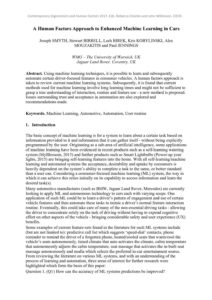
|
Author
Joseph SMYTH, Stewart BIRRELL, Lech BIREK, Kris KOBYLINSKI, Alex MOUZAKITIS and Paul JENNINGS |
Abstract
Using machine learning techniques, it is possible to learn and subsequently automate certain driver-focused features in consumer vehicles. A human factors approach is taken to review current machine learning systems. Subsequently, it is found that current methods used for machine learning involve long learning times and might not be sufficient to grasp a true understanding of interaction, routine and feature use - a new method is proposed. Issues surrounding trust and acceptance in automation are also explored and recommendations made. |
Publish Date: Apr 16, 2020 | Keywords: Contemporary EHF 2020, Mental health & wellbeing, Publications, Systems
| Document
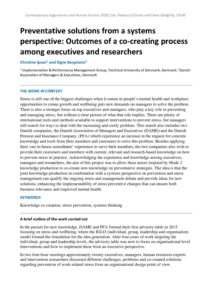
|
Author
Christine Ipsen and Signe Bergmann |
Abstract
Stress is still one of the biggest challenges when it comes to people’s mental health and workplace opportunities to create growth and wellbeing puts new demands on managers to solve the problem. There is also a stronger focus on top executives and managers, who play a key role in preventing and managing stress, but without a clear picture of what that role implies. There are plenty of international tools and methods available to support interventions to prevent stress, but managers still search for ways to deal with the increasing and costly problem. This search also includes two Danish companies, the Danish Association of Managers and Executives (DAME) and the Danish Pension and Insurance Company, (PFA) which experience an increase in the request for concrete knowledge and tools from their members and customers to solve this problem. Besides applying their vast in-house consultants’ experience to serve their members, the two companies also wish to provide their customers and members with current, relevant and research-based knowledge on how to prevent stress in practice. Acknowledging the experience and knowledge among executives, managers and researchers, the aim of this project was to allow these actors inspired by Mode 2 knowledge production to co-create new knowledge on preventative strategies. The idea is that the joint knowledge production in combination with a systems perspective on prevention and stress management can qualify the ongoing stress and management debate and provide ideas for new solutions, enhancing the implementability of stress preventive changes that can ensure both business relevance and improved mental health. |
Publish Date: Jun 3, 2024 | Keywords: Aviation, Contemporary EHF 2024, Human factors integration, Incidents, Publications, Safety, Safety culture
| Document
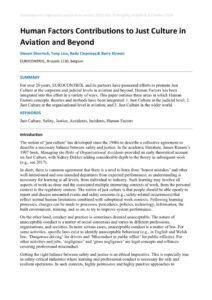
|
Author
Steven Shorrock, Tony Licu, Radu Cioponea & Barry Kirwan |
Abstract
For over 20 years, EUROCONTROL and its partners have pioneered efforts to promote Just Culture at the corporate and judicial levels in aviation and beyond. Human Factors has been integrated into this effort in a variety of ways. This paper outlines three areas in which Human Factors concepts, theories and methods have been integrated: 1. Just Culture at the judicial level; 2. Just Culture at the organisational level in aviation; and 3. Just Culture in the wider world. |
Publish Date: Mar 24, 2019 | Keywords: Contemporary EHF 2016, Emergency services, Healthcare, Mental health & wellbeing, Publications
| Document
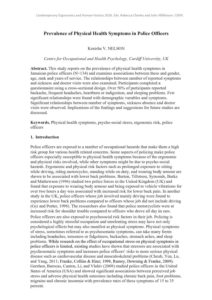
|
Author
Kenisha V. NELSON |
Abstract
This study reports on the prevalence of physical health symptoms in Jamaican police officers (N=134) and examines associations between these and gender, age, rank and years of service. The relationships between number of reported symptoms and sickness and doctor visits were also examined. Participants completed a questionnaire using a cross-sectional design. Over 50% of participants reported backache, frequent headaches, heartburn or indigestion, and sleeping problems. Few significant relationships were found with demographic variables and symptoms. Significant relationships between number of symptoms, sickness absence and doctor visits were observed. Implications of the findings and suggestions for future studies are discussed. |
Publish Date: Jun 3, 2024 | Keywords: Contemporary EHF 2024, Incidents, Investigation, Publications, Rail
| Document
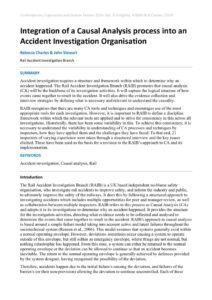
|
Author
Rebecca Charles & John Stewart |
Abstract
Accident investigation requires a structure and framework within which to determine why an accident happened. The Rail Accident Investigation Branch (RAIB) promotes that causal analysis (CA) will be the backbone of its investigation activities. It will capture the logical structure of how events came together to result in the accident. It will also drive the evidence collection and interview strategies by defining what is necessary and relevant to understand the causality. RAIB recognises that there are many CA tools and techniques and encourages use of the most appropriate tools for each investigation. However, it is important to RAIB to define a discipline framework within which the relevant tools are applied and to strive for consistency in this across all investigations. Historically, there has been some variability in this. To achieve this consistency, it is necessary to understand the variability in understanding of CA processes and techniques by inspectors, how they have applied them and the challenges they have faced. To that end, 21 inspectors of varying experience were taken through a structured interview and the key issues elicited. These have been used as the basis for a revision to the RAIB’s approach to CA and its implementation. |
Publish Date: Apr 15, 2020 | Keywords: Accessibility, Contemporary EHF 2020, Interface design, Publications, Technology
| Document
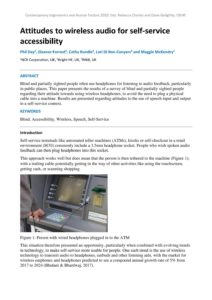
|
Author
Phil Day, Eleanor Forrest, Cathy Rundle, Lori Di Bon-Conyers and Maggie McKendry |
Abstract
Blind and partially sighted people often use headphones for listening to audio feedback, particularly in public places. This paper presents the results of a survey of blind and partially sighted people regarding their attitude towards using wireless headphones, to avoid the need to plug a physical cable into a machine. Results are presented regarding attitudes to the use of speech input and output in a self-service context. |
Publish Date: May 31, 2024 | Keywords: Cognition, Contemporary EHF 2024, Incidents, Manufacturing, Publications
| Document
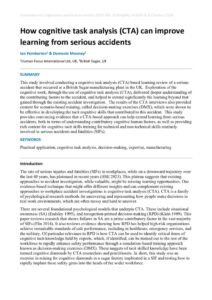
|
Author
Ian Pemberton & Domonic Mooney |
Abstract
This study involved conducting a cognitive task analysis (CTA) based learning review of a serious accident that occurred at a British Sugar manufacturing plant in the UK. Exploration of the cognitive work, through the use of cognitive task analysis (CTA), delivered deeper understanding of the contributing factors to the accident, and helped to extend significantly the learning beyond that gained through the existing accident investigation. The results of the CTA interviews also provided content for scenario-based training, called decision-making exercises (DMX), which were shown to be effective in developing the tacit cognitive skills that contributed to this accident. This study provides convincing evidence that a CTA-based approach can help extend learning from serious accidents, both in terms of understanding contributory cognitive human factors, as well as providing rich content for cognitive tacit skills training for technical and non-technical skills routinely involved in serious accidents and fatalities (SIFs). |
Publish Date: Jun 8, 2023 | Keywords: Contemporary EHF 2023, Publications, Virtual reality, Workload
| Document
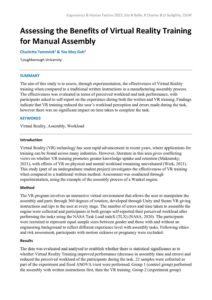
|
Author
Charlotte Temmink & Yee Mey Goh |
Abstract
The aim of this study is to assess, through experimentation, the effectiveness of Virtual Reality training when compared to a traditional written instructions in a manufacturing assembly process. The effectiveness was evaluated in terms of perceived workload and task performance, with participants asked to self-report on the experience during both the written and VR training. Findings indicate that VR training reduced the user’s workload perception and errors made during the task, however there was no significant impact on time taken to complete the task. |
Publish Date: Jun 12, 2023 | Keywords: Contemporary EHF 2023, Investigation, Publications, Risk assessment
| Document
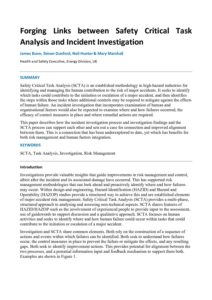
|
Author
James Bunn, Simon Dunford, Neil Hunter & Mary Marshall |
Abstract
Safety Critical Task Analysis (SCTA) is an established methodology in high-hazard industries for identifying and managing the human contribution to the risk of major accidents. It seeks to identify which tasks could contribute to the initiation or escalation of a major accident, and then identifies the steps within those tasks where additional controls may be required to mitigate against the effects of human failure. An incident investigation that incorporates examination of human and organisational factors would also be expected to examine where and how failures occurred, the efficacy of control measures in place and where remedial actions are required. This paper describes how the incident investigation process and investigation findings and the SCTA process can support each other and sets out a case for connection and improved alignment between them. This is a connection that has been underexplored to date, yet which has benefits for both risk management and human factors integration. |
Publish Date: Jun 23, 2022 | Keywords: Autonomous systems, Complex systems, Contemporary EHF 2022, Defence, Psychology, Publications
| Document
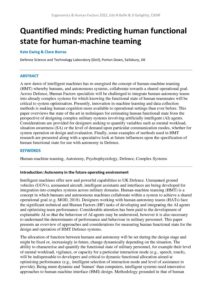
|
Author
Kate Ewing & Clare Borras |
Abstract
A new dawn of intelligent machines has re-energised the concept of human-machine teaming (HMT) whereby humans, and autonomous systems, collaborate towards a shared operational goal. Across Defence, Human Factors specialists will be challenged to integrate human-autonomy teams into already complex systems for which knowing the functional state of human teammates will be critical to system optimisation. Presently, innovation in machine learning and data collection methods is making human cognition more available to operational settings than ever before. This paper overviews the state of the art in techniques for estimating human functional state from the perspective of designing complex military systems involving artificially intelligent (AI) agents. Considerations are provided for designers seeking to quantify variables such as mental workload, situation awareness (SA) or the level of demand upon particular communication modes, whether for system operation or design and evaluation. Finally, some examples of methods used in HMT research are presented along with a speculative look at future influences upon the specification of human functional state for use with autonomy in Defence. |
Publish Date: May 23, 2025 | Keywords: Contemporary EHF 2025, Design, Publications, Transport
| Document
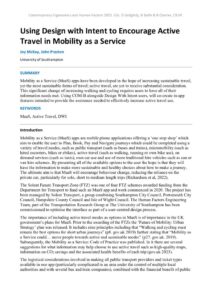
|
Author
Joy McKay & John Preston |
Abstract
Mobility as a Service (MaaS) apps have been developed in the hope of increasing sustainable travel, yet the most sustainable forms of travel; active travel, are yet to receive substantial consideration. This significant change of increasing walking and cycling requires users to have all of their information needs met. Using COM-B alongside Design With Intent users, will co-create in-app features intended to provide the assistance needed to effectively increase active travel use. |
Publish Date: Apr 8, 2021 | Keywords: Contemporary EHF 2021, Human-machine interaction, Interface design, Publications, Sport & leisure
| Document
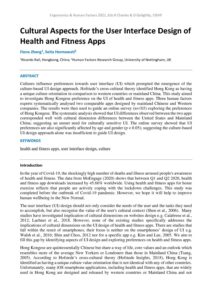
|
Author
Fiona Zheng and Setia Hermawati |
Abstract
Cultures influence preferences towards user interface (UI) which prompted the emergence of the culture-based UI design approach. Hofstede’s cross-cultural theory identified Hong Kong as having a unique culture orientation in comparison to western countries or mainland China. This study aimed to investigate Hong Kongese preference on the UI of health and fitness apps. Three human factors experts systematically analysed two comparable apps designed by mainland Chinese and Western companies. The results were then used to guide an online survey (n=103) exploring the preferences of Hong Kongese. The systematic analysis showed that UI differences observed between the two apps corresponded well with cultural dimension differences between the United States and Mainland China; suggesting an unmet need for culturally sensitive UI. The online survey showed that UI preferences are also significantly affected by age and gender (p < 0.05); suggesting the culture-based UI design approach alone was insufficient to guide UI design. |
Publish Date: Aug 9, 2021 | Keywords: Aviation, Comfort, Comfort Congress 2021, Publications, Seating
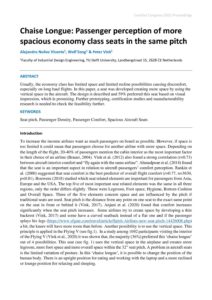 |
Author
Alejandro Nuñez Vicente, Wolf Song & Peter Vink |
Abstract
Usually, the economy class has limited space and limited recline possibilities causing discomfort, especially on long haul flights. In this paper, a seat was developed creating more space by using the vertical space in the aircraft. The design is described and 59% preferred this seat based on visual impression, which is promising. Further prototyping, certification studies and manufacturability research is needed to check the feasibility further. |
Publish Date: Jun 5, 2024 | Keywords: Artificial intelligence, Contemporary EHF 2024, Publications, Sociotechnical systems
| Document
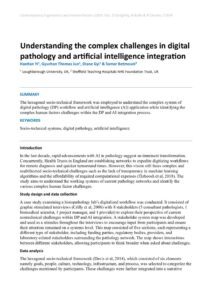
|
Author
Haotian Yi, Gyuchan Thomas Jun, Diane Gyi & Samar Betmouni |
Abstract
The hexagonal socio-technical framework was employed to understand the complex system of digital pathology (DP) workflow and artificial intelligence (AI) application while identifying the complex human factors challenges within the DP and AI integration process. |
Publish Date: Jun 3, 2024 | Keywords: Contemporary EHF 2024, Human factors integration, Patient Safety, Publications, Technology, Usability
| Document
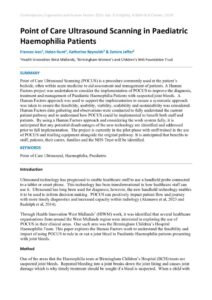
|
Author
Frances Ives, Helen Hunt, Katherine Reynolds & Zamira Jaffer |
Abstract
Point of Care Ultrasound Scanning (POCUS) is a procedure commonly used at the patient’s bedside, often within acute medicine to aid assessment and management of patients. A Human Factors project was undertaken to consider the implementation of POCUS to improve the diagnosis, treatment and management of Paediatric Haemophilia Patients with suspected joint bleeds. A Human Factors approach was used to support the implementation to ensure a systematic approach was taken to ensure the feasibility, usability, viability, scalability and sustainability was considered. Human Factors data gathering and observations were conducted to fully understand the current patient pathway and to understand how POCUS could be implemented to benefit both staff and patients. By using a Human Factors approach and considering the work system fully, it is anticipated that any potential disadvantages of the new technology are identified and addressed prior to full implementation. The project is currently in the pilot phase with staff trained in the use of POCUS and trialling equipment alongside the original pathway. It is anticipated that benefits to staff, patients, their carers, families and the NHS Trust will be identified. |
Publish Date: Jun 8, 2023 | Keywords: Contemporary EHF 2023, Incidents, Investigation, Publications, Systems
| Document
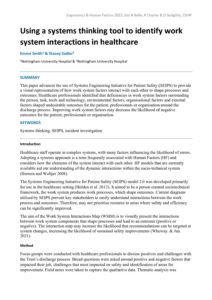
|
Author
Emma Smith & Stacey Sadler |
Abstract
This paper advances the use of Systems Engineering Initiative for Patient Safety (SEIPS) to provide a visual representation of how work system factors interact with each other to shape processes and outcomes. Healthcare professionals identified that deficiencies in work system factors surrounding the person, task, tools and technology, environmental factors, organisational factors and external factors shaped undesirable outcomes for the patient, professionals or organisation around the discharge process. Improving work system factors may decrease the likelihood of negative outcomes for the patient, professionals or organisation. |
Publish Date: May 30, 2024 | Keywords: Aviation, Contemporary EHF 2024, Publications, Safety, Simulation
| Document
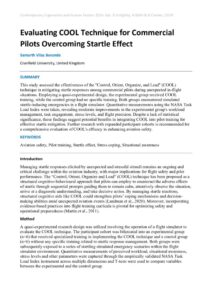
|
Author
Samarth Vilas Burande |
Abstract
This study assessed the effectiveness of the "Control, Orient, Organize, and Lead" (COOL) technique in mitigating startle responses among commercial pilots during unexpected in-flight situations. Employing a quasi-experimental design, the experimental group received COOL training, while the control group had no specific training. Both groups encountered simulated startle-inducing emergencies in a flight simulator. Quantitative measurements using the NASA Task Load Index were taken, revealing moderate improvements in the experimental group's workload management, task engagement, stress levels, and flight precision. Despite a lack of statistical significance, these findings suggest potential benefits in integrating COOL into pilot training for effective startle mitigation. Further research with expanded participant cohorts is recommended for a comprehensive evaluation of COOL's efficacy in enhancing aviation safety. |
Publish Date: May 23, 2025 | Keywords: Aviation, Contemporary EHF 2025, Publications, Safety, Systems
| Document
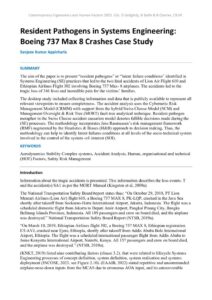
|
Author
Sanjeev Kumar Appicharla |
Abstract
The aim of the paper is to present “resident pathogens” or “latent failure conditions” identified in Systems Engineering (SE) practices that led to the two fatal accidents of Lion Air Flight 610 and Ethiopian Airlines Flight 302 involving Boeing 737 Max- 8 airplanes. The accidents led to the tragic loss of 346 lives and incredible pain for the victims’ families. The desktop study included collecting information and data that is publicly available to represent all relevant viewpoints to ensure completeness. The accident analysis uses the Cybernetic Risk Management Model (CRMM) with support from the hybrid Swiss Cheese Model (SCM) and Management Oversight & Risk Tree (MORT) fault tree analytical technique. Resident pathogen metaphor in the Swiss Cheese accident causation model denotes fallible decisions made during the (SE) processes. The methodology incorporates Jens Rasmussen’s risk management framework (RMF) augmented by the Heuristics & Biases (H&B) approach to decision making, Thus, the methodology can help to identify latent failures conditions at all levels of the socio-technical system involved in the control of the system -of- interest (SOI). |
Publish Date: Apr 9, 2021 | Keywords: Contemporary EHF 2021, Decision making, Publications
| Document
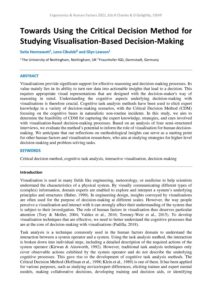
|
Author
Setia Hermawati, Lena Cibulski and Glyn Lawson |
Abstract
Visualisations provide significant support for effective reasoning and decision-making processes. Its value mainly lies in its ability to turn raw data into actionable insights that lead to a decision. This requires appropriate visual representations that are designed with the decision-maker's way of reasoning in mind. Understanding the cognitive aspects underlying decision-making with visualisations is therefore crucial. Cognitive task analysis methods have been used to elicit expert knowledge in a variety of decision-making scenarios, with the Critical Decision Method (CDM) focusing on the cognitive bases in naturalistic non-routine incidents. In this study, we aim to determine the feasibility of CDM for capturing the expert knowledge, strategies, and cues involved with visualisation-based decision-making processes. Based on an analysis of four semi-structured interviews, we evaluate the method’s potential to inform the role of visualisation for human decision-making. We anticipate that our reflections on methodological insights can serve as a starting point for other human factors and visualisation researchers, who aim at studying strategies for higher-level decision-making and problem-solving tasks. |
Publish Date: Jun 3, 2024 | Keywords: Contemporary EHF 2024, Design, Publications, Rail, Usability
| Document
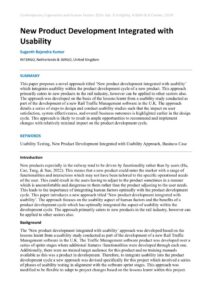
|
Author
Suganth Rajendra Kumar |
Abstract
This paper proposes a novel approach titled ‘New product development integrated with usability’ which integrates usability within the product development cycle of a new product. This approach primarily caters to new products in the rail industry, however can be applied to other sectors also. The approach was developed on the basis of the lessons learnt from a usability study conducted as part of the development of a new Rail Traffic Management software in the U.K. The approach details a series of steps to design and conduct usability studies such that the impact on user satisfaction, system effectiveness, and overall business outcomes is highlighted earlier in the design cycle. This approach is likely to result in ample opportunities to recommend and implement changes with relatively minimal impact on the product development cycle. |
Publish Date: Oct 23, 2018 | Keywords: Aviation, Contemporary EHF 2018, Publications, Usability
| Document
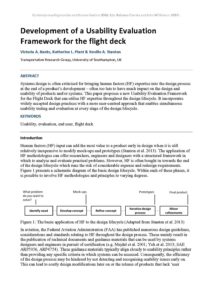
|
Author
Victoria A. Banks, Katherine L. Plant & Neville A. Stanton |
Abstract
Systems design is often criticised for bringing human factors (HF) expertise into the design process at the end of a product’s development – often too late to have much impact on the design and usability of products and/or systems. This paper proposes a new Usability Evaluation Framework for the Flight Deck that can utilise HF expertise throughout the design lifecycle. It incorporates widely accepted design practices with a more user-centred approach that enables simultaneous usability testing and evaluation at every stage of the design lifecycle. |
Publish Date: May 30, 2024 | Keywords: Contemporary EHF 2024, Investigation, Linguistics, Publications
| Document
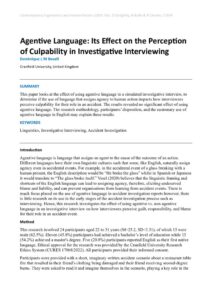
|
Author
Dominique L M Bovell |
Abstract
This paper looks at the effect of using agentive language in a simulated investigative interview, to determine if the use of language that assigns agency to human action impacts how interviewees perceive culpability for their role in an accident. The results revealed no significant effect of using agentive language. The research methodology, participants’ disposition, and the customary use of agentive language in English may explain these results. |
Publish Date: Apr 16, 2020 | Keywords: Contemporary EHF 2020, Decision making, Defence, Publications
| Document
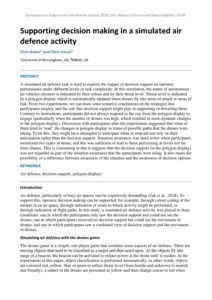
|
Author
Chris Baber and Chris Vance |
Abstract
A simulated air defence task is used to explore the impact of decision support on operator performance under different levels of task complexity. In this simulation, the status of autonomous air vehicles (drones) is indicated by their colour and by their threat level. Threat level is indicated by a polygon display which is automatically updated when drones fly into areas of attack or areas of risk. From two experiments, we can draw some tentative conclusions on the strategies that participants employ and the role that decision support might play in supporting or thwarting these. Contrary to instructions, participants did not always respond to the cue from the polygon display to engage (particularly when the number of drones was high, which resulted in more dynamic changes to the polygon display). Discussion with participants after the experiments suggested that some of them tried to ‘read’ the changes in polygon display in terms of possible paths that the drones were taking. From this, they might have attempted to anticipate when to respond and rely on their anticipation rather than the decision support. Situation awareness was rated lower when participants monitored two types of drone, and this was sufficient to lead to them performing at levels not far from chance. This is concerning in that it suggests that the decision support (in the polygon display) was not regarded as part of the situation awareness that the participants were using. It also raises the possibility of a difference between awareness of the situation and the awareness of decision options. |
Publish Date: Jun 12, 2023 | Keywords: Behaviour, Contemporary EHF 2023, Publications, Safety culture, Veterinary
| Document
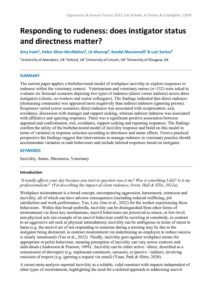
|
Author
Amy Irwin, Helen Silver-MacMahon, Liz Mossop, Kendyl Macconnell & Luiz Santos |
Abstract
The current paper applies a biobehavioural model of workplace incivility to explore responses to rudeness within the veterinary context. Veterinarians and veterinary nurses (n=132) were asked to evaluate six fictional scenarios depicting two types of rudeness (direct versus indirect) across three instigators (clients, co-workers and senior colleagues). The findings indicated that direct rudeness (demeaning comments) was appraised more negatively than indirect rudeness (ignoring person). Responses varied across scenarios; direct rudeness was associated with reciprocation, exit, avoidance, discussion with manager and support seeking, whereas indirect rudeness was associated with affiliative and ignoring responses. There was a significant positive association between appraisal and confrontation, exit, avoidance, support seeking and reporting responses. The findings confirm the utility of the biobehavioural model of incivility response and build on this model in terms of variation in response selection according to directness and status effects. From a practical perspective the findings suggest that interventions to manage rudeness in veterinary practice should accommodate variation in rude behaviours and include tailored responses based on instigator. |
Publish Date: Sep 8, 2019 | Keywords: Contemporary EHF 2019, Data, Publications, Risk assessment, Systems
| Document
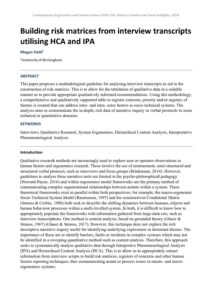
|
Author
Megan Field |
Abstract
This paper proposes a methodological guideline for analysing interview transcripts to aid in the construction of risk matrices. This is to allow for the tabulation of qualitative data in a suitable manner as to provide appropriate qualitatively informed recommendations. Using this methodology, a comprehensive and qualitatively supported table to register concerns, priority and/or urgency of themes is created that can address inter- and intra- actor factors in socio-technical systems. The analysis aims to communicate the in-depth, rich data of narrative inquiry in verbal protocols to more technical or quantitative domains. |
Publish Date: Mar 24, 2019 | Keywords: Automation, Automotive, Autonomous vehicles, Cognition, Contemporary EHF 2016, Publications
| Document
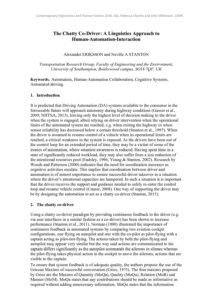
|
Author
Alexander ERIKSSON and Neville A STANTON |
Abstract
|
Publish Date: Jun 23, 2022 | Keywords: Comfort, Contemporary EHF 2022, Healthcare, Publications
| Document
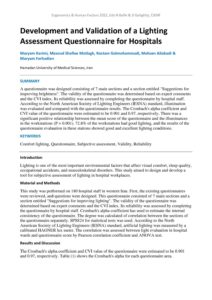
|
Author
Maryam Karimi, Masoud Shafiee Motlagh, Rostam Golmohammadi, Mohsen Aliabadi & Maryam Farhadian |
Abstract
A questionnaire was designed consisting of 7 main sections and a section entitled "Suggestions for improving brightness". The validity of the questionnaire was determined based on expert comments and the CVI index. Its reliability was assessed by completing the questionnaire by hospital staff. According to the North American Society of Lighting Engineers (IESNA) standard, illumination was evaluated and compared with the questionnaire results. The Cronbach's alpha coefficient and CVI value of the questionnaire were estimated to be 0.901 and 0.97, respectively. There was a significant positive relationship between the mean score of the questionnaire and the illuminances in the workstations (P = 0.001). 72.8% of the workstations had good lighting, and the results of the questionnaire evaluation in these stations showed good and excellent lighting conditions. |
Publish Date: May 23, 2025 | Keywords: Construction, Contemporary EHF 2025, Publications, Safety
| Document
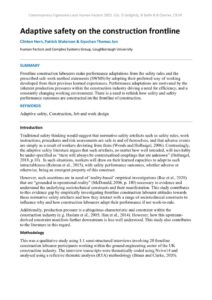
|
Author
Clinton Horn, Patrick Waterson & Gyuchan Thomas Jun |
Abstract
Frontline construction labourers make performance adaptations from the safety rules and the prescribed safe work method statements (SWMS) by adopting their preferred way of working developed from their previous learned experiences. Performance adaptations are motivated by the inherent production pressures within the construction industry driving a need for efficiency, and a constantly changing working environment. There is a need to rethink how safety and safety performance outcomes are constructed on the frontline of construction. |
Publish Date: Dec 18, 2018 | Keywords: Automation, Contemporary EHF 2017, Publications, Rail
| Document
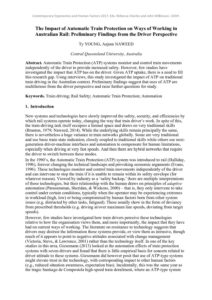
|
Author
Ty YOUNG, Anjum NAWEED |
Abstract
Automatic Train Protection (ATP) systems monitor and control train movements independently of the driver to provide increased safety. However, few studies have investigated the impact that ATP has on the driver. Given ATP uptake, there is a need to fill this research gap. Using interviews, this study investigated the impact of ATP on traditional train driving in the Australian context. Preliminary findings suggest that uses of ATP are multifarious from the driver perspective and raise further questions for study. |
Publish Date: Oct 23, 2018 | Keywords: Autonomous vehicles, Contemporary EHF 2018, Publications
| Document
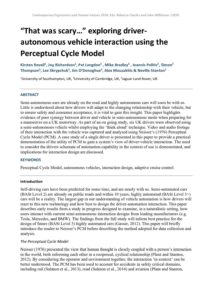
|
Author
Kirsten Revell, Joy Richardson, Pat Langdon, Mike Bradley , Ioannis Politis, Simon Thompson, Lee Skrypchuk, Jim O’Donoghue, Alex Mouzakitis & Neville Stanton |
Abstract
Semi-autonomous cars are already on the road and highly autonomous cars will soon be with us. Little is understood about how drivers will adapt to the changing relationship with their vehicle, but to ensure safety and consumer acceptance, it is vital to gain this insight. This paper highlights evidence of poor synergy between driver and vehicle in semi-autonomous mode when preparing for a manoeuvre on a UK motorway. As part of an on going study, six UK drivers were observed using a semi-autonomous vehicle whilst employing the ‘think aloud’ technique. Video and audio footage of their interaction with the vehicle was captured and analysed using Neisser’s (1976) Perceptual Cycle Model (PCM). A case study of a single driver is presented in this paper to provide a practical demonstration of the utility of PCM to gain a system’s view of driver-vehicle interaction. The need to consider the drivers schemata of automation capability in the context of use is demonstrated, and implications for interaction design are discussed. |
Publish Date: Jun 8, 2023 | Keywords: Contemporary EHF 2023, Education, training & skills, Publications, User experience, Virtual reality
| Document
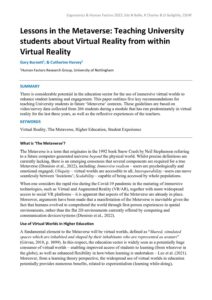
|
Author
Gary Burnett & Catherine Harvey |
Abstract
There is considerable potential in the education sector for the use of immersive virtual worlds to enhance student learning and engagement. This paper outlines five key recommendations for teaching University students in future ‘Metaverse’ contexts. These guidelines are based on video/survey data collected from 266 students during a module that has run predominately in virtual reality for the last three years, as well as the reflective experiences of the teachers. |
Publish Date: Jun 11, 2025 | Keywords: Contemporary EHF 2025, Pharmaceutical, Publications, Tools & techniques
| Document
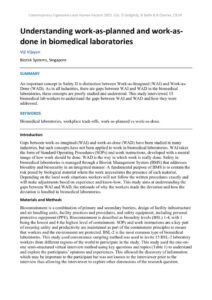
|
Author
Viji Vijayan |
Abstract
An important concept in Safety II is distinction between Work-as-Imagined (WAI) and Work-as-Done (WAD). As in all industries, there are gaps between WAI and WAD in the biomedical laboratories, these concepts are poorly studied and understood. This study interviewed 15 biomedical lab workers to understand the gaps between WAI and WAD and how they were addressed. |
Publish Date: Aug 10, 2021 | Keywords: Aviation, Comfort Congress 2021, Design, Publications
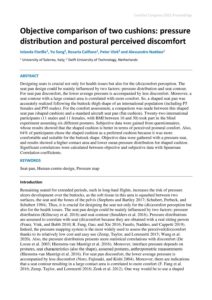 |
Author
Iolanda Fiorillo, Yu Song, Rosaria Califano, Peter Vink & Alessandro Naddeo |
Abstract
Designing seats is crucial not only for health issues but also for the (dis)comfort perception. The seat pan design could be mainly influenced by two factors: pressure distribution and seat contour. For seat pan discomfort, the lower average pressure is accompanied by less discomfort. Moreover, a seat contour with a large contact area is correlated with more comfort. So, a shaped seat pan was accurately realized following the buttock-thigh shape of an international population (including P5 females and P95 males). For the comfort assessment, a comparison was made between this shaped seat pan (shaped cushion) and a standard aircraft seat pan (flat cushion). Twenty-two international participants (11 males and 11 females, with BMI between 16 and 30) took part in the blind experiment assuming six different postures. Subjective data were gained from questionnaires, whose results showed that the shaped cushion is better in terms of perceived postural comfort. Also, 64% of participants chose the shaped cushion as a preferred cushion because it was more comfortable and suitable for the buttock shape. Objective data were gathered with a pressure mat, and results showed a higher contact area and lower mean pressure distribution for shaped cushion. Significant correlations were calculated between objective and subjective data with Spearman Correlation coefficients. |
Publish Date: Jun 23, 2022 | Keywords: Contemporary EHF 2022, Healthcare, Publications, Safety
| Document
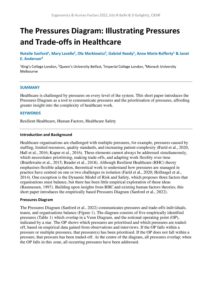
|
Author
Natalie Sanford, Mary Lavelle, Ola Markiewicz, Gabriel Reedy, Anne Marie Rafferty & Janet E. Anderson |
Abstract
Healthcare is challenged by pressures on every level of the system. This short paper introduces the Pressures Diagram as a tool to communicate pressures and the prioritisation of pressures, affording greater insight into the complexity of healthcare work. |
Publish Date: Dec 18, 2018 | Keywords: Contemporary EHF 2017, Defence, Publications
| Document
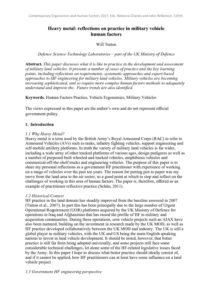
|
Author
Will Tutton |
Abstract
This paper discusses what it is like to practice in the development and assessment of military land vehicles. It presents a number of cases of practice and the key learning points, including reflections on requirements, systematic approaches and expert-based approaches to HF engineering for military land vehicles. Military vehicles are becoming increasing sophisticated, and so require more complex human factors methods to adequately understand and improve the. Future trends are also identified. |
Publish Date: Aug 12, 2021 | Keywords: Automotive, Comfort, Comfort Congress 2021, Fatigue & sleep, Publications
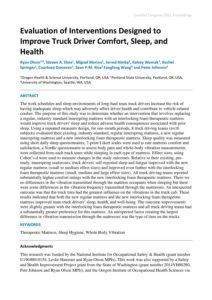 |
Author
Ryan Olson, Steven A. Shea, Miguel Marino, Jarred Rimby, Kelsey Womak, Rachel Springer, Courtney Donovan, Sean P.M. Rice Fangfang Wang & Peter Johnson |
Abstract
The work schedules and sleep environments of long-haul team truck drivers increase the risk of having inadequate sleep which may adversely affect driver health and contribute to vehicle-related crashes. The purpose of this study was to determine whether an intervention that involves replacing a regular, industry-standard innerspring mattress with an interlocking foam therapeutic mattress would improve truck drivers' sleep and reduce adverse health consequences associated with poor sleep. Using a repeated measures design, for one-month periods, 8 truck driving teams (n=16 subjects) evaluated their existing, industry-standard, regular innerspring mattress, a new regular innerspring mattress and a new interlocking foam therapeutic mattress. Sleep quality was measured using short daily sleep questionnaires, 7-point Likert scales were used to rate mattress comfort and satisfaction, a Nordic questionnaire to assess body pain and whole-body vibration measurements were collected from each truck team while sleeping in each type of mattress. Effect sizes, using Cohen’s-d were used to measure changes in the study outcomes. Relative to their existing, pre-study, innerspring mattresses, truck drivers' self-reported sleep and fatigue improved with the new regular mattress (small to medium effect sizes) and improved even further with the interlocking foam therapeutic mattress (small, medium and large effect sizes). All truck driving teams reported substantially higher comfort ratings with the new interlocking foam therapeutic mattress. There we no differences in the vibration transmitted through the mattress occupants when sleeping but there were some differences in the vibration frequency transmitted through the mattresses. An unexpected outcome was that the truck tires had the greatest influence on the vibrations in the truck cab. These results indicated that both the new regular mattress and the new interlocking foam therapeutic mattress improved team truck drivers’ sleep, health, and well-being. The outcome improvements were slightly greater with the interlocking foam therapeutic mattress and all truck driving teams had a substantially greater preference for this mattress. An unexpected factor creating the largest difference in vibration transmission through the mattresses was the type of tires on the trucks. |
Publish Date: Jun 11, 2025 | Keywords: Contemporary EHF 2025, Fatigue & sleep, Publications, Rail
| Document
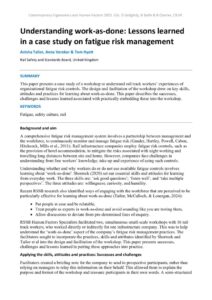
|
Author
Anisha Tailor, Anna Vereker & Tom Hyatt |
Abstract
This paper presents a case study of a workshop to understand rail track workers’ experiences of organisational fatigue risk controls. The design and facilitation of the workshop drew on key skills, attitudes and practices for learning about work-as-done. This paper describes the successes, challenges and lessons learned associated with practically embedding these into the workshop. |





















































































































































































































































































































































































































































































































































































































































































































































